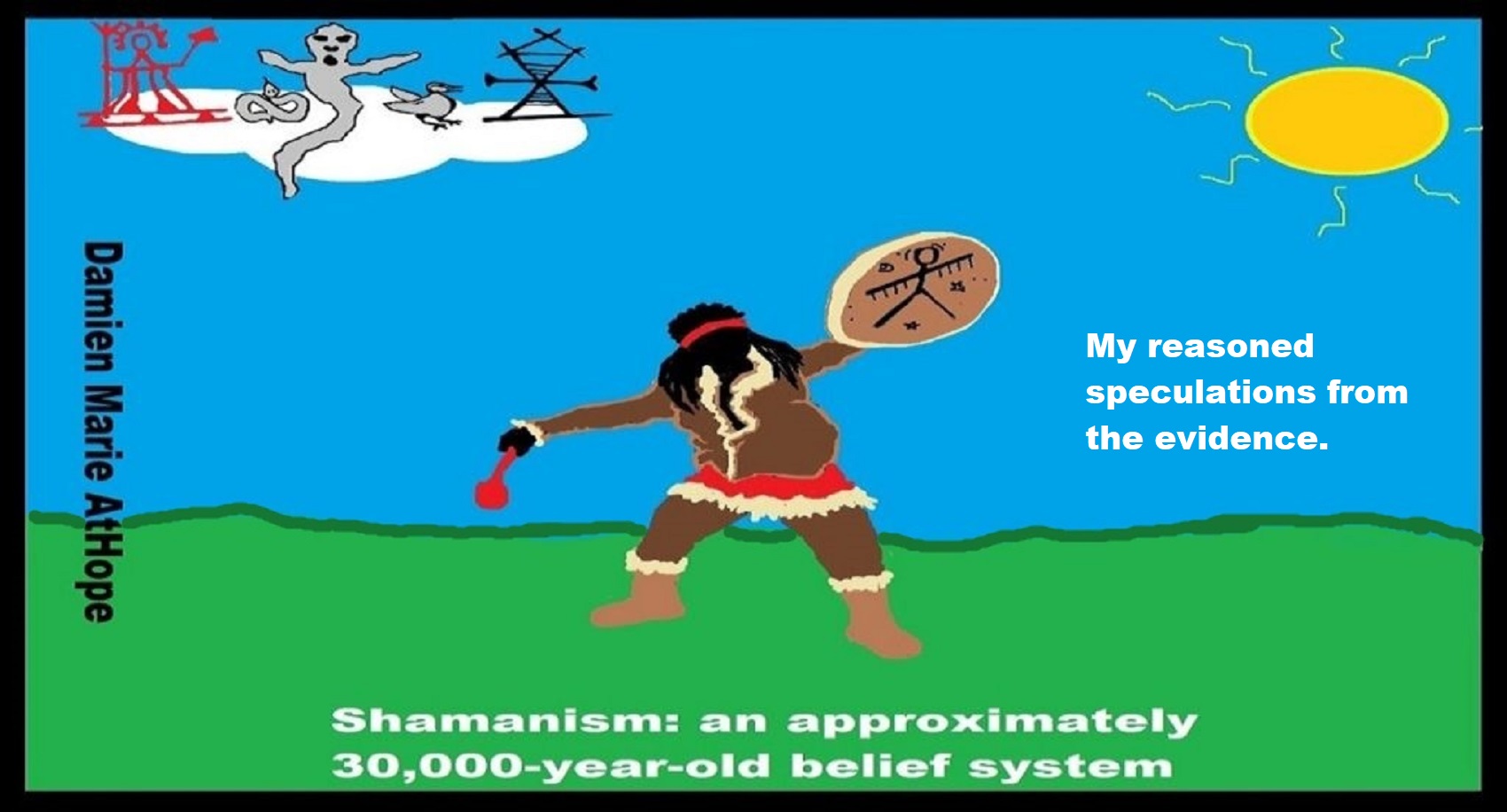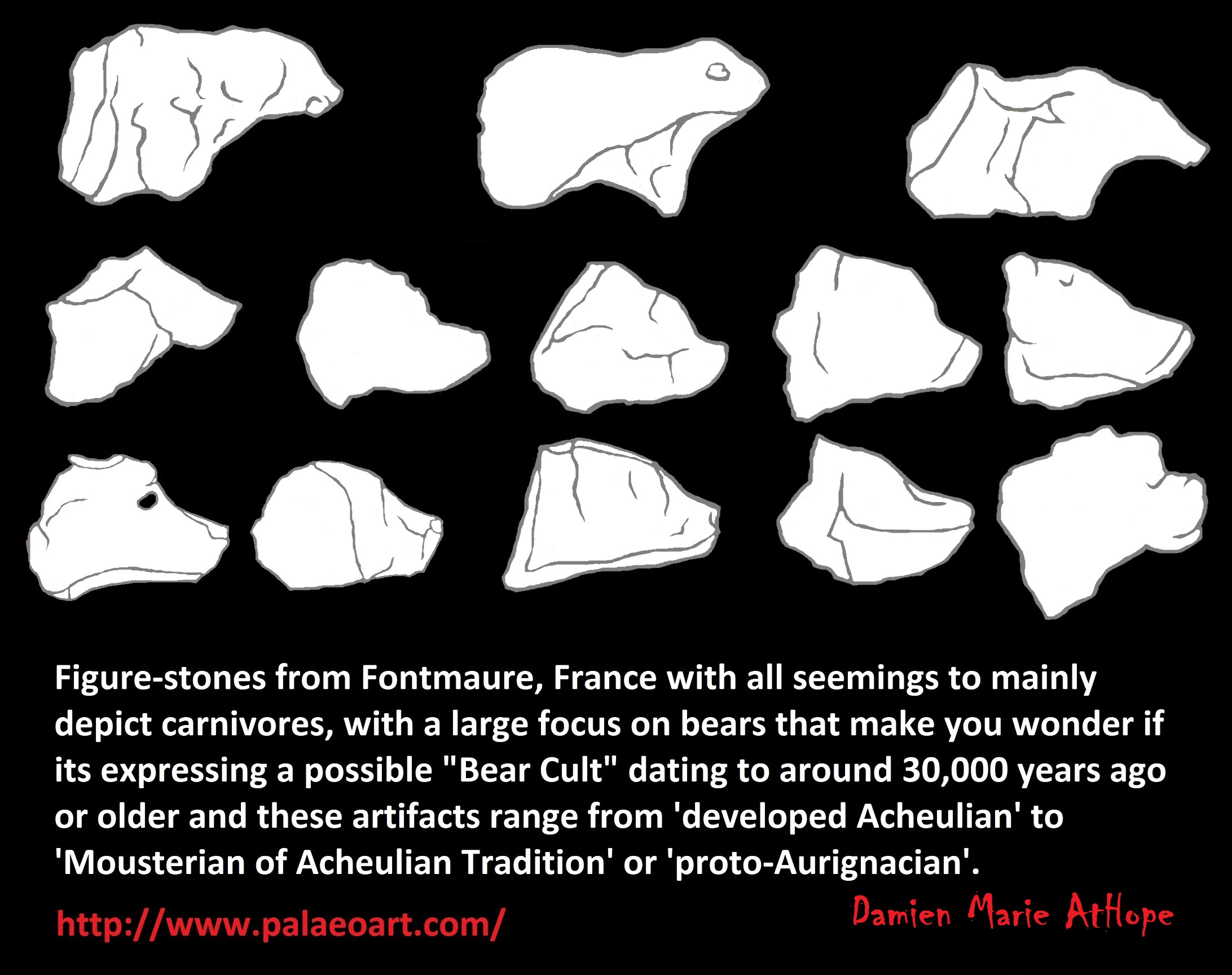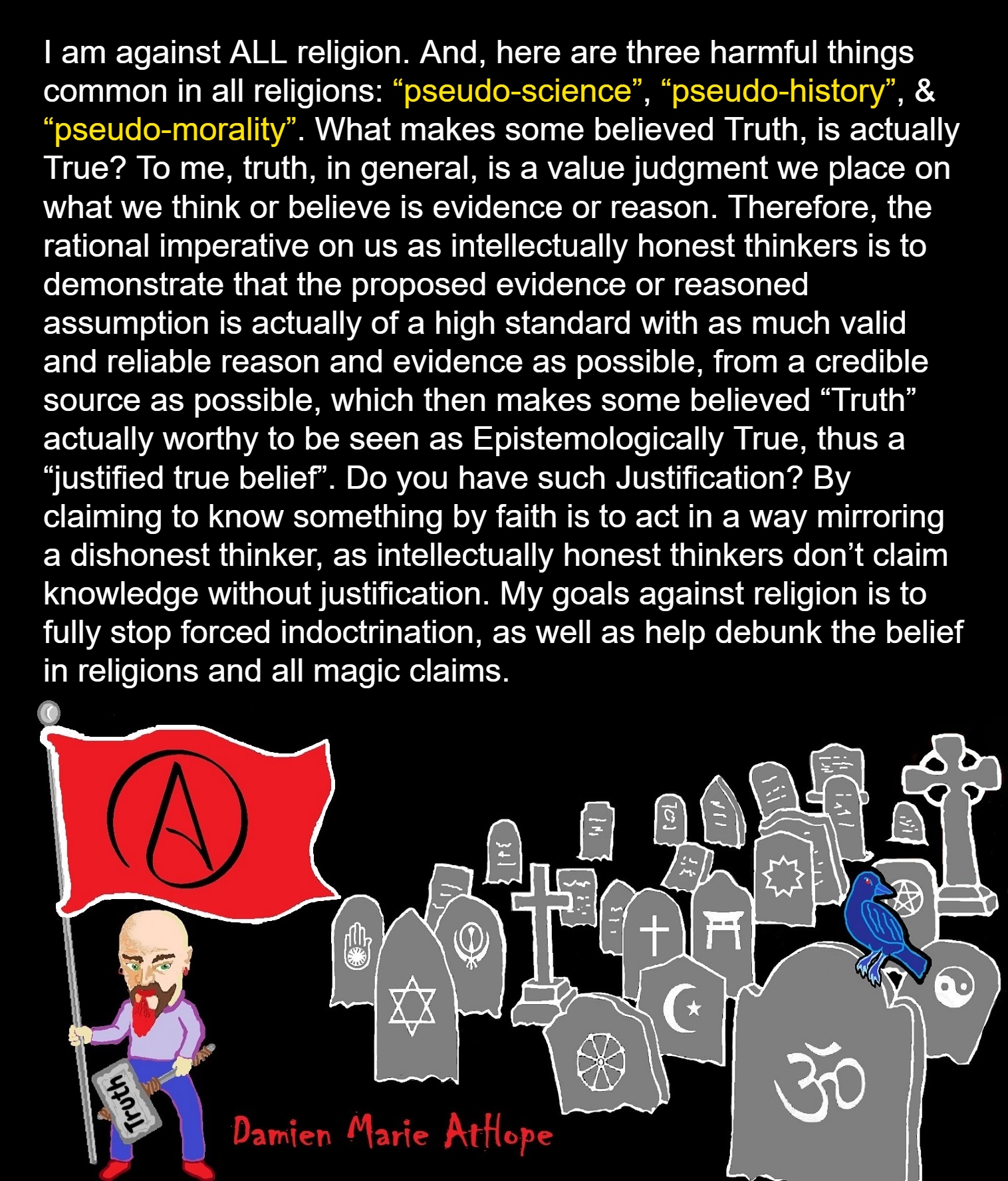Understanding Religion Evolution per Damien’s speculations from the evidence:
Pre-Animism (at least 300,000 years ago) possibly Africa, Middle East, and Eurasia
Animism (at least 100,000 years ago) possibly Southern Africa or maybe Central Africa
Totemism (at least 50,000/45,000 years ago) possibly around Germany, France, or somewhere in West Europe
Shamanism (at least 30,000/35,000 years ago) possibly West Siberia or East Russia
Paganism (at least 12,000/13,000 years ago) Turkey And/or Levant: “Israel, Jordan, Lebanon, Palestine, Syria”
Progressed organized religion (at least 5,000 years ago), (Egypt, the First Dynasty 5,150 years ago)
I think animism started 100,000 years ago, totemism 50,000-45,000 years ago, and shamanism 30,000-35,000 years ago.
Animism (simplified to me as a belief in a perceived spirit world) passably by at least 100,000 years ago “the primal stage of early religion” To me, Animistic Somethingism: You just feel/think there has to be something supernatural/spirit-world or feel/think things are supernatural/spirit-filled.
Totemism (simplified to me, as a belief that these perceived spirits could be managed or related with by created physical expressions) passably by at least 50,000 years ago “progressed stage of early religion” A totem is a representational spirit being, a sacred object, or symbol of a group of people, clan, or tribe.
Shamanism (simplified to me as a belief that some special person can commune with these perceived spirits on the behalf of others by way of rituals) passably by at least 30,000 years ago Shamanism is an otherworld connection belief thought to heal the sick, communicate with spirits/deities, and escort souls of the dead.
- African Back Migrations and the Status of Shamanism Origins as well as its Spreading
- Women/Feminine-Natured people as the first Shamans from around 30,000 to 7,000 years ago?
- Venus of Willendorf: Shamanism Headdresses that Cover the Eyes?
- Some Paleolithic Batons from 23,000 to 12,000 years ago are/maybe Shaman Drumsticks like Those Used with Sami Shaman Drums?
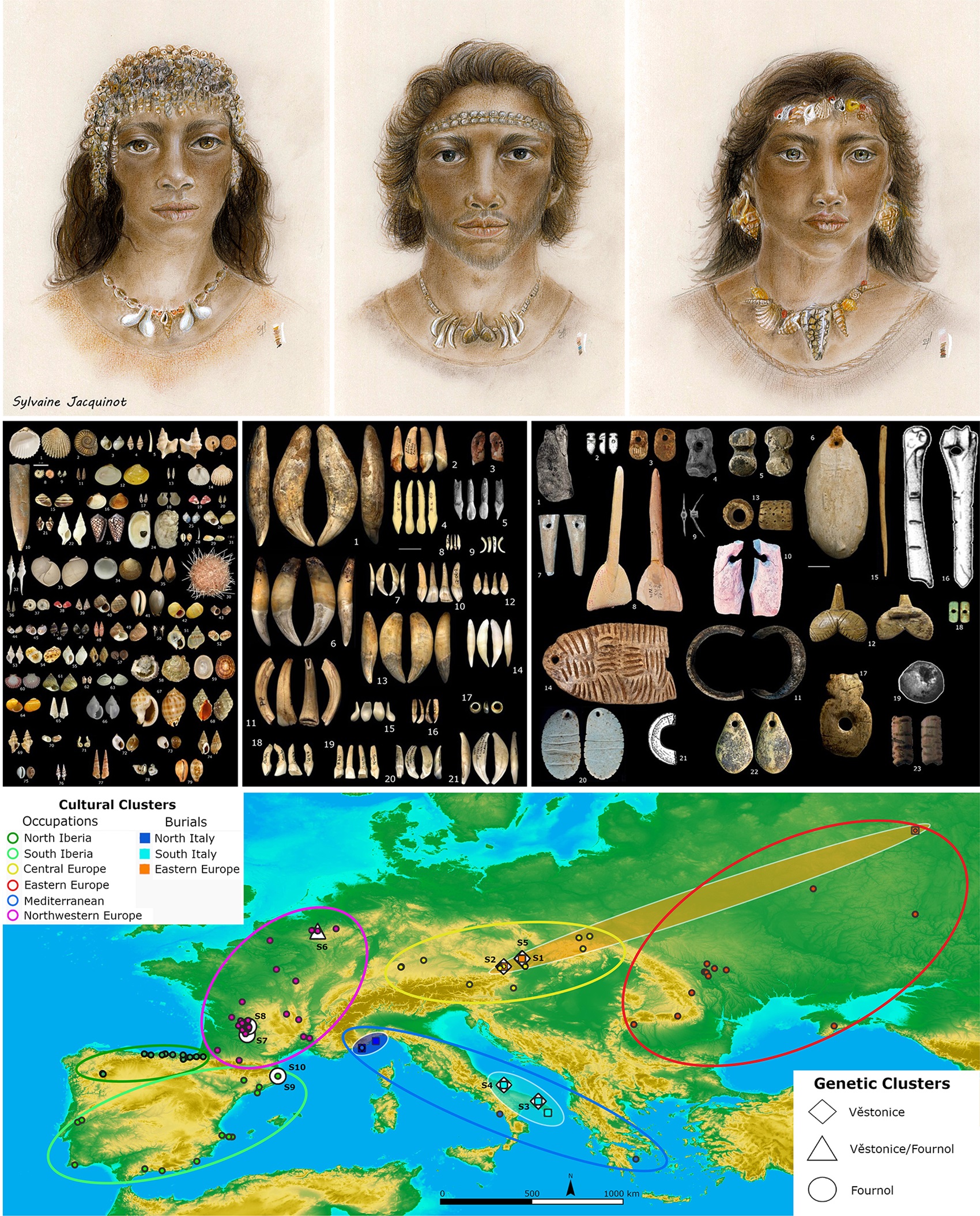
Shamanism: an approximately
30,000-year-old belief system
Shamanism (beginning around 30,000 years ago)
Shamanism (such as that seen in Siberia Gravettian culture: 30,000 years ago). Gravettian culture (34,000–24,000 years ago; Western Gravettian, mainly France, Spain, and Britain, as well as Eastern Gravettian in Central Europe and Russia. The eastern Gravettians, which include the Pavlovian culture). And, the Pavlovian culture (31,000 – 25,000 years ago such as in Austria and Poland). 31,000 – 20,000 years ago Oldest Shaman was Female, Buried with the Oldest Portrait Carving.
Shamanism is approximately a 30,000-year-old belief system and believe in spirit-filled life and/or afterlife that can be attached to or be expressed in things or objects and these objects can be used by special persons or in special rituals that can connect to spirit-filled life and/or afterlife. If you believe like this, regardless of your faith, you are a hidden shamanist.
Around 29,000 to 25,000 years ago in Dolní Vestonice, Czech Republic, the oldest human face representation is a carved ivory female head that was found nearby a female burial and belong to the Pavlovian culture, a variant of the Gravettian culture. The left side of the figure’s face was a distorted image and is believed to be a portrait of an elder female, who was around 40 years old. She was ritualistically placed beneath a pair of mammoth scapulae, one leaning against the other. Surprisingly, the left side of the skull was disfigured in the same manner as the aforementioned carved ivory figure, indicating that the figure was an intentional depiction of this specific individual. The bones and the earth surrounding the body contained traces of red ocher, a flint spearhead had been placed near the skull, and one hand held the body of a fox. This evidence suggests that this was the burial site of a shaman. This is the oldest site not only of ceramic figurines and artistic portraiture but also of evidence of early female shamans. Before 5,500 years ago, women were much more prominent in religion.
Archaeologists usually describe two regional variants: the western Gravettian, known namely from cave sites in France, Spain, and Britain, and the eastern Gravettian in Central Europe and Russia. The eastern Gravettians include the Pavlovian culture, which were specialized mammoth hunters and whose remains are usually found not in caves but in open air sites. The origins of the Gravettian people are not clear, they seem to appear simultaneously all over Europe. Though they carried distinct genetic signatures, the Gravettians and Aurignacians before them were descended from the same ancient founder population. According to genetic data, 37,000 years ago, all Europeans can be traced back to a single ‘founding population’ that made it through the last ice age. Furthermore, the so-called founding fathers were part of the Aurignacian culture, which was displaced by another group of early humans members of the Gravettian culture. Between 37,000 years ago and 14,000 years ago, different groups of Europeans were descended from a single founder population. To a greater extent than their Aurignacian predecessors, they are known for their Venus figurines. ref, ref, ref, ref, ref, ref, ref, ref, ref, ref, & ref
Haplogroup R is seen in several cultures
Haplogroup R possible time of origin about 27,000 years in Central Asia, South Asia, or Siberia:
- Mal’ta–Buret’ culture (24,000-15,000 years ago)
- Afontova Gora culture (21,000-12,000 years ago)
- Trialetian culture (16,000–8000 years ago)
- Samara culture (7,000-6,500 years ago)
- Khvalynsk culture (7,000-6,500 years ago)
- Afanasievo culture (5,300-4,500 years ago)
- Yamna/Yamnaya Culture (5,300-4,500 years ago)
- Andronovo culture (4,000–2,900 years ago) ref
“Haplogroup U is a human mitochondrial DNA haplogroup (mtDNA). The clade arose from haplogroup R, likely during the early Upper Paleolithic. Basal U was found in the 26,000 years old remains of Ancient North Eurasian, Mal’ta boy (MA1 24,000 years old). Its various subclades (labelled U1–U9, diverging over the course of the Upper Paleolithic) are found widely distributed across Northern and Eastern Europe, Central, Western and South Asia, as well as North Africa, the Horn of Africa, and the Canary Islands. In a 2013 study, all but one of the ancient modern human sequences from Europe belonged to maternal haplogroup U, thus confirming previous findings that haplogroup U was the dominant type of Mitochondrial DNA (mtDNA) in Europe before the spread of agriculture into Europe and the presence and the spread of the Indo-Europeans in Western Europe. The age of U5 is estimated at between 25,000 and 35,000 years old, roughly corresponding to the Gravettian culture. Approximately 11% of Europeans (10% of European-Americans) have some variant of haplogroup U5. U5 was the predominant mtDNA of mesolithic Western Hunter Gatherers (WHG).” ref
“U5 has been found in human remains dating from the Mesolithic in England, Germany, Lithuania, Poland, Portugal, Russia, Sweden, France and Spain. Neolithic skeletons (around 7,000 years old or so) that were excavated from the Avellaner cave in Catalonia, northeastern Spain included a specimen carrying haplogroup U5. Haplogroup U5 and its subclades U5a and U5b today form the highest population concentrations in the far north, among Sami, Finns, and Estonians. However, it is spread widely at lower levels throughout Europe. This distribution, and the age of the haplogroup, indicate individuals belonging to this clade were part of the initial expansion tracking the retreat of ice sheets from Europe around 10,000 years ago. U5b1b: has been found in Saami of Scandinavia, Finnish and the Berbers of North Africa, which were found to share an extremely young branch, aged merely around 9,000 years old or so. U5b1b was also found in Fulbe and Papel people in Guinea-Bissau and Yakuts people of northeastern Siberia. It arose around 11,000 years ago.” ref
Gravettian Culture “last European culture many consider unified” (33/35,000–24/20,000 years ago). Which Damien thinks expresses the first earliest shamanism. https://en.wikipedia.org/wiki/Gravettian
Pavlovian Culture “variant of the Gravettian” as seen in Czech Republic, Austria, and Poland (29,000–25,000 years ago). Which Damien thinks expresses the earliest burial of a shaman. https://en.wikipedia.org/wiki/Pavlovian_culture
Epigravettian Culture (Greek: epi “above, on top of”, and Gravettian, because they likely continued a lot of the Gravettian Culture) as seen in Southern and Eastern Europe (20,000–10,000 years ago) Which Damien thinks may have brought/influenced the people in the Middle East/Turkey to add belief in goddesses and female art/figurine themes to their early paganism emerging out or older shamanism 11,000/10,000 years ago. https://en.wikipedia.org/wiki/Epigravettian
Magdalenian Culture as seen in Western Europe: “The earliest Magdalenian sites are in France and the Epigravettian is a similar culture appearing around the same time” (17,000–12,000 years ago) Which Damien thinks started to evolve Western Eurasian shamanism. https://en.wikipedia.org/wiki/Magdalenian
“The Magdalenian constitutes a civilization in the full meaning of the term, with its unique metaphysics, social rules, exchanges codified with nature via its art and weaponry. Before any climatic improvement then, daring was enough to both distinguish these populations from those that disappeared on a European scale and to invent facultative weapons, a conquering mythology, appropriate displacements, episodic ruptures, long-distance relays, flexibility in control over all kinds of environments, ritual delegation by shamanism, the “descent” of mythical decoration of rock walls in favor of mobile supports, such as modern crucifixes or portable altars.” https://www.sciencedirect.com/science/article/abs/pii/S1040618212001450
The Evidence of Shamanism Rituals in Early Prehistoric Periods of Europe and Anatolia
“Shamanism Rituals in Palaeolithic Siberian shamans (Eastern Eurasian Shamanism) believe that shamanism emerged in the period when hunting and gathering was the main means to support. Ethnographic evidence suggests that hunter-gatherer groups would have seen the environment as giving and reciprocating, and that their spirit worlds would have consisted largely of animals and natural features with which shaman-like figures may have mediated. From this point of view, it is best to begin investigating prehistoric shamanism in Palaeolithic rituals and related cave paintings of Europe. The shamanic hypothesis that cave art is based on a fusion of direct evidence from the caves themselves with observations of more recent hunter-gatherer societies that still produce rock art. However, not all cultures have specific shamanic ritual locations, and even when they are present, shamans will perform some rituals away from them. Ritual areas are typically viewed as the literal doorway between the spiritual and physical worlds, and are often an opening into the earth, like caves or springs, or elevated spaces such as mountains and even caves in mountains.” ref
“The Gravettian (30,000 to 20,000 years) is drawn in black and white; the subsequent Magdalenian (17,000 to 10,000 years) and Hamburgian (13,000-11,750 years) are in light blue and red. It is not known whether the spread of the Gravettian was a result of the diffusion of people or cultures.” ref
Gravettian culture
“The Gravettian was an archaeological industry of the European Upper Paleolithic that succeeded the Aurignacian circa 33,022 years ago. It is archaeologically the last European culture many consider unified, and had mostly disappeared by c. 22,022 years ago, close to the Last Glacial Maximum, although some elements lasted until c. 17,022 years ago. In Spain and France, it was succeeded by the Solutrean, and developed into or continued as the Epigravettian in Italy, the Balkans, Ukraine, and Russia. The Gravettian culture is known for Venus figurines, which were typically carved from either ivory or limestone. The culture was first identified at the site of La Gravette in the southwestern French department of Dordogne.” ref
“The Gravettians were hunter-gatherers who lived in a bitterly cold period of European prehistory, and the Gravettian lifestyle was shaped by the climate. Pleniglacial environmental changes forced them to adapt. West and Central Europe were extremely cold during this period. Archaeologists usually describe two regional variants: the western Gravettian, known mainly from cave sites in France, Spain, and Britain, and the eastern Gravettian in Central Europe and Russia. The eastern Gravettians, which include the Pavlovian culture, were specialized mammoth hunters, whose remains are usually found not in caves but in open-air sites.” ref
“Gravettian culture thrived on their ability to hunt animals. They utilized a variety of tools and hunting strategies. Compared to theorized hunting techniques of Neanderthals and earlier human groups, Gravettian hunting culture appears much more mobile and complex. They lived in caves or semi-subterranean or rounded dwellings which were typically arranged in small “villages”. Gravettians are thought to have been innovative in the development of tools such as blunted-back knives, tanged arrowheads, and boomerangs. Other innovations include the use of woven nets and oil lamps made of stone. Blades and bladelets were used to make decorations and bone tools from animal remains.” ref
“Gravettian culture extends across a large geographic region, as far as Estremadura in Portugal. but is relatively homogeneous until about 27,022 years ago. They developed burial rites, which included the inclusion of simple, purpose-built offerings and/or personal ornaments owned by the deceased, placed within the grave or tomb. Surviving Gravettian art includes numerous cave paintings and small, portable Venus figurines made from clay or ivory, as well as jewelry objects. The fertility deities mostly date from the early period; there are over 100 known surviving examples. They conform to a very specific physical type, with large breasts, broad hips, and prominent posteriors. The statuettes tend to lack facial details, and their limbs are often broken off. During the post-glacial period, evidence of the culture begins to disappear from northern Europe but was continued in areas around the Mediterranean.” ref
“Physical remains of people of the Gravettian have revealed that they were tall and relatively slender people. The male height of the Gravettian culture ranged between 179 and 188 centimeters (5 ft 10 in and 6 ft 2 in) tall with an average of 183.5 centimeters (6 ft 0.2 in), which is exceptionally tall not only for that period of prehistory but for all periods of history. They were fairly slender and normally weighed between 67–73 kilograms (148–161 lb), although they would likely have had a higher ratio of lean muscle mass compared to body fat in comparison to modern humans as a result of a very physically active and demanding lifestyle. The females of the Gravettian were much shorter, standing 158 centimeters (5 ft 2 in) on average, with an average weight of 54 kilograms (119 lb). Examinations of Gravettian skulls reveal that high cheekbones were common among them.” ref
“Clubs, stones, and sticks were the primary hunting tools during the Upper Paleolithic period. Bone, antler, and ivory points have all been found at sites in France; but proper stone arrowheads and throwing spears did not appear until the Solutrean period (~20,000 years ago). Due to the primitive tools, many animals were hunted at close range. The typical artifact of the Gravettian tool industry, once considered diagnostic, is the small pointed blade with a straight blunt back. They are today known as the Gravette point, and were used to hunt big game. Gravettians used nets to hunt small game, and are credited with inventing the bow and arrow.” ref
“Gravettian settlers tended towards the valleys that pooled migrating prey. Examples found through discoveries in Gr. La Gala, a site in Southern Italy, shows a strategic settlement based in a small valley. As the settlers became more aware of the migration patterns of animals like red deer, they learned that prey herd in valleys, thereby allowing the hunters to avoid traveling long distances for food. Specifically in Gr. La Gala, the glacial topography forced the deer to pass through the areas in the valley occupied by humans. Additional evidence of strategically positioned settlements include sites like Klithi in Greece, also placed to intercept migrating prey.” ref
“Discoveries in the Czech Republic suggest that nets were used to capture large numbers of smaller prey, thus offering a quick and consistent food supply and thus an alternative to the feast/famine pattern of large game hunters. Evidence comes in the form of 4 mm (0.16 in) thick rope preserved on clay imprints. Research suggests that although no larger net imprints have been discovered, there would be little reason for them not to be made as no further knowledge would be required for their creation. The weaving of nets was likely a communal task, relying on the work of both women and children.” ref
“The Gravettian era landscape is most closely related to the landscape of present-day Moravia. Pavlov I in southern Moravia is the most complete and complex Gravettian site to date, and a perfect model for a general understanding of Gravettian culture. In many instances, animal remains indicate both decorative and utilitarian purposes. In the case of, for example, Arctic foxes, incisors, and canines were used for decoration, while their humeri and radii bones were used as tools. Similarly, the skeletons of some red foxes contain decorative incisors and canines as well as ulnas used for awls and barbs.” ref
“Some animal bones were only used to create tools. Due to their shape, the ribs, fibulas, and metapodia of horses were good for awl and barb creation. In addition, the ribs were also implemented to create different types of smoothers for pelt preparation. The shapes of hare bones are also unique, and as a result, the ulnas were commonly used as awls and barbs. Reindeer antlers, ulnas, ribs, tibias, and teeth were utilized in addition to a rare documented case of a phalanx. Mammoth remnants are among the most common bone remnants of the culture, while long bones and molars are also documented. Some mammoth bones were used for decorative purposes. Wolf remains were often used for tool production and decoration.” ref
“In a genetic study published in Nature in May 2016, the remains of fourteen Gravettians were examined. The eight samples of Y-DNA analyzed were determined to be three samples of haplogroup CT, one sample of I, one sample of IJK, one sample of BT, one sample of C1a2, and one sample of F. Of the fourteen samples of mtDNA, there were thirteen samples of U and one sample of M. The majority of the sample of U belonged to the U5 and U2. In a genetic study published in Nature in November 2020, the remains of one adult male and two twin boys from a Gravettian site were examined. The Y-DNA analysis revealed that all 3 individuals belonged to haplogroup I. The 3 individuals had the same mtDNA, U5.” ref
Shamanism (such as that seen in Siberia Gravettian culture: 30,000 years ago)
- Gravettian culture (34,000–24,000 years ago; Western Gravettian, mainly France, Spain, and Britain, as well as Eastern Gravettian in Central Europe and Russia. The eastern Gravettians, which include the Pavlovian culture)
- Pavlovian culture (31,000 – 25,000 years ago such as in Austria and Poland)
- Prehistoric Child Burials Begin Around 34,000 Years Ago
- Early Shamanism around 34,000 to 20,000 years ago: Sungar (Russia) and Dolni Vestonice (Czech Republic)
- 31,000 – 20,000 years ago Oldest Shaman was Female, Buried with the Oldest Portrait Carving
- Shamanism: an approximately 30,000-year-old belief system
- ‘Sky Burial’ theory and its possible origins at least 12,000 years ago to likely 30,000 years ago or older.
- The Peopling of the Americas Pre-Paleoindians/Paleoamericans around 30,000 to 12,000 years ago
- Similarity in Shamanism?
- Black, White, and Yellow Shamanism?
- Possible Clan Leader/Special “MALE” Ancestor Totem Poles At Least 13,500 years ago?
- Fertile Crescent 12,500 – 9,500 Years Ago: fertility and death cult belief system?
- 12,400 – 11,700 Years Ago – Kortik Tepe (Turkey) Pre/early-Agriculture Cultic Ritualism
- Horned female shamans and Pre-satanism Devil/horned-god Worship? at least 10,000 years ago.
- Shamanistic rock art 8,000 and 10,000 years ago from central Aboriginal Siberians and Aboriginal drums in the Americas.
Shamanism is approximately a 30,000-year-old belief system and believe in spirit-filled life and/or afterlife that can be attached to or be expressed in things or objects and these objects can be used by special persons or in special rituals that can connect to spirit-filled life and/or afterlife. If you believe like this, regardless of your faith, you are a hidden shamanist.
Around 29,000 to 25,000 years ago in Dolní Vestonice, Czech Republic, the oldest human face representation is a carved ivory female head that was found nearby a female burial and belong to the Pavlovian culture, a variant of the Gravettian culture. The left side of the figure’s face was a distorted image and is believed to be a portrait of an elder female, who was around 40 years old. She was ritualistically placed beneath a pair of mammoth scapulae, one leaning against the other. Surprisingly, the left side of the skull was disfigured in the same manner as the aforementioned carved ivory figure, indicating that the figure was an intentional depiction of this specific individual. The bones and the earth surrounding the body contained traces of red ocher, a flint spearhead had been placed near the skull, and one hand held the body of a fox. This evidence suggests that this was the burial site of a shaman. This is the oldest site not only of ceramic figurines and artistic portraiture but also of evidence of early female shamans. Before 5,500 years ago, women were much more prominent in religion.
Archaeologists usually describe two regional variants: the western Gravettian, known namely from cave sites in France, Spain, and Britain, and the eastern Gravettian in Central Europe and Russia. The eastern Gravettians include the Pavlovian culture, which were specialized mammoth hunters and whose remains are usually found not in caves but in open air sites. The origins of the Gravettian people are not clear, they seem to appear simultaneously all over Europe. Though they carried distinct genetic signatures, the Gravettians and Aurignacians before them were descended from the same ancient founder population. According to genetic data, 37,000 years ago, all Europeans can be traced back to a single ‘founding population’ that made it through the last ice age. Furthermore, the so-called founding fathers were part of the Aurignacian culture, which was displaced by another group of early humans members of the Gravettian culture. Between 37,000 years ago and 14,000 years ago, different groups of Europeans were descended from a single founder population. To a greater extent than their Aurignacian predecessors, they are known for their Venus figurines. ref, ref, ref, ref, ref, ref, ref, ref, ref, ref, & ref
- “33,000 years ago: oldest known domesticated dog skulls show they existed in both Europe and Siberia by this time.
- 31,000–16,000 years ago: Last Glacial Maximum (peak at 26,500 years ago).
- 30,000 years ago: rock paintings tradition begins in Bhimbetka rock shelters in India, which presented as a collection is the densest known concentration of rock art. In an area about 10 km2, there are about 800 rock shelters of which 500 contain paintings.
- 29,000 years ago: The earliest ovens found.
- 28,500 years ago: New Guinea is populated by colonists from Asia or Australia.
- 28,000 years ago: the oldest known twisted rope.
- 28,000–24,000 years ago: some of the oldest known pottery—used to make figurines rather than cooking or storage vessels (Venus of Dolní Věstonice).
- 28,000–20,000 years ago: Gravettian period in Europe. Harpoons and saws invented.
- 26,000 years ago: people around the world use fibers to make baby carriers, clothes, bags, baskets, and nets.
- 25,000 years ago: a hamlet consisting of huts built of rocks and of mammoth bones is founded in what is now Dolní Věstonice in Moravia in the Czech Republic. This is the oldest human permanent settlement that has yet been found by archaeologists.
- 21,000 years ago: artifacts suggests early human activity occurred in Canberra, the capital city of Australia.
- 20,000 years ago: Kebaran culture in the Levant.
- 20,000 years ago: oldest pottery storage/cooking vessels from China.
- 20,000-10,000 years ago: Khoisanid expansion to Central Africa.
- 16,000-14,000 years ago: Minatogawa Man (Proto-Mongoloid phenotype) in Okinawa, Japan
- 16,000–13,000 years ago: the first colonization of North America.
- 16,000-11,000 years ago: Caucasian Hunter-Gatherer (Caucasoid phenotype) expansion to Europe.
- 16,000 years ago: Wisent sculpted in clay deep inside the cave now known as Le Tuc d’Audoubert in the French Pyrenees near what is now the border of Spain.
- 15,000–14,700 years ago: Earliest supposed date for the domestication of the pig.
- 14,800 years ago: The Humid Period begins in North Africa. The region that would later become the Sahara is wet and fertile, and the aquifers are full.
- 14,500-11,500: Red Deer Cave people in China, possible late survival of archaic or archaic-modern hybrid humans.
- 14,000-12,000 years ago: Oldest evidence for prehistoric warfare (Jebel Sahaba massacre, Natufian culture).
- 13,000–10,000 years ago: Late Glacial Maximum, end of the Last glacial period, climate warms, glaciers recede.
- 13,000 years ago: A major water outbreak occurs on Lake Agassiz, which at the time could have been the size of the current Black Sea and the largest lake on Earth. Much of the lake is drained in the Arctic Ocean through the Mackenzie River.
- 13,000–11,000 years ago: Earliest dates suggested for the domestication of the sheep.
- Approximately 13,000 years ago, the Younger Dryas ice age.” ref
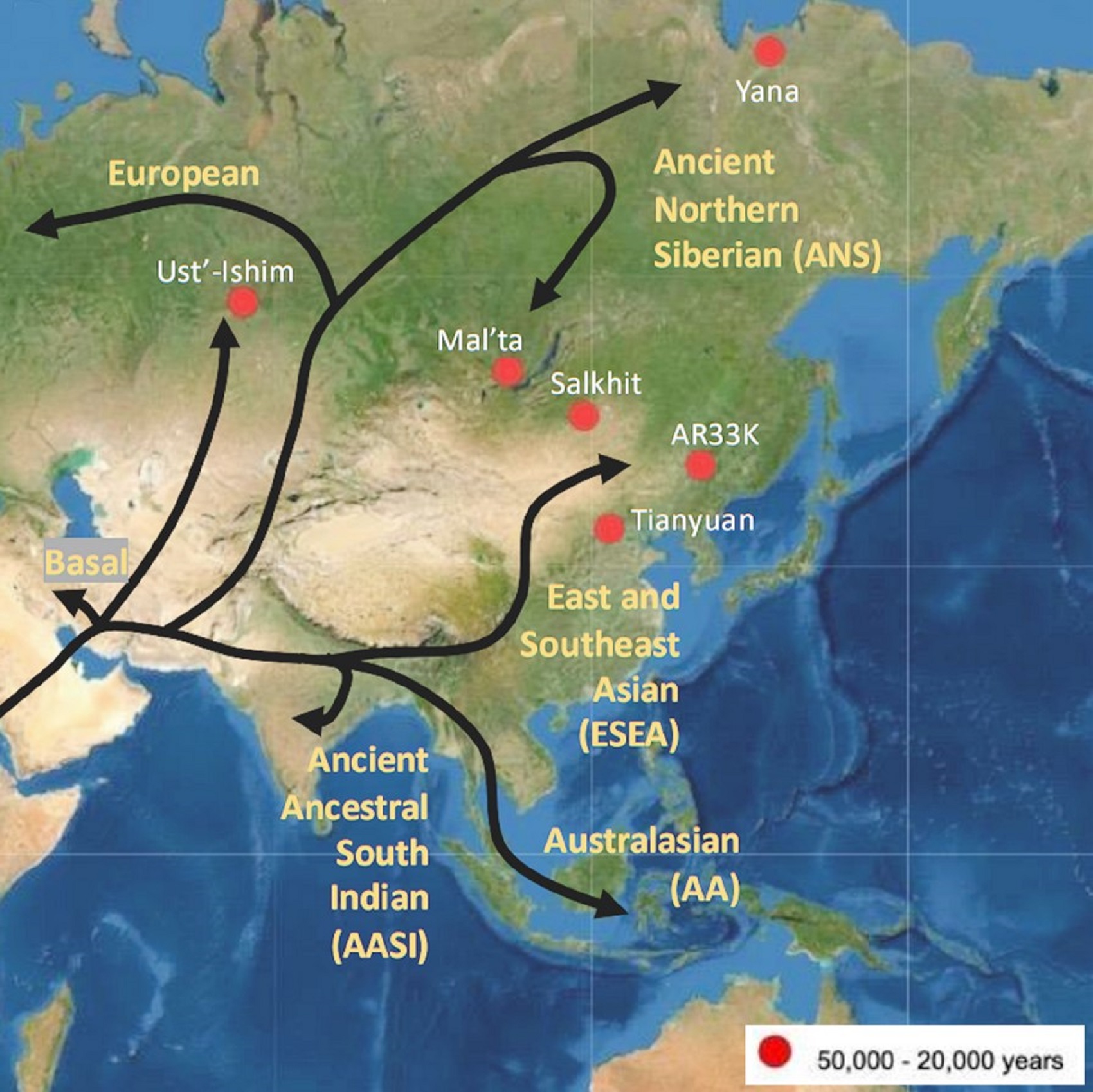
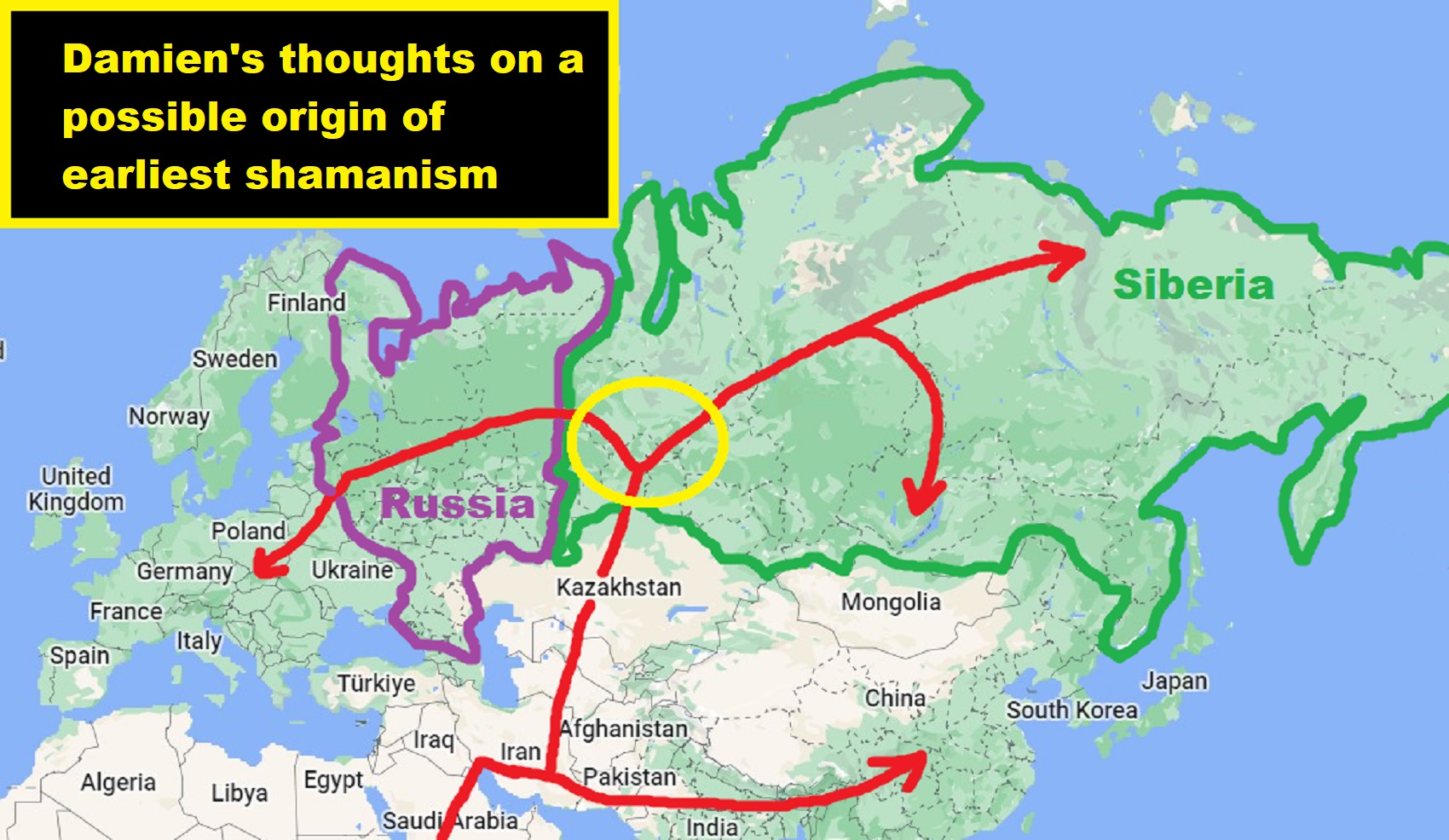
“Haplogroup U is a human mitochondrial DNA haplogroup (mtDNA). The clade arose from haplogroup R, likely during the early Upper Paleolithic. Its various subclades (labeled U1–U9, diverging over the course of the Upper Paleolithic) are found widely distributed across Northern and Eastern Europe, Central, Western, and South Asia, as well as North Africa, the Horn of Africa, and the Canary Islands. Basal U was found in the 26,000-year-old remains of Ancient North Eurasian, Mal’ta boy (MA1). The age of U5 is estimated at between 25,000 and 35,000 years old, roughly corresponding to the Gravettian culture. and is the DNA associated with the seeming first Gravettian shaman burial seen in the Pavlovian culture, around Dolní Věstonice in southern Moravia. One of the Dolní Věstonice burials, located near the huts, revealed a human female skeleton aged to 40+ years old, ritualistically placed beneath a pair of mammoth scapulae, one leaning against the other. Surprisingly, the left side of the skull was disfigured in the same manner as the aforementioned carved ivory figure, indicating that the figure was an intentional depiction of this specific individual. The bones and the earth surrounding the body contained traces of red ocher, a flint spearhead had been placed near the skull, and one hand held the body of a fox. This evidence suggests that this was the burial site of a shaman. This is the oldest site not only of ceramic figurines and artistic portraiture, but also of evidence of female shamans.” ref, ref, ref, ref
“Approximately 11% of Europeans (10% of European-Americans) have some variant of haplogroup U5. U5 was the predominant mtDNA of mesolithic Western Hunter Gatherers (WHG). U5 has been found in human remains dating from the Mesolithic in England, Germany, Lithuania, Poland, Portugal, Russia, Sweden, France, and Spain. Neolithic skeletons (~7,000 years old) that were excavated from the Avellaner cave in Catalonia, northeastern Spain included a specimen carrying haplogroup U5. Haplogroup U5 and its subclades U5a and U5b today form the highest population concentrations in the far north, among Sami, Finns, and Estonians. However, it is spread widely at lower levels throughout Europe. This distribution, and the age of the haplogroup, indicate individuals belonging to this clade were part of the initial expansion tracking the retreat of ice sheets from Europe around 10,000 years ago. The modern Basques and Cantabrians possess almost exclusively U5b lineages (U5b1f, U5b1c1, U5b2).” ref
6 Ice Age Humans (30,000 Years Ago)
“Abstract: Starting about 35,000 years ago, humans seem to have made a great leap forward culturally. The authors argue that this wasn’t because of genetic changes that caused the human brain to have increased capacity. It was because some groups culturally evolved the “social tools” that allowed them to maintain connections and share information over long distances. The groups with the most effective social tools managed to stay connected and to survive, and their descendants inherited this culture of connectedness. It’s likely that forming greater connectedness and more complex culture was necessary in order to survive the periods of high climate variability that were a feature of the last ice age.” ref
“Archaeologists usually describe two regional variants: the western Gravettian, known mainly from cave sites in France, Spain, and Britain, and the eastern Gravettian in Central Europe and Russia. The eastern Gravettians, which include the Pavlovian culture, were specialized mammoth hunters, whose remains are usually found not in caves but in open air sites. Gravettian culture thrived on their ability to hunt animals. They utilized a variety of tools and hunting strategies. Compared to theorized hunting techniques of Neanderthals and earlier human groups, Gravettian hunting culture appears much more mobile and complex. They lived in caves or semi-subterranean or rounded dwellings which were typically arranged in small “villages”. Gravettians are thought to have been innovative in the development of tools such as blunted-back knives, tanged arrowheads, and boomerangs. Other innovations include the use of woven nets and oil lamps made of stone. Blades and bladelets were used to make decorations and bone tools from animal remains.” ref
“Gravettian culture extends across a large geographic region, as far as Estremadura in Portugal. but is relatively homogeneous until about 27,000 years ago. They developed burial rites, which included simple, purpose-built offerings and/or personal ornaments owned by the deceased, placed within the grave or tomb. Surviving Gravettian art includes numerous cave paintings and small, portable Venus figurines made from clay or ivory, as well as jewelry objects. The fertility deities mostly date from the early period; there are over 100 known surviving examples. They conform to a very specific physical type, with large breasts, broad hips and prominent posteriors. The statuettes tend to lack facial details, and their limbs are often broken off. During the post glacial period, evidence of the culture begins to disappear from northern Europe but was continued in areas around the Mediterranean. The Mal’ta Culture (c. 24,000 years ago) in Siberia is often considered as belonging to the Gravettian, due to its similar characteristics, particularly its Venus figurines, but any hypothetical connection would have to be cultural and not genetic: a 2016 genomic study showed that the Mal’ta people have no genetic connections with the people of the European Gravettian culture (the Vestonice Cluster).” ref
“Fu et al. (2016) examined the remains of fourteen Gravettians. The eight males included three samples of Y-chromosomal haplogroup CT, one of I, one IJK, one BT, one C1a2, and one sample of F. Of the fourteen samples of mtDNA, there were thirteen samples of U and one sample of M. The majority of the sample of U belonged to the U5 and U2. Teschler et al. (2020) examined the remains of one adult male and two twin boys from a Gravettian site in Austria. All belonged to haplogroup Y-Haplogroup I. and all had the same mtDNA, U5. According to Scorrano et al. (2022), “the genome of an early European individual from Kostenki 14, dated to around 37,000 years ago, demonstrated that the ancestral European gene pool was already established by that time.” ref
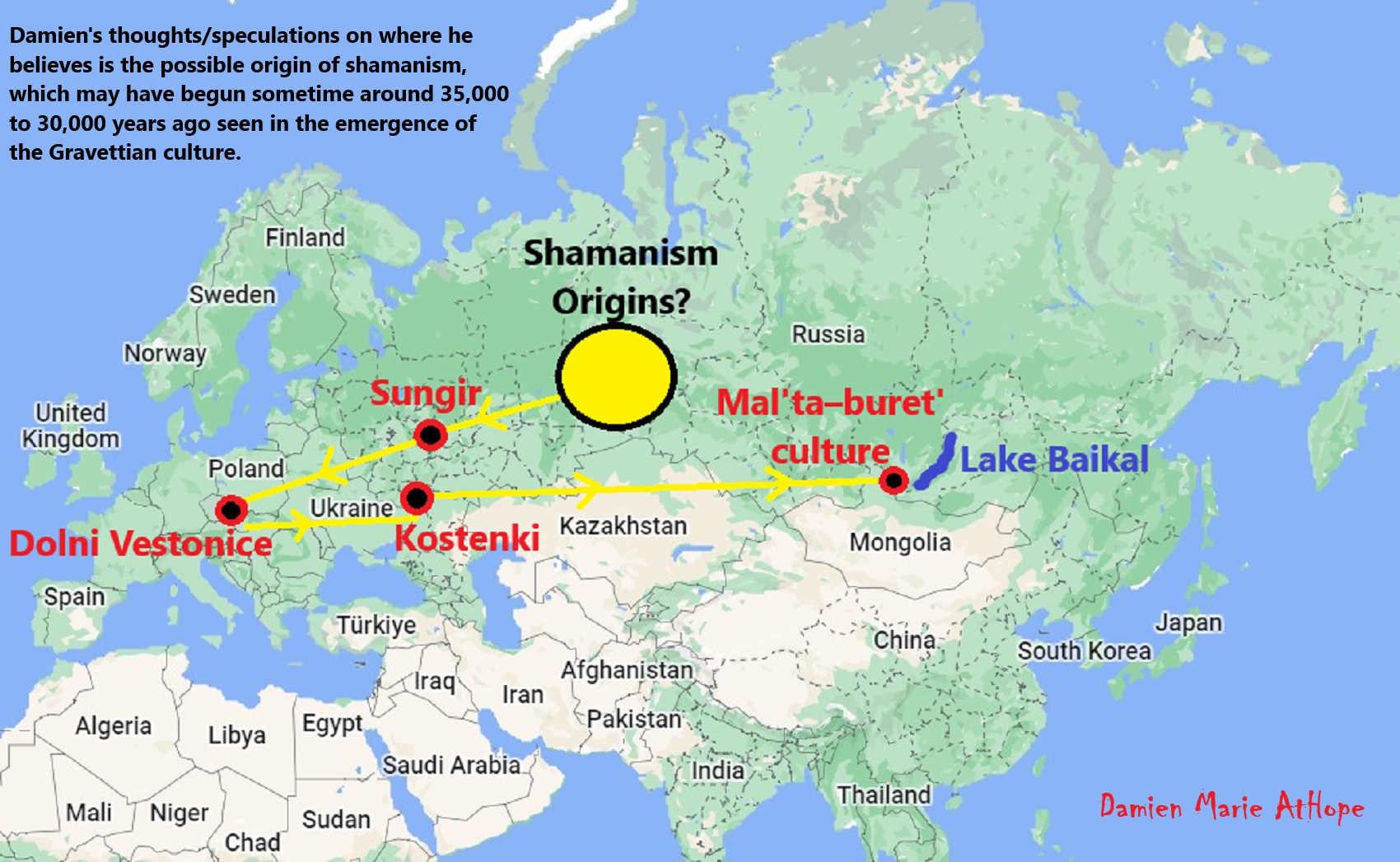
Here are Damien’s thoughts/speculations on where he believes is the possible origin of shamanism, which may have begun sometime around 35,000 to 30,000 years ago seen in the emergence of the Gravettian culture, just to outline his thinking, on what thousands of years later led to evolved Asian shamanism, in general, and thus WU shamanism as well. In both Europe-related “shamanism-possible burials” and in Gravettian mitochondrial DNA is a seeming connection to Haplogroup U. And the first believed Shaman proposed burial belonged to Eastern Gravettians/Pavlovian culture at Dolní Věstonice in southern Moravia in the Czech Republic, which is the oldest permanent human settlement that has ever been found. It is at Dolní Věstonice where approximately 27,000-25,000 years ago a seeming female shaman was buried and also there was an ivory totem portrait figure, seemingly of her.
“The Pavlovian is an Upper Paleolithic culture, a variant of the Gravettian, that existed in the region of Moravia, northern Austria, and southern Poland around 29,000–25,000 years ago. Its name is derived from the village of Pavlov, in the Pavlov Hills, next to Dolní Věstonice in southern Moravia. The culture used sophisticated stone age technology to survive in the tundra on the fringe of the ice sheets around the Last Glacial Maximum. Excavation has yielded flint implements, polished and drilled stone artifacts, bone spearheads, needles, digging tools, flutes, bone ornaments, drilled animal teeth, and seashells. Art or religious finds are bone carvings and figurines of humans and animals made of mammoth tusk, stone, and fired clay.” ref
“One of the burials, located near the huts, revealed a human female skeleton aged to 40+ years old, ritualistically placed beneath a pair of mammoth scapulae, one leaning against the other. Surprisingly, the left side of the skull was disfigured in the same manner as the aforementioned carved ivory figure, indicating that the figure was an intentional depiction of this specific individual. The bones and the earth surrounding the body contained traces of red ocher, a flint spearhead had been placed near the skull, and one hand held the body of a fox. This evidence suggests that this was the burial site of a shaman. This is the oldest site not only of ceramic figurines and artistic portraiture, but also of evidence of female shamans.” ref
“A burial of an approximately forty-year-old woman was found at Dolní Věstonice in an elaborate burial setting. Various items found with the woman have had a profound impact on the interpretation of the social hierarchy of the people at the site, as well as indicating an increased lifespan for these inhabitants. The remains were covered in red ochre, a compound known to have religious significance, indicating that this woman’s burial was ceremonial in nature. Also, the inclusion of a mammoth scapula and a fox are indicative of a high-status burial.” ref
“In the Upper Paleolithic, anatomically modern humans began living longer, often reaching middle age, by today’s standards. Rachel Caspari argues in “Human Origins: the Evolution of Grandparents,” that life expectancy increased during the Upper Paleolithic in Europe (Caspari 2011). She also describes why elderly people were highly influential in society. Grandparents assisted in childcare, perpetuated cultural transmission, and contributed to the increased complexity of stone tools (Caspari 2011). The woman found at Dolní Věstonice was old enough to have been a grandparent. Although human lifespans were increasing, elderly individuals in Upper Paleolithic societies were still relatively rare. Because of this, it is possible that the woman was attributed with great importance and wisdom, and revered because of her age. Because of her advanced age, it is also possible she had a decreased ability to care for herself, instead relying on her family group to care for her, which indicates strong social connections.” ref
“Furthermore, a female figurine was found at the site and is believed to be associated with the aged woman, because of remarkably similar facial characteristics. The woman was found to have deformities on the left side of her face. The special importance accorded with her burial, in addition to her facial deformity, makes it possible that she was a shaman in this time period, where it was “not uncommon that people with disabilities, either mental or physical, are thought to have unusual supernatural powers” (Pringle 2010).” ref
“In 1981, Patricia Rice studied a multitude of female clay figurines found at Dolní Věstonice, believed to represent fertility in this society. She challenged this assumption by analyzing all the figurines and found that, “it is womanhood, rather than motherhood that is symbolically recognized or honored” (Rice 1981: 402). This interpretation challenged the widely held assumption that all prehistoric female figurines were created to honor fertility. The fact is that we have no idea why these figurines proliferated nor of their purpose or usage.” ref
“Haplogroup U5 is estimated to be about 30,000 years old, and it is primarily found today in people with European ancestry. Both the current geographic distribution of U5 and testing of ancient human remains indicate that the ancestor of U5 expanded into Europe before 31,000 years ago. A 2013 study by Fu et al. found two U5 individuals at the Dolni Vestonice burial site in the Czech Republic that has been dated to 31,155 years ago. A third person from the same burial was identified as haplogroup U8. The Dolni Vestonice samples have only two of the five mutations ( C16192T and C16270T) that are found in the present day U5 population. This indicates that the U5-(C16192T and C16270T) mtDNA sequence is ancestral to the present day U5 population that includes the additional three mutations T3197C, G9477A and T13617C.” ref
“Haplogroup U5 is thought to have evolved in the western steppe region and then entered Europe around 30,000 to 55,000 years ago. Results support previous hypotheses that haplogroup U5 mtDNAs expanded throughout Northern, Southern, and Central Europe with more recent expansions into Western Europe and Africa. The results further allow us to explain how U5 mtDNAs are now found with high frequency in Northern Europe, as well as delineate the origins of the specific U5 subhaplogroups found in that part of Europe.” ref
“Haplogroup U5 is found throughout Europe with an average frequency ranging from 5% to 12% in most regions. U5a is most common in north-east Europe and U5b in northern Spain. Nearly half of all Sami and one fifth of Finnish maternal lineages belong to U5. Other high frequencies are observed among the Mordovians (16%), the Chuvash (14.5%) and the Tatars (10.5%) in the Volga-Ural region of Russia, the Estonians (13%), the Lithuanians (11.5%) and the Latvians in the Baltic, the Dargins (13.5%), Avars (13%) and the Chechens (10%) in the Northeast Caucasus, the Basques (12%), the Cantabrians (11%) and the Catalans (10%) in northern Spain, the Bretons (10.5%) in France, the Sardinians (10%) in Italy, the Slovaks (11%), the Croatians (10.5%), the Poles (10%), the Czechs (10%), the Ukrainians (10%) and the Slavic Russians (10%). Overall, U5 is generally found in population with high percentages of Y-haplogroups I1, I2, and R1a, three lineages already found in Mesolithic Europeans. The highest percentages are observed in populations associated predominantly with Y-haplogroup N1c1 (the Finns and the Sami), although N1c1 is originally an East Asian lineage that spread over Siberia and Northeast Europe and assimilated indigenous U5 maternal lineages.” ref
“The age of haplogroup U5 is uncertain at present. It could have arisen as recently as 35,000 years ago, or as early was 50,000 years ago. U5 appear to have been a major maternal lineage among the Paleolithic European hunter-gatherers, and even the dominant lineage during the European Mesolithic. In two papers published two months apart, Posth et al. 2016 and Fu et al. 2016 reported the results of over 70 complete human mitochondrial genomes ranging from 45,000 to 7,000 years ago. The oldest U5 samples all dated from the Gravettian culture (c. 32,000 to 22,000 years ago), while the older Aurignacian samples belonged to mt-haplogroups M, N, R*, and U2. Among the 16 Gravettian samples that yielded reliable results, six belonged to U5 – the others belonging mostly to U2, as well as isolated samples of M, U*, and U8c. Two Italian Epigravettian samples, one from the Paglicci Cave in Apulia (18,500 years ago), and another one from Villabruna in Veneto (14,000 years ago), belonged to U5b2b, as did two slightly more recent Epipaleolithic samples from the Rhône valley in France. U5b1 samples were found in Epipalaeolithic Germany, Switzerland (U5b1h in the Grotte du Bichon), and France. More 80% of the numerous Mesolithic European mtDNA tested to date belonged to various subclades of U5. Overall, it appears that U5 arrived in Europe with the Gravettian tool makers, and that it particularly prospered from the end of the glacial period (from 11,700 years ago) until the arrival of Neolithic farmers from the Near East (between 8,500 and 6,000 years ago).” ref
“Carriers of haplogroup U5 were part of the Gravettian culture, which experienced the Last Glacial Maximum (LGM, 26,000 to 19,000 years ago). During this particularly harsh period, Gravettian people would have retreated into refugia in southern Europe, from which they would have re-expanded to colonise the northern half of the continent during the Late Glacial and postglacial periods. For reasons that are yet unknown, haplogroup U5 seems to have resisted better to the LGM to other Paleolithic haplogroups like U*, U2 and U8. Mitochondrial DNA being essential for energy production, it could be that the mutations selected in early U5 subclades (U5a1, U5a2, U5b1, U5b2) conferred an advantage for survival during the coldest millennia of the LGM, which had for effect to prune less energy efficient mtDNA lineages.” ref
“It is likely that U5a and U5b lineages already existed prior to the LGM and they were geographically scattered to some extent around Europe before the growing ice sheet forced people into the refugia. Nonetheless, founder effects among the populations of each LGM refugium would have amplified the regional division between U5b and U5a. U5b would have been found at a much higher frequency in the Franco-Cantabrian region. We can deduce this from the fact that modern Western Europeans have considerably more U5b than U5a, but also because the modern Basques and Cantabrians possess almost exclusively U5b lineages. What’s more, all the Mesolithic U5 samples from Iberia whose subclade could be identified belonged to U5b.” ref
“Conversely, only U5a lineages have been found so far in Mesolithic Russia (U5a1) and Sweden (U5a1 and U5a2), which points at an eastern origin of this subclade. Mesolithic samples from Poland, Germany and Italy yielded both U5a and U5b subclades. German samples included U5a2a, U5a2c3, U5b2 and U5b2a2. The same observations are valid for the Neolithic and Chalcolithic periods too, with U5a1 being found in Russia and Ukraine, U5b in France (Cardium Pottery and Megalithic), U5b2 in Portugal. U5b1b1 arose approximately 10,000 years ago, over two millennia after the end of the Last Glaciation, when the Neolithic Revolution was already under way in the Near East. Despite this relatively young age, U5b1b1 is found scattered across all Europe and well beyond its boundaries. The Saami, who live in the far European North and have 48% of U5 and 42% of V lineages, belong exclusively to the U5b1b1 subclade. Amazingly, the Berbers of Northwest Africa also possess that U5b1b1 subclade and haplogroup V.” ref
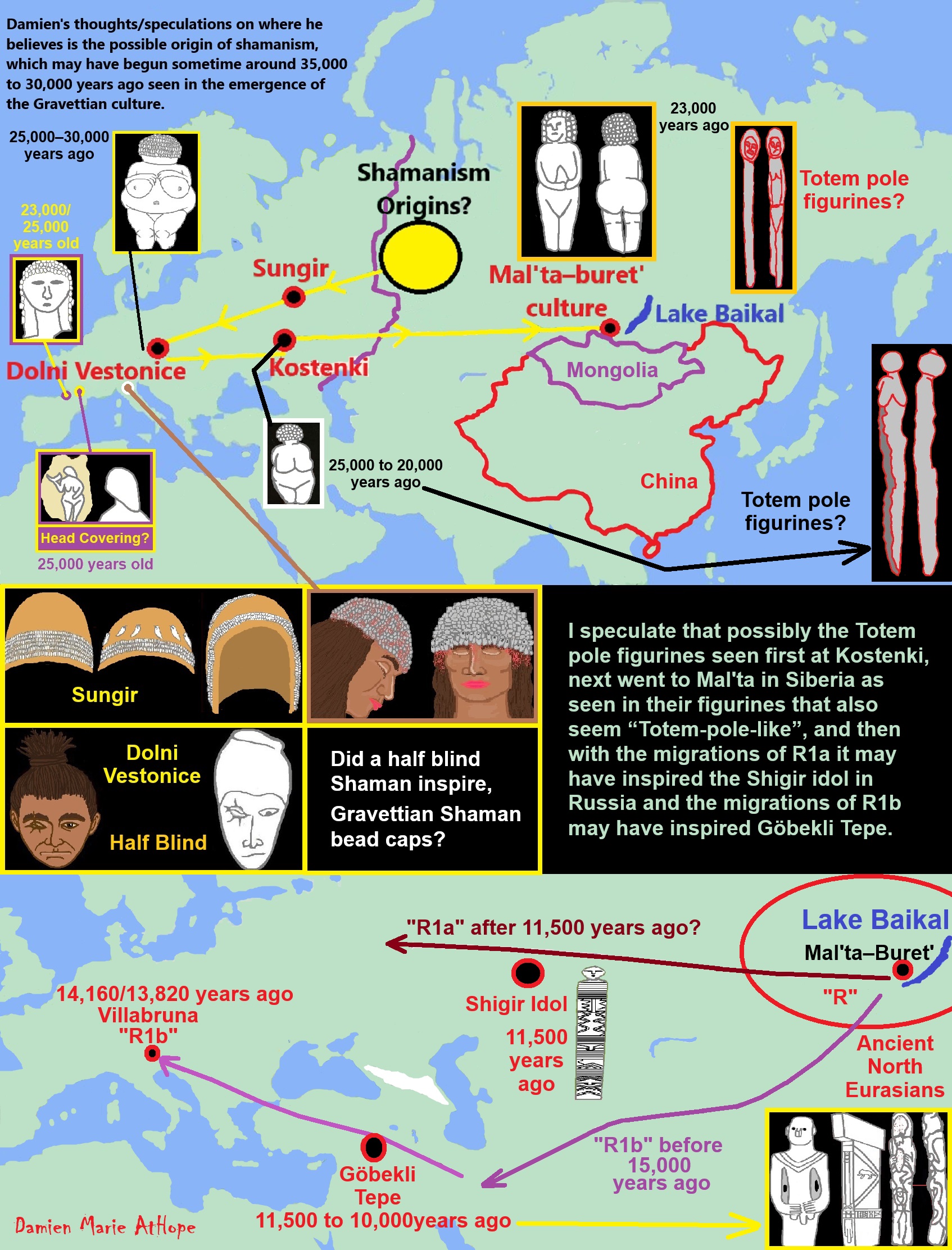
ref, ref, ref, ref, ref, ref, ref, ref, ref, ref, ref, ref, ref, ref, ref, ref, ref, ref, ref
Here are my thoughts/speculations on where I believe is the possible origin of shamanism, which may have begun sometime around 35,000 to 30,000 years ago seen in the emergence of the Gravettian culture, just to outline his thinking, on what thousands of years later led to evolved Asian shamanism, in general, and thus WU shamanism as well. In both Europe-related “shamanism-possible burials” and in Gravettian mitochondrial DNA is a seeming connection to Haplogroup U. And the first believed Shaman proposed burial belonged to Eastern Gravettians/Pavlovian culture at Dolní Věstonice in southern Moravia in the Czech Republic, which is the oldest permanent human settlement that has ever been found. It is at Dolní Věstonice where approximately 27,000-25,000 years ago a seeming female shaman was buried and also there was an ivory totem portrait figure, seemingly of her.
And my thoughts on how cultural/ritual aspects were influenced in the area of Göbekli Tepe. I think it relates to a few different cultures starting in the area before the Neolithic. Two different groups of Siberians first from northwest Siberia with U6 haplogroup 40,000 to 30,000 or so. Then R Haplogroup (mainly haplogroup R1b but also some possible R1a both related to the Ancient North Eurasians). This second group added its “R1b” DNA of around 50% to the two cultures Natufian and Trialetian. To me, it is likely both of these cultures helped create Göbekli Tepe. Then I think the female art or graffiti seen at Göbekli Tepe to me possibly relates to the Epigravettians that made it into Turkey and have similar art in North Italy. I speculate that possibly the Totem pole figurines seen first at Kostenki, next went to Mal’ta in Siberia as seen in their figurines that also seem “Totem-pole-like”, and then with the migrations of R1a it may have inspired the Shigir idol in Russia and the migrations of R1b may have inspired Göbekli Tepe.
“Migration from Siberia behind the formation of Göbeklitepe: Expert states. People who migrated from Siberia formed the Göbeklitepe, and those in Göbeklitepe migrated in five other ways to spread to the world, said experts about the 12,000-year-old Neolithic archaeological site in the southwestern province of Şanlıurfa.“ The upper paleolithic migrations between Siberia and the Near East is a process that has been confirmed by material culture documents,” he said.” ref
“Semih Güneri, a retired professor from Caucasia and Central Asia Archaeology Research Center of Dokuz Eylül University, and his colleague, Professor Ekaterine Lipnina, presented the Siberia-Göbeklitepe hypothesis they have developed in recent years at the congress held in Istanbul between June 11 and 13. There was a migration that started from Siberia 30,000 years ago and spread to all of Asia and then to Eastern and Northern Europe, Güneri said at the international congress.” ref
“The relationship of Göbeklitepe high culture with the carriers of Siberian microblade stone tool technology is no longer a secret,” he said while emphasizing that the most important branch of the migrations extended to the Near East. “The results of the genetic analyzes of Iraq’s Zagros region confirm the traces of the Siberian/North Asian indigenous people, who arrived at Zagros via the Central Asian mountainous corridor and met with the Göbeklitepe culture via Northern Iraq,” he added.” ref
“Emphasizing that the stone tool technology was transported approximately 7,000 kilometers from east to west, he said, “It is not clear whether this technology is transmitted directly to long distances by people speaking the Turkish language at the earliest, or it travels this long-distance through using way stations.” According to the archaeological documents, it is known that the Siberian people had reached the Zagros region, he said. “There seems to be a relationship between Siberian hunter-gatherers and native Zagros hunter-gatherers,” Güneri said, adding that the results of genetic studies show that Siberian people reached as far as the Zagros.” ref
“There were three waves of migration of Turkish tribes from the Southern Siberia to Europe,” said Osman Karatay, a professor from Ege University. He added that most of the groups in the third wave, which took place between 2600-2400 BCE, assimilated and entered the Germanic tribes and that there was a genetic kinship between their tribes and the Turks. The professor also pointed out that there are indications that there is a technology and tool transfer from Siberia to the Göbeklitepe region and that it is not known whether people came, and if any, whether they were Turkish.” ref
“Around 12,000 years ago, there would be no ‘Turks’ as we know it today. However, there may have been tribes that we could call our ‘common ancestors,’” he added. “Talking about 30,000 years ago, it is impossible to identify and classify nations in today’s terms,” said Murat Öztürk, associate professor from İnönü University. He also said that it is not possible to determine who came to where during the migrations that were accepted to have been made thousands of years ago from Siberia. On the other hand, Mehmet Özdoğan, an academic from Istanbul University, has an idea of where “the people of Göbeklitepe migrated to.” ref
“According to Özdoğan, “the people of Göbeklitepe turned into farmers, and they could not stand the pressure of the overwhelming clergy and started to migrate to five ways.” “Migrations take place primarily in groups. One of the five routes extends to the Caucasus, another from Iran to Central Asia, the Mediterranean coast to Spain, Thrace and [the northwestern province of] Kırklareli to Europe and England, and one route is to Istanbul via [Istanbul’s neighboring province of] Sakarya and stops,” Özdoğan said. In a very short time after the migration of farmers in Göbeklitepe, 300 settlements were established only around northern Greece, Bulgaria, and Thrace. “Those who remained in Göbeklitepe pulled the trigger of Mesopotamian civilization in the following periods, and those who migrated to Mesopotamia started irrigated agriculture before the Sumerians,” he said.” ref
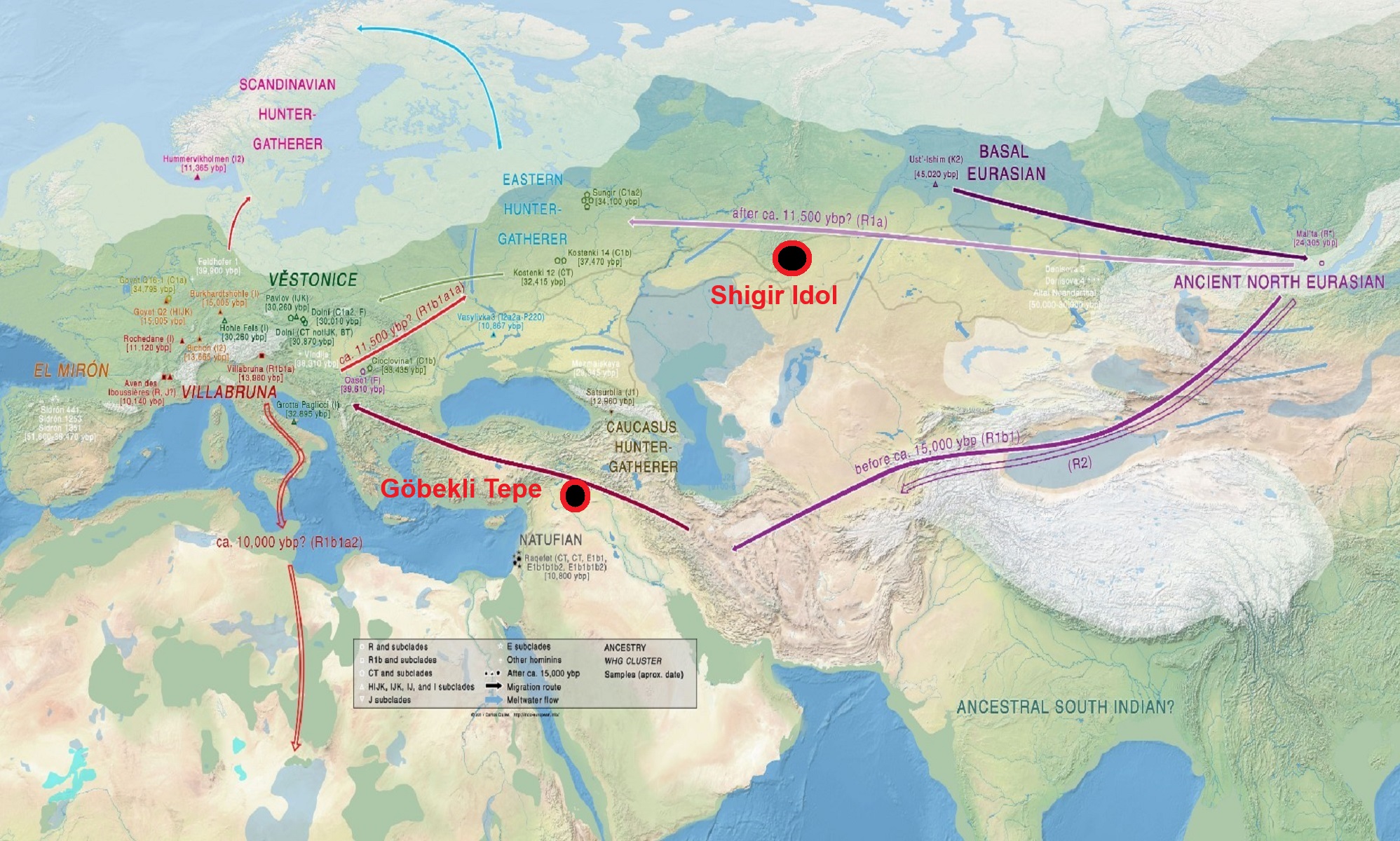
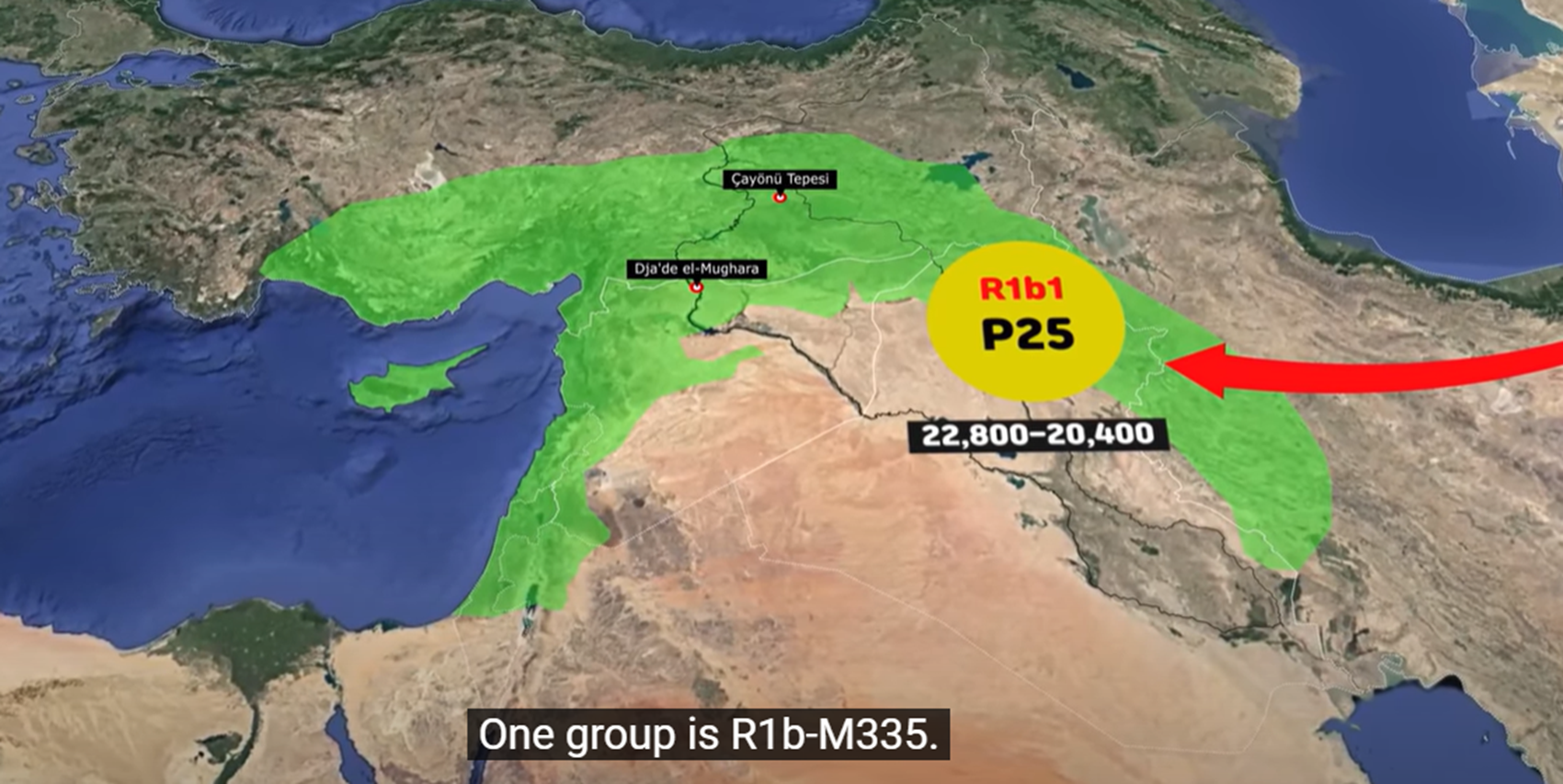
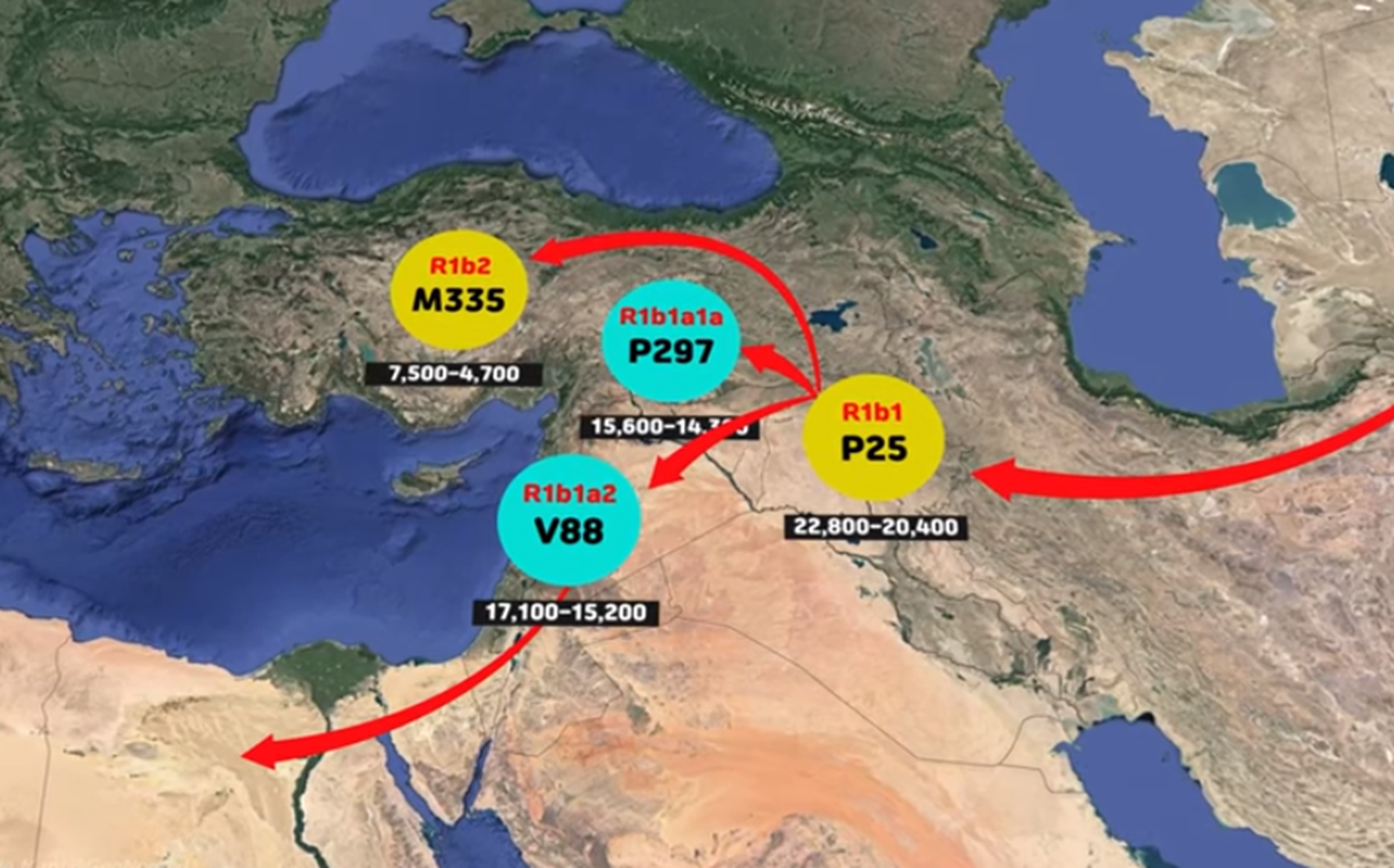
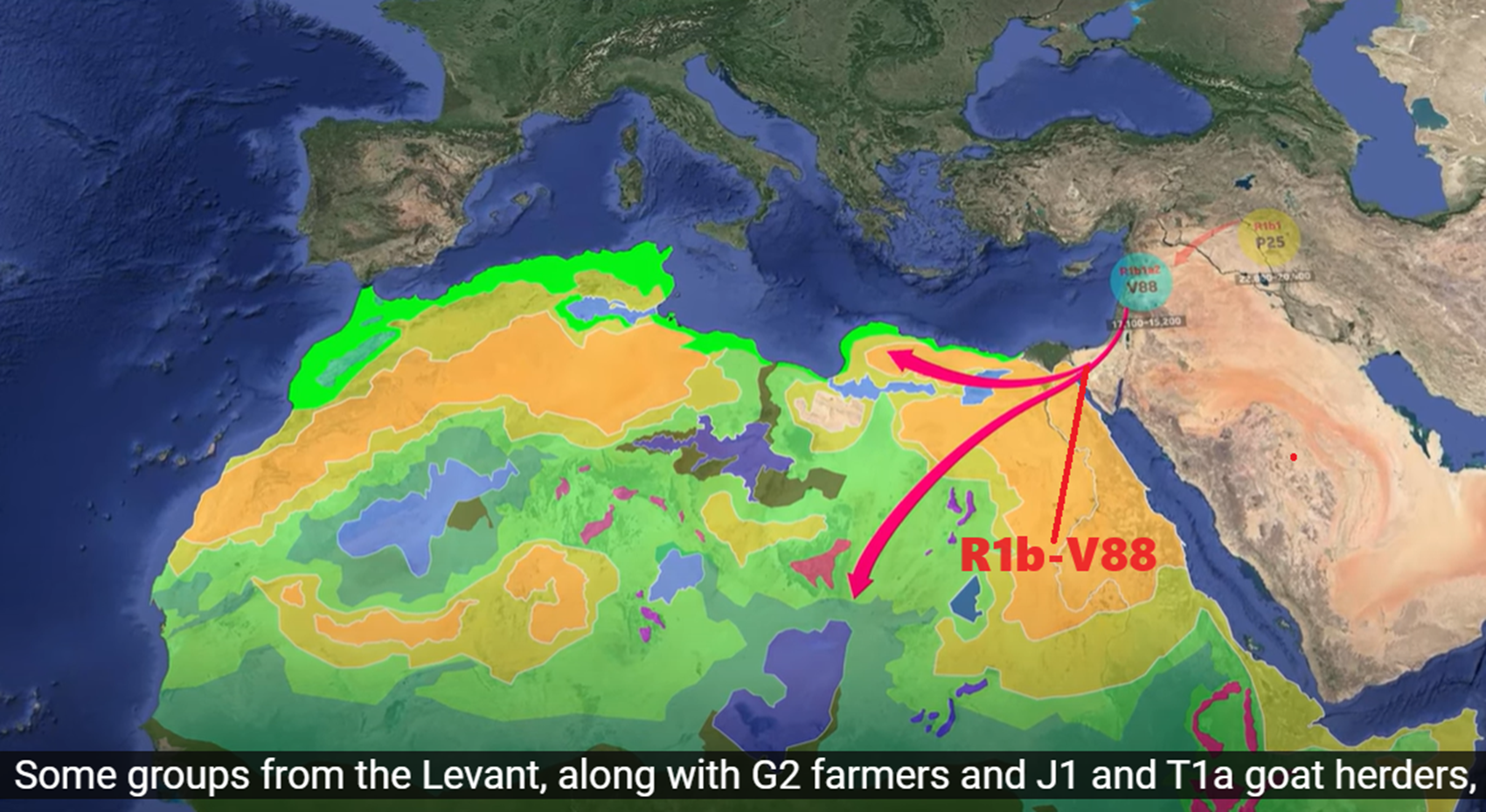
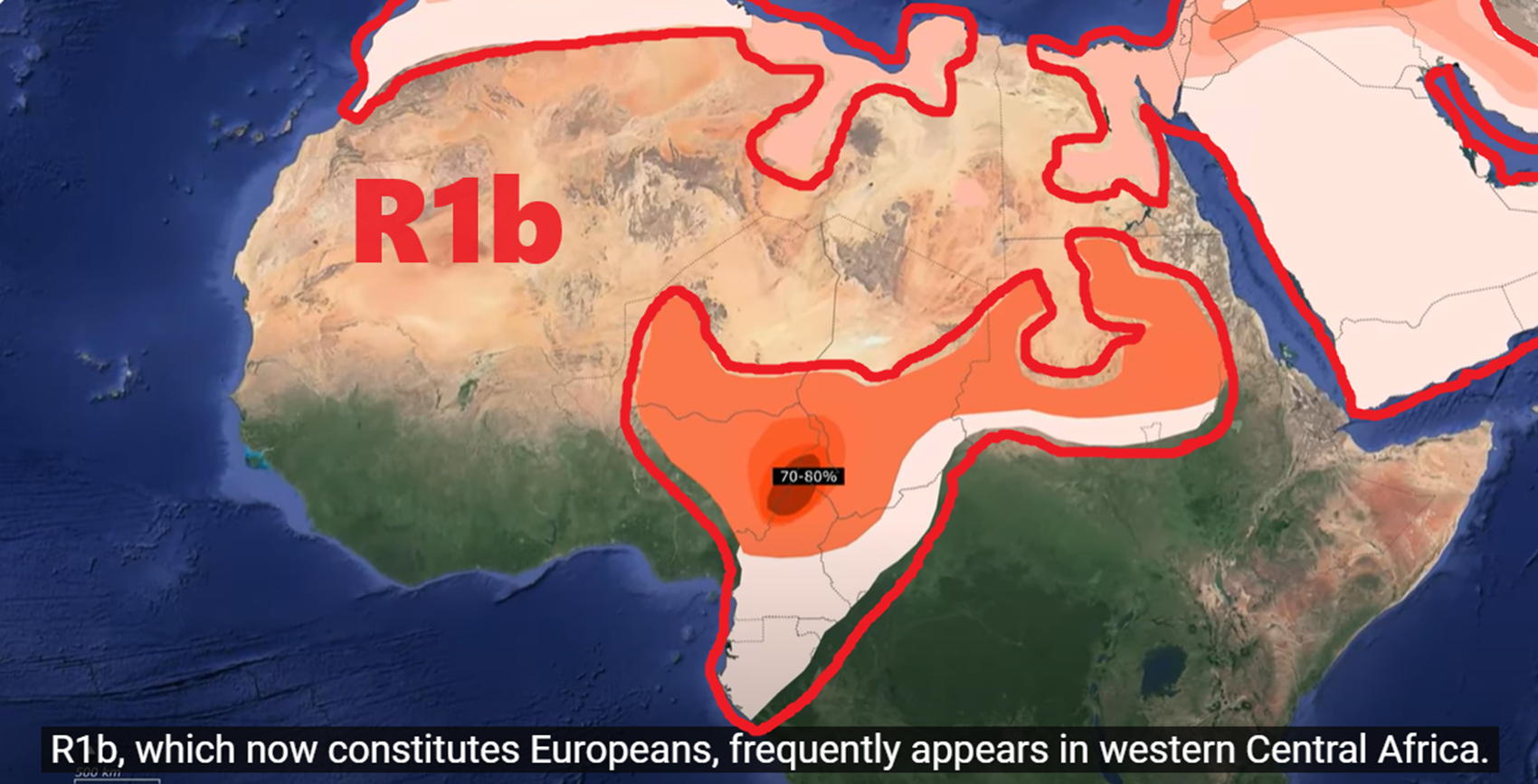
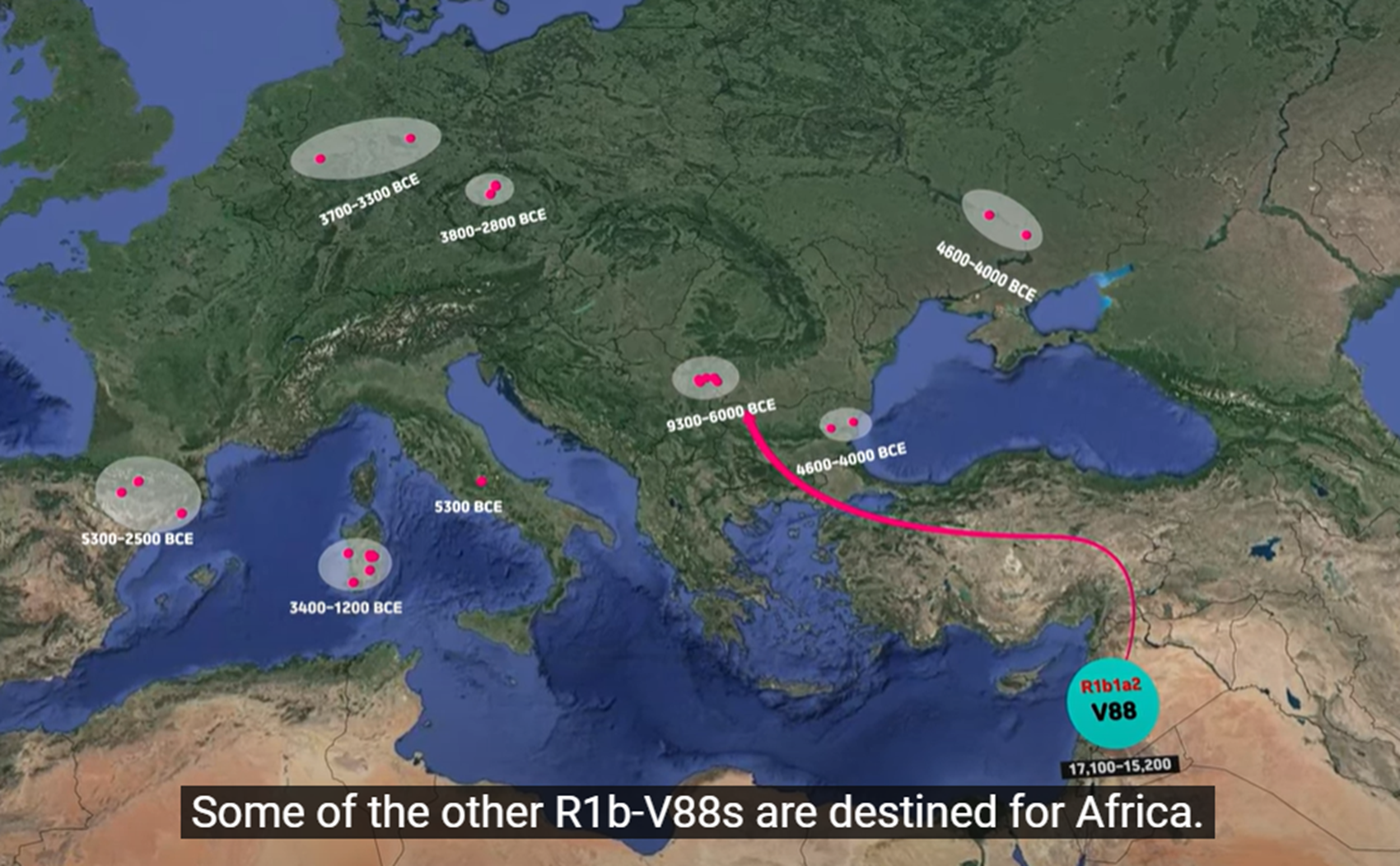
“Haplogroup R* originated in North Asia just before the Last Glacial Maximum (26,500-19,000 years ago). This haplogroup has been identified in the remains of a 24,000 year-old boy from the Altai region, in south-central Siberia (Raghavan et al. 2013). This individual belonged to a tribe of mammoth hunters that may have roamed across Siberia and parts of Europe during the Paleolithic. Autosomally this Paleolithic population appears to have contributed mostly to the ancestry of modern Europeans and South Asians, the two regions where haplogroup R also happens to be the most common nowadays (R1b in Western Europe, R1a in Eastern Europe, Central and South Asia, and R2 in South Asia).” ref
“The oldest forms of R1b (M343, P25, L389) are found dispersed at very low frequencies from Western Europe to India, a vast region where could have roamed the nomadic R1b hunter-gatherers during the Ice Age. The three main branches of R1b1 (R1b1a, R1b1b, R1b1c) all seem to have stemmed from the Middle East. The southern branch, R1b1c (V88), is found mostly in the Levant and Africa. The northern branch, R1b1a (P297), seems to have originated around the Caucasus, eastern Anatolia or northern Mesopotamia, then to have crossed over the Caucasus, from where they would have invaded Europe and Central Asia. R1b1b (M335) has only been found in Anatolia.” ref
“It has been hypothetised that R1b people (perhaps alongside neighbouring J2 tribes) were the first to domesticate cattle in northern Mesopotamia some 10,500 years ago. R1b tribes descended from mammoth hunters, and when mammoths went extinct, they started hunting other large game such as bisons and aurochs. With the increase of the human population in the Fertile Crescent from the beginning of the Neolithic (starting 12,000 years ago), selective hunting and culling of herds started replacing indiscriminate killing of wild animals. The increased involvement of humans in the life of aurochs, wild boars and goats led to their progressive taming. Cattle herders probably maintained a nomadic or semi-nomadic existence, while other people in the Fertile Crescent (presumably represented by haplogroups E1b1b, G and T) settled down to cultivate the land or keep smaller domesticates.” ref
“The analysis of bovine DNA has revealed that all the taurine cattle (Bos taurus) alive today descend from a population of only 80 aurochs. The earliest evidence of cattle domestication dates from circa 8,500 BCE in the Pre-Pottery Neolithic cultures in the Taurus Mountains. The two oldest archaeological sites showing signs of cattle domestication are the villages of Çayönü Tepesi in southeastern Turkey and Dja’de el-Mughara in northern Iraq, two sites only 250 km away from each others. This is presumably the area from which R1b lineages started expanding – or in other words the “original homeland” of R1b.” ref
“The early R1b cattle herders would have split in at least three groups. One branch (M335) remained in Anatolia, but judging from its extreme rarity today wasn’t very successful, perhaps due to the heavy competition with other Neolithic populations in Anatolia, or to the scarcity of pastures in this mountainous environment. A second branch migrated south to the Levant, where it became the V88 branch. Some of them searched for new lands south in Africa, first in Egypt, then colonising most of northern Africa, from the Mediterranean coast to the Sahel. The third branch (P297), crossed the Caucasus into the vast Pontic-Caspian Steppe, which provided ideal grazing grounds for cattle. They split into two factions: R1b1a1 (M73), which went east along the Caspian Sea to Central Asia, and R1b1a2 (M269), which at first remained in the North Caucasus and the Pontic Steppe between the Dnieper and the Volga. It is not yet clear whether M73 actually migrated across the Caucasus and reached Central Asia via Kazakhstan, or if it went south through Iran and Turkmenistan. In any case, M73 would be a pre-Indo-European branch of R1b, just like V88 and M335.” ref
“R1b-M269 (the most common form in Europe) is closely associated with the diffusion of Indo-European languages, as attested by its presence in all regions of the world where Indo-European languages were spoken in ancient times, from the Atlantic coast of Europe to the Indian subcontinent, which comprised almost all Europe (except Finland, Sardinia and Bosnia-Herzegovina), Anatolia, Armenia, European Russia, southern Siberia, many pockets around Central Asia (notably in Xinjiang, Turkmenistan, Tajikistan and Afghanistan), without forgetting Iran, Pakistan, northern India and Nepal. The history of R1b and R1a are intricately connected to each others.” ref
The Levantine & African branch of R1b (V88)
“Like its northern counterpart (R1b-M269), R1b-V88 is associated with the domestication of cattle in northern Mesopotamia. Both branches of R1b probably split soon after cattle were domesticated, approximately 10,500 years ago (8,500 BCE). R1b-V88 migrated south towards the Levant and Egypt. The migration of R1b people can be followed archeologically through the presence of domesticated cattle, which appear in central Syria around 8,000-7,500 BCE (late Mureybet period), then in the Southern Levant and Egypt around 7,000-6,500 BCE (e.g. at Nabta Playa and Bir Kiseiba). Cattle herders subsequently spread across most of northern and eastern Africa. The Sahara desert would have been more humid during the Neolithic Subpluvial period (c. 7250-3250 BCE), and would have been a vast savannah full of grass, an ideal environment for cattle herding.” ref
“Evidence of cow herding during the Neolithic has shown up at Uan Muhuggiag in central Libya around 5500 BCE, at the Capeletti Cave in northern Algeria around 4500 BCE. But the most compelling evidence that R1b people related to modern Europeans once roamed the Sahara is to be found at Tassili n’Ajjer in southern Algeria, a site famous pyroglyphs (rock art) dating from the Neolithic era. Some painting dating from around 3000 BCE depict fair-skinned and blond or auburn haired women riding on cows. The oldest known R1b-V88 sample in Europe is a 6,200 year-old farmer/herder from Catalonia tested by Haak et al. (2015). Autosomally this individual was a typical Near Eastern farmer, possessing just a little bit of Mesolithic West European admixture.” ref
“After reaching the Maghreb, R1b-V88 cattle herders could have crossed the Strait of Gibraltar to Iberia, probably accompanied by G2 farmers, J1 and T1a goat herders. These North African Neolithic farmers/herders could have been the ones who established the Almagra Pottery culture in Andalusia in the 6th millennium BCE.” ref
“Nowadays small percentages (1 to 4%) of R1b-V88 are found in the Levant, among the Lebanese, the Druze, and the Jews, and almost in every country in Africa north of the equator. Higher frequency in Egypt (5%), among Berbers from the Egypt-Libya border (23%), among the Sudanese Copts (15%), the Hausa people of Sudan (40%), the the Fulani people of the Sahel (54% in Niger and Cameroon), and Chadic tribes of northern Nigeria and northern Cameroon (especially among the Kirdi), where it is observed at a frequency ranging from 30% to 95% of men. According to Cruciani et al. (2010) R1b-V88 would have crossed the Sahara between 9,200 and 5,600 years ago, and is most probably associated with the diffusion of Chadic languages, a branch of the Afroasiatic languages. V88 would have migrated from Egypt to Sudan, then expanded along the Sahel until northern Cameroon and Nigeria. However, R1b-V88 is not only present among Chadic speakers, but also among Senegambian speakers (Fula-Hausa) and Semitic speakers (Berbers, Arabs).” ref
“R1b-V88 is found among the native populations of Rwanda, South Africa, Namibia, Angola, Congo, Gabon, Equatorial Guinea, Ivory Coast, Guinea-Bissau. The wide distribution of V88 in all parts of Africa, its incidence among herding tribes, and the coalescence age of the haplogroup all support a Neolithic dispersal. In any case, a later migration out of Egypt would be improbable since it would have brought haplogroups that came to Egypt during the Bronze Age, such as J1, J2, R1a or R1b-L23. The maternal lineages associated with the spread of R1b-V88 in Africa are mtDNA haplogroups J1b, U5 and V, and perhaps also U3 and some H subclades (=> see Retracing the mtDNA haplogroups of the original R1b people).” ref
R1b-v88 haplogroup
“According to ancient DNA studies, most R1a and R1b lineages would have expanded from the Pontic Steppe along with the Indo-European languages. Analysis of ancient Y-DNA from the remains from early Neolithic Central and North European Linear Pottery culture settlements have not yet found males belonging to haplogroup R1b-M269. Olalde et al. (2017) trace the spread of haplogroup R1b-M269 in western Europe, particularly Britain, to the spread of the Beaker culture, with a sudden appearance of many R1b-M269 haplogroups in Western Europe ca. 5000–4500 years BP during the early Bronze Age. Two branches of R-V88, R-M18 and R-V35, are found almost exclusively on the island of Sardinia. As can be seen in the above data table, R-V88 is found in northern Cameroon in west central Africa at a very high frequency, where it is considered to be caused by a pre-Islamic movement of people from Eurasia.” ref
R1b1b (R-V88)
“R1b1b (PF6279/V88; previously R1b1a2) is defined by the presence of SNP marker V88, the discovery of which was announced in 2010 by Cruciani et al. Apart from individuals in southern Europe and Western Asia, the majority of R-V88 was found in the Sahel, especially among populations speaking Afroasiatic languages of the Chadic branch. Studies in 2005–08 reported “R1b*” at high levels in Jordan, Egypt and Sudan. Subsequent research by Myres et al. (2011) indicates that the samples concerned most likely belong to the subclade R-V88, which is now concentrated in Sub-Saharan Africa.” ref
“According to Myres et al. (2011), this may be explained by a back-migration from Asia into Africa by R1b-carrying people. Gonzales et al. (2013), using more advanced techniques, indicate that it is equally probable that V88 originated in Central Africa and spread northward towards Asia. The patterns of diversity in African R1b-V88 did not seem to fit with a movement of Chadic-speaking people from the North, across the Sahara to West-Central Africa, but was compatible with the reverse. An origin of V88 lineages in Central Africa, followed by a migration to North Africa. However, Shriner, D., & Rotimi, C. N. (2018), associate the introduction of R1b into Chad, with the more recent movements of Baggara Arabs.” ref
“D’Atanasio et al. (2018) propose that R1b-V88 originated in Europe about 12 000 years ago and crossed to North Africa by about 8000 years ago; it may formerly have been common in southern Europe, where it has since been replaced by waves of other haplogroups, leaving remnant subclades almost exclusively in Sardinia. It first radiated within Africa likely between 8000 and 7000 years ago – at the same time as trans-Saharan expansions within the unrelated haplogroups E-M2 and A-M13 – possibly due to population growth allowed by humid conditions and the adoption of livestock herding in the Sahara. R1b-V1589, the main subclade within R1b-V88, underwent a further expansion around 5500 years ago, likely in the Lake Chad Basin region, from which some lines recrossed the Sahara to North Africa.” ref
“Marcus et al. (2020) provide strong evidence for this proposed model of North to South trans-Saharan movement: The earliest basal R1b-V88 haplogroups are found in several Eastern European Hunter Gatherers close to 10,000 years ago. The haplogroup then seemingly further spread with the Neolithic Cardial Ware expansion, which established agriculture in the Western Mediterranean around 7500 years ago: R1b-V88 haplogroups were identified in ancient Neolithic individuals in central Italy, Iberia and, at a particularly high frequency, in Sardinia. A part of the branch leading to present-day African haplogroups (V2197) is already derived in some of these ancient Neolithic European individuals, providing further support for a North-to-South trans-Saharan movement.” ref
“Early human remains found to carry R1b include:
- Villabruna 1 (individual I9030), a Western Hunter-Gatherer (WHG), found in an Epigravettian culture setting in the Cismon valley (modern Veneto, Italy), who lived circa 14000 years ago and belonged to R1b1a.
- Several males of the Iron Gates Mesolithic in the Balkans buried between 11,200 to 8,200 years ago carried R1b1a1a. These individuals were determined to be largely of WHG ancestry, with slight Eastern Hunter-Gatherer (EHG) admixture.
- Several males of the Mesolithic Kunda culture and Neolithic Narva culture buried in the Zvejnieki burial ground in modern-day Latvia c. 9,500–6,000 years ago carried R1b1b. These individuals were determined to be largely of WHG ancestry, with slight EHG admixture.
- Several Mesolithic and Neolithic males buried at Deriivka and Vasil’evka in modern-day Ukraine c. 9500-7000 years ago carried R1b1a. These individuals were largely of EHG ancestry, with significant WHG admixture.
- A WHG male buried at Ostrovul Corbuli, Romania c. 8,700 years ago carried R1b1c.
- A male buried at Lepenski Vir, Serbia c. 8,200-7,900 years ago carried R1b1a.
- An EHG buried near Samara, Russia 7,500 years ago carried R1b1a1a.
- An Eneolithic male buried at Khvalynsk, Russia c. 7,200-6,000 years ago carried R1b1a.
- A Neolithic male buried at Els Trocs, Spain c. 7,178-7,066 years ago, who may have belonged to the Epi-Cardial culture, was found to be a carrier of R1b1.
- A Late Chalcolithic male buried in Smyadovo, Bulgaria c. 6,500 years ago carried R1b1a.
- An Early Copper Age male buried in Cannas di Sotto, Carbonia, Sardinia c. 6,450 years ago carried R1b1b2.
- A male of the Baalberge group in Central Europe buried c. 5,600 years ago carried R1b1a.
- A male of the Botai culture in Central Asia buried c. 5,500 years ago carried R1b1a1 (R1b-M478).
- 7 males that were tested of the Yamnaya culture were all found to belong to the M269 subclade of haplogroup R1b.” ref
“R1b is a subclade within the “macro-haplogroup“ K (M9), the most common group of human male lines outside of Africa. K is believed to have originated in Asia (as is the case with an even earlier ancestral haplogroup, F (F-M89). Karafet T. et al. (2014) “rapid diversification process of K-M526 likely occurred in Southeast Asia, with subsequent westward expansions of the ancestors of haplogroups R and Q.” ref
“Three genetic studies in 2015 gave support to the Kurgan hypothesis of Marija Gimbutas regarding the Proto-Indo-European homeland. According to those studies, haplogroups R1b-M269 and R1a, now the most common in Europe (R1a is also common in South Asia) would have expanded from the West Eurasian Steppe, along with the Indo-European languages; they also detected an autosomal component present in modern Europeans which was not present in Neolithic Europeans, which would have been introduced with paternal lineages R1b and R1a, as well as Indo-European languages.” ref
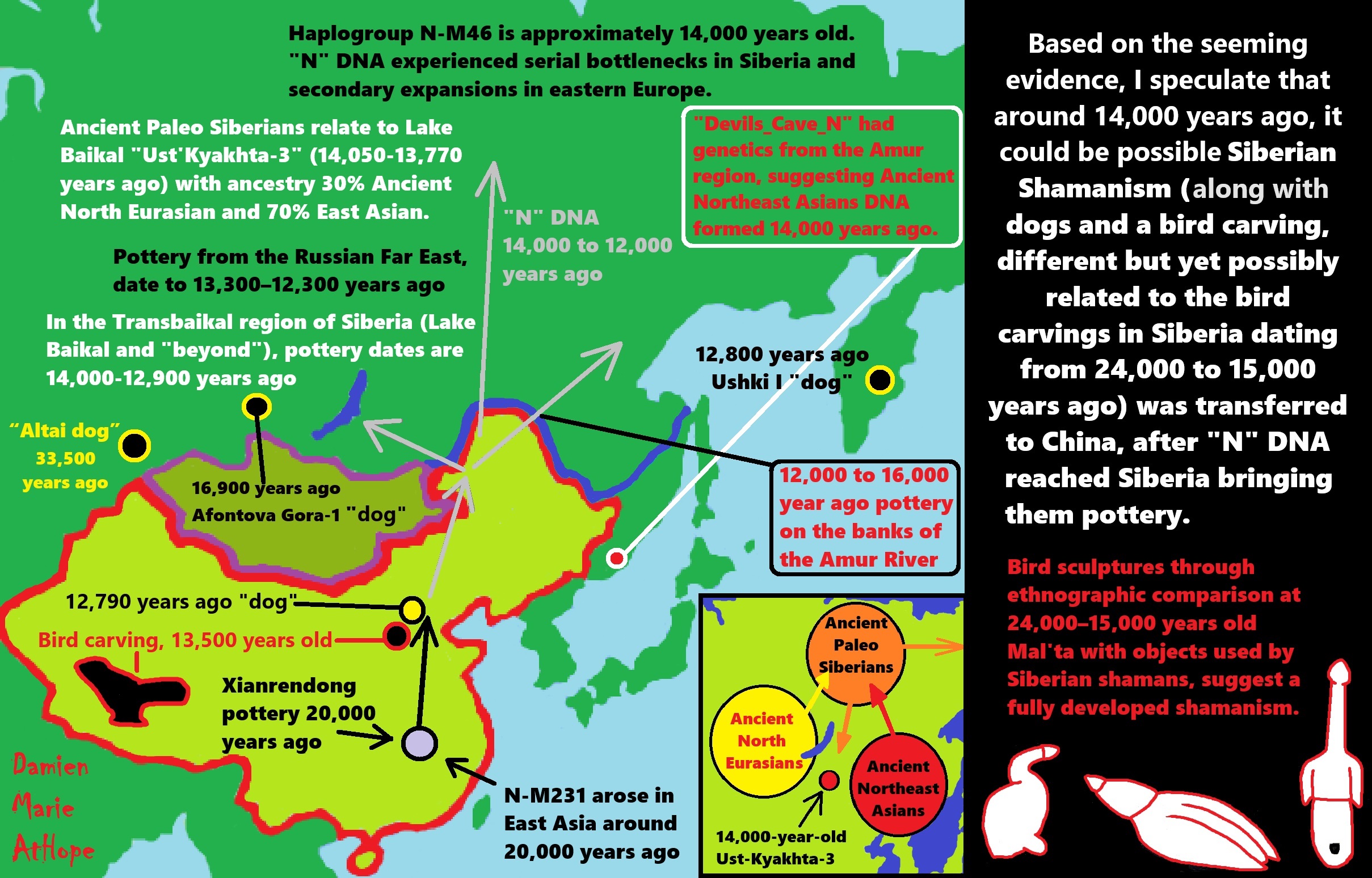
ref, ref, ref, ref, ref, ref, ref, ref, ref, ref, ref, ref, ref, ref, ref, ref
Based on the seeming evidence, I speculate that around 14,000 years ago, it could be possible Siberian Shamanism (along with dogs and a bird carving, different but yet possibly related to the bird carvings in Siberia dating from 24,000 to 15,000 years ago) was transferred to China, after “N” DNA reached Siberia bringing them pottery. Bird sculptures through ethnographic comparison at 24,000–15,000 years old Mal’ta with objects used by Siberian shamans, suggest a fully developed shamanism.
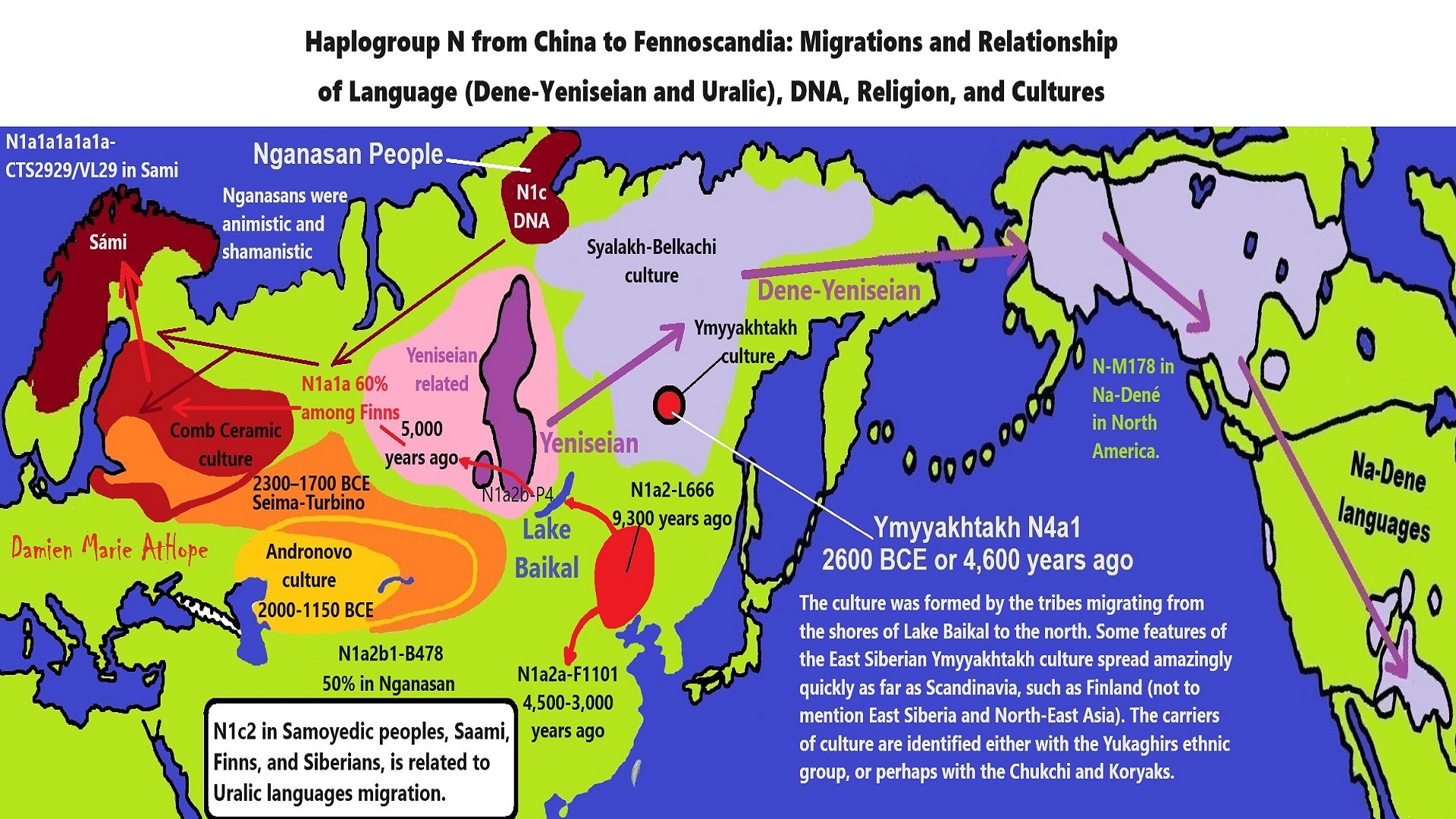
ref, ref, ref, ref, ref, ref, ref, ref, ref, ref, ref, ref, ref, ref, ref, ref
Postglacial genomes from foragers across Northern Eurasia reveal prehistoric
mobility associated with the spread of the Uralic and Yeniseian languages
Abstract
“The North Eurasian forest and forest-steppe zones have sustained millennia of sociocultural connections among northern peoples. We present genome-wide ancient DNA data for 181 individuals from this region spanning the Mesolithic, Neolithic, and Bronze Age. We find that Early to Mid-Holocene hunter-gatherer populations from across the southern forest and forest-steppes of Northern Eurasia can be characterized by a continuous gradient of ancestry that remained stable for millennia, ranging from fully West Eurasian in the Baltic region to fully East Asian in the Transbaikal region. In contrast, cotemporaneous groups in far Northeast Siberia were genetically distinct, retaining high levels of continuity from a population that was the primary source of ancestry for Native Americans. By the mid-Holocene, admixture between this early Northeastern Siberian population and groups from Inland East Asia and the Amur River Basin produced two distinctive populations in eastern Siberia that played an important role in the genetic formation of later people. Ancestry from the first population, Cis-Baikal Late Neolithic-Bronze Age (Cisbaikal_LNBA), is found substantially only among Yeniseian-speaking groups and those known to have admixed with them. Ancestry from the second, Yakutian Late Neolithic-Bronze Age (Yakutia_LNBA), is strongly associated with present-day Uralic speakers. We show how Yakutia_LNBA ancestry spread from an east Siberian origin ~4.5kya, along with subclades of Y-chromosome haplogroup N occurring at high frequencies among present-day Uralic speakers, into Western and Central Siberia in communities associated with Seima-Turbino metallurgy: a suite of advanced bronze casting techniques that spread explosively across an enormous region of Northern Eurasia ~4.0kya. However, the ancestry of the 16 Seima-Turbino-period individuals–the first reported from sites with this metallurgy–was otherwise extraordinarily diverse, with partial descent from Indo-Iranian-speaking pastoralists and multiple hunter-gatherer populations from widely separated regions of Eurasia. Our results provide support for theories suggesting that early Uralic speakers at the beginning of their westward dispersal where involved in the expansion of Seima-Turbino metallurgical traditions, and suggests that both cultural transmission and migration were important in the spread of Seima-Turbino material culture.” ref
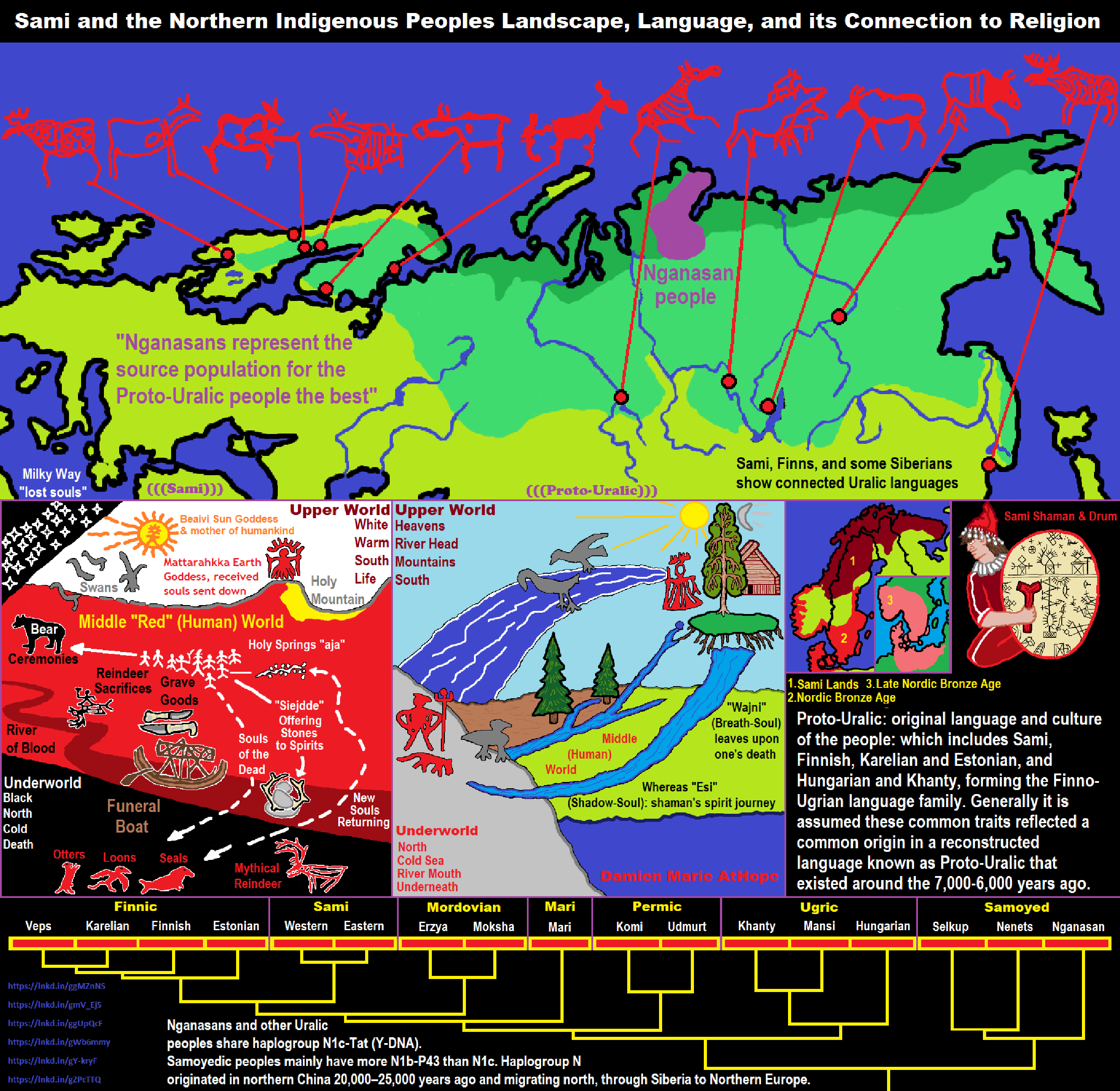
Shamanism encompasses the premise that shamans are:
intermediaries or messengers between the human world and the spirit worlds.
A shaman is someone who is regarded as having access to, and influence in, the world of benevolent and malevolent spirits, who typically enters into a trance state during a ritual, and practices divination and healing. The word “shaman” probably originates from the Tungusic Evenki language of North Asia. According to ethnolinguist Juha Janhunen, “the word is attested in all of the Tungusic idioms” such as Negidal, Lamut, Udehe/Orochi, Nanai, Ilcha, Orok, Manchu and Ulcha, and “nothing seems to contradict the assumption that the meaning ‘shaman’ also derives from Proto-Tungusic” and may have roots that extend back in time at least two millennia. The term was introduced to the west after Russian forces conquered the shamanistic Khanate of Kazan in 1552. The term “shamanism” was first applied by Western anthropologists as outside observers of the ancient religion of the Turks and Mongols, as well as those of the neighbouring Tungusic and Samoyedic-speaking peoples. Upon observing more religious traditions across the world, some Western anthropologists began to also use the term in a very broad sense, to describe unrelated magico-religious practices found within the ethnic religions of other parts of Asia, Africa, Australasia and even completely unrelated parts of the Americas, as they believed these practices to be similar to one another. Mircea Eliade writes, “A first definition of this complex phenomenon, and perhaps the least hazardous, will be: shamanism = ‘technique of religious ecstasy‘.” Shamanism encompasses the premise that shamans are intermediaries or messengers between the human world and the spirit worlds. Shamans are said to treat ailments/illness by mending the soul. Alleviating traumas affecting the soul/spirit restores the physical body of the individual to balance and wholeness. The shaman also enters supernatural realms or dimensions to obtain solutions to problems afflicting the community. Shamans may visit other worlds/dimensions to bring guidance to misguided souls and to ameliorate illnesses of the human soul caused by foreign elements. The shaman operates primarily within the spiritual world, which in turn affects the human world. The restoration of balance results in the elimination of the ailment. Beliefs and practices that have been categorised this way as “shamanic” have attracted the interest of scholars from a wide variety of disciplines, including anthropologists, archaeologists, historians, religious studies scholars, philosophers and psychologists. Hundreds of books and academic papers on the subject have been produced, with a peer-reviewed academic journal being devoted to the study of shamanism.
Regional variations of Shamanism
- Asia
- Europe
- Circumpolar shamanism
- Americas
- Oceania
- Africa
- Contemporary Western shamanism
* “shamanist” Believe in spirit-filled life and/or afterlife can be attached to or be expressed in things or objects and these objects can be used by special persons or in special rituals can connect to spirit-filled life and/or afterlife (you are a hidden shamanist/Shamanism: an approximately 30,000-year-old belief system) there is what is believed to be a female shaman burial with a matching carved ivory female head belonging to the Pavlovian culture 29,000 to 25,000 a variant of the Gravettian/(Gravettian culture 33,000 to 22,000 years ago), dated to 29,000 to 25,000-years old Dolní Vestonice, Moravia, Czech Republic. A carved ivory figure in the shape of a female head was discovered near the huts. The left side of the figure’s face was distorted image is believed to be a description of elder female’s burial around 40 years old, she was ritualistically placed beneath a pair of mammoth scapulae, one leaning against the other. Surprisingly, the left side of the skull was disfigured in the same manner as the aforementioned carved ivory figure, indicating that the figure was an intentional depiction of this specific individual. The bones and the earth surrounding the body contained traces of red ocher, a flint spearhead had been placed near the skull, and one hand holding the body of a fox. This evidence suggests that this was the burial site of a shaman. This is the oldest site not only of ceramic figurines and artistic portraiture but also of evidence of early female shamans. Archaeologists usually describe two regional variants: the western Gravettian, known namely from cave sites in France, Spain and Britain, and the eastern Gravettian in Central Europe and Russia. The eastern Gravettians — they include the Pavlovian culture — were specialized mammoth hunters, whose remains are usually found not in caves but in open air sites. The origins of the Gravettian people are not clear, they seem to appear simultaneously all over Europe. Though they carried distinct genetic signatures, the Gravettians and Aurignacians before them were descended from the same ancient founder population. According to genetic data, 37,000 years ago, all Europeans can be traced back to a single ‘founding population’ that made it through the last ice age. Furthermore, the so-called founding fathers were part of the Aurignacian culture which was displaced by another group of early humans members of the Gravettian culture. Between 37,000 years ago and 14,000 years ago, different groups of Europeans were descended from a single founder population. To a greater extent than their Aurignacian predecessors, they are known for their Venus figurines. ref, ref, ref, ref
So, it all starts in a general way with Animism (theoretical belief in supernatural powers/spirits), then this is physically expressed in or with Totemism (theoretical belief in a mythical relationship with powers/spirits through a totem item), which then enlists a full-time specific person to do this worship and believed interacting Shamanism (theoretical belief in access and influence with spirits through ritual), and then there is the further employment of myths and gods added to all the above giving you Paganism (often a lot more nature-based than most current top world religions, thus hinting to their close link to more ancient religious thinking it stems from). My hypothesis is expressed with an explanation of the building of a theatrical house (modern religions development).
Sky Burials: Animism, Totemism, Shamanism, and Paganism
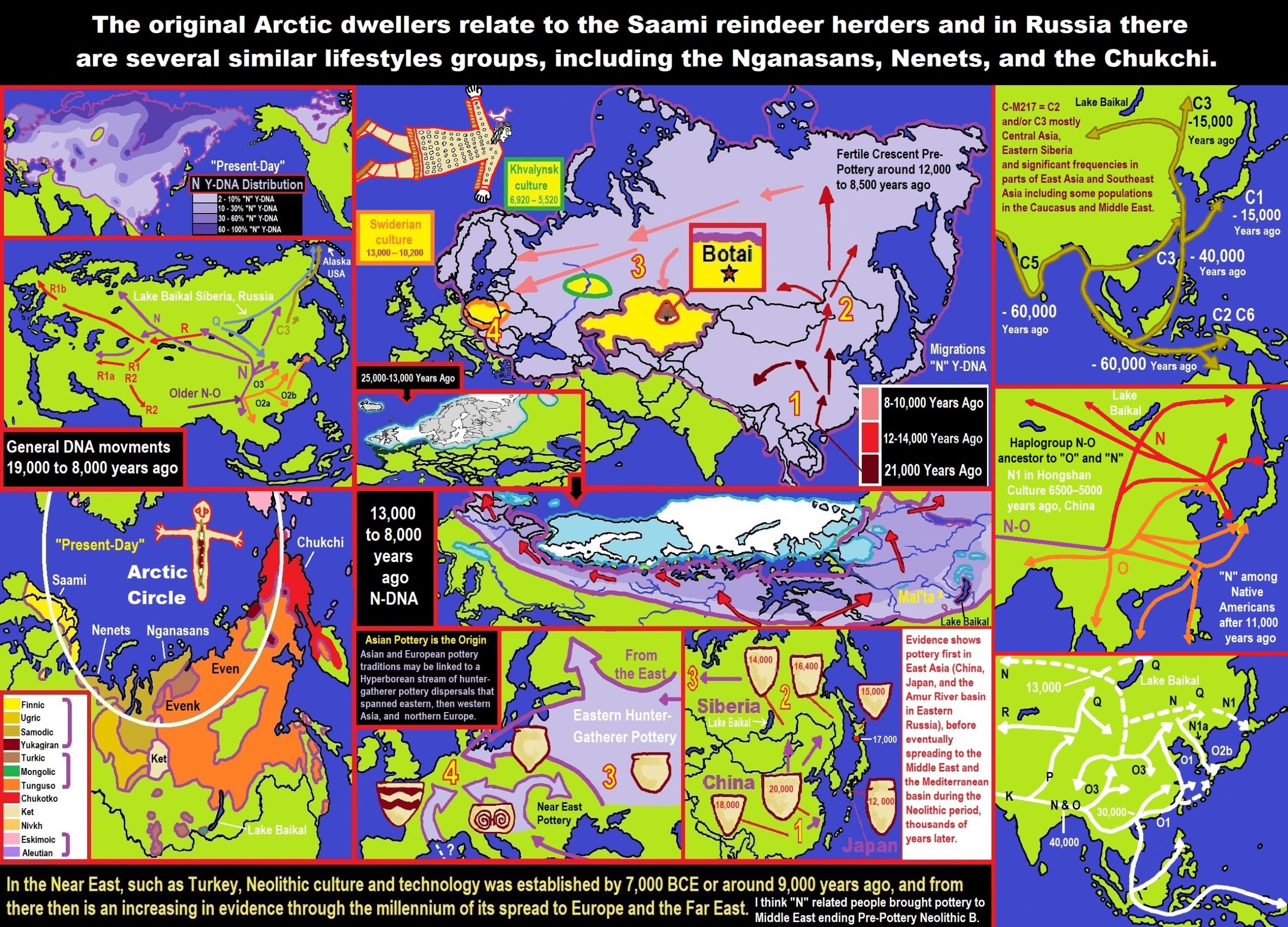
ref, ref, ref, ref, ref, ref, ref, ref, ref, ref, ref, ref, ref, ref, ref, ref, ref
“The shaman is, above all, a connecting figure, bridging several worlds for his people, traveling between this world, the underworld, and the heavens. He transforms himself into an animal and talks with ghosts, the dead, the deities, and the ancestors. He dies and revives. He brings back knowledge from the shadow realm, thus linking his people to the spirits and places which were once mythically accessible to all.–anthropologist Barbara Meyerhoff” ref

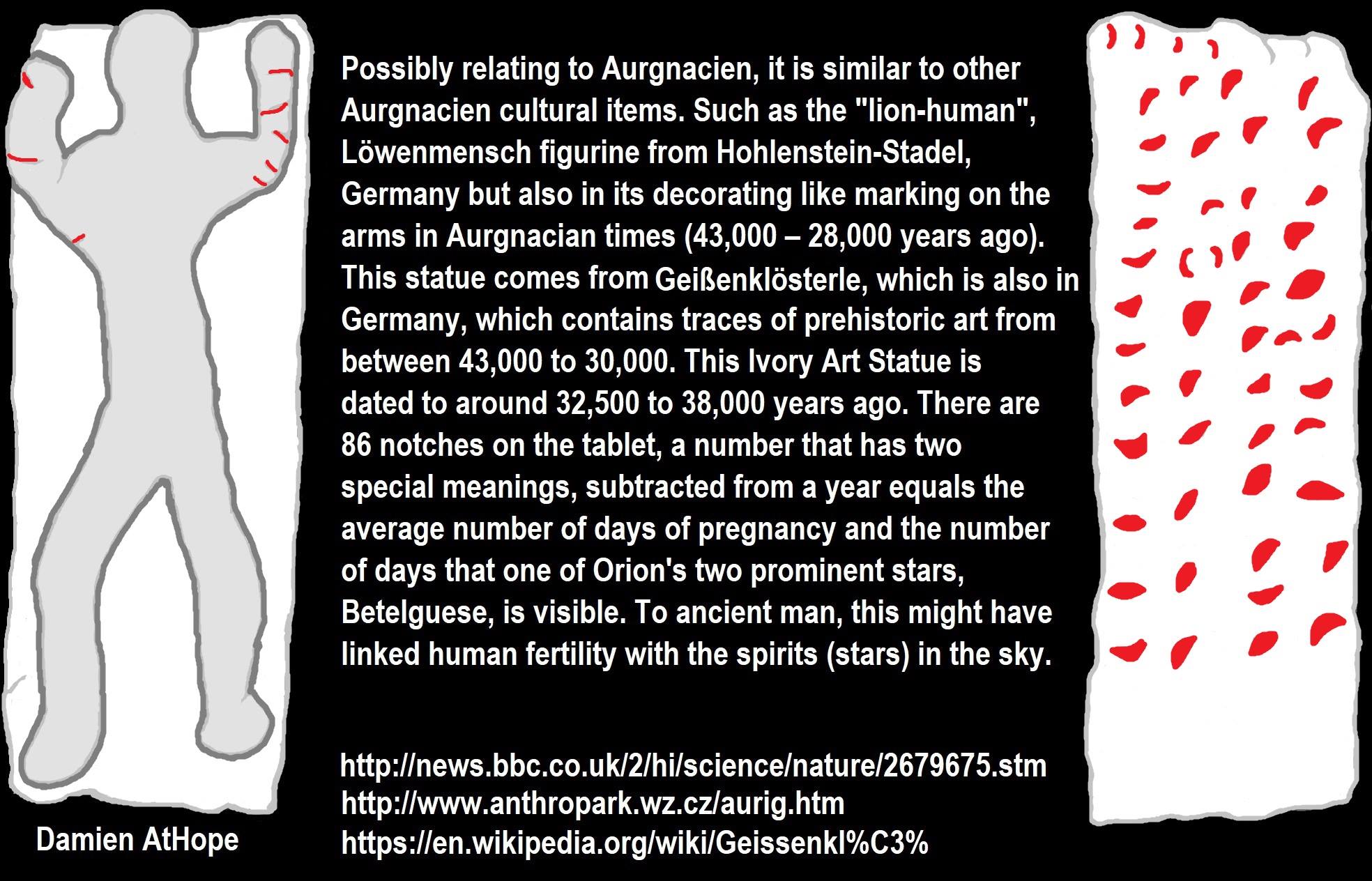
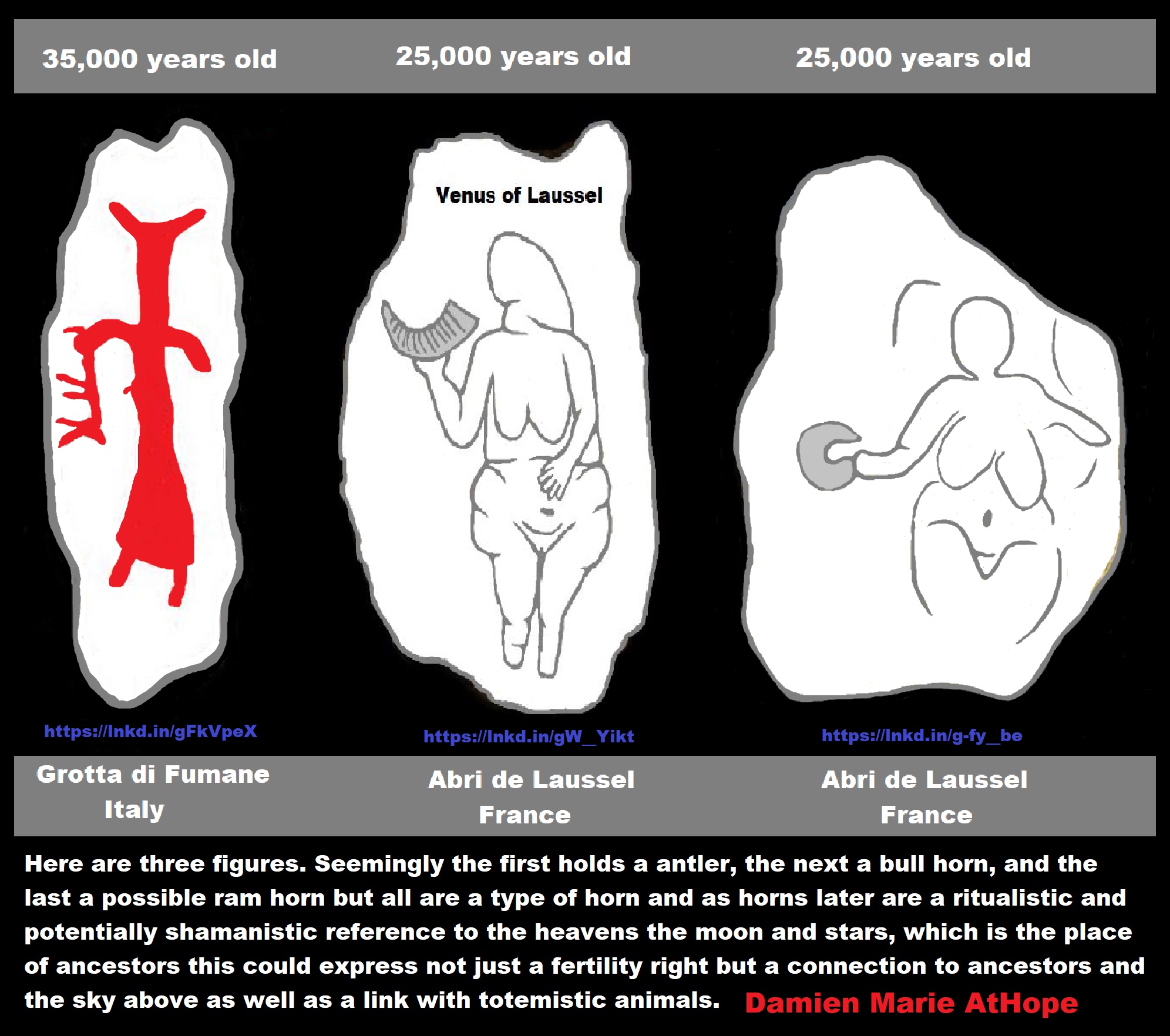

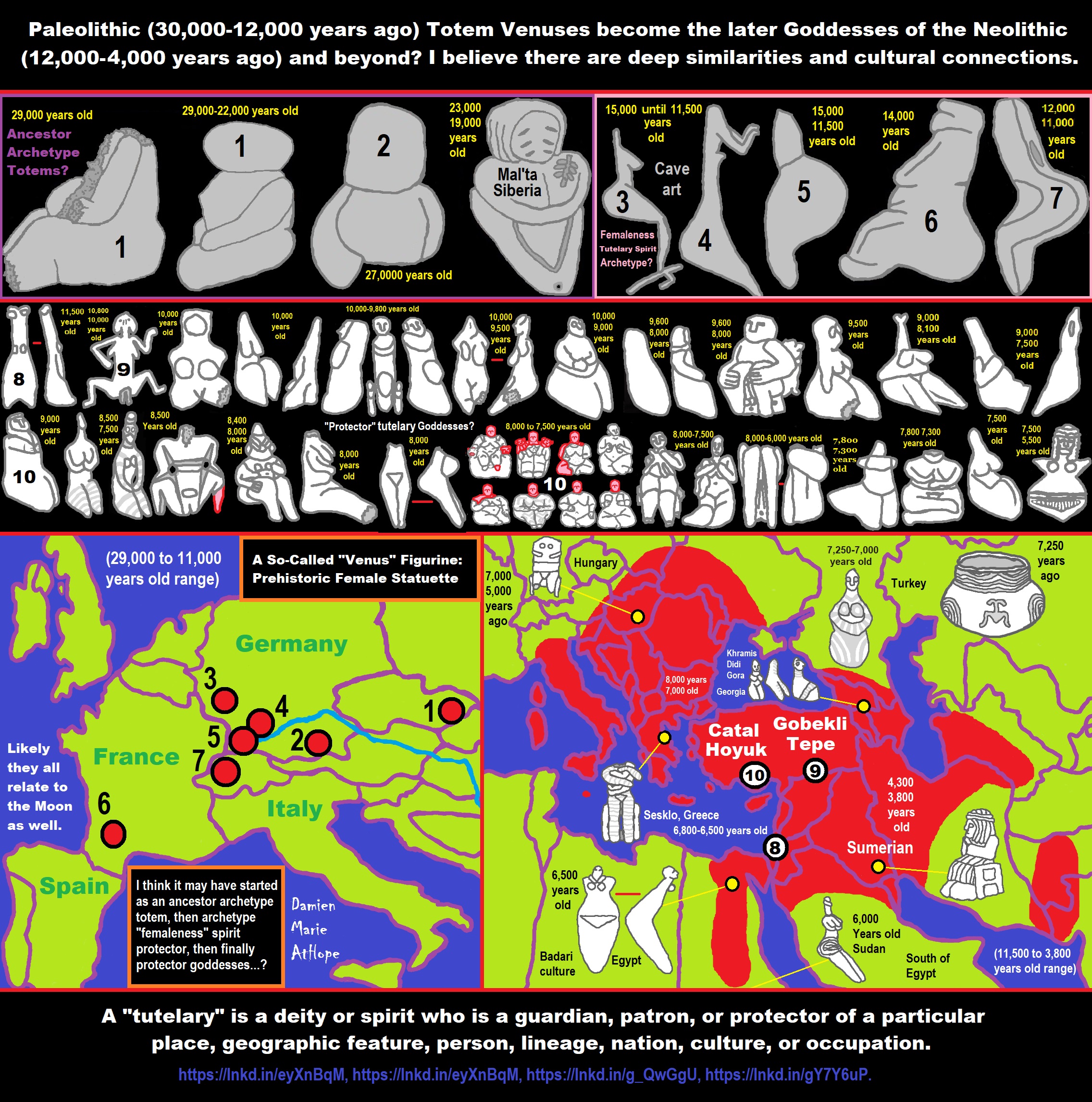
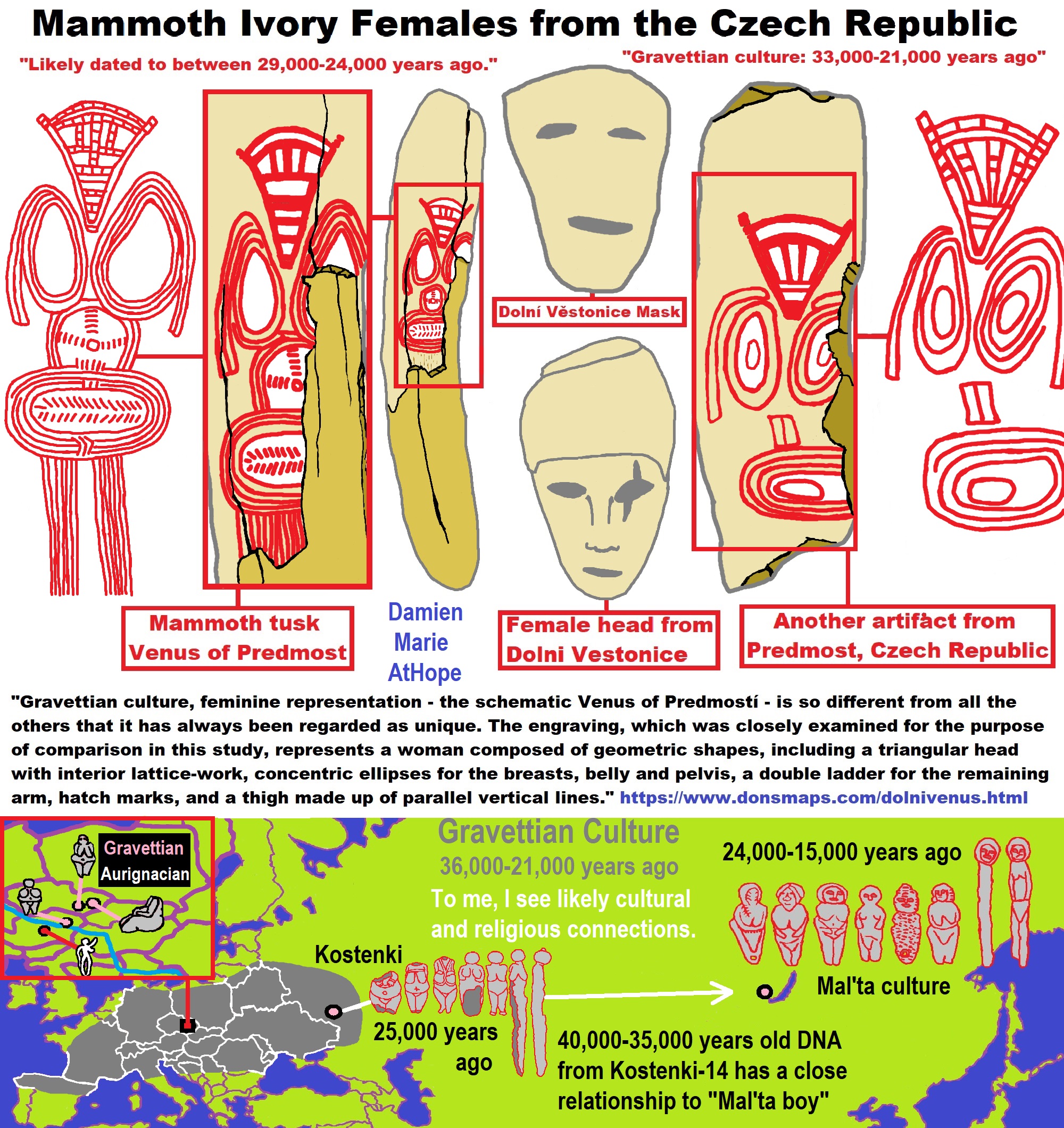

“Probably occupied from as much as around 38,900–32,630 years ago. It had previously been dated at a lower date as low as around 23,000-19,000 years ago which changed.” ref
Sungar “Gravettian culture” (Russia) and related Dolni Vestonice Pavlovian/Gravettian culture (Czech Republic).
Sungar (Russia), found posable evidence of shamanistic Gravettian culture burials and that seem to match the latter indigenous American shamanistic burials in Alaska at the Tanana River site with around 11,500 years old duel infant burial very similar shamanistic grave offerings like decorated stone weapons. To further a clear connection is the Bluefish Cave (Yukon Territory Canada) that held bones with cut marks which is possibly as old as 24,000 to 19,650 years ago and the youngest are around 12,000 years old seem to offer strong support for the “Beringian hypothesis” human population dispersed to North and South America. ref
To me, is seems Siberian is the general origin of native Americans at least by around 11,000 years ago, by the land bridge “Beringia” from Asia by way of Siberia in Russia over to Alaska in the Americas, which the Paleoindians had crossover on, finally flooded over by rising sea levels and was submerged. Siberia has a large variety of climate, vegetation, and landscape. Siberia’s Prehistory demonstrates several distinct cultures sometimes transferring ideas, other times not, and some split from earlier cultures creating new ones often in illation, mainly starting with hunter-gatherer nomadism. During glaciation around 115,000 to 15,000 years ago, the Siberia tundra extended south and an ice sheet covered area of Russia around the Ural Mountains that while some of the oldest mountains are more like large hills, and the area to the east of the lower Yenisei River basin, which in the general area of central and southern Siberia. ref
Some of the first nomadic peoples entered Siberia about 50,000 years ago. Ancient nomadic tribes such as the Ket people and the Yugh people a separate but similar group lived along its banks. Shamanism among Kets shares characteristics with those of Turkic and Mongolic peoples thus not at all homogeneous in expression though neither is shamanism in Siberia in general. As for shamanism among Kets had several types of Ket shamans and shared characteristics with those of Turkic and Mongolic peoples. The Yana River sites, in Siberia, demonstrate that modern human populations had reached Western Beringia by 32,000 years ago then engaging in an early dispersal possibly by 24,000 years ago. ref
SHAMANISM IN RUSSIA AND MONGOLIA
“Shamanism is still practiced in Russia, particularly in the Lake Baikal area of southern Siberia near the Mongolian border and in the middle Volga regions. The word Shamanism comes from Siberia. And believed shamanistic powers are passed on from generation to generation or by spontaneous vocation during an initiation ceremony that usually involves some kind of ecstatic death, rebirth, vision or experience. Though a for some shaman cultures a distinction is made between hereditary ones and those who have become shaman after suffering a serious illness. A shamanist is a one person cult-authority, spirit medium, soul-traveler, meteorologist, physician, philosopher, and ideologist.” ref
“Shaman have traditionally been important religious figures and healers among many Siberian peoples and commonly connect to and revolved around hunting and family/ancestor cults. The word “shaman” comes to us from the Tungus language via Russian. In Siberia, shamans have traditionally been called upon to heal the sick, solve problems, protect groups from hostile spirts, make predictions and mediate between the spiritual world and human world and guide dead souls to the afterlife.” ref
“After death it was believed that the breath soul left through the nostrils.
Many groups make wooden images of dolls of the deceased and for a period of time, they are treated like the real person. A wide variety of goods may be placed in the graves of the deceased, depending on the group. These generally include things the deceased needs in the next life. Often totems are broken or defaced in some way to “kill” them so they don’t assist the dead in returning. Some groups placed the dead in graves others on the ground covering them with something, while other groups placed the dead on a special platform on the trees.” ref
“Shaman cults tend to revolve around animals, natural objects, heroes and clan leaders have also been central to the lives of many of Siberia’s indigenous people. Many groups have strong beliefs in spirits, in realms of the sky and earth and follow cults associated with animals, especially the Raven. Things like illness and other misfortunes were attributed to spirits. Many Arctic people believe that each person has two souls: (1) a shadow soul that may leave the body during sleep or unconsciousness and take the form of a bee or a butterfly, and (2) a “breath” soul that provides life to humans and animals. Many groups believe the life forces lies within the bones, blood, and vital organs. For this reason the bones of the dead are treated with great reverence so a new life can be regenerated from them.” ref
“The Khanty (an indigenous people calling themselves Khanti, Khande, Kantek, living in Khanty–Mansi Autonomous Okrug, a region historically known as “Yugra” in Russia) shamans who believe the forest is inhabited by invisible people and spirits of animals, forest, rivers and natural landmarks. The most important spirits belong to the sun, moon, and bear. Khanty shaman work as intermediaries between the living worlds and the spiritual world. The invisible people are like gremlins or trolls. They are blamed for missing puppies, strange events and unexplained behavior.” ref
Why This Paleolithic Burial Site Is So Strange (and So Important)
“In addition to beads and ochre, carefully manufactured mammoth ivory spears, ivory disks, and pierced cervid antlers were found with the skeletons. And this is not supersizing because by approximately 40,000 years ago, narrow stone blades and tools made of bone, ivory, and antler appeared, along with simple wood instruments. Yet these extravagant burials are only part of the reason why Sungir stands out as the site is characterized by a much greater diversity of mortuary behaviors than archaeologists previously thought. ” ref, ref
“Sungir – Sunghir is a site that held multiple burials of least 10 individuals and specifically two of the most extraordinary Upper Paleolithic burials known: one of an adult male “Sungir-1” and another of two children “Sungir-2 and Sungir-3. The two children originally thought to be a boy and girl,are now thought to be two boys interred head-to-head. All remains were covered in ochre and were accompanied by rich grave goods including ivory beads and spears, armbands, and carvings, as well as arctic fox canines. Adjacent to Sungir-2 was the femoral diaphysis (main or midsection (shaft) of a long bone) of an adult “Sungir 4″ that had been polished, hollowed out, and filled with red ochre. The site also yielded other less complete human remains, some of uncertain stratigraphic provenance [Sunghir 5 to 9. Radiocarbon analyses place the age of Sungir-1 to Sungir 4 date between 33,600-34,600 years ago. The homogeneity in morphological traits (e.g., metopism) among the remains, as well as signs of possible congenital pathologies in SIII, have been interpreted as evidence of inbreeding. Other Upper Paleolithic individuals with reported congenital or degenerative pathologies (e.g., at Barma Grande and Dolní Věstonice) reinforce the view that Upper Paleolithic groups were small and susceptible to inbreeding, possibly as extensive as what has been reported for the Altai Neandertal. However, genomic data available for some of those individuals were of insufficient coverage to infer population sizes or inbreeding levels.” ref, ref
Picture: link
“There where at least three different forms of burials were practiced at Sunghir. While an adult femur shaft was found in the grave with the two youngsters, another femur bone was discovered isolated near the graves, with indications that the body had been abandoned on the surface without receiving any formal treatment. A cranium, was found with artifacts just above the adult’s lavish grave. This cranium represents only one part of the skeleton, it appears to have been deposited there in the context of a funerary ritual.” ref
“Sungir may thus be considered as the earliest modern human burial site in Europe with evidence of a social structure that would not have solely depended on people’s acquired status. And as can be indicative to a general shamanism thinking about body difference being special, both the juvenile and the adolescent appear to have suffered from physical abnormalities and likely their disabilities would have been visible to others. Their difference may have been part of the reason they were given an extravagant burial.” ref
“Analyses of mtDNA genomes from Sungir1 to Sungir 4 put them in haplogroup U, consistent with West Eurasian and Siberian Paleolithic and Mesolithic genomes. Sungir1 belongs to haplogroup U8c; the sequences for the three individuals from the double burial ( Sungir 2 to Sungir 4) are identical and belong to haplogroup U2, which is closely related to the Upper Paleolithic Kostenki 12 and Kostenki 14 individuals. Phylogenetic analyses of the Y chromosome sequences place all Sungir individuals in an early divergent lineage of haplogroup C1a2. Y chromosome haplogroup C1, which is rare among contemporary Eurasians, has been found in other early European individuals, including the ~36,000-year-old Kostenki 14.” ref
“Haplogroup C1a2 (also known as Haplogroup C-V20): which has been discovered in the remains of Palaeolithic people in Czech Republic (30,000 years ago), Belgium (35,000 years ago), and the Sunghir archaeological site near Vladimir, Russia. Regarding more recent prehistory, Haplogroup C-V20 has been found in the remains of a male (died ca. 7,000 years ago) associated with a late group of the Alföld Linear Pottery culture at Kompolt-Kigyósér, Hungary whose mtDNA belonged to haplogroup J1c1, the remains of a male (died ca. 7,000 years ago) associated with the LBK Culture at Apc-Berekalja (I.), Hungary whose mtDNA belonged to haplogroup K1a3a3, and the remains of a male (died ca. 7,000 years ago) associated with Mesolithic culture at La Braña-Arintero, León, Spain whose mtDNA belonged to haplogroup U5b2c1. Haplogroup C-V20 Y-DNA also has been found in a small number of modern Europeans, Algerian Berbers,[6]Armenians, and Nepalis. It includes many Y-DNA samples associated with the oldest currently known population of anatomically modern humans in Europe (Cro-Magnons), and it is considered to be a carrier of the Upper Paleolithic Aurignacian culture that began 40,000 years ago.” ref
“There is significant Totamistic-Shamanism activity from Dolni Vestonice in the Czech Republic, with triple burial three teenagers to larger males DV 13 and DV 14 side by side flanking a smaller handicap male DV 15 in the middle position of the burial, a single older woman shaman burial with a carved portrait, and a Venus of Dolní Věstonice, 27,000 and 25,000 years ago. The Dna of three inhabitants of Dolni Vestonice, lived 31,155 years ago and to have mitochondrial haplogroup U, and one inhabitant mitochondrial haplogroup U8.” ref, ref, ref, ref, ref
Early Gravettian – The Pavlovian
“As the most important component of the Early Gravettian in Danubian Europe, the Pavlovian (30 – 25 ky) occupies a central location within the Lower Austrian – Moravian – South Polish geomorphological corridor (fig. 2a). Both the Pavlovian settlement archaeology and the resource analysis suggest a discontinuity compared to the previous Early Upper Paleolithic settlement strategies: the typical formation of the large open-air settlements in an axial manner, in lower altitudes and along the rivers; the long-distance transport of lithic raw materials; the intensive exploitation of mammoths supplemented by a variety of small animals; and, finally, aspects of ritual and style.” ref
“The art production at this stage of the Gravettian is remarkably complex, and includes carvings and engravings, soft stone carvings, and especially the ceramic plastic production. A majority of the human skeletal remains are equally dated to this period (Predmostí, Dolní Vestonice – Pavlov, Krems). Some of the ritual burials are covered by ochre, and some are covered by mammoth shoulderblades. It should be underlined, however, that they are poorly equipped by additive artifacts (if any, so just a few pierced decorative objects. The earliest Pavlovian occupation is best documented at Willendorf II, layer 5 (around and after 30 ky BP), Krems, and Dolní Vestonice II (a complex occupation horizons dated to 27 ky). The industry is dominated by burins, backed implements, and endscrapers, where burins are about the twice as numerous as endscrapers. The number of microliths, and especially geometric microliths, is usually low. A variety of pointed blades (including the Jerzmanowice-type points) and pointed microblades (including the Krems or Font Yves points) occur as well.” ref
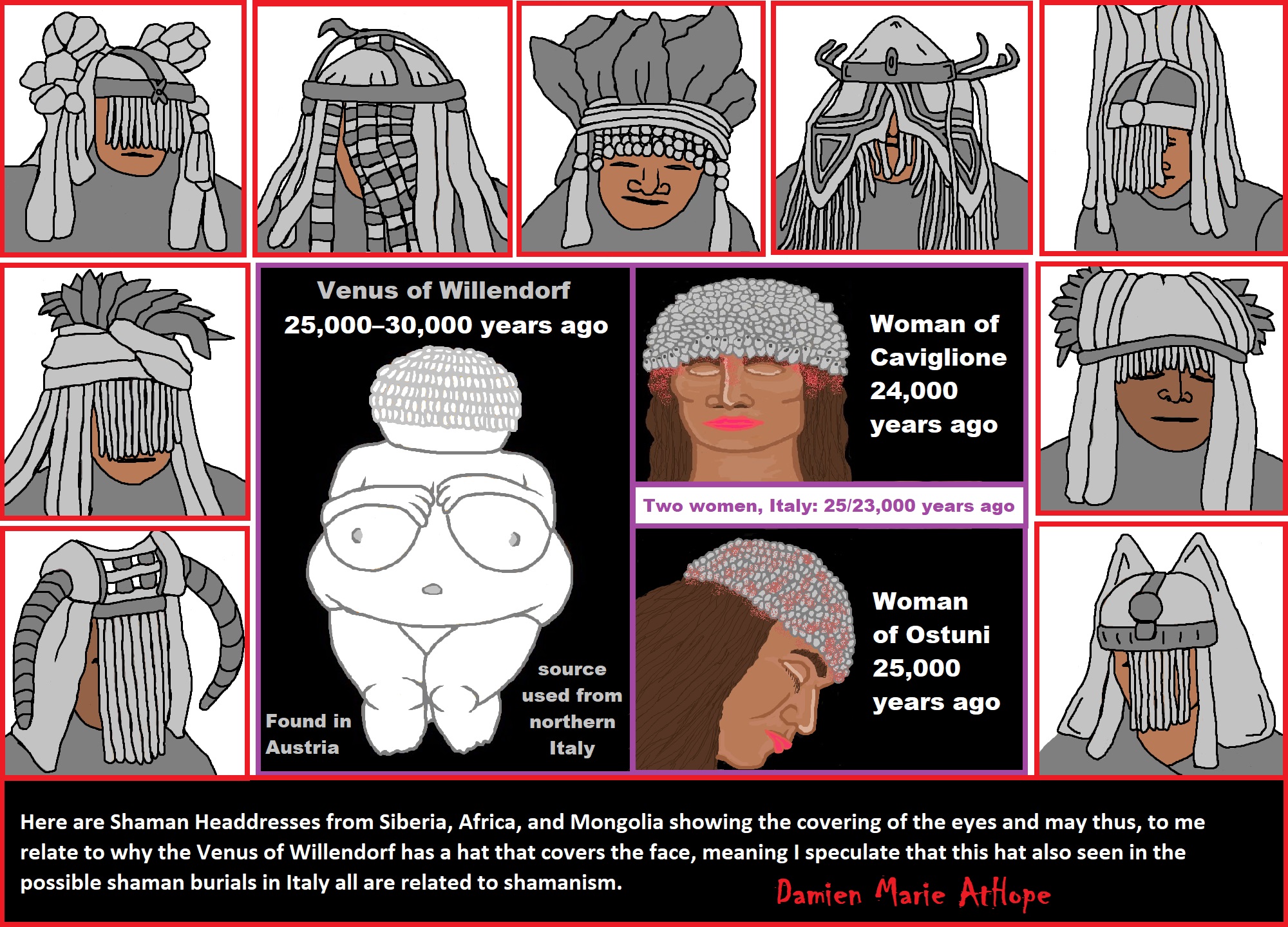
Here are Shaman Headdresses from Siberia, Africa, and Mongolia showing the covering of the eyes and may thus, to me relate to why the Venus of Willendorf has a hat that covers the face, meaning I speculate that this hat, also seen in the possible shaman burials in Italy all are related to shamanism.
Venus of Willendorf: Shamanism Headdresses that Cover the Eyes?
“Venus figurines have been unearthed in Europe, Siberia, and much of Eurasia.
Most date from the Gravettian period but start in the Aurignacian era, and lasts to the Magdalenian time.” ref
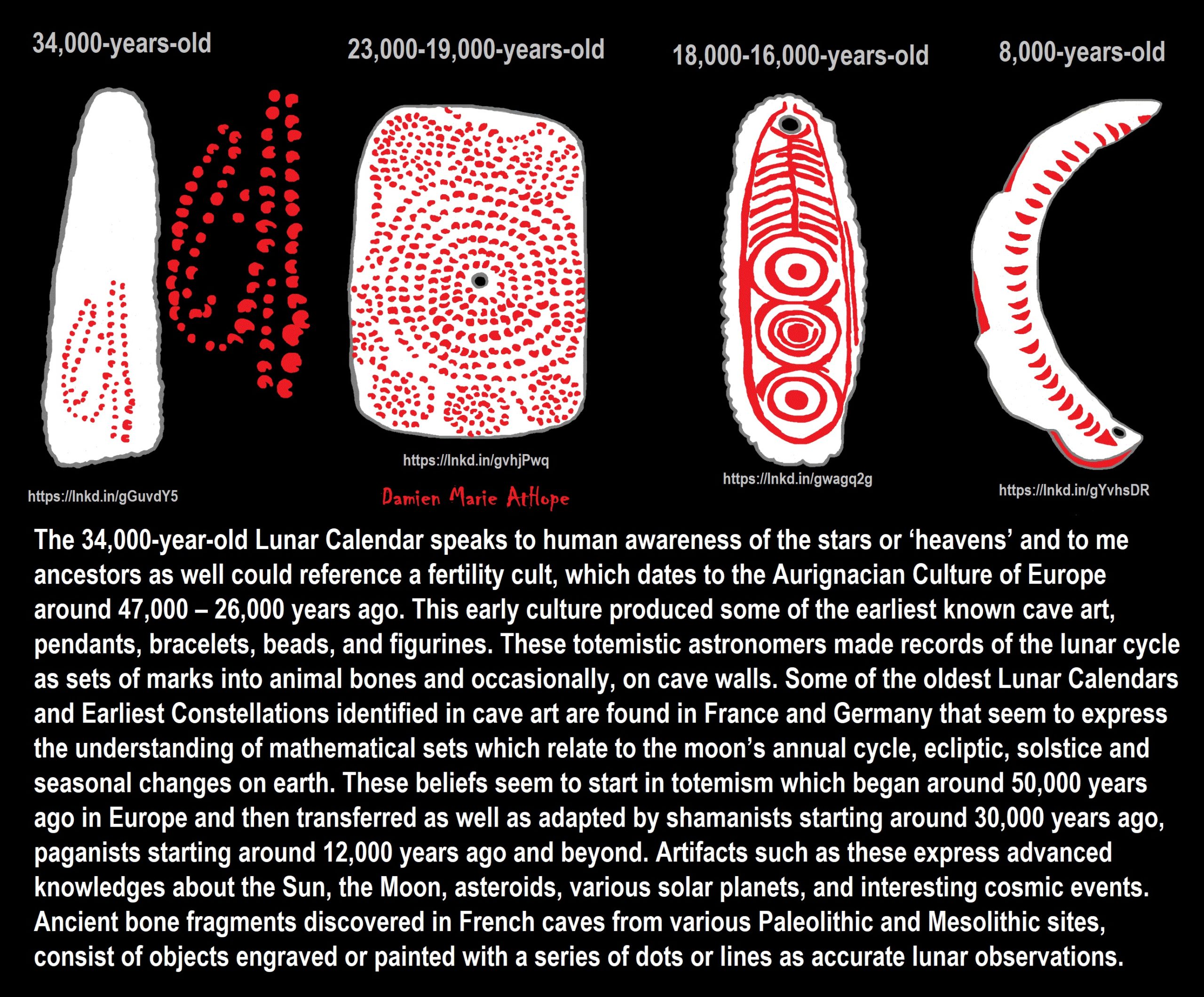
34,000 years ago Lunar Calendar Cave art around the Time Shift From Totemism to Early Shamanism?
“The Oldest Lunar Calendars and Earliest Constellations have been identified in cave art found in France and Germany. The astronomer-priests of these late Upper Paleolithic Cultures understood mathematical sets, and the interplay between the moon annual cycle, ecliptic, solstice and seasonal changes on earth. The archaeological record’s earliest data that speaks to human awareness of the stars and ‘heavens’ dates to the Aurignacian Culture of Europe, around 34,000 years ago. Between 1964 and the early 1990s, Alexander Marshack published breakthrough research that documented the mathematical and astronomical knowledge in the Late Upper Paleolithic Cultures of Europe. Marshack deciphered sets of marks carved into animal bones, and occasionally on the walls of caves, as records of the lunar cycle. These marks are sets of crescents or lines. Artisans carefully controlled line thickness so that a correlation with lunar phases would be as easy as possible to perceive. Sets of marks were often laid out in a serpentine pattern that suggests a snake deity or streams and rivers. Many of these lunar calendars were made on small pieces of stone, bone or antler so that they could be easily carried. These small, portable, lightweight lunar calendars were easily carried on extended journeys such as long hunting trips and seasonal migrations.” ref
“Hunting the largest animals was arduous, and might require hunters to follow herds of horses, bison, mammoth or ibex for many weeks. (Other big animals such as the auroch, cave bear and cave lion were well known but rarely hunted for food because they had a special status in the mythic realm. The Auroch is very important to the search for earliest constellations.) The phases of the moon depicted in these sets of marks are inexact. Precision was impossible unless all nights were perfectly clear which is an unrealistic expectation. The arithmetic counting skill implied by these small lunar calendars is obvious. The recognition that there are phases of the moon and seasons of the year that can be counted – that should be counted because they are important – is profound. “All animal activities are time factored, simply because time passes, the future is forever arriving. The reality of time factoring is objective physics and does not depend upon human awareness or consciousness. Until Marshack’s work, many archeologists believed the sets of marks he chose to study were nothing but the aimless doodles of bored toolmakers. What Marshack uncovered is the intuitive discovery of mathematical sets and the application of those sets to the construction of a calendar.” Bone is the preferred medium because it allows for easy transport and a long calendar lifetime. Mankind’s earliest astronomy brought the clan into the multi-dimensional universe of the gods. Objects used in the most potent rituals had the highest contextual, cultural value and were treated with great reverence.” ref
“Regarding the Aurignacian, between 43,000 and 35,000 years ago, the archaeological record from habitations is relatively poor in the Ardèche (Abri des Pécheurs, Grotte du Figuier) while appearing more abundant in the Languedoc (La Salpétrière, La Balauzière, Esquicho-Grapaou, La Laouza etc.). The same applies to the sites of the early phases of the Gravettian. During climatic fluctuations, and unlike the deep caves such as Chauvet, the porch and shelter fills seem to have better recorded the cold episodes than the humid phases. To date, 20 decorated caves are indexed in the gorges of the Ardèche and nearby; in other words as far as the valley of the Gardon (Baume-Latrone). This group includes several important caves (Ebbou, Oulen, Émilie etc.) which are not precisely dated and were judged to be of secondary importance until the discovery of the Chauvet Cave.” ref
“A 10,000-year-old engraved stone could be a lunar calendar. The rare pebble — found high up in the mountains near Rome, Italy, the hammer-stone was found on top of Monte Alta in the Alban Hills. It’s believed that our early ancestors would’ve used the stone to keep track of the moon’s cycles. Notches were engraved “as if they were being used to count, calculate or store the record of some kind of information. And these notches — which total either 27 or 28 — suggest the stone’s engraver used the pebble to track lunar cycles.” ref
“Archaeologists excavating in Scotland found a series of huge pits were dug by Mesolithic people to track the cycle of the Moon. They found a series of twelve huge, specially shaped pits designed to mimic the various phases of the Moon. The holes aligned perfectly on the midwinter solstice to help the hunter-gathers of Mesolithic Britain keep precise track of the passage of the seasons and the lunar cycle. The holes were dug in the shapes of various phases of the moon. “Waxing, waning, crescents, and gibbous, they’re all there and arranged in a 50-meter-long (164-foot) arc. The one representing the full moon is large and circular, approximately two meters (roughly seven feet) across, and placed right in the center. And this arc is arranged perfectly with a notch in the landscape where the sun would have risen on the day of the midwinter solstice about 10,000 years ago. Placing their calendar in the landscape the way they did would have let the people who built it to recalibrate the lunar months every winter to bring their lunar calendar in line with the solar year. This means that any effort to keep track of the seasons using the moon alone will slowly drift ever further from true. An observer needs to know when to add or subtract an extra month to make good the time or hit the reset button and start counting again.” ref
“A moon-shaped calendar was found in Smederevska Palanka, Serbia that dates back 8,000 years, and is made from a wild boar’s tusk engraved with markings to denote a lunar cycle. Farmers may have used the device to plan when to plant crops. It is made from the tusk of a wild boar and is marked with engravings thought to denote a lunar cycle of 28 days, as well as the four phases of the moon.” ref
“A lunisolar calendar was found at Warren Field in Scotland and has been dated to c. 8000 BCE, during the Mesolithic period. Some scholars argue for lunar calendars still earlier—Rappenglück in the marks on a c. 17,000-year-old cave painting at Lascaux and Marshack in the marks on a c. 27,000-year-old bone baton—but their findings remain controversial. Scholars have argued that ancient hunters conducted regular astronomical observations of the Moon back in the Upper Palaeolithic. Samuel L. Macey dates the earliest uses of the Moon as a time-measuring device back to 28,000–30,000 years ago.” ref
“A lunar calendar is a calendar based on the monthly cycles of the Moon‘s phases (synodic months, lunations), in contrast to solar calendars, whose annual cycles are based only directly on the solar year. The most commonly used calendar, the Gregorian calendar, is a solar calendar system that originally evolved out of a lunar calendar system. A purely lunar calendar is also distinguished from a lunisolar calendar, whose lunar months are brought into alignment with the solar year through some process of intercalation. The details of when months begin varies from calendar to calendar, with some using new, full, or crescent moons and others employing detailed calculations.” ref
“Since each lunation is approximately 29+1⁄2 days, it is common for the months of a lunar calendar to alternate between 29 and 30 days. Since the period of 12 such lunations, a lunar year, is 354 days, 8 hours, 48 minutes, 34 seconds (354.36707 days), purely lunar calendars are 11 to 12 days shorter than the solar year. In purely lunar calendars, which do not make use of intercalation, like the Islamic calendar, the lunar months cycle through all the seasons of a solar year over the course of a 33–34 lunar-year cycle.” ref
“Although the Gregorian calendar is in common and legal use in most countries, traditional lunar and lunisolar calendars continue to be used throughout the world to determine religious festivals and national holidays. Such holidays include Rosh Hashanah (Hebrew calendar); Easter (the Computus); the Chinese, Korean, Vietnamese, and Mongolian New Year (Chinese, Korean, Vietnamese, and Mongolian calendars, respectively); the Nepali New Year (Nepali calendar); the Mid-Autumn Festival and Chuseok (Chinese and Korean calendars); Loi Krathong (Thai calendar); Sunuwar calendar; Vesak/Buddha’s Birthday (Buddhist calendar); Diwali (Hindu calendars); Ramadan, Eid al-Fitr and Eid al-Adha (Islamic calendar).” ref
“The Japanese Calendar formerly used both the lunar and lunisolar calendar before it was replaced by the Gregorian Calendar during the Meiji government in 1872. Holidays such as the Japanese New Year were simply transposed on top as opposed to being calculated like other countries that use the lunisolar and Gregorian calendars together, for example, the Japanese New Year now falls on January 1, creating a month delay as opposed to other East Asian Countries. See customary issues in modern Japan.” ref
“Most calendars referred to as “lunar” calendars are in fact lunisolar calendars. Their months are based on observations of the lunar cycle, with intercalation being used to bring them into general agreement with the solar year. The solar “civic calendar” that was used in ancient Egypt showed traces of its origin in the earlier lunar calendar, which continued to be used alongside it for religious and agricultural purposes. Present-day lunisolar calendars include the Chinese, Vietnamese, Hindu, and Thai calendars.” ref
“Synodic months are 29 or 30 days in length, making a lunar year of 12 months about 11 to 12 days shorter than a solar year. Some lunar calendars do not use intercalation, for example, the lunar Hijri calendar used by most Muslims. For those that do, such as the Hebrew calendar, and Buddhist Calendars in Myanmar, the most common form of intercalation is to add an additional month every second or third year. Some lunisolar calendars are also calibrated by annual natural events which are affected by lunar cycles as well as the solar cycle. An example of this is the lunar calendar of the Banks Islands, which includes three months in which the edible palolo worms mass on the beaches. These events occur at the last quarter of the lunar month, as the reproductive cycle of the palolos is synchronized with the moon.” ref
“Lunar and lunisolar calendars differ as to which day is the first day of the month. In some lunisolar calendars, such as the Chinese calendar, the first day of a month is the day when an astronomical new moon occurs in a particular time zone. In others, such as some Hindu calendars, each month begins on the day after the full moon. Others are based on the first sighting of the lunar crescent, such as the lunar Hijri calendar (and, historically, the Hebrew calendar).” ref
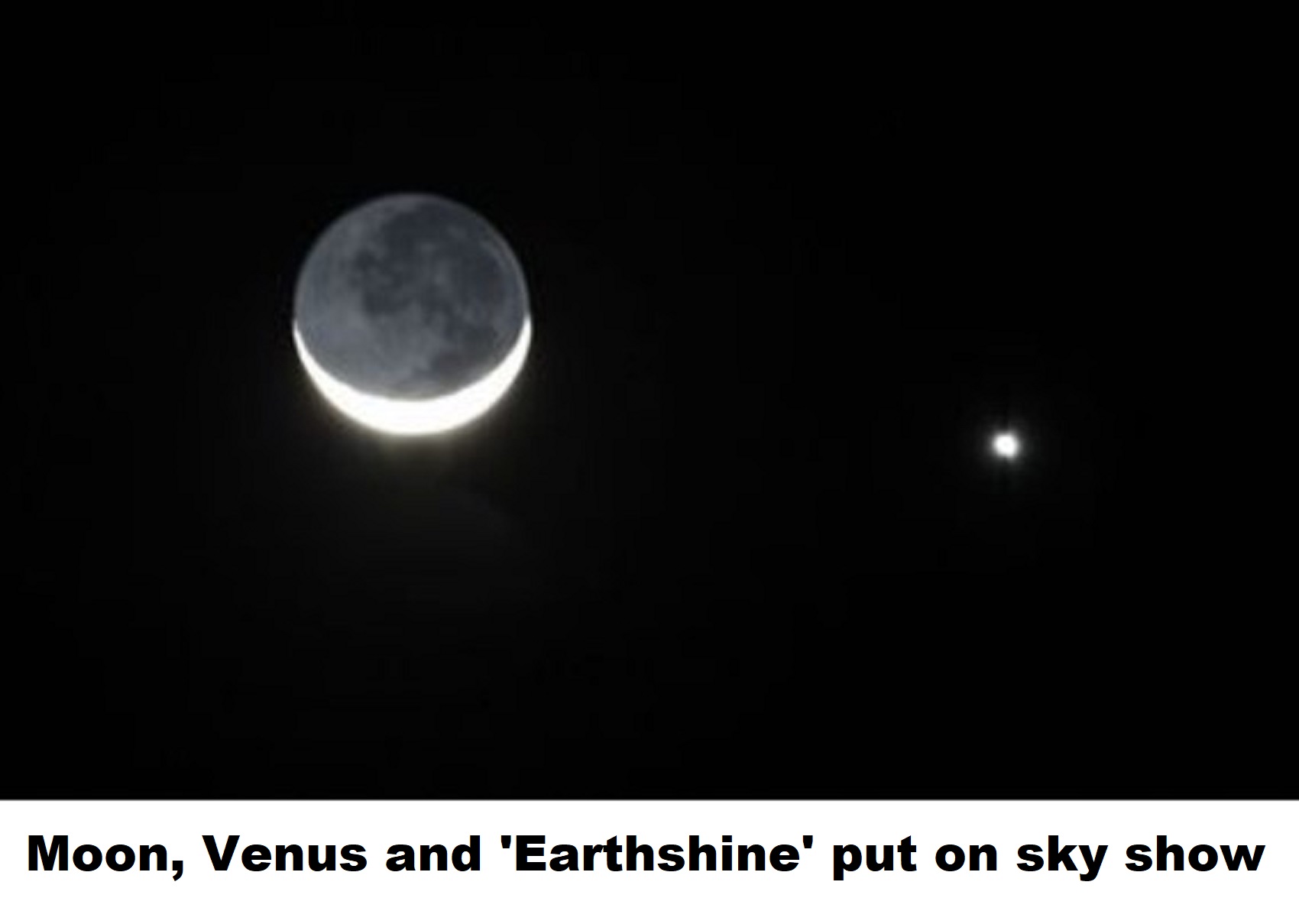
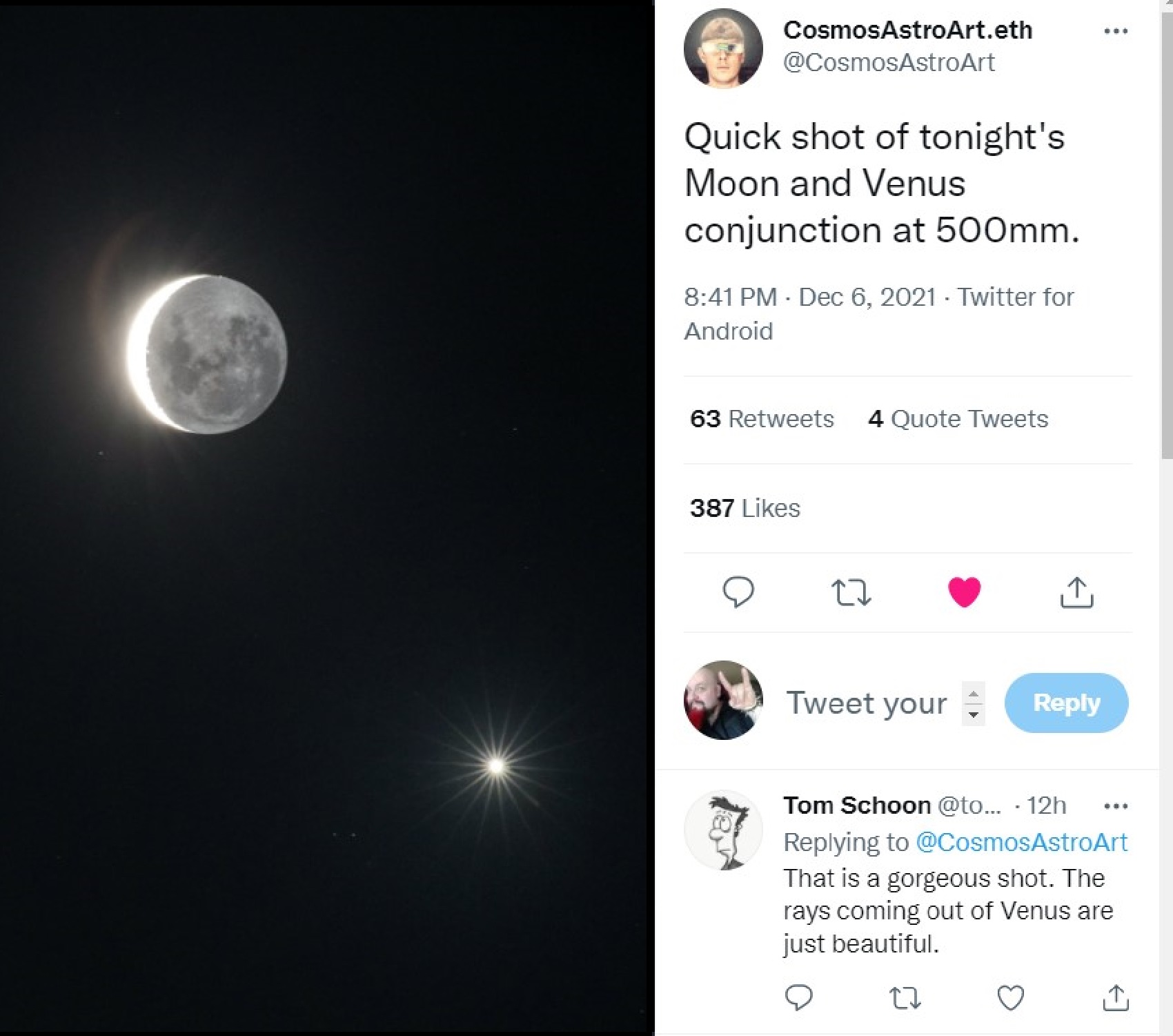
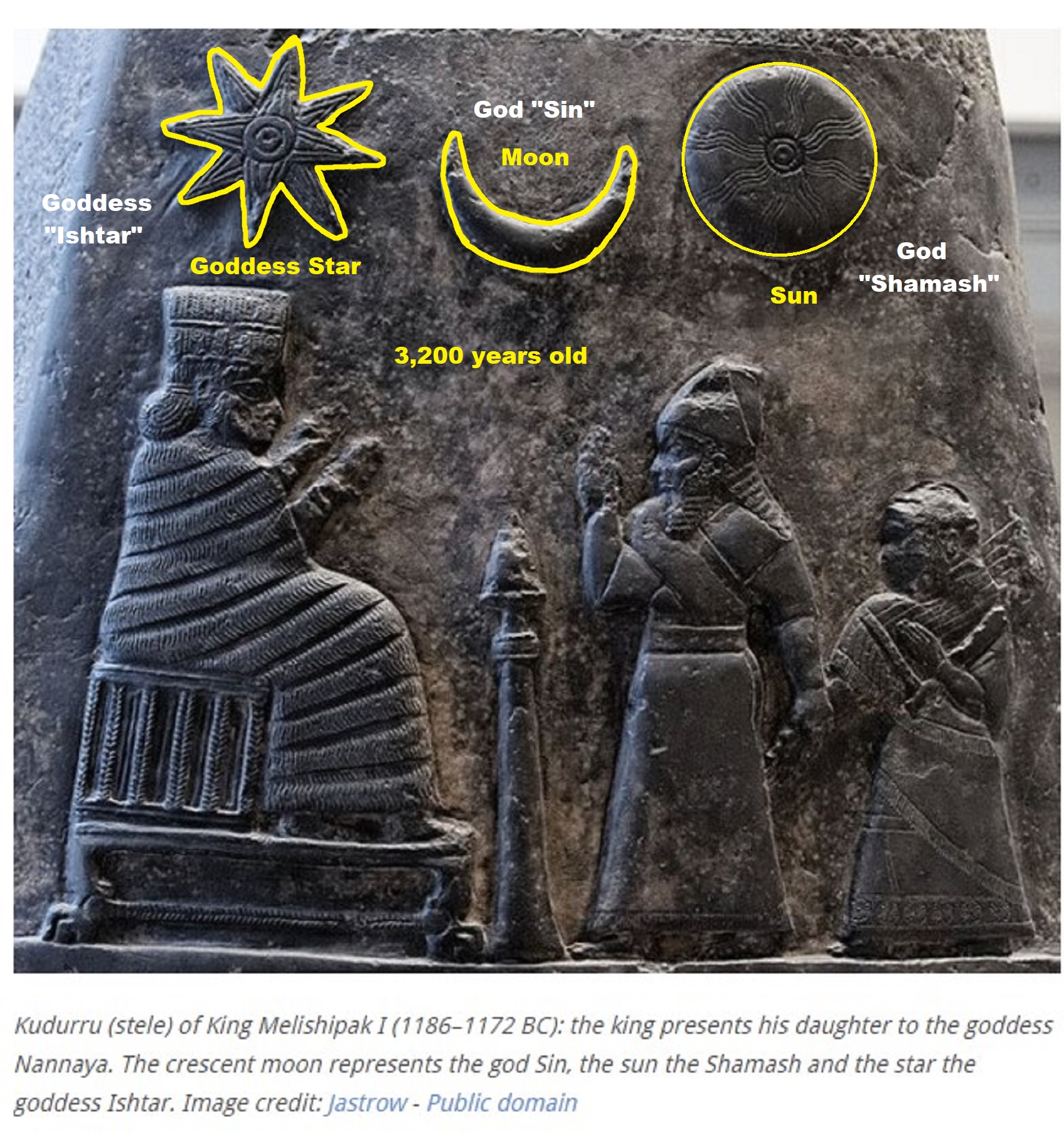
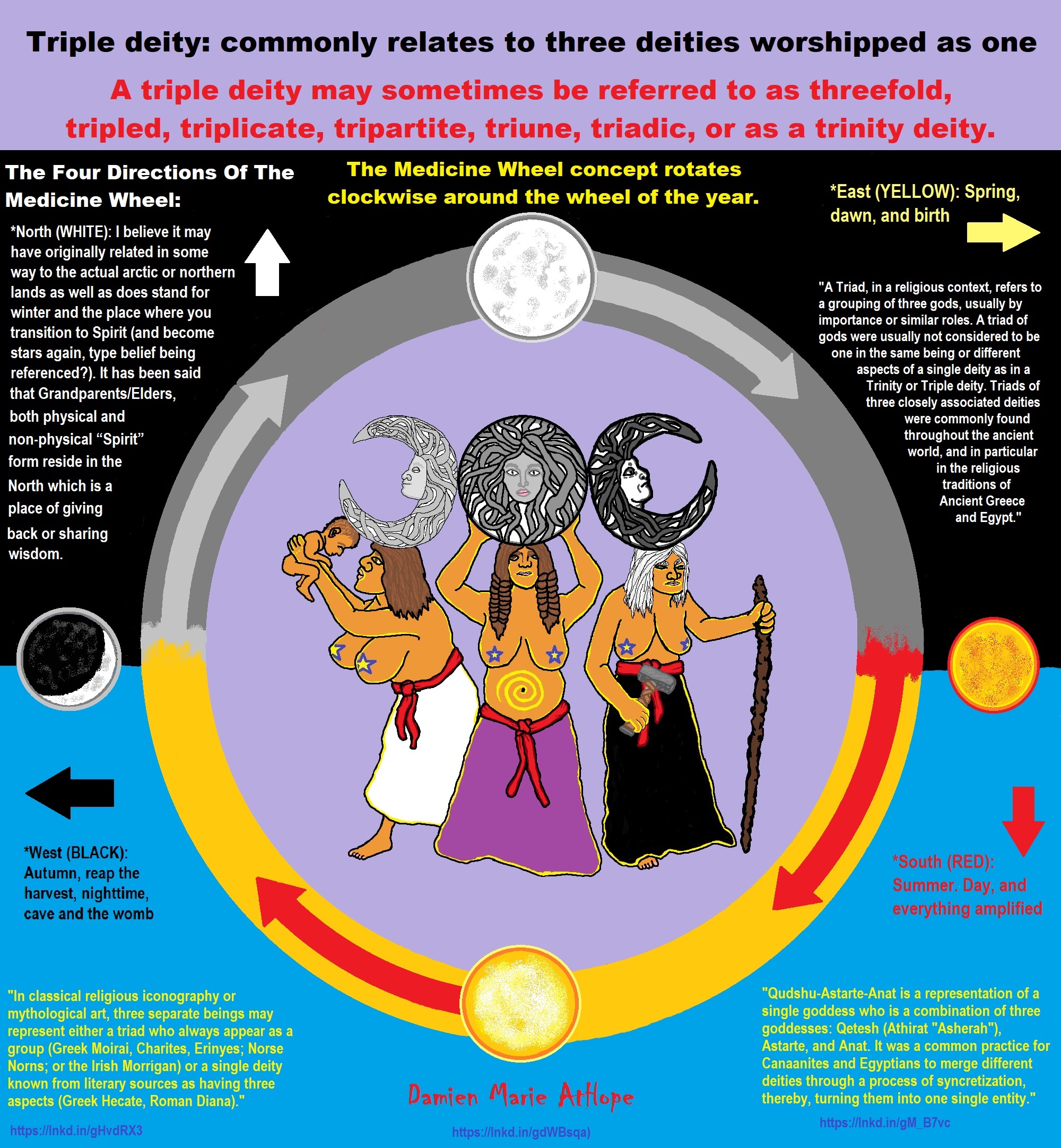
Sun and the Moon in Saami Mythology and Folklore:
“Saami people are the native people of northern Europe. Saami land reaches from the northern parts of Norway, Finland, and Sweden to Kuola peninsula in Russia. In these modern times, you can find Saami´s in all kinds of professions but back in the day majority of the Saami´s were fishermen, hunters, and above all reindeer herders. The nomadic lifestyle was a natural way of life for many Saami´s. They knew all about the constellations, movements of the sun, moon, stars, and the northern lights. Saami stories and folk tales were told orally from one generation to another. A few hundred years ago in Finland, Sweden, and Norway pagan beliefs of the Saami´s were suppressed and many Saami´s converted to Christianity. Because of this slowly old stories vanished. Now we have only fragments left of the Saami myths and legends.” ref
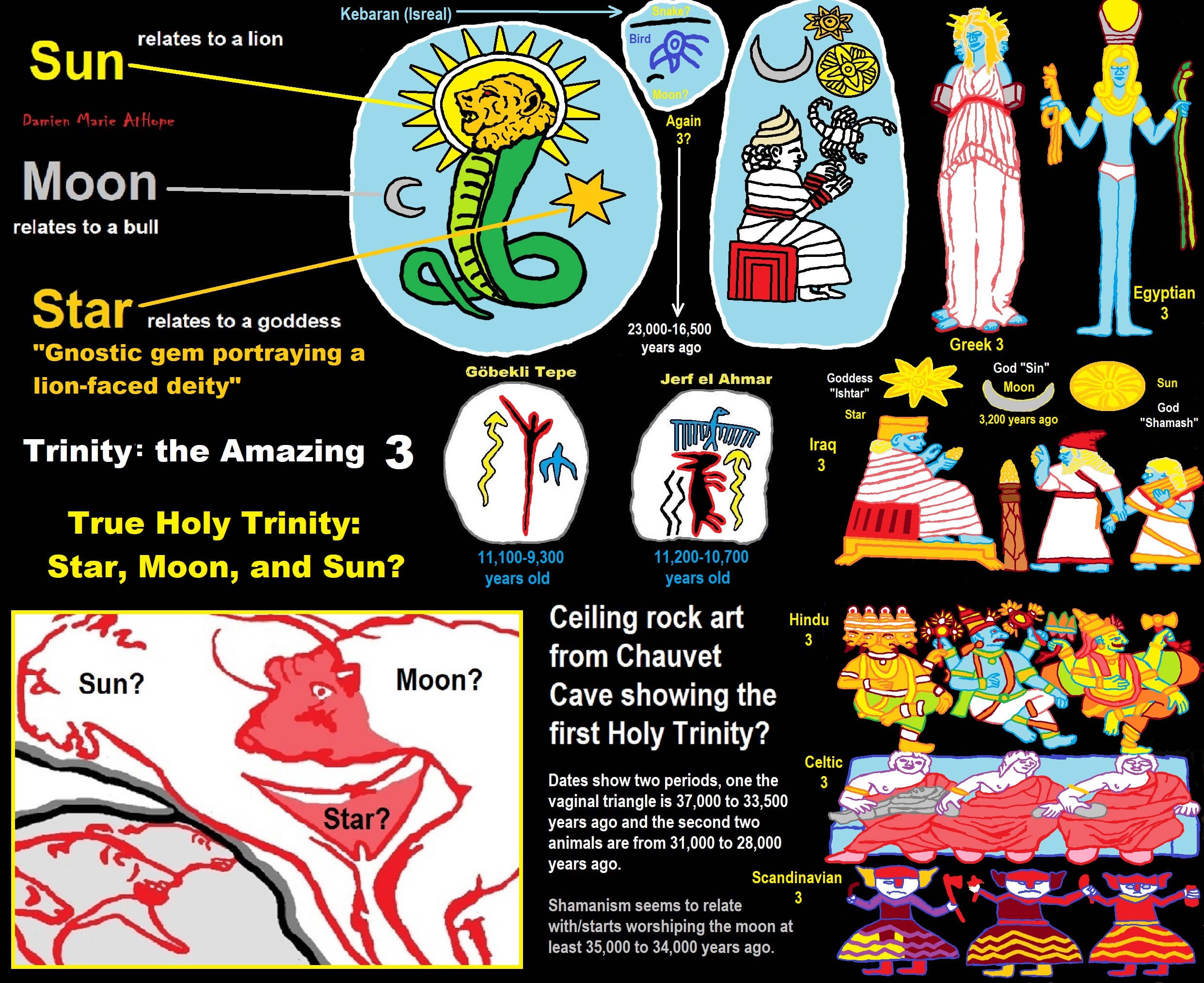
In my prehistory art in this blog, I offer my speculations relating to art with possible religious/supernatural thinking which I think are loose, justified, or reasoned speculations/conjectures.
“My Holy Three thinking is me wondering if they have a 30,000-year belief connection so it may be loose speculations/conjectures.”
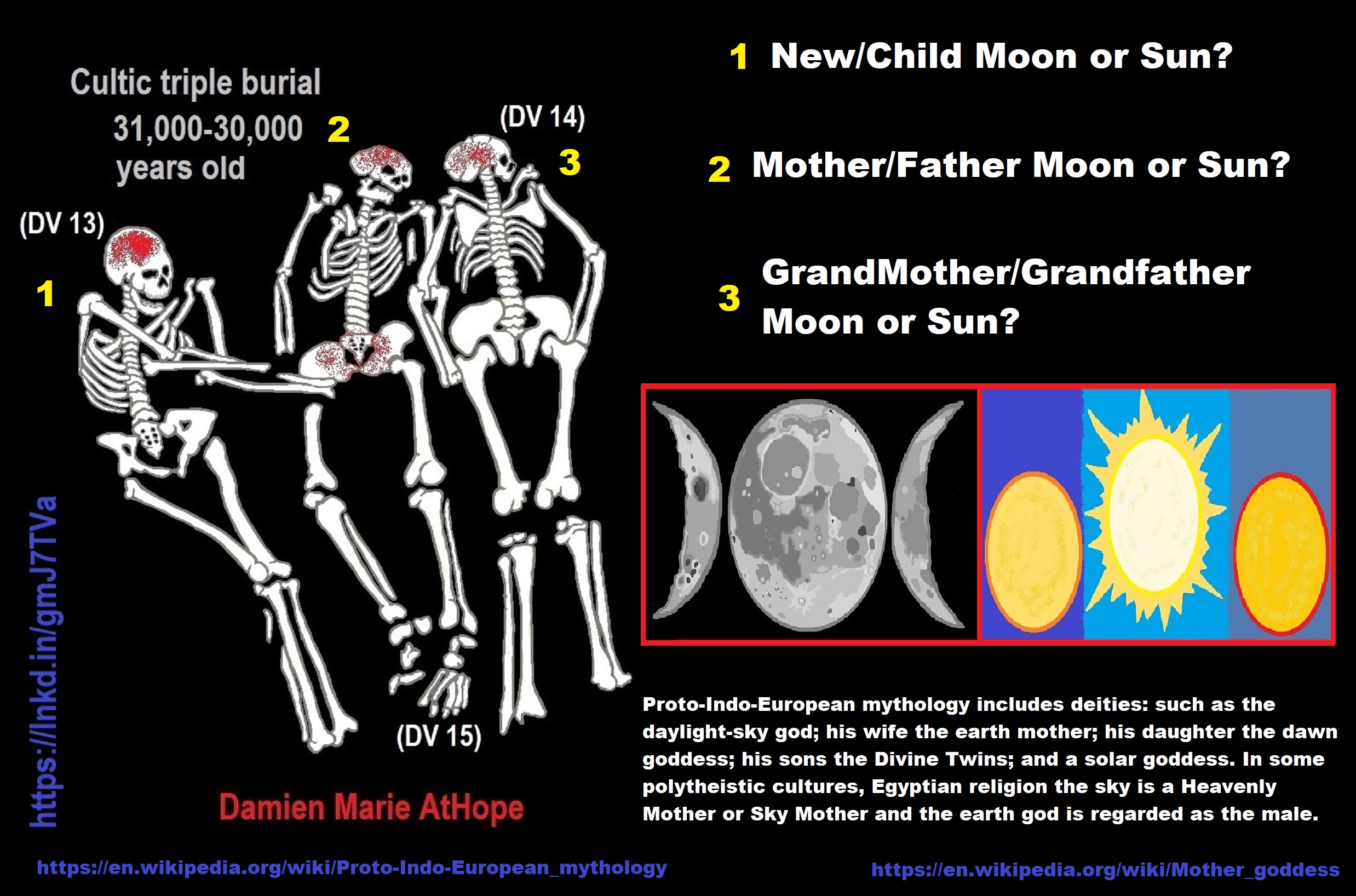
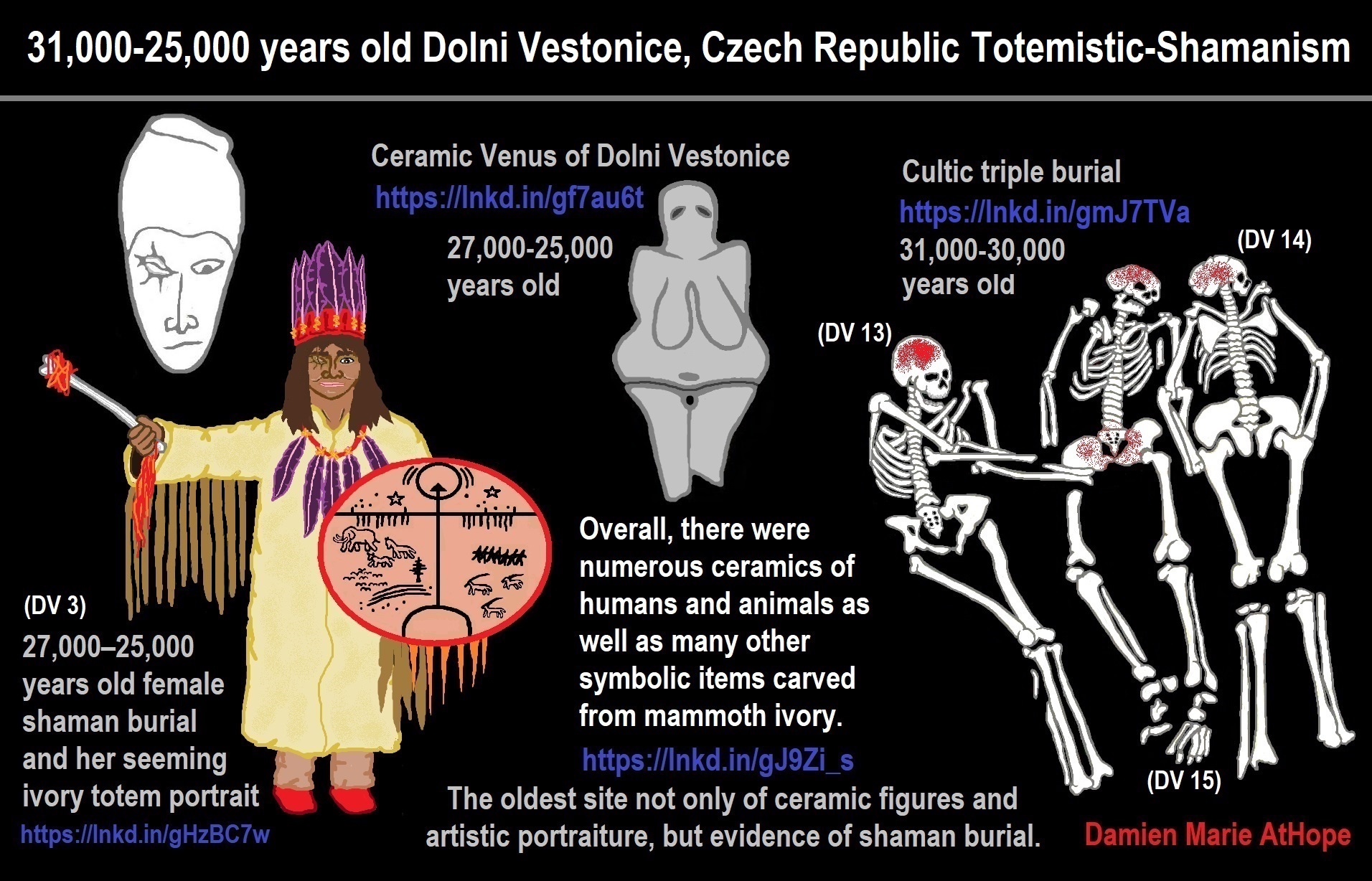
31,000-25,000 Dolni Vestonice, Czech Republic Totemistic-Shamanism
“A remarkable cluster of Pavlovian radiocarbon dates is recorded during the following two millenia, between 27 – 25 ky (Jöris & Weninger 2004). These dates were received from Willendorf II (layers 6-8), Aggsbach, Krems, Grub/Kranawetberg, Dolní Vestonice – Pavlov, Milovice (settlement), Borsice, Jarosov (settlement), Spytihnev, and Predmostí (the main occupation layer). An increase of microliths, including the geometric microliths (lunates, triangles, trapezes), is typical at this stage, especially within the Dolní Vestonice – Pavlov area (fig. 3). A variety of pointed blades and microblades continue to occur, but the typical leaf-points are absent at this stage. A few of the 14 C datings from sites like Dolní Vestonice, Milovice and Jarosov are later than 25 ky; so, for example, the mammoth bone deposits at Milovice and Jarosov are dated later than the related settlements. If these dates are correct, they would suggest a prolongation of occupation at these sites after the Pavlovian.” ref
“The most typical example of another type of Early Gravettian, non-Pavlovian site, is Bodrogkeresztúr-Henye in eastern Hungary (Dobosi, ed. 2000). The site provided two dates, 28.7 ± 3 ky and 26.3 ± 0.4 ky that place it chronologically to the Early Gravettian. Contrary to the Pavlovian sites, however, the fauna is dominated by horse and elk, and the lithic industry, dominated by burins, retouched blades, endscrapers and sidescrapers, lacks the typical microliths. In addition, there are differences of rather functional nature. Nemsová, a workshop site with an Early Gravettian date in western Slovakia, is located near an important raw material source: the radiolarite. Two smaller cave sites, Slaninova Cave and Dzeravá skala Cave, yielded early Gravettian dates in association with fragments of the typical ivory points with circular section. This may be an evidence for periodical visits of Gravettian hunters in the karstic regions.” ref

31,000-25,000 years old Dolni Vestonice, Czech Republic Totemistic-Shamanism
“This Shaman hails from a place now called Dolni Vestonici, earning her the glamorous name “Dolni Vestonici 3” as the third burial found at the site. So I’ll call her Devee, the DV3 burial1. Devee did take a major blow to the face but she recovered, the resulting disfigurement and Devee’s continued survival, despite this injury, is a key piece of evidence she was important to her tribe. Of course, she’d still need help from her friends to recover in the first place.” ref
“Red powdery and crusty concentrations from the fill-up and bottom of a female burial DV3 from the Dolní Věstonice I site, representing Pavlovian culture. The burial floor and fill-up is composed of marly substrate mixed with bone powder, charcoal ash and red, rounded, relatively hard particles, composed of burnt iron bearing aluminosilicates. Red crusts, present on it (maybe also within it), applied probably as suspension, are composed of unburnt iron bearing aluminosilicates. The raw material for powders is assumed to come from the site hearths red ash. Red iron artifacts, macroscopically almost identical, occur on the site also as an assemblage of loose red lumps. They are petrographically inhomogeneous and their sources are localized up to 94 miles away from the site. Raw material similar to the one of some of red lumps may have been used for burial ceremony. The red ferruginous materials may have been exploited in areas of particular importance, away from hunting and flint (and other raw materials) trails.” ref
“The DV3 burial was found in the cultural layer of the first settlement object. The grave pit was dug into the Pleistocene marly silt mixed with limestone debris. The sediment was formed as a result of solifluxion of the nearby Tertiary sediments. Grave pit with the flexed body of a middle aged woman was covered by red coloring agent, greyish marly fill-up and two mammoth scapulae contacting tightly one with the other. They are covered by a compacted layer of calcareous debris with an ash and “dye.” This layer was present only in the burial pit and in the immediate vicinity of it. The upper part of the skeleton, especially the skull was covered with red material. Colouring continued in the vicinity of isolated bones. A woman’s body, probably was smeared with marly soil with immersed red powder. Staining was visible also under the temporal bone. Perhaps, after the decomposition of soft body parts the red particles infiltrated to bone surfaces tinting them. Numerous red ferruginous pieces and lumps were present out of the DV3 grave. Points at the local sources (up to 1 km from the site) of red raw materials, e.g. Mn-Fe concretions from the Ždanice Middle Oligocene flysch, limonite concretions from Eocene sediments near Milovice and goethite from the vicinity of the Pavlovske Hills.” ref
“Nevertheless, geology of the area in some dozen kilometers is much more complex and numerous other rocks may have been sources of red iron oxides, including, among others, terra rosa of unknown (but probably Eocene) age, variegated shales from Oligocene-Miocene and Paleocen-Middle Eocene flysh, red claystones (Ždanice-Hustopeče Formation), Cretaceous spongolite at the Dyje river, Inner Carpathian pyrite-pyrhotine with their red weathering crusts, neohercynian hematite veins and stockwerks (also along the Vah valley), red continental Lower Permian sediments and Visean flysh (culm) facies with variegated shales. In 150 km radius Považsky Inovec and Jeseníky Mts. metamorphosed Devonian sedimentary-volcanogenic rocks of Lahn-Dill type were also available for Pavlovian societies. On the one hand there is interest in the diversity of petrographic origin and processing of red raw ferruginous red lumps found on the site beyond the grave DV3. On the other hand, there is questions about the nature of red microartifacts associated with a sepulchral context: what is their composition and origin? Were they intentionally processed? Is there one or more varieties of sediments in the burial? Do the red powders of burial sediment (or sediments) have any relationship with red lumps from beyond the grave, or they are specific in origin and processing? Could they be a deliberately burnt raw material?” ref
The Upper Paleolithic triple burial of Dolní Vestonice: pathology and funerary behavior.
“The Gravettian triple burial of young individuals at Dolní Vestonice includes a skeleton in the middle (DV 15) is pathological and very problematic to sex though first believed to be a female, currently thought to be a slender male; the other two (DV 13 and DV 14) are somewhat larger males and lie in an unusual position. The pathological condition of the (DV 15) skeleton in the middle include asymmetric shortening of the right femur and of left forearm bones, bowing of the right femur, right humerus, and left radius, elongation of fibulae, dysplasias of the vertebral column, and very marked enamel hypoplasias suggesting chondrodysplasia calcificans punctata (CCP) complicated by trauma and early fractures of the upper limbs leaving permanent deformities on affected bones.” ref
“Among the different forms of CCP, the X-linked dominant form is that resulting in asymmetric shortening and is lethal during early infancy in males. Thus, survival of DV 15 until young adult age would require the specimen to be a female. Clinical findings often associated with the disease (erythemas, ichthyosis, alopecia, cataracts, and joint contractures, among others) would emphasize the singular aspect of this individual, pointing to a condition that should be carefully taken into account when speculating on the significance of that peculiar burial.” ref
“Excavations at Dolní Věstonice II unearthed a structured settlement with a single male burial DV 16 and a number of stone and bone tools, decorative objects, as well as fragmented remains of associated human individuals making it one of the most important sites of the Central European Gravettian.” ref, ref
“Dolní Věstonice I site, belongs to an assemblage of the Pavlovian sites (Early Gravettian) of the Southern Moravia (Czech Republic), together with the Dolní Věstonice II and III, Pavlov I-VI, Milovice I and IV and the Middle Moravia Basin sites. Dolní Věstonice I as well as other Southern Moravian sites were located at the foothill of Pavlovske Vrchy, close (0.3 miles) from the Dyje river.” ref
“The Dolní Věstonice – Pavlov cultural areas are similar in many ways to the Kostenki – Borshevo region beside the Don River in Russia. It was not just one site, it was many, spread over a fairly wide area, and was an open air site. Most open air sites do not give the wealth of data that these sites, both here at Dolní Věstonice and at Kostenki, have yielded, and both are from similar times. Both have Venus figures, both depended heavily on mammoths for their culture, and both used mammoth bones in the creation of shelters.” ref
“In the Vestonice 13 sample, the Y chromosomal haplogroup CT (not IJK-L16) (CTS109+, CTS5318+, CTS6327+, CTS8243+, CTS9556+, Z17718+, Y1571+, M5831+) was determined, for the Vestonice 15 sample, the Y chromosome haplogroup BT (PF1178+), in the Vestonice 43 sample, the Y chromosome haplogroup F (not I) (P145+, P158+). In the Vestonice 16 sample, the Y chromosomal haplogroup C1a2 (V20+, V86+).” ref
“None of the Sungir individuals were found to be closely related even though the SII to SIV individuals buried together share both mitochondrial and Y chromosome lineages. We then inferred genomic segments that were identical by descent and homozygous by descent from three higher-coverage Sungir genomes (Sungir 2 to Sungir 4) and a panel of ancient and contemporary humans. The distributions of homozygous by descent tracts were different between early anatomically modern humans and archaic humans, indicating small effective population sizes and/or recent inbreeding in archaic individuals, particularly the Altai Neandertal.” ref
“Only some of the Sungir individuals were interred with a rich material culture, including spears made of mammoth ivory, ivory beads and perforated fox teeth and red ochre, The remains material culture and lithic evidence, and the presence of ochre, a links them to a wider complex of human burials from Russia to Portugal. There is seeming late or final stage of ‘Streletskian’ lithic culture evidence, which is speculated to be an outgrowth of the Mousterian, similar to the Châtelperronian, an industry with elements of both the Mousterian and the Aurignacian, and is contemporaneous with the Aurignacian.” ref, ref, ref, ref
“The ‘Streletskian’ lithic culture found at Sungir is associated with and sometimes referred to as the Kostenki-Streletsk culture.” ref
“The European Mousterian culture is the product of Neanderthals. It existed roughly from around 160,000-40,000 years ago, around when Neanderthals started the Châtelperronian culture (around 44,500 – 36,000 years ago) and besides a possible relation to the Modern human Aurignacian culture it is speculated that the due to things like the use of ivory at Châtelperronian sites which appear to be more frequent than that of the later Aurignacian may relate to the origins of the very similar Gravettian culture as well as other features found in the Szeletian culture. As well as associated primarily with the earliest anatomically modern humans in West Asia and North Africa likely learned from Neanderthals.” ref, ref, ref, ref
“Certain forms of bifacial points, numerous series of side-scrapers, and predominance of flakes in the manufacture of tools are the basis to include Sungir to the group of Streletskian sites. The characteristics of stone inventory, on the basis of which Sungir can be attributed to the Streletskian, at the same time, allow us to compare this site with final Szeletian of Central Europe. Now this conclusion is not refuted by the presence of Aurignacian types, because the same pattern is seen in some Szeletian sites of Central Europe. Moreover, a few sites were excavated in Eastern Europe in the last decades, toolkit of which is similar to streletskian and at the same time contains Aurignacian types. It is primarily the site of Garchi I, located in the North-East of European part of Russia, and the site of Vys, located in the Central part of Ukraine.” ref
“The Szeletian culture seemingly seen at generally dates to around 38 000 – 28 000 years ago and was widespread from largely Hungary, Czechoslovakia, and southwestern Poland. However, its influence can also be seen at a number of places in Romania and Bulgaria. The Szeletian culture developed mainly from the local Mousterian culture and for a time was contemporaneous with the Aurignacian culture. It was succeeded by the Gravettian cultures.” ref
“Sungir is thought to be a late stage of the Streletskian and characterized by a greater proportion of blades and fewer ‘leaf-points’, with more burins than at other sites. Russian colleagues place the site in a transitional phase related to the previous early Upper Palaeolithic (EUP).” ref
“The ‘Streletskian’ lithic culture found at Sungir is associated with and sometimes referred to as the Kostenki-Streletsk culture.” ref
“Streletskian points’ are documented in several assemblages from the Kostёnki complex of Upper Palaeolithic sites in south-western Russia. Some of these assemblages have been argued to evidence very early modern human occupation of Eastern Europe. However, Streletskian points are also recorded from younger contexts, notably at Kostёnki 11, where examples are attributed both to Layer V and the stratigraphically higher Layer III. The apparent relatively young age of Layer III has led some to view it as the latest manifestation of the Streletskian, although its assemblage has also been compared to the non-Streletskian Layer I of Kostёnki 8, with the two described together as the Anosovka-Tel’manskaya Culture. There is a 28,500–27,000 cal years ago date for a wolf burial associated with Layer III of Kostёnki 11 confirm the layer as younger than other Streletskian assemblages at Kostёnki. New radiocarbon dates for Kostёnki 8 Layer I show that the two layers are broadly contemporary, and that both are close in age to assemblages of Kostёnki’s (Late Gravettian) Kostёnki-Avdeevo Culture.” ref
“The origin of Gravettian is seen as a more complex process than was thought before, involving an impact of industries with backed blades and bladelets from the eastern Mediterranean (Ahmarian, Lagaman, Dabba, beginning before 40 ky BP). After its establishment in Europe, the Danubian Gravettian is ordered into earlier Pavlovian stage (30-25 ky BP), concentrated in the Austrian-Moravian-South Polish corridor, and later Willendorf-Kostenkian stage (25-20 ky BP), widely dispersed over central and eastern Europe. The Epigravettian, termed Kasovian (after 20 ky BP), should be clearly separated from the earlier Gravettian stock.” ref
“The Gravettian, as the most complex Upper Paleolithic cultural entity in the Danubian Europe. Such as, the Gravettian sites in Lower Austria, on the Danube or Moravia, at Dolní Vestonice and Predmostí and Middle Moravia Basin. Others such as Pavlov VI, Bohemia, Silesia, Slovakia, and Hungary. Specifically, sites of the Danubian Gravettian provided a relatively large series of modern human fossil remains, such as, the spectacular finds of newborn babies, ritually buried at Krems-Wachtberg. As well as the sites of Dolní Vestonice – Pavlov and Predmosti.” ref
“A wolf burial being associated with Layer III of Kostёnki 11 demonstrate its association with the chronological group IV, hence confirming its recent age relative to Kostёnki-Borshchëvo’s Spitsynian, Aurignacian, Early Gravettian, and Gorodtsovian sites and layers. The dates are instead similar to new dates for Kostёnki 8 Layer I, with which the Kostёnki 11 Layer III lithic assemblage, which have previously been grouped as the ‘Anosovka-Tel’manskaya Culture’. These two assemblages are also chronologically close to Late Gravettian Kostёnki-Avdeevo Culture sites such as Kostёnki 1 Layer I and Kostёnki 18. A new study of the Kostёnki 11 Layer III lithic assemblage would enable meaningful comparison with Kostёnki 8 Layer I, and assessment of blade production at all of these sites should help to elucidate the relationships between them. A single Streletskian point from Layer III at Kostёnki 11 has previously been used to propose a cultural link with Streletskian sites and assemblages at Kostёnki and beyond.” ref
“However, there is reason to question the association of this Streletskian point with other lithic material from Layer III. Stratigraphic uncertainties relating to Layer III remain unresolved, including those in the test-pit that yielded the Streletskian point. There is also currently no technological context for the Streletskian point in the remainder of the Kostёnki 11 Layer III lithic assemblage. The blank from which it was made is unusual for the layer, the secondary thinning technique used for its manufacture is not evident on any of the layer’s other artifacts, and no characteristic thinning flakes have been found, despite their presence at other Streletskian sites at Kostënki.” ref
Kostenki – Offers Evidence for Early Human Migrations into Europe
“The occupations at Kostenki include several Late Early Upper Paleolithic levels, dated between 42,000 to 30,000 calibrated years ago (cal BP). Kostenki is located in the Pokrovsky Valley of Russia, on the west bank of the Don River, about 400 kilometers (250 miles) south of Moscow and 40 km (25 mi) south of the city of Voronezh, Russia.” ref
- Cover layer: several stacked occupations dated to the Eastern Gravettian (such as Kostenki 1 at 29,000 years ago and Epi-Gravettian from Kostenki 11 at 14,000-19,000 years ago)
- Upper layer: several stacked occupations, early and mid-Upper Paleolithic, including Initial Upper Paleolithic, Aurignacian, Gravettian, and local Gorodsovian
- Whitish layer: volcanic ash dated 39,300 years ago.
- Lower layer: several stacked horizons, early and mid-Upper Paleolithic, including Initial Upper Paleolithic, Aurignacian, Gravettian, and local Gorodsovian. ref
“Moreover, Excavators at Kostenki (Anikovich et al.) reported that they had identified occupation levels within and below the ash level. They found the remnants of the Early Upper Paleolithic culture called the “Aurignacian Dufour,” numerous small bladelets quite similar to lithic tools found in similarly dated sites in western Europe. Prior to Kostenki, the Aurignacian sequence was considered the oldest component associated with modern humans at archaeological sites in Europe, underlain by Mousterian-like deposits representing Neanderthals. At Kostenki, a sophisticated tool kit of prismatic blades, burins, bone antler, and ivory artifacts, and small perforated shell ornaments lies below the CI Tephra and Aurignacian Dufour assemblage: these were identified as an earlier presence of modern humans in Eurasia than previously recognized.” ref
“There was found a genetic relationships between Kostenki-14 (Markina Gora) who died more than 36,000 years ago and Neanderthals–more evidence that early modern humans and Neanderthals interbred–as well as genetic connections to the Mal’ta individual from Siberia and European Neolithic farmers. Further, they found a fairly distant relationship to Australo-Melanesian or eastern Asian populations.” ref
“Moreover, DNA recovered from a 36,000 year old fossil skeleton found in Russia shows early divergence of Eurasians once they had left Africa, and the deep shared ancestry of Europeans. The new study, carried out by an international team of researchers, also reveals when Neanderthals and early modern humans out of Africa interbred – around 54,000 years ago, before the modern human population began to differentiate. The Kostenki 14 genome shows that once people had dispersed beyond the African homeland into Eurasia, they separated early – before 36,000 years ago – into at least three populations whose descendants would develop the unique features that reflect the core of the diversity of non-African peoples. What we can see from Kostenki and other ancient genomes is that for 30,000 years there was a single meta-population in Europe. These Palaeolithic hunter-gatherer groups split up, mixed, dispersed and changed, and through ancient genomes we can trace the genetic thread of their shared ancestry. For example, the genome reveals that the people from Kostenki contributed genes to the ancestors of the boy from Mal’ta, who lived in Siberia 26,000 years ago, and whose descendants spread as far as Europe and the Americas.” ref
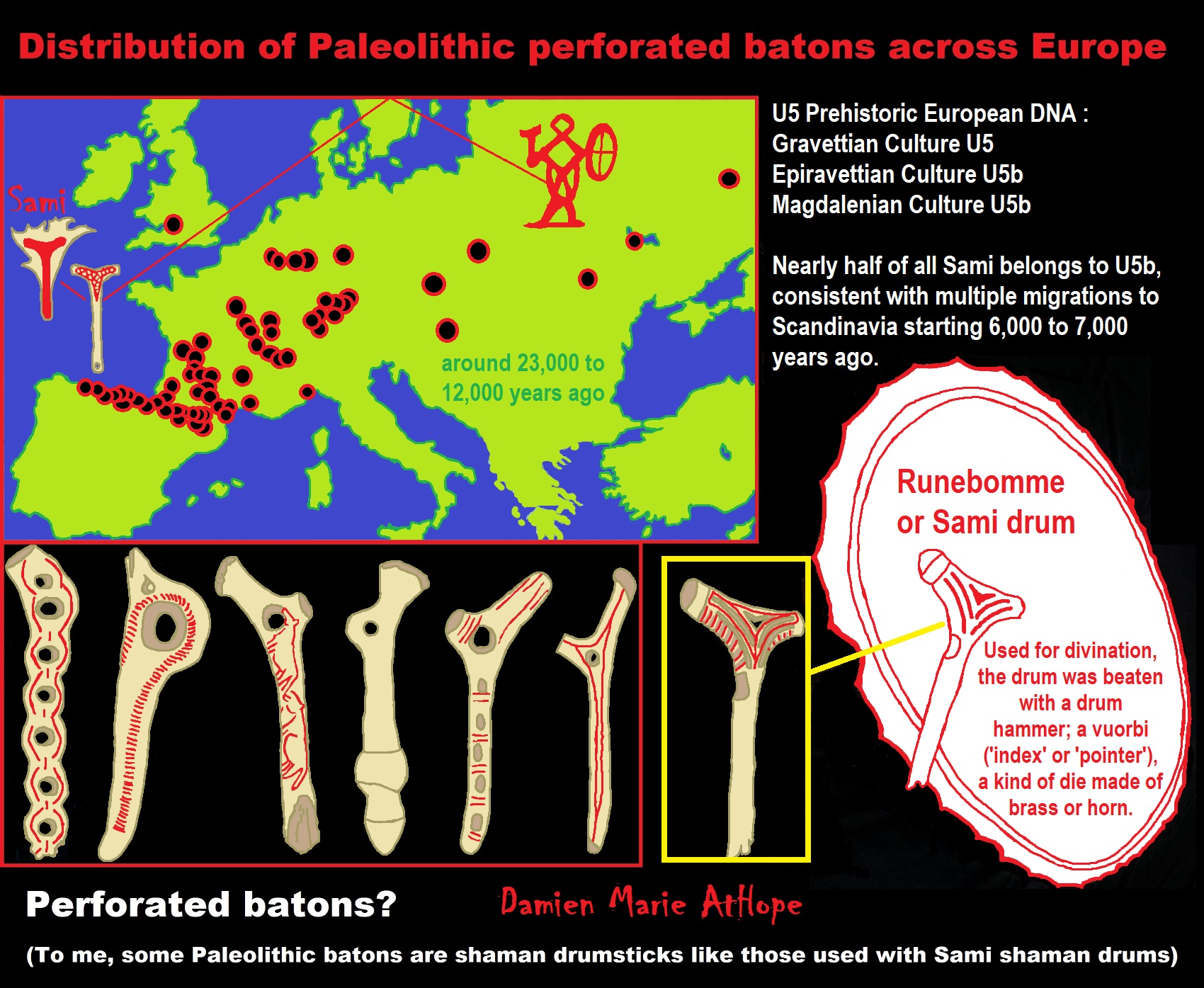
ref, ref, ref, ref, ref, ref, ref, ref, ref, ref, ref, ref
“Aurignacian (43,000 to 26,000 years ago), Gravettian (33,000 to 21,000 years ago), Magdalenian (17,000 to 12,000 years ago), and Sami (Haplogroup N Y-DNA) at least by 3,500 years ago until the fifteenth century) were all nomadic peoples of Ancient Europe. N1c correlates closely with the distribution of the Finno-Ugrian languages. The Sami languages are thought to have split from their common ancestor about 3300 years ago.” ref, ref
“Mitochondrial DNA studies of Sami people, haplogroup U5 are consistent with multiple migrations to Scandinavia from Volga-Ural region, starting 6,000 to 7,000 years before present.” ref
“Nearly half of all Sami and one-fifth of Finnish maternal lineages belong to U5. U5 arrived in Europe with the Gravettian and appears to have been a major maternal lineage among the Paleolithic European hunter-gatherers and even the dominant lineage during the European Mesolithic at more than 80%. Among 16 Gravettian samples, six belonged to U5.” ref
“U5b1b1 arose approximately 10,000 years ago, over two millennia after the end of the Last Glaciation, when the Neolithic Revolution was already underway in the Near East. Despite this relatively young age, U5b1b1 is found scattered across all of Europe and well beyond its boundaries. The Saami, who live in the far European North and have 48% of U5 and 42% of V lineages, belong exclusively to the U5b1b1 subclade. Amazingly, the Berbers of Northwest Africa also possess that U5b1b1 subclade and haplogroup V. How could two peoples separated by some 6,000 km (3,700 mi) share such close maternal ancestry? The Berbers also have other typically Western European lineages such as H1 and H3, as well as African haplogroups like M1, L1, L2, and L3. The Saami and the Berbers presumably descend from nomadic hunter-gatherers from the Franco-Cantabrian refugium who recolonized Europe and North Africa after the LGM.” ref
“The journey of U5b1b1 didn’t stop there. The Fulbe of Senegal were also found to share U5b1b1b with the Berbers, surely through intermarriages. More impressively, the Yakuts of eastern Siberia, who have a bit under 10% of European mtDNA (including haplogroups H, HV1, J, K, T, U4, U5, and W), also share the exact same deep subclade (U5b1b1a) as the Saami and the Berbers.” ref
Genetic Studies on Sami
“Genetic studies on Sami are the genetic research that has been carried out on the Sami people. The Sami languages belong to the Uralic languages family of Eurasia. Siberian origins are still visible in the Sámi, Finns, and other populations of the Finno-Ugric language family. An abundance of genes has journeyed all the way from Siberia to Finland, a recent study indicates. As late as the Iron Age, people with a genome similar to that of the Sámi people lived much further south in Finland compared to today. The first study on the DNA of the ancient inhabitants of Finland has been published, with results indicating that a copious number of Siberian genetic variants are present in modern Sami populations.” ref
“Genetic material from remains associated with Western Siberian hunter-gatherers has been found in the inhabitants of the Kola Peninsula from as far back as approximately 4,000 years ago, later spreading also to Finland. The study also corroborates the assumption that people genetically similar to the Sámi lived much further south than currently. The Western Siberian hunter-gatherers (WSHG) themselves harbored about 30% EHG (Eastern European Hunter-Gatherers) ancestry, 50% ANE (Ancient North Eurasian) ancestry, and 20% East Asian ancestry, therefore mostly European-related ancestry, and also resembled the earlier Botai samples of northern Central Asia. The genetic samples compared in the study were collected from human bones found in a 3,500-year-old burial place in the Kola Peninsula and the 1,500-year-old lake burial site at Levänluhta in South Ostrobothnia, Finland. All of the samples contained identical Siberian genes.” ref
Sami Y-DNA
“Three Y chromosome haplogroups dominate the distribution among the Sami: N1c (formerly N3a), I1 – today is more commonly known as I-M253 – and R1a, at least in the study carried out by K. Tambets et al. in 2004. The most common haplogroup among the Sami is N1c, with I1 as a close second according to that study. Haplogroup R1a in Sami is mostly seen in the Swedish Sami and Kola Sami populations, with a low level among the Finnish Sami according to Tambets and colleagues, a finding that suggests that N1c and R1a probably reached Fennoscandia from eastern Europe, where these haplogroups can be found in high frequencies. In Finland, there is also a general difference within the Finnish population between eastern and western Finland, where the eastern show a dominance of N-haplogroup and the west a dominance of I-haplogroup, where the latter is explained by a migration from southern parts of today’s Norway and Sweden over to Finland as we know it today.” ref
“But the spread of R1a-haplogroup amongst Sami in Sweden shows a big span from 10.1% to 36.0%, with an average of 20%, to be compared with Sami in Finland with a span from 9% to 9.9% Because Sami groups in Sweden show differences between haplogroups – such as U5b and V even thought that are mtDNA-groups – in the south of Sweden and in the north of the country (see below), the spread of Y-haplogroups such as R1a amongst groups of Sami in Sweden might be significant as well. No such study has yet been done though.” ref
“However the two haplogroups R1a and N1c have a distinctly distribution when it comes to linguistics. R1a is common among Eastern Europeans speaking Indo-European languages, while N1c correlates closely with the distribution of the Finno-Ugrian languages. For example, N1c is common among the Finns, while haplogroup R1a is common among all the neighbours of the Sami.” ref
“Haplogroup I1 is the most common haplogroup in Sweden, and the Jokkmokk Sami in Sweden have a similar structure to Swedes and Finns for haplogroup I1 and N1c. Haplogroup I-M253 in Sami is explained by immigration (of men) during the 14th century. That is quite late in Sami history bearing in mind that an distinctive Sami culture can be traced and first observed back to 1000 BCE. The Sami languages are thought to have split from their common ancestor about 3300 years ago.” ref
Sami mtDNA
“Classification of the Sami mtDNA lineages revealed that the majority are clustered in a subset of the European mtDNA pool. The two haplogroups V and U5b dominate, between them accounting for about 89% of the total. This gives the Sami regions the highest level of Haplogroups V and U5b thus far found. Both haplogroups V and U5b are spread at moderate frequencies across Europe, from Iberia to the Ural Mountains. Haplogroups H, D5, and Z represent most of the remaining averaged total. Overall 98% of the Sami mtDNA pool is encompassed within haplogroups V, U5b, H, Z, and D5. Local frequencies among the Sami vary.” ref
“The divergence time for the Sami haplogroup V sequences was estimated by Max Ingman and Ulf Gyllensten at 7600 YBP (years before present), and for U5b1b1 as 5500 YBP amongst Sami and 6600 YBP amongst Sami and Finns. This suggests to them an arrival in the region soon after the retreat of the glacial ice. Other research on Sami shows that most of them do not belong to the mtDNA Haplogroup I (not to be confused for the aforementioned paternal Haplogroup I-M170) that is shared by many Finnic peoples.” ref
Sami U5b
“The great majority of Sami belong to U5b Haplogroup U (mtDNA) even though a small proportion falls into U4. The percentage of total Sami mtDNA samples tested by K. Tambets and her colleagues (published in 2004) which were U5b ranged from 56.8% in Norwegian Sami to 26.5% in Swedish Sami. In research made by M. Ingman and U. Gyllensten in 2006 is a slightly different setting shown: Norwegian Sami belongs to U5b as well as U5b1b1 to 56.8%, Finnish Sami with 40.6%, Northern Sami in Sweden to 35.5% and Southern Sami in Sweden within reindeer herding to 23.9% while Southern Sami in Sweden outside of reindeer herding/other occupation belong to U5b to 16.3% and to U5b1b1 to 12%.” ref
“Sami U5b falls into subclade U5b1b1. The Sami U5b1b1 sub-clade is present in many different populations, e.g. 3% or higher frequencies in Karelia, Finland, and Northern-Russia. The Sami U5b1 motif is additionally found in very low frequencies for instance in the Caucasus region, however this is explained as recent migration from Europe. However, 38% of the Sami U5b1b1 mtDNAs have haplotype so far exclusive to the Sami, containing a transition at np 16148. Alessandro Achilli and colleagues noted that the Sami and the Berbers share U5b1b, which they estimated at 9,000 years old, and argued that this provides evidence for a radiation of the haplogroup from the Franco-Cantabrian refuge area of southwestern Europe.” ref
“M. Engman’s and U. Gyllensten’s studie on mtDNA amongst Sami in Scandinavia also reveals that haplogroup H is 15.2% within the Sami traditional group in the south of Sweden, and 34.8% amongst Southern Sami in Sweden, and as high as 44.6% amongst Southern non-traditional Sami in Sweden, but just 2.6% amongst Northern Sami in Sweden, and 2.9 within the Sami group in Finland and amongst Sami in Norway to 4.7%. That result points in the direction that South Sami in Sweden have been more exposed to and/or intermarried the continental European haplogroup H earlier, and much more frequent, than Sami in the north of Sweden, in Finland and in Norway, which can be explained by Scandinavian/Swedish settlers that migrated into Southern Sami areas in Sweden from areas like Mälardalen.” ref
Sami V
“The divergence time for the Sami haplogroup V sequences is estimated by M. Ingman and U. Gyllensten at 7,600 years ago. But there is a difference within the Sami group in Sweden according to their study. North Sami (Sami in the North of Swedish Lapland) belong to haplogroup V with 58.6% and South Sami (Sami in the South of Swedish Lapland) within reindeer herding to 37.0% and South Sami outside reindeer herding/other occupation to 8.7%. That can be compared with Sami in Norway that has a 33.1% belonging to haplogroup V and Sami in Finland to 37.7%. Sami in Finland and South Sami within reeinder herding in Sweden have the same percentage belonging to haplogroup V.” ref
“But according to K. Tambets’ et al. study is haplogroup V the most frequent haplogroup in the Swedish Sami and is present at significantly lower frequencies in Norwegian and Finnish subpopulations. Note though, that in the study made by K. Tambet’s et al. has no differentiation between Sami in the north and the south of Sweden been made, which otherwise probably would change the outcome of their study. Torroni and colleagues have suggested that the spread of haplogroup V in Scandinavia and in eastern Europe is due to its late Pleistocene/early Holocene expansion from a Franco-Cantabrian glacial refugium.” ref
“However subsequent studies found that haplogroup V is also significantly present in eastern Europeans. Furthermore, haplogroup V lineages with HVS-I transitions 16153 and 16298 that are frequent in the Sami population are much more widespread in eastern than in western Europe. So haplogroup V might have reached Fennoscandia via central/eastern Europe. Such a scenario is indirectly supported by the absence, among the Sami, of the pre-V mtDNAs that are characteristic of southwestern Europeans and northwestern Africans.” ref
Sami Z
“Haplogroup Z is found at low frequency in the Sami and Northern Asian populations but is virtually absent in Europe. Several conserved substitutions group the Sami Z lineages with those from Finland and the Volga-Ural region of Russia. The estimated dating of the lineage at 2700 years suggests a small, relatively recent contribution of people from the Volga-Ural region to the Sami population.” ref
“Haplogroup Z is most frequent in Northeastern Asia. It is also present in Siberian populations as well as in the region of Volga-Ural, as just mentioned. Subhaplogroup Z1 is present in lineages in Western Asia and Northern Europe as well as in the Koryak and Itel’men populations. Interestingly enough is haplogroup Z most frequent amongst maritim Koryaks with just a bit over 10%, but is not at all present in reindeer-herding Koryaks. The Itel’men and Koryak populations live on the Kamchatka peninsula, the former in the south and the latter in the very north.” ref
“In Sámi shamanism, the noaidi used the drum to get into a trance, or to obtain information from the future, or other realms. The drum was held in one hand, and beaten with the other. While the noaidi was in trance, his “free spirit” was said to leave his body to visit the spirit-world. When used for divination, the drum was beaten with a drum hammer; a vuorbi (‘index’ or ‘pointer’), a kind of die made of brass or horn, would move around on the drumhead when the drum was struck. Future events would be predicted according to the symbols upon which the vuorbi stopped on the membrane.
The patterns on the drum membrane reflect the worldview of the owner and his family, both in religious and worldly matters, such as reindeer herding, hunting, householding, and relations with their neighbors and the non-Sámi community.” ref
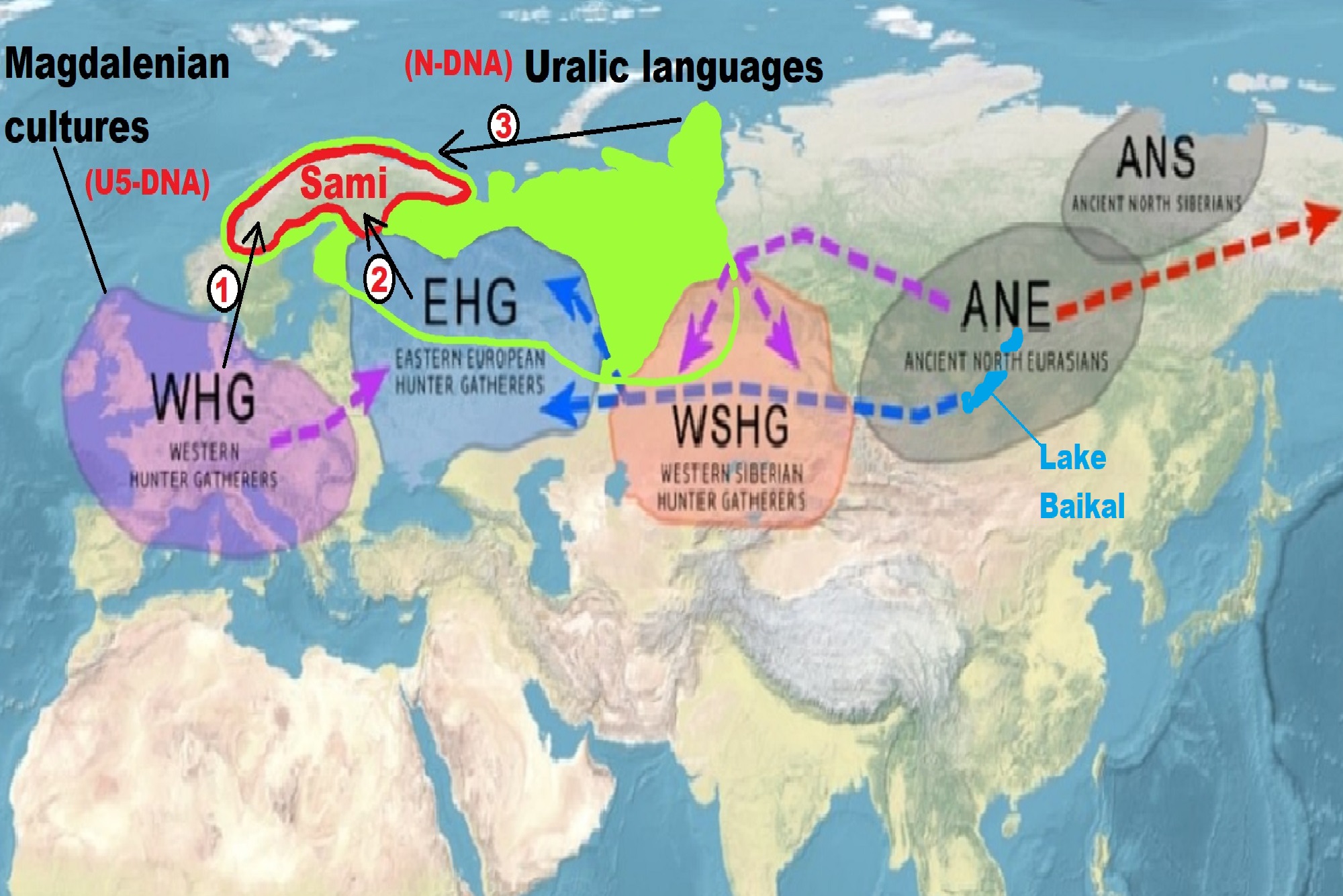
I tried to put all the DNA migrations, that together help explain Sami DNA, and thus some of their cultural influences.
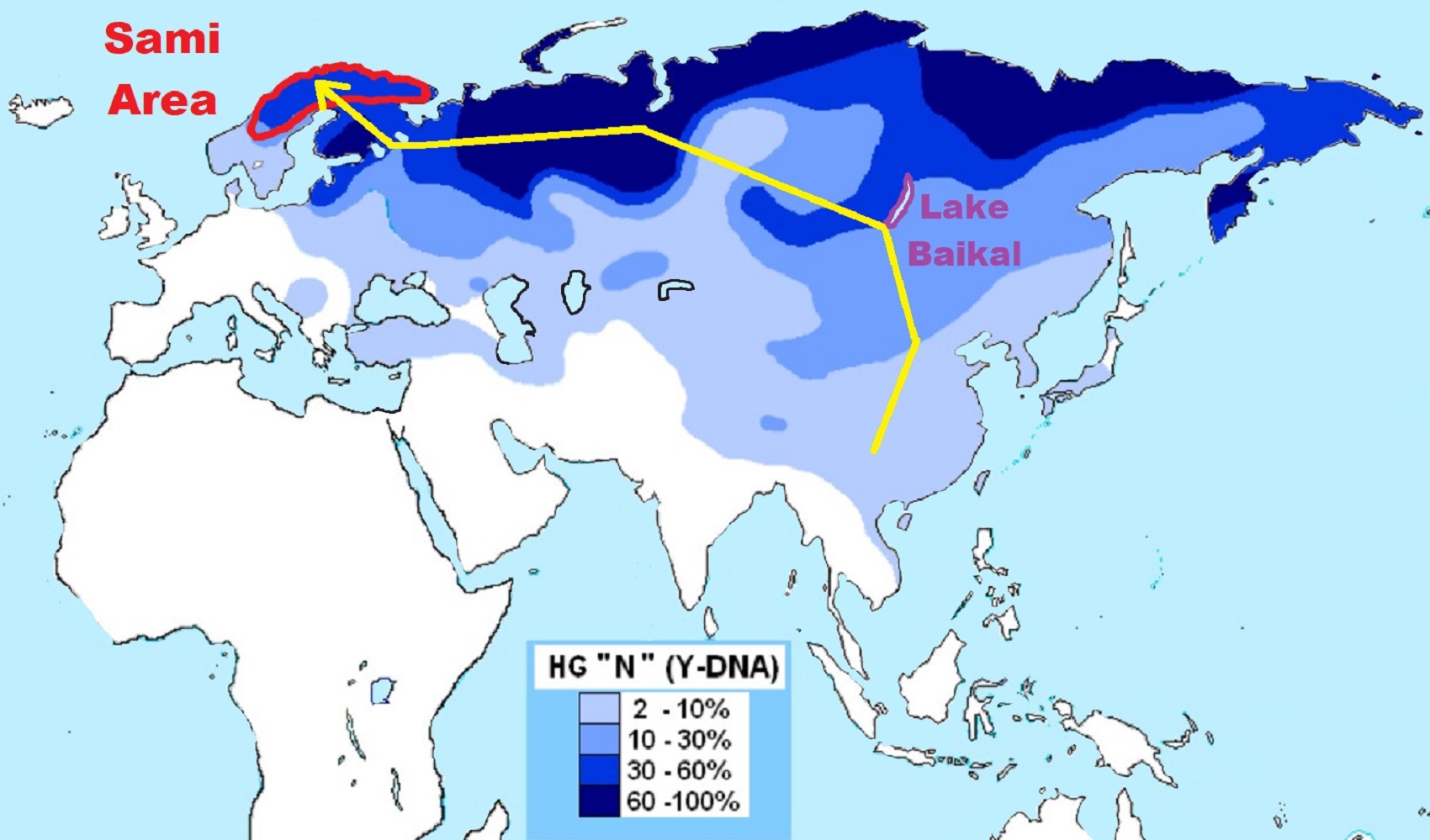
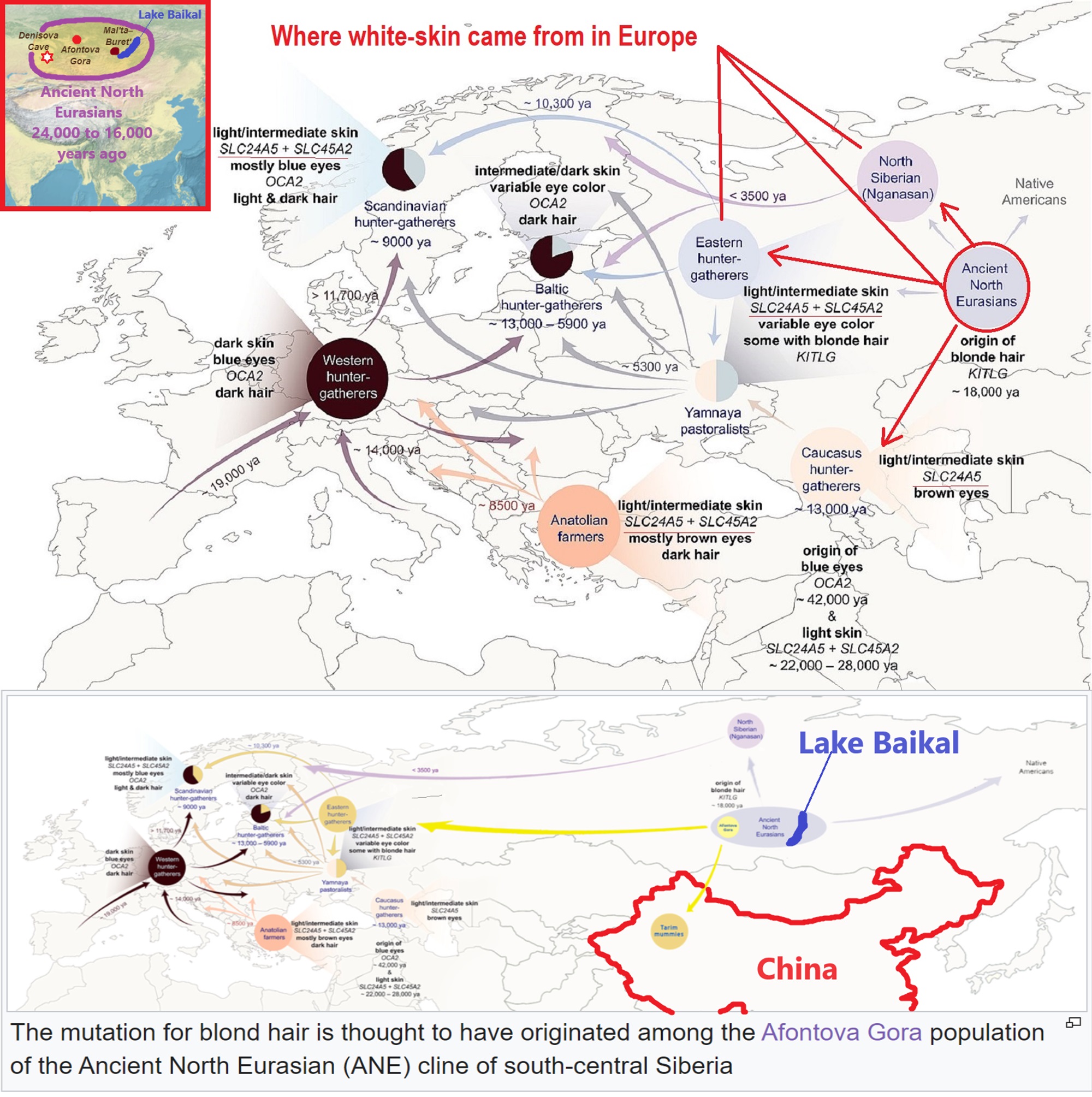
The Arrival of Siberian Ancestry Connecting the Eastern Baltic to Uralic Speakers further East
“Highlights:
-
Increase in hunter-gatherer ancestry in Bronze Age Eastern Baltic genomes
- Genetic input from Siberia to the Eastern Baltic during the transition to Iron Age
- Arrival of Siberian ancestry coincides with the proposed arrival of Uralic languages
- Light eyes, hair, and skin and lactose tolerance become frequent in the Bronze Age” ref
“In this study, we compare the genetic ancestry of individuals from two as yet genetically unstudied cultural traditions in Estonia in the context of available modern and ancient datasets: 15 from the Late Bronze Age stone-cist graves (1200–400 BCE) (EstBA) and 6 from the Pre-Roman Iron Age tarand cemeteries (800/500 BCE–50 CE) (EstIA). We also included 5 Pre-Roman to Roman Iron Age Ingrian (500 BCE–450 CE) (IngIA) and 7 Middle Age Estonian (1200–1600 CE) (EstMA) individuals to build a dataset for studying the demographic history of the northern parts of the Eastern Baltic from the earliest layer of Mesolithic to modern times. Our findings are consistent with EstBA receiving gene flow from regions with strong Western hunter-gatherer (WHG) affinities and EstIA from populations related to modern Siberians. The latter inference is in accordance with Y chromosome (chrY) distributions in present-day populations of the Eastern Baltic, as well as patterns of autosomal variation in the majority of the westernmost Uralic speakers. This ancestry reached the coasts of the Baltic Sea no later than the mid-first millennium BCE; i.e., in the same time window as the diversification of west Uralic (Finnic) languages. Furthermore, phenotypic traits often associated with modern Northern Europeans, like light eyes, hair, and skin, as well as lactose tolerance, can be traced back to the Bronze Age in the Eastern Baltic.” ref
“The Eastern Baltic has witnessed several population shifts since people reached its southern part during the Final Paleolithic ∼11,000–10,000 BCE and its northern part during the Mesolithic ∼9000 BCE. No genetic information is available from Paleolithic populations, but Mesolithic hunter-gatherers of the Kunda and Narva cultures were genetically most similar to Western hunter-gatherers (WHGs) widespread in Europe. A genetic shift toward Eastern hunter-gatherer (EHG) genetic ancestry occurred with the arrival of the Neolithic Comb Ceramic culture (CCC) people ∼3900 BCE. The Late Neolithic (LN) Corded Ware culture (CWC) people of Ponto-Caspian steppe origin brought farming into the Eastern Baltic ∼2800 BCE, contrary to most of Europe, where the Neolithic transition was mediated by Aegean early farmers. Human remains radiocarbon dated to the Early Bronze Age (ca. 1800–1200 BCE) are rare from this region, and no ancient DNA (aDNA) data are currently available. Genetic data from succeeding Bronze Age (BA) layers in Latvia and Lithuania indicate some genetic affinities with modern Eastern Baltic populations but also notable differences.” ref
“In this study, we present new genomic data from Estonian Late Bronze Age stone-cist graves (1200–400 BCE) (EstBA) and Pre-Roman Iron Age tarand cemeteries (800/500 BCE–50 CE) (EstIA). The cultural background of stone-cist graves indicates strong connections both to the west and the east. The Iron Age (IA) tarands have been proposed to mirror “houses of the dead” found among Uralic peoples of the Volga-Kama region. As this time window matches the proposed diversification period of western Uralic languages and the arrival of Proto-Finnic language in the Eastern Baltic from the east, our study considers linguistic, archaeological, and genetic data to inform on this. One of the most notable genetic features of Eastern Baltic populations is a high frequency of Y chromosome (chrY) haplogroup (hg) N3a (nomenclature of Karmin et al.), a characteristic shared mostly with Finno-Ugric-speaking groups in Europe and several populations all over Siberia. The rapid expansion of people carrying these lineages likely took place within the last 5,000 years, but their arrival time in the Eastern Baltic remains unresolved. The gene flow from Siberia to western-Uralic-speaking populations has also recently been inferred using autosomal data. However, available aDNA data have not revealed chrY hg N lineages in Eastern Baltic individuals.” ref
“To characterize the genetic ancestry of people from the so-far-unstudied cultural layers, we extracted DNA from the tooth roots of 56 individuals (Figure 1A; Table S1; STAR Methods). No individuals were included from later IA in Estonia because people were mostly cremated during that period. Individuals morphologically sexed as males were prioritized in sampling to make comparisons using autosomal and both sex chromosomes. We shotgun sequenced all samples and they formed 3 groups: (1) 15 with low endogenous DNA content and resulting coverage, which were excluded from further analyses; (2) 8 with sufficient mtDNA (and in some cases, chrY) coverage for determining hgs, but not for informative autosomal analyses; and (3) 33 that yielded sufficient autosomal data for informative analyses. The 33 individuals included 15 from EstBA, 6 from EstIA, 5 from Pre-Roman to Roman Iron Age Ingria (500 BCE–450 CE) (IngIA), and 7 from Middle Age Estonia (1200–1600 CE) (EstMA) and yielded endogenous DNA ∼4%–88%, average genomic coverages ∼0.017–0.734×, and contamination estimates <4% (Table S1). We analyzed the data in the context of modern and other ancient individuals, including from Neolithic Estonia.” ref
“We identified chrY hgs for 30 male individuals (Tables 1 and S2; STAR Methods). All 16 successfully haplogrouped EstBA males belonged to hg R1a, showing no change from the CWC period, when this was also the only chrY lineage detected in the Eastern Baltic. Three EstIA and two IngIA individuals also belonged to hg R1a, but three EstIA males belonged to hg N3a, the earliest so far observed in the Eastern Baltic. Three EstMA individuals belonged to hg N3a, two to hg R1a, and one to hg J2b. ChrY lineages found in the Baltic Sea region before the CWC belong to hgs I, R1b, R1a5, and Q. Thus, it appears that these lineages were substantially replaced in the Eastern Baltic by hg R1a, most likely through steppe migrations from the east. Although we did not detect N3a chrYs in our BA sample, unlike in BA Fennoscandia, we cannot rule out its presence due to small sample size. However, the frequency should not exceed 0.17 with 95% and 0.25 with 99% confidence. The frequency of hg N3a was significantly higher in our IA than our BA group (Fisher’s exact test p value 0.013). Our results enable us to conclude that, although the expansion time for R1a1 and N3a3′5 in Eastern Europe is similar, hg N3a likely reached Estonia or at least became comparably frequent to modern Estonia only during the BA-IA transition.
“To assess whether the Eastern Eurasian influence indicated by chrY hg N3a is apparent elsewhere in the genome, we first applied principal-component analysis (PCA). We projected ancient genomes from previous studies (Table S3) and this study on two axes inferred using Estonian Biocenter Illumina genotyping array data (EBC-chipDB) of modern Western Eurasian individuals (Table S3) (Figure 1C). A clear shift toward West Eurasian hunter-gatherers is visible between European LN and BA (including Baltic CWC) and EstBA individuals, the latter clustering together with Latvian and Lithuanian BA individuals. EstIA, IngIA, and EstMA individuals project between BA individuals and modern Estonians, partially overlapping with both. We performed ADMIXTURE analysis by projecting aDNA data on worldwide EBC-chipDB modern data (Figures S1C and S1D; Table S3) and present results at K = 9 (Figures 1B, S1A, and S1B; STAR Methods). EstBA individuals are clearly distinguishable from Estonian CWC individuals as the former have more of the blue component most frequent in WHGs and less of the brown and yellow components maximized in Caucasus hunter-gatherers and modern Khanty, respectively. The individuals of EstBA, EstIA, IngIA, EstMA, and modern Estonia are quite similar to each other on average, indicating that the relatively high proportion of WHG ancestry in modern Eastern Baltic populations compared to other present-day Europeans traces back to the BA.” ref
“When comparing Estonian CWC and EstBA using autosomal outgroup f3 and Patterson’s D statistics (Table S3), the latter is more similar to other Baltic BA populations, to Baltic IA and Middle Age (MA) populations, and also to populations similar to WHGs and Scandinavian hunter-gatherers (SHGs), but not to Estonian CCC (Figures 2A and S2A; Data S1). The increase in WHG or SHG ancestry could be connected to western influences seen in material culture and facilitated by a decline in local population after the CCC-CWC period. A slight trend of bigger similarity of Estonian CWC to forest or steppe zone populations and of EstBA to European early farmer populations can also be seen. These differences remain when over 900,000 positions of the ‘1240k’ capture are used instead of ∼500,000 positions of the EBC-chipDB (Figure S2B; Data S1). When comparing to modern populations, Estonian CWC is slightly more similar to Caucasus individuals but EstBA to Baltic populations and Finnic speakers (Figure 2B; Data S1). Outgroup f3 and D statistics do not reveal apparent differences when comparing EstBA to EstIA, EstIA to IngIA, and EstIA to EstMA (Data S1). These results highlight how uniparental and autosomal data can lead to different demographic inferences—the genetic change between CWC and BA not seen in uniparental lineages is clear in autosomal data and the appearance of chrY hg N in the IA is not matched by a clear shift in autosomal profiles.” ref
“We imputed the genotypes of 37 phenotype informative SNVs from the HIrisPlex-S system, two from TLR1, and one from MCM6 gene and a 32-bp deletion (rs333) in the CCR5 gene for Mesolithic and Neolithic individuals from Latvia and Estonia and the individuals of this study. We inferred a sharp increase to >50% in the frequency of the lactase persistence variant (MCM6/rs4988235) in the Baltic area after the LN (Data S2), in line with previous indications of this variant becoming common in Europe in the last 4,000–3,500 years and of its fast increase in populations with steppe ancestry due to local adaptation. In contrast, the rs333, responsible for HIV resistance, which we first detect in a CWC individual, remains at 10%–25% frequency since then (Data S2), comparable to its present-day 14.8% frequency in Estonia. Both TLR1 variants involved in the protection against leprosy were already present in Europe at medium-high frequencies since the Mesolithic (Data S2). Notably, we infer a high proportion (40%–60%) of dark skin pigmentation in the hunter-gatherers and CWC farmers (Data S2). We infer dark skin and blue eyes for two individuals, similarly to another European Mesolithic individual. However, from BA onward, we infer pale or intermediate skin pigmentation for all individuals and an increase in the proportion of blue eyes and lighter shades of hair (Data S2). This is in line with previous suggestions that light skin pigmentation alleles reached high frequencies in Europe only recently.” ref
Conclusions
“We show that a component of possibly Siberian ancestry was added to the gene pool of the Eastern Baltic during the Bronze to Iron Age transition at the latest. This component is present in the autosomes and chrY of many northeastern European Uralic-speaking populations today but arrived in the Eastern Baltic probably later than 3,500 years ago (ya), when it reached Fennoscandia. Considering the archaeological context of the individuals, this seems to have followed the so-called southwestern route from the Volga-Ural region. Notably, the Bronze to Iron Age transition period also coincides with the hypothesized arrival of westernmost Uralic (Finnic) languages in the Eastern Baltic, supporting the idea that the spread of these languages was mediated by IA migrants from the east. The EstBA individuals of this study, as other Baltic BA individuals, display more WHG ancestry compared to both earlier CWC and modern Estonians. Interestingly, we do not detect this change in their uniparental lineages. However, half of the admittedly small EstIA sample and over one-third of modern Estonian men share a hg N3a chrY—common in other Uralic-speaking populations living much further east and not found in the Eastern Baltic earlier—although the autosomes of EstIA individuals only show 3%–5% Siberian ancestry on average. Furthermore, phenotypic characteristics often associated with modern Northern Europeans (light eyes, hair, and skin pigmentation, and lactose tolerance) can be traced back to the Bronze Age in the Eastern Baltic.” ref
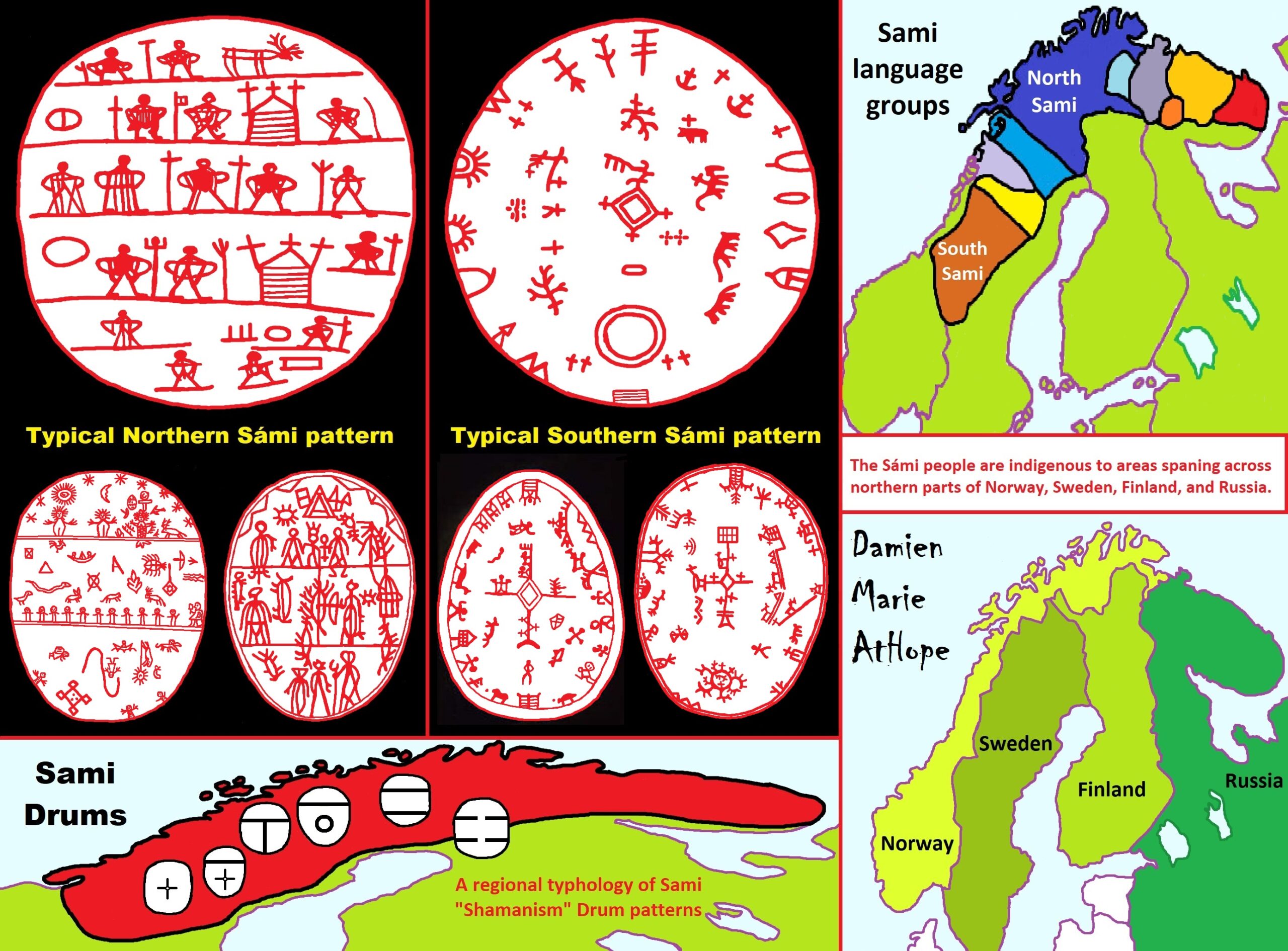
“The drum of Anders Paulsen (top left) and the Bindal drum (top right) represent variations in Sami drums, their shape, decoration and history. Paulsen’s drum was confiscated in Vadsø in 1691, while the Bindal drum was bought by a museum official in 1925; Vadsø and Bindal being in opposite corners of the Sami world. Paulsens’s drum has a typical Northern Sámi pattern, with several separate levels representing the different layers of spiritual worlds. The Bindal drum has a typical Southern Sami decoration: a rhombus-shaped sun symbol in the center, with other symbols around the sun, representing people, animals, landscape and deities.” ref
Anders Paulsen
“Anders Poulsen (died 1692), was a Sami “noaidi/shaman,” who was the last victim of the many Vardø witch trials, which took place between 1621 and 1692. In Sámi form his name was Poala-Ánde. He was born in Torne Lappmark in Sweden, married and lived in Varanger. He was active as a noaidi, and as such used a Sámi drum. The drum was taken from him by force on 7 December 1691 during the Christianization of the Sámi people, and he was put on trial for idolatry for being a follower of the Pagan Sami shamanism religion. The law used to persecute him was however formally the witchcraft law. Poulsen explained the drum’s use during his trial in February 1692. The case was considered significant and the local authorities sent a request to Copenhagen about how to deal with it. Before a sentence could be reached, however, he was killed by a fellow prisoner who suffered from insanity.” ref
“Poulsen’s drum became part of the Danish royal collection after his death and eventually entered the collections of the National Museum of Denmark. It was on loan to the Sámi Museum in Karasjok, northern Norway from 1979 but it took “a 40-year struggle” for it to be officially handed back to the Sámi people in 2022, according to Jelena Porsanger, director of the museum, following an appeal by Norway’s Sámi president to Queen Margrethe of Denmark.” ref
Sami Shamanism: Religio-Sociocultural Identity, Phenomenon, and System
Figure-stones from Fontmaure, France with all seemings to mainly depict carnivores, with a large focus on bears that make you wonder if its expressing a possible “Bear Cult” dating to around 30,000 years ago or older and these artifacts range from ‘developed Acheulian’ to ‘Mousterian of Acheulian Tradition’ or ‘proto-Aurignacian’. ref
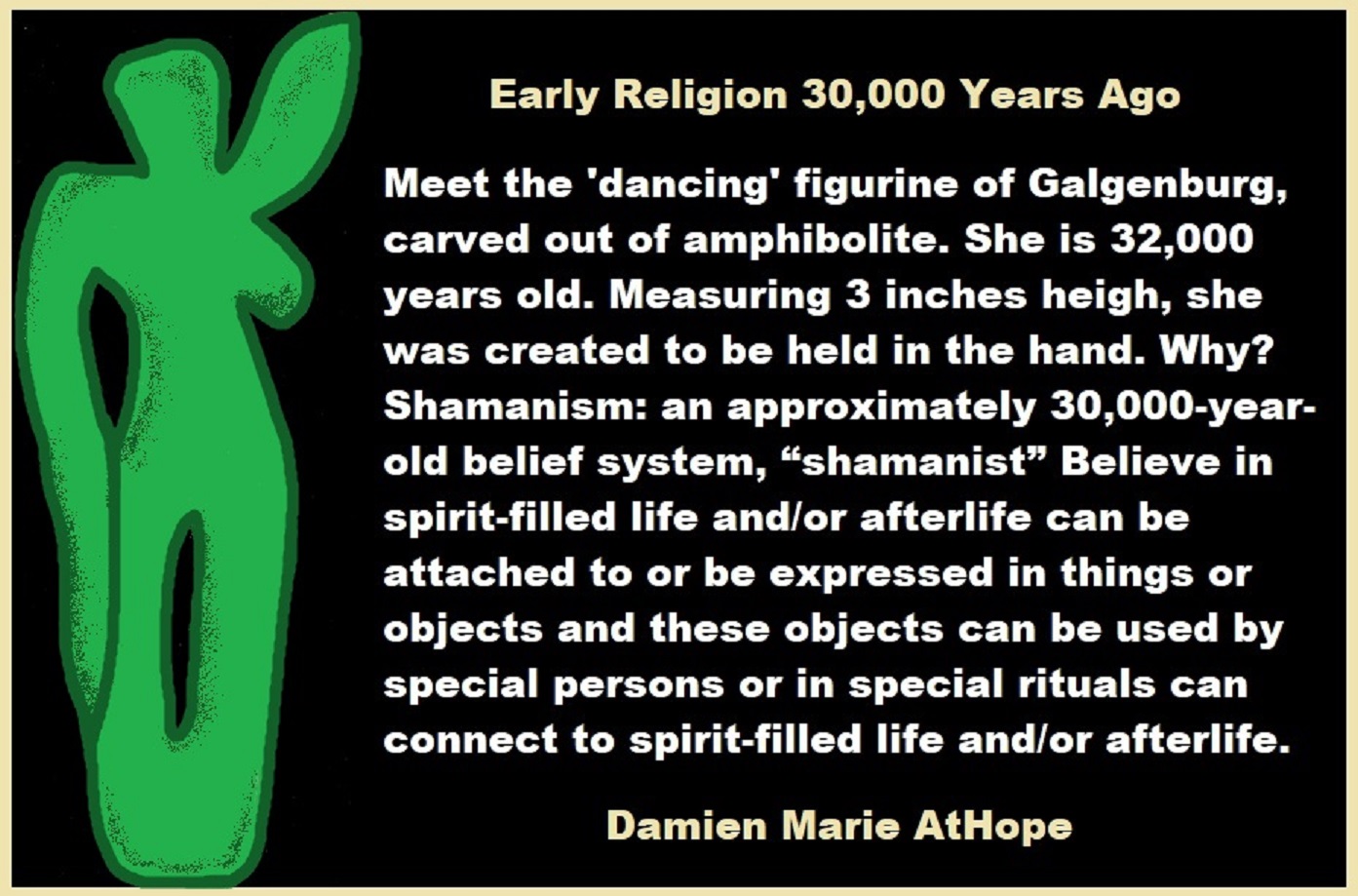
The Venus of Galgenberg is a Venus figurine of the Aurignacian era, also known in German as the Fanny von Galgenberg, discovered close to Stratzing, Austria, not far from the site of the Venus of Willendorf, a Venus figurine estimated at 30,000 years ago found at a paleolithic site near Willendorf, a village in Lower Austria carved from non-local oolitic limestone tinted with red ochre. The Venus of Galgenberg is a figurine of a woman weighing 10 g and made of greenish, very shiny amphibolite slate, the upper body is turned to the side, in a dancing position, three-dimensional front, flat back, believed to have had cultic or religious significance. The stone material is from the immediate vicinity of where the figurine was found, and the waste material provides proof that the figurine was made in the same area. Bones of horses and mammoths, as well as antlers, were found. Charcoal samples made an exact determination of the age of the finds using radiocarbon dating possible. This method resulted in an age of approximately 32,000 years for the Statuette. 11 fireplaces. Dating: between approx. 33,000 and 28,000 BP. The occurrence of amphibolite schist at a distance of several hundred meters from the site, as well as many small fragments of this raw material in the area of the fragments of a statuette, which may be waste from the original carving, support this assumption. The statuette itself is an upright standing figurine without feet, one leg touching the other at the feet. The legs are separated by a pointed oval perforation. ref, ref
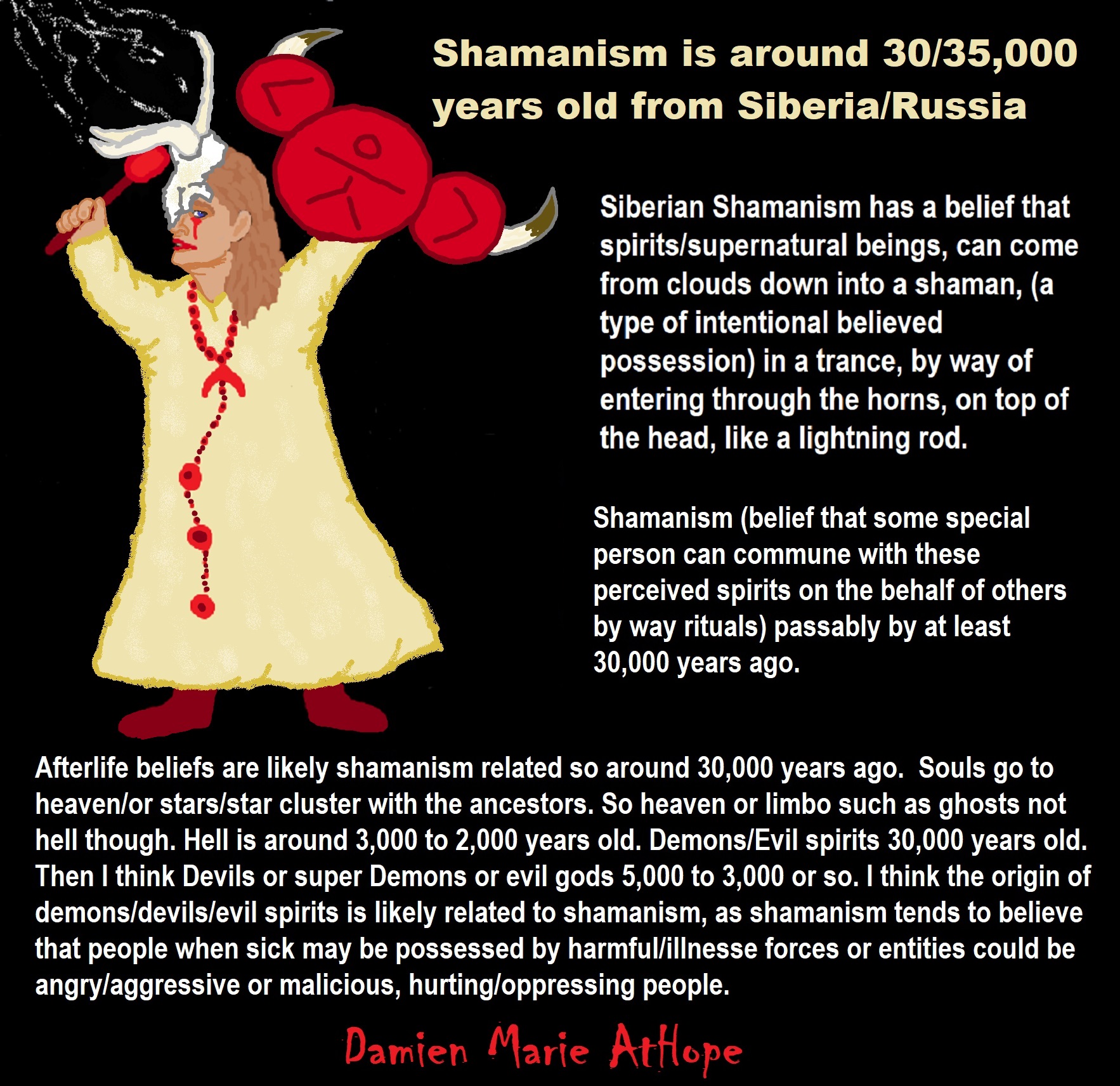
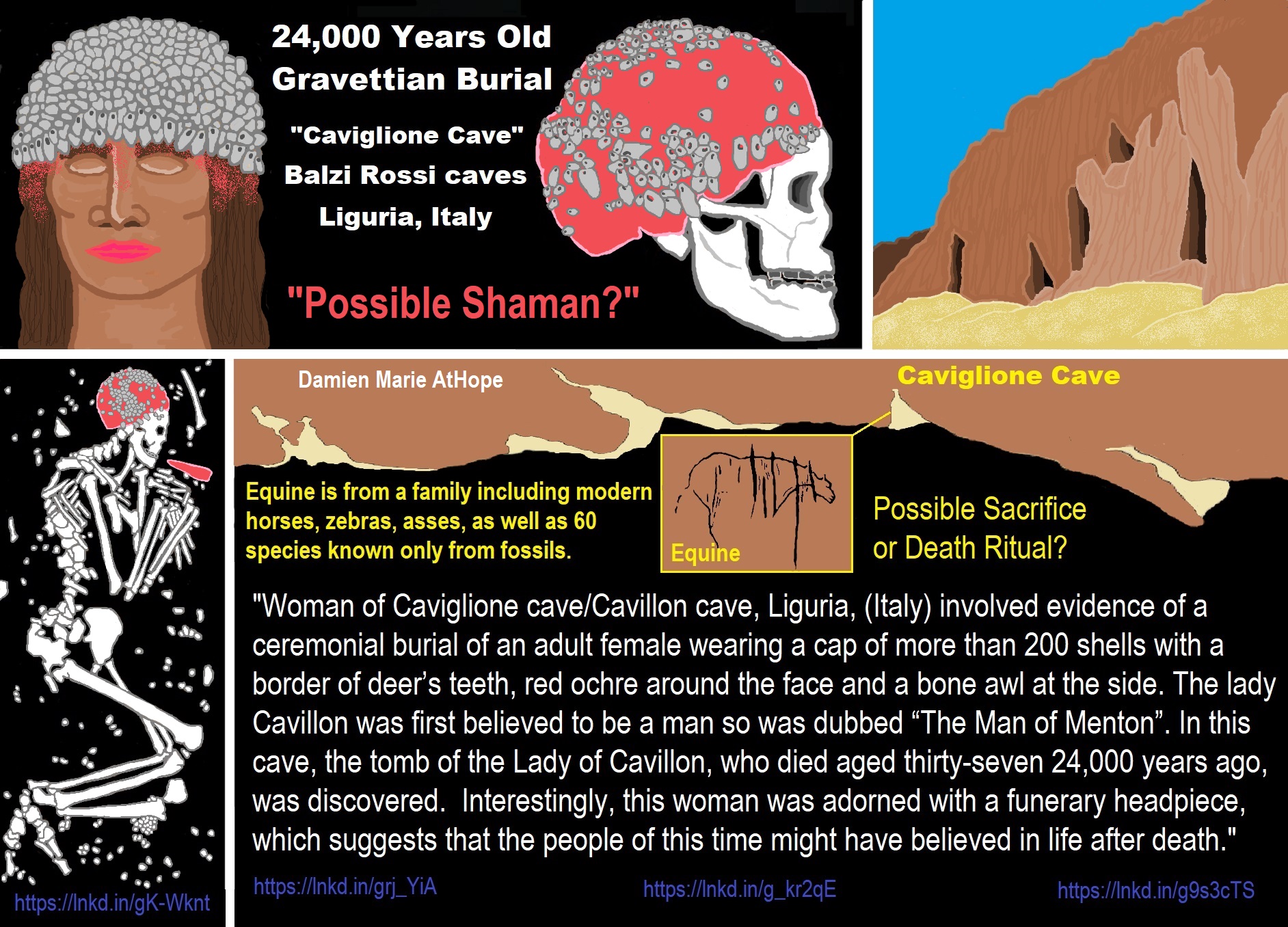
“Woman of Caviglione cave/Cavillon cave, Liguria, (Italy) involved evidence of a ceremonial burial of an adult female wearing a cap of more than 200 shells with a border of deer’s teeth, red ochre around the face and a bone awl at the side. The lady Cavillon was first believed to be a man so was dubbed “The Man of Menton”. In this cave, the tomb of the Lady of Cavillon, who died aged thirty-seven 24,000 years ago, was discovered. Interestingly, this woman was adorned with a funerary headpiece, which suggests that the people of this time might have believed in life after death.” Ref, Ref, Ref, Ref
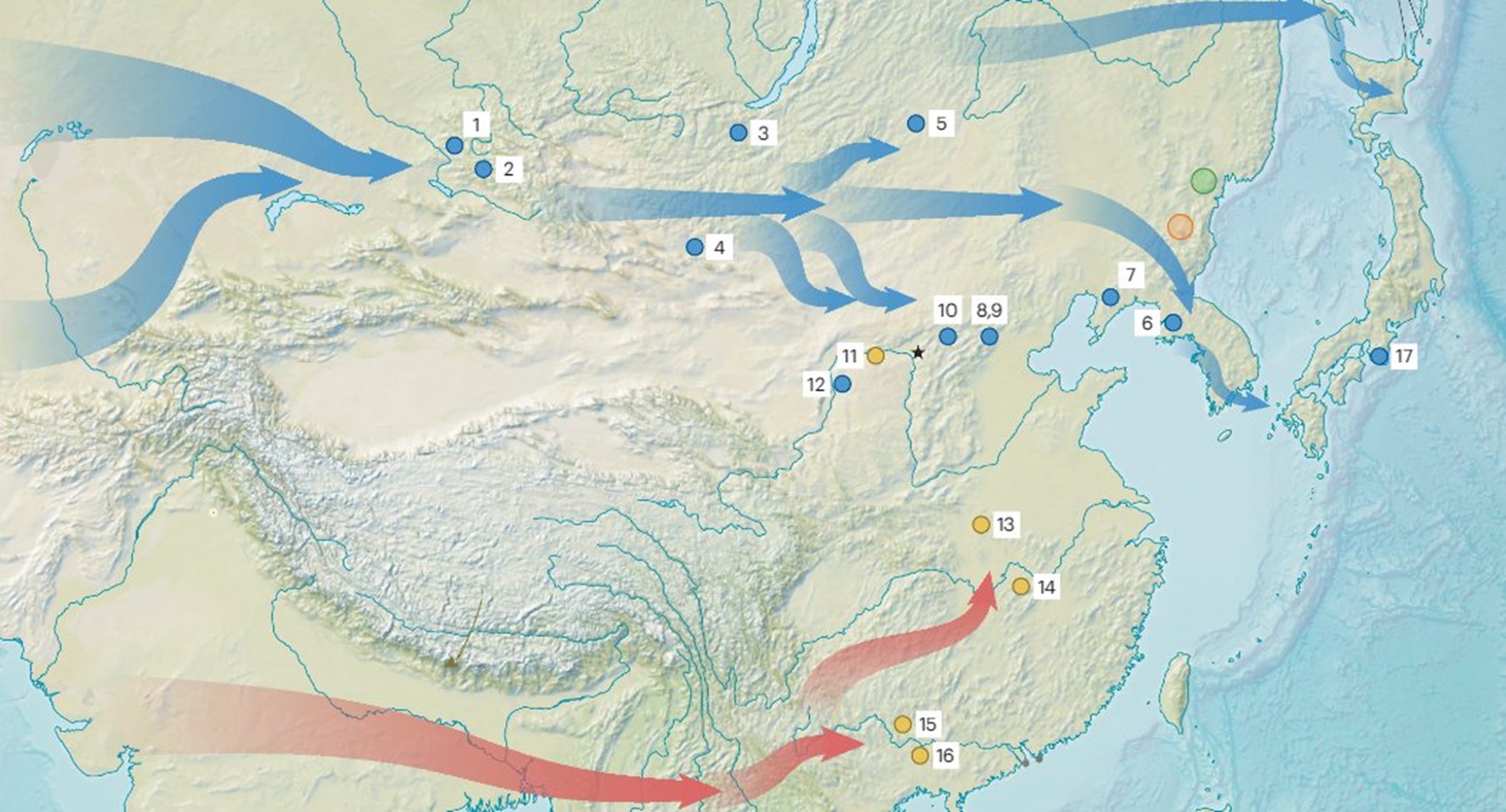
Modern humans in Northeast Asia
“A multidisciplinary study of the Shiyu archaeological site in northern China reveals a complex human behavioral record that currently is the oldest of its kind in Northeast Asia and provides insight into the nature of the northward dispersal of modern humans across Asia.” ref
“As the modern human origins debate continues to evolve, eastern Asia (including both East and Southeast Asia) is playing an increasingly important role. It is now evident that there were multiple dispersals out of Africa and across Eurasia beginning well before 60,000 years ago. Questions remain, however, regarding the dispersal routes (and timing thereof) that modern humans took out of Africa. Currently, it appears that initial late Middle Pleistocene (<300,000 years ago) human movements out of Africa spread into the Levant and touched southeastern Europe before spreading more widely across southern Asia, eventually arriving in Southeast Asia, including southern China, sometime between 120,000 years ago and 60,000 years ago. The early spread across northern Asia has been less clear. Most data suggest that the northern Asian expansion of modern humans largely occurred after 60,000 years ago, with sites appearing in Siberia, Mongolia, northern China, Korea, and Japan soon after 50,000 years ago. This later northern expansion included a westward dispersal into Europe. Writing in Nature Ecology & Evolution, Yang et al. report on multidisciplinary research from the northern Chinese site of Shiyu that brings some clarity to the nature of the dispersal of modern humans across Northeast Asia.” ref
“The potential importance of Shiyu has been evident since its discovery in 1963, as it has yielded more than 15,000 stone tools, including blades, Levallois flakes, other artifacts (for example, a perforated black disc and a bone tool), and thousands of vertebrate remains. Older (early Late Pleistocene) sites appear in central and southern China, indicative of earlier dispersals into eastern Asia from the southern route. The northward dispersal route appears to be part of the larger movement out of Africa after 60,000 years ago that included movement westward into Europe. Who (modern humans, Neanderthals, Denisovans, or a different group altogether) left the miniaturized stone tools at the Fanjiagouwan site that dates between 100,000 years ago and 90,000 years ago is still unclear. Black star, Shiyu; yellow circle, early Late Pleistocene (~120,000 years ago to ~60,000 years ago) site; blue circle: middle Late Pleistocene (~60,000 years ago to ~ 30,000 years ago) site; green circle, Gladkaya obsidian source; orange circle, Changbai obsidian source. (1) Denisova; (2) Kara Bom; (3) Tolbor 16; (4) Tsagaan Agui; (5) Salkhit; (6) Ryonggok; (7) Xiaogushan; (8) Zhoukoudian Upper Cave; (9) Tianyuandong; (10) Xiamabei; (11) Fanjiagouwan; (12) Shuidonggou; (13) Huanglongdong; (14) Fuyandong; (15) Lunadong; (16) Zhirendong; (17) Idemaruyama.” ref
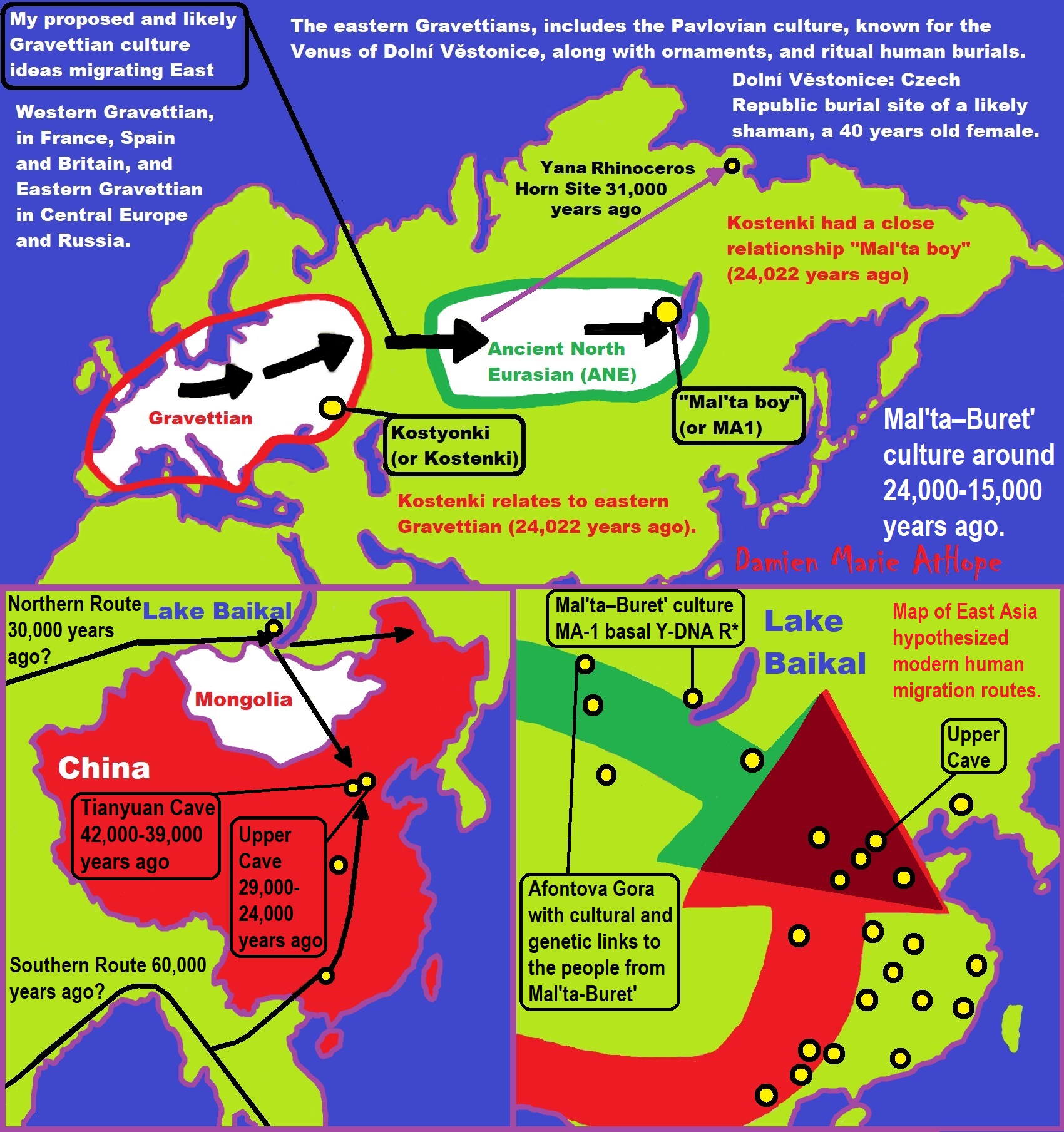
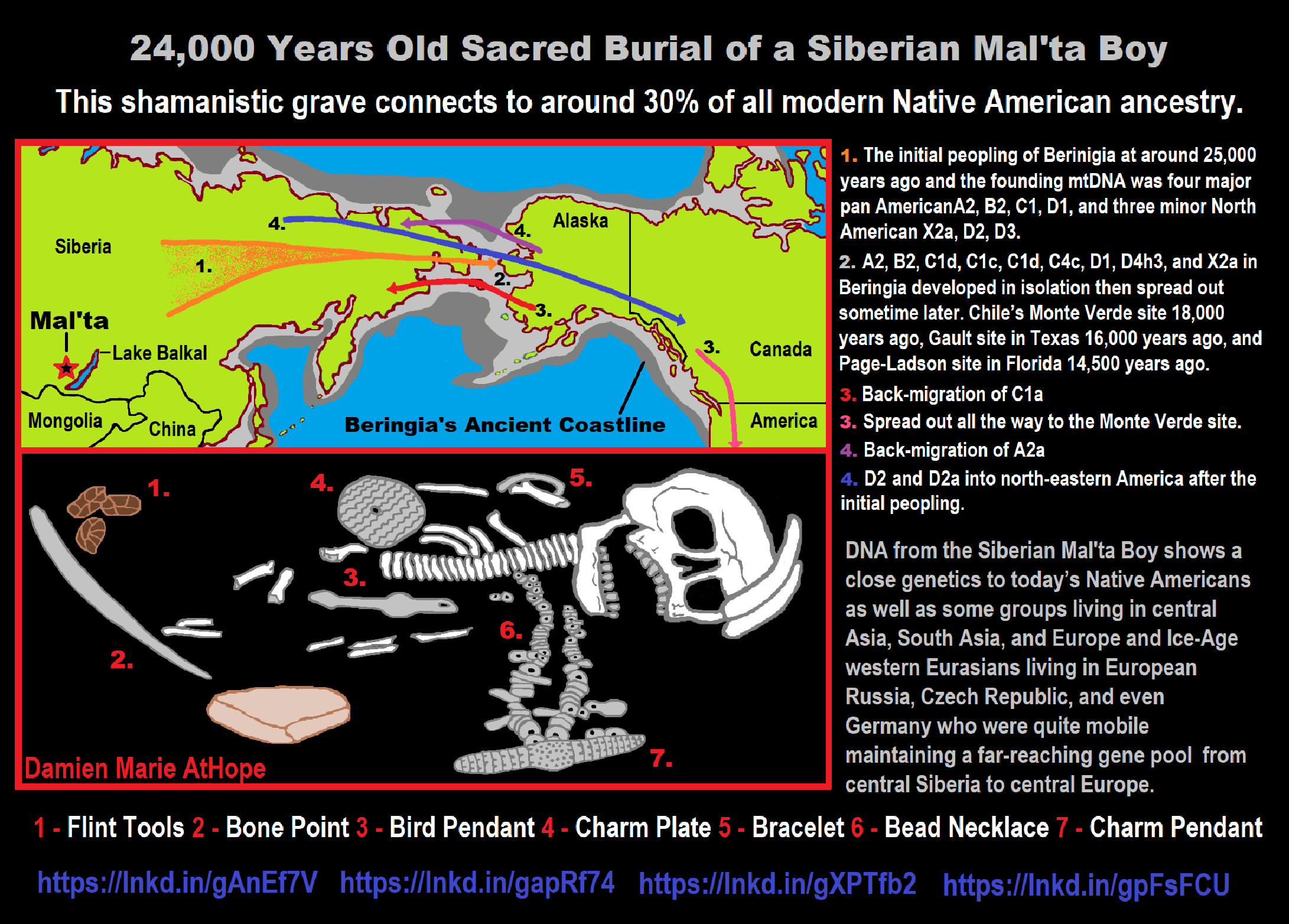
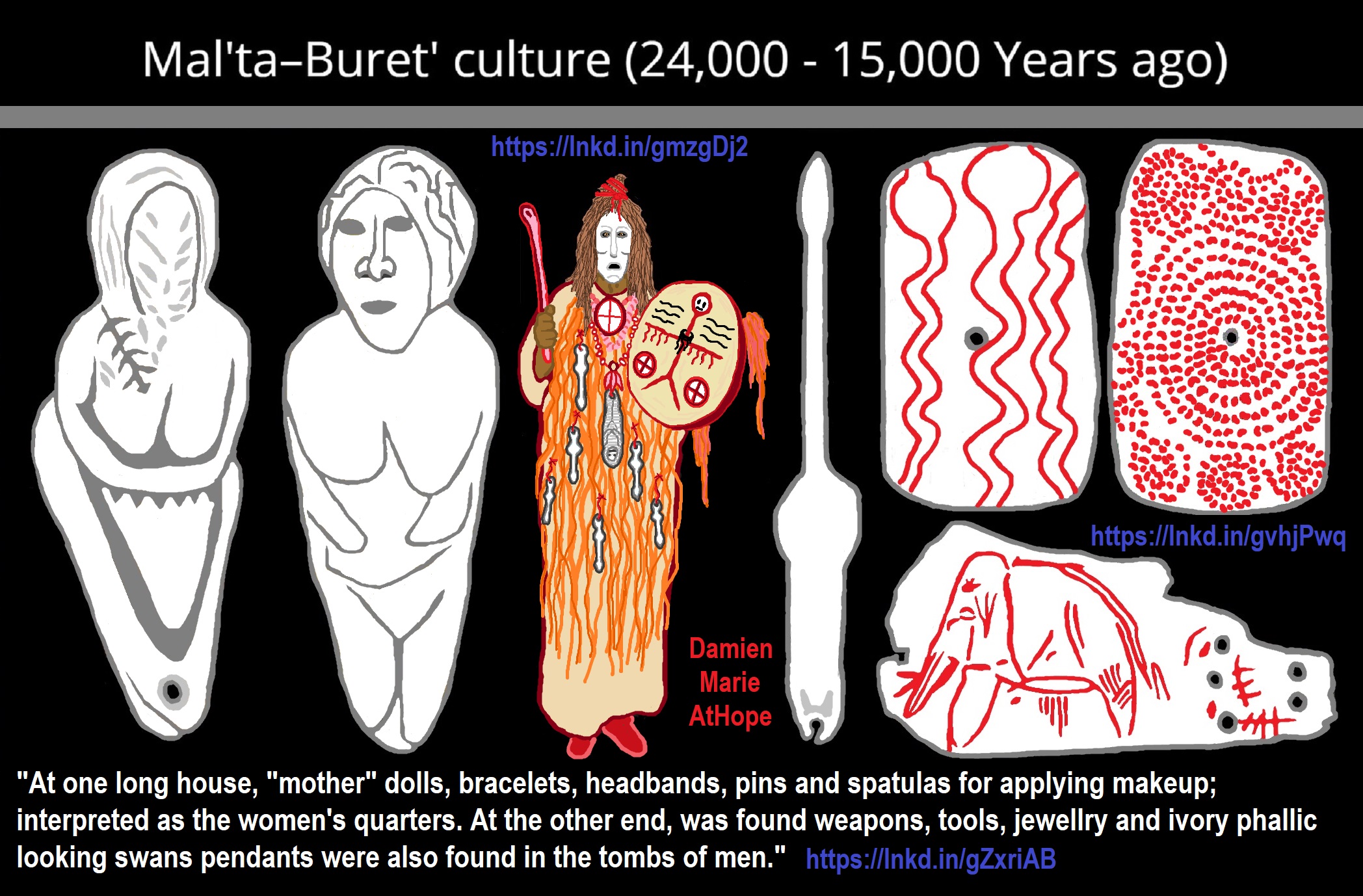
Mal’ta–Buret’ culture
“The Mal’ta–Buret’ culture (also Maltinsko-buretskaya culture) is an archaeological culture of the Upper Paleolithic (generally dated to 24,000-15,000 years ago). It is located roughly northwest of Lake Baikal, about 90km to the northwest of Irkutsk, on the banks of the upper Angara River. The type sites are named for the villages of Mal’ta (Мальта́), Usolsky District and Buret’ (Буре́ть), Bokhansky District (both in Irkutsk Oblast).” ref
“A boy whose remains were found near Mal’ta is usually known by the abbreviation MA-1 (or MA1) dated to 24,000 years ago. According to research published since 2013, MA-1 belonged to the population of Ancient North Eurasians, who were genetically “intermediate between modern western Eurasians and Native Americans, but distant from east Asians”, and partial genetic ancestors of Siberians, American Indians, and Bronze Age Yamnaya and Botai people of the Eurasian steppe. In particular, modern-day Native Americans, Kets, Mansi, and Selkup have been found to harbor a significant amount of ancestry related to MA-1. MA-1 is the only known example of basal Y-DNA R* (R-M207*) – that is, the only member of haplogroup R* that did not belong to haplogroups R1, R2, or secondary subclades of these. The mitochondrial DNA of MA-1 belonged to an unresolved subclade of haplogroup U.” ref
“Mal’ta consists of semi-subterranean houses that were built using large animal bones to assemble the walls, and reindeer antlers covered with animal skins to construct a roof that would protect the inhabitants from the harsh elements of the Siberian weather. These dwellings built from mammoth bones were similar to those found in Upper Paleolithic Western Eurasia, such as in the areas of France, Czechoslovakia, and Ukraine. Evidence seems to indicate that Mal’ta is the most ancient known site in eastern Siberia, with the nearby site of Buret’.” ref
“However, relative dating illustrates some irregularities. The use of flint flaking and the absence of pressure flaking used in the manufacture of tools, as well as the continued use of earlier forms of tools, seem to confirm the fact that the site belongs to the early Upper Paleolithic. Yet it lacks typical skreblos (large side scrapers) that are common in other Siberian Paleolithic sites. Additionally, other common characteristics such as pebble cores, wedge-shaped cores, burins, and composite tools have never been found. The lack of these features, combined with an art style found in only one other nearby site (the Venus of Buret’), make Mal’ta culture unique in Siberia.” ref
“There were two main types of art during the Upper Paleolithic: mural art, which was concentrated in Western Europe, and portable art. Portable art, typically some type of carving in ivory tusk or antler, spans the distance across Western Europe into Northern and Central Asia. Artistic remains of expertly carved bone, ivory, and antler objects depicting birds and human females are the most commonly found; these objects are, collectively, the primary source of Mal’ta’s acclaim.” ref
“In addition to the female statuettes there are bird sculptures depicting swans, geese, and ducks. Through ethnographic analogy comparing the ivory objects and burials at Mal’ta with objects used by 19th and 20th-century Siberian shamans, it has been suggested that they are evidence of a fully developed shamanism. Also, there are engraved representations on slabs of mammoth tusk. One is the figure of a mammoth, easily recognizable by the trunk, tusks, and thick legs. Wool also seems to be etched, by the placement of straight lines along the body. Another drawing depicts three snakes with their heads puffed up and turned to the side. It is believed that they were similar to cobras.” ref
“Perhaps the best example of Paleolithic portable art is something referred to as “Venus figurines“. The Mal’ta boy (dated 24,000 years ago) was buried with various artifacts and a Venus figurine. Until they were discovered in Mal’ta, “Venus figurines” were previously found only in Europe. Carved from the ivory tusk of a mammoth, these images were typically highly stylized, and often involved embellished and disproportionate characteristics (typically the breasts or buttocks). It is widely believed that these emphasized features were meant to be symbols of fertility. Around thirty female statuettes of varying shapes have been found in Mal’ta. The wide variety of forms, combined with the realism of the sculptures and the lack of repetitiveness in detail, are definite signs of developed, albeit early, art.” ref
“At first glance, what is obvious is that the Mal’ta Venus figurines are of two types: full-figured women with exaggerated forms, and women with a thin, delicate form. Some of the figures are nude, while others have etchings that seem to indicate fur or clothing. Conversely, unlike those found in Europe, some of the Venus figurines from Mal’ta were sculpted with faces. Most of the figurines were tapered at the bottom, and it is believed that this was done to enable them to be stuck into the ground or otherwise placed upright. Placed upright, they could have symbolized the spirits of the dead, akin to “spirit dolls” used nearly worldwide, including in Siberia, among contemporary people.” ref
“The Mal’ta figurines garner interest in the western world because they seem to be of the same basic form as European female figurines of roughly the same time period, suggestion some cultural and cultic connection. This similarity between Mal’ta and Upper Paleolithic Europe coincides with other suggested similarities between the two, such as in their tools and dwelling structures. A 2016 genomic study shows that the Mal’ta people have no genetic connections to the Dolní Věstonice people from the Gravettian culture. The researchers conclude that the similarity between the figurines may be either due to cultural diffusion or to a coincidence, but not to common ancestry between the populations.” ref
“Discussing this easternmost outpost of paleolithic culture, Joseph Campbell finishes by commenting on the symbolic forms of the artifacts found there:
We are clearly in apaleolithicprovince where theserpent,labyrinth, and rebirth themes already constitute a symbolic constellation, joined with the imagery of the sunbird andshamanflight, with the goddess in her classic role ofprotectress of the hearth, mother of man’s second birth, andlady of wild thingsand of the food supply.” ref
“The term Ancient North Eurasian (ANE) has been given in genetic literature to an ancestral component that represents descent from the people similar to the Mal’ta–Buret’ culture and the closely related population of Afontova Gora. A people similar to MA1 and Afontova Gora were important genetic contributors to Native Americans, Siberians, Europeans, Caucasians, Central Asians, with smaller contributions to Middle Easterners and some East Asians. Lazaridis et al. (2016) notes “a cline of ANE ancestry across the east-west extent of Eurasia.” The “ANE-cline”, as observed among Paleolithic Siberian populations and their direct descendants, developed from a sister lineage of Europeans with significant admixture from early East Asians. MA1 is also related to two older Upper Paleolithic Siberian individuals found at the Yana Rhinoceros Horn Site called Ancient North Siberians (ANS).” ref
Afontova Gora
“Afontova Gora is a Late Upper Paleolithic and Mesolithic Siberian complex of archaeological sites located on the left bank of the Yenisei River near the city of Krasnoyarsk, Russia. Afontova Gora has cultural and genetic links to the people from Mal’ta-Buret’. The complex was first excavated in 1884 by Ivan Savenkov. Afontova Gora is a complex, consisting of multiple stratigraphic layers, of five or more campsites. The campsites shows evidence of mammoth hunting and were likely the result of an eastward expansion of mammoth hunters. The human fossils discovered at Afontova Gora, a male and a girl dated to 17,000~15,000 years ago.” ref
“Afontova Gora I is situated on the western bank of the Enisei River and has yielded the remains from horse, mammoth, reindeer, steppe bison, and large canids. A canid tibia has been dated 16,900 years old and the skull has been taxonomically described as being that of a dog, but it is now lost. Its description falls outside of the range of Pleistocene or modern northern wolves. (The name Afontova Gora 1 refers to the remains of a canid.)” ref
“Afontova Gora II is the site human fossil remains were found, and remains of mammoth, Arctic fox, Arctic hare, reindeer, bison, and horse were discovered at the site. Afontova Gora II consists of 7 layers. Layer 3 from Afontova Gora II is the most significant: the layer produced the largest amount of cultural artifacts and is the layer where the human fossil remains were discovered. Over 20,000 artifacts were discovered at layer 3: this layer produced over 450 tools and over 250 osseous artifacts (bone, antler, ivory). The fossils of two distinct individuals were discovered in the initial excavations: the upper premolar of an 11-15-year-old child and the left radius, ulna, humerus, phalanx, and frontal bone of an adult.” ref
“The bodies of two individuals, known as Afontova Gora 2 (AG2). The human fossil remains of Afontova Gora 2 were dated to around 17,000 years ago. DNA from the humerus of Afontova Gora 2, despite significant contamination, DNA analysis confirmed that the individual was male. The individual showed close genetic affinities to Mal’ta 1 (Mal’ta boy). Afontova Gora 2 also showed a greater genetic affinity for the Karitiana people than for the Han Chinese. Around 1.9-2.7% of the genome was Neanderthal in origin. More human fossil remains were discovered at Afontova Gora II, The remains belonged to two different females: the atlas of an adult female and the mandible and five lower teeth of a teenage girl (Afontova Gora 3) estimated to be around 14–15 years old. Initially, the new findings were presumed to be roughly contemporaneous with Afontova Gora 2.” ref
“Afontova Gora III is a site that consists of 3 layers. Afontova Gora 3 (AG3) was discovered within the complex. Direct AMS dating revealed that Afontova Gora 3 is dated to around 16,090 cal BCE or around 18,090 years ago). Researchers analyzing the dental morphology of Afontova Gora 3 concluded that the teeth showed distinct characteristics with most similarities to another fossil (the Listvenka child) from the Altai-Sayan region and were neither western nor eastern. Afontova Gora 3 and Listvenka showed distinct dental characteristics that were also different from other Siberian fossils, including those from Mal’ta.” ref
“DNA was extracted from one of the teeth of Afontova Gora 3 and analyzed. Compared to Afontova Gora 2, researchers were able to obtain higher coverage genomes from Afontova Gora 3. DNA analysis confirmed that the individual was female. mtDNA analysis revealed that Afontova Gora 3 belonged to the mitochondrial Haplogroup R1b. Around 2.9-3.7% of the genome was Neanderthal in origin. Researchers determined that Afontova Gora 2, Afontova Gora 3, and Mal’ta 1 (Mal’ta boy) shared common descent and were clustered together in a Mal’ta cluster. Genetically, Afontova Gora 3 is not closer to Afontova Gora 2 when compared to Mal’ta 1. When compared to Mal’ta 1, the Afontova Gora 3 lineage apparently contributed more to modern humans and is genetically closer to Native Americans.” ref
“Phenotypic analysis shows that Afontova Gora 3 carries the derived rs12821256 allele associated with, and likely causal for, blond hair color, making Afontova Gora 3 the earliest individual known to carry this derived allele. The allele was found in three later members of the largely ANE-derived Eastern Hunter-Gatherers populations from Samara, Motala and Ukraine c. 10,000 years ago, suggesting that it originated in the Ancient North Eurasian population before spreading to western Eurasia. The hundreds of millions of copies of this mutated alelle (a single-nucleotide polymorphism) are at the root of the classic European blond hair mutation, as massive population migrations from the Eurasian steppe, by a people who had substantial Ancient North Eurasian ancestry, entered continental Europe.” ref
“A genetic study on the Tarim mummies found that they were primarily descended from a population represented by the Afontova Gora 3 specimen (AG3), genetically displaying “high affinity” with it. The genetic profile of the Afontova Gora 3 individual represented about 72% of the ancestry of the Tarim mummies, while the remaining 28% of their ancestry was derived from Baikal EBA (Early Bronze Age Baikal populations). The Tarim mummies are thus one of the rare Holocene populations who derive most of their ancestry from the Ancient North Eurasians (ANE, specifically the Mal’ta and Afontova Gora populations), despite their distance in time (around 14,000 years). More than any other ancient populations, they can be considered as “the best representatives” of the Ancient North Eurasians.” ref
“Afontova Gora V is the site where remains of hare, pika, cave lion, horse, reindeer, bison, and partridge were discovered at the site.” ref


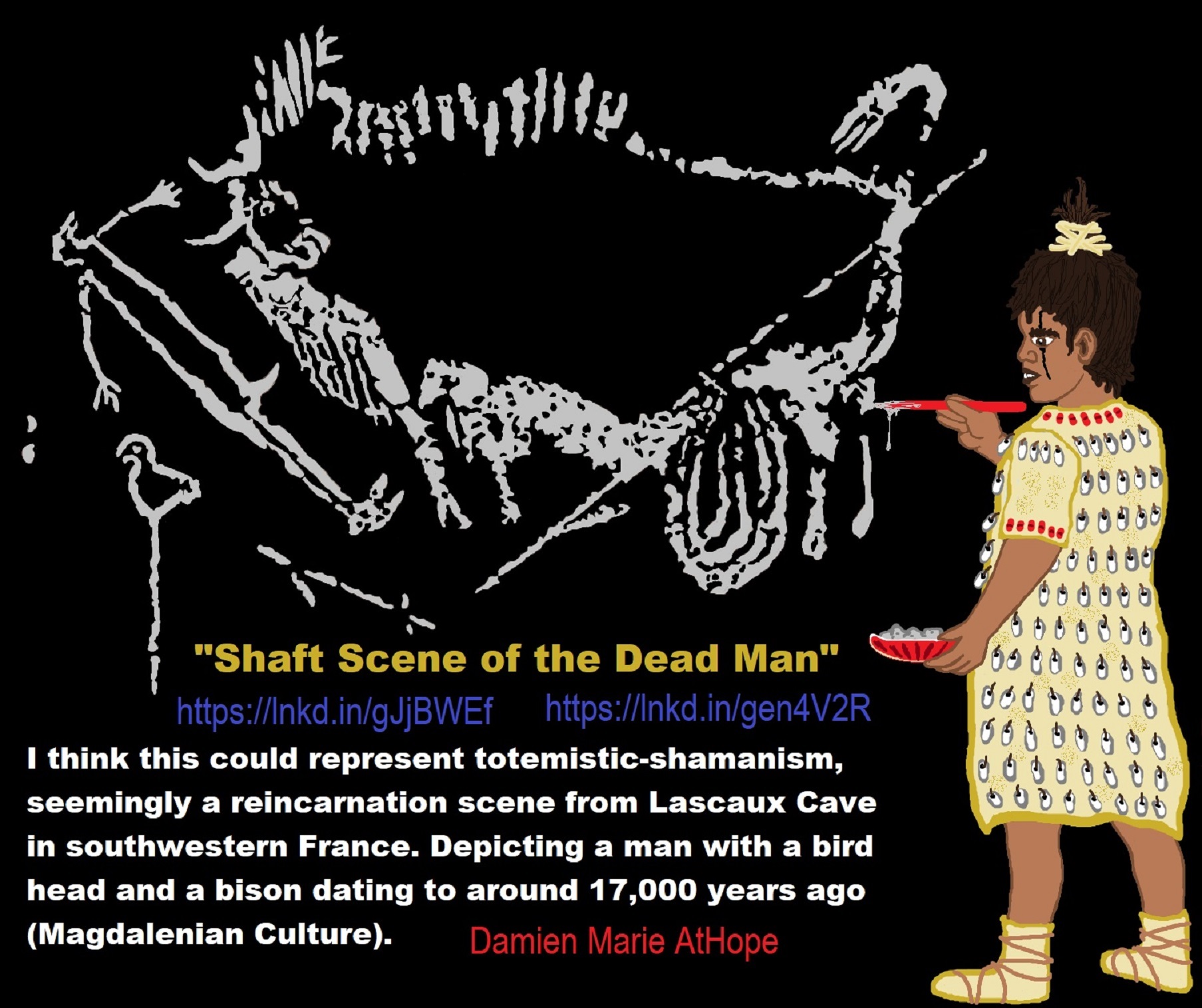
Magdalenian
“The Magdalenian cultures (also Madelenian; French: Magdalénien) are later cultures of the Upper Paleolithic and Mesolithic in western Europe. They date from around 17,000 to 12,000 years ago. It is named after the type site of La Madeleine, a rock shelter located in the Vézère valley, commune of Tursac, in France’s Dordogne department. Some skulls were cleaned of soft tissues, then had the facial regions removed, with the remaining brain case retouched, possibly to make the broken edges more regular. This manipulation suggests the shaping of skulls to produce skull cups.” ref
“Édouard Lartet and Henry Christy originally termed the period L’âge du renne (the Age of the Reindeer). The Magdalenian epoch is associated with reindeer hunters, although Magdalenian sites contain extensive evidence for the hunting of red deer, horses, and other large mammals present in Europe toward the end of the last glacial period. The culture was geographically widespread, and later Magdalenian sites stretched from Portugal in the west to Poland in the east, and as far north as France, the Channel Islands, England, and Wales. It is the third epoch of Gabriel de Mortillet’s cave chronology system, corresponding roughly to the Late Pleistocene. Besides La Madeleine, the chief stations of the epoch are Les Eyzies, Laugerie-Basse, and Gorges d’Enfer in the Dordogne; Grotte du Placard in Charente and others in south-west France.” ref
“The Magdalenian epoch is represented by numerous sites, whose contents show progress in arts and culture. It was characterized by a cold and dry climate, humans in association with the reindeer, and the extinction of the mammoth. The use of bone and ivory as implements, begun in the preceding Solutrean epoch, increased, making the period essentially a bone period. Bone instruments are quite varied: spear-points, harpoon-heads, borers, hooks, and needles. The culture spans from approximately 17,000 to 12,000 years ago, toward the end of the most recent ice age. Magdalenian tool culture is characterized by regular blade industries struck from carinated cores.” ref
“The Magdalenian epoch is divided into six phases generally agreed to have chronological significance (Magdalenian I through VI, I being the earliest and VI being the latest). The earliest phases are recognized by the varying proportion of blades and specific varieties of scrapers, the middle phases are marked by the emergence of a microlithic component (particularly the distinctive denticulated microliths), and the later phases by the presence of uniserial (phase 5) and biserial ‘harpoons’ (phase 6) made of bone, antler, and ivory.” ref
“Debate continues about the nature of the earliest Magdalenian assemblages, and it remains questionable whether the Badegoulian culture is the earliest phase of Magdalenian culture. Similarly, finds from the forest of Beauregard near Paris have been suggested as belonging to the earliest Magdalenian. The earliest Magdalenian sites are in France. The Epigravettian is a similar culture appearing at the same time. Its known range extends from southeast France to the western shores of the Volga River, Russia, with many sites in Italy.” ref
“The later phases of Magdalenian culture are contemporaneous with the human re-settlement of north-western Europe after the Last Glacial Maximum during the Late Glacial Maximum. As hunter-gatherers, Magdalenians did not re-settle permanently in northwest Europe, instead following herds and seasons. By the end of the Magdalenian epoch, lithic technology shows a pronounced trend toward increased microlithisation. The bone harpoons and points have the most distinctive chronological markers within the typological sequence. As well as flint tools, Magdalenians are known for their elaborate worked bone, antler, and ivory that served both functional and aesthetic purposes, including perforated batons.” ref
“The sea shells and fossils found in Magdalenian sites may be sourced to relatively precise areas and have been used to support hypotheses of Magdalenian hunter-gatherer seasonal ranges, and perhaps trade routes. In northern Spain and south-west France this tool culture was superseded by the Azilian culture. In northern Europe it was followed by variants of the Tjongerian techno-complex. It has been suggested that key Late-glacial sites in south-western Britain may be attributed to Magdalenian culture, including Kent’s Cavern.” ref
“Bones, reindeer antlers, and animal teeth display pictures carved or etched on them of seals, fish, reindeer, mammoths and other creatures. One of the best Magdalenian artworks are a mammoth engraved on a fragment of its own ivory; a dagger of reindeer antler, with a handle in the form of a reindeer; a cave-bear cut on a flat piece of schist; a seal on a bear’s tooth; a fish drawn on a reindeer antler; and a complete picture, also on reindeer antler, showing horses, an aurochs, trees, and a snake biting a man’s leg. The man is naked, which, together with the snake, suggests a warm climate in spite of the presence of the reindeer.” ref
“In the Tuc d’Audoubert cave, an 18-inch clay statue of two bison sculpted in relief was discovered in the deepest room, now known as the Room of the Bisons. Examples of Magdalenian portable art include batons, figurines, and intricately engraved projectile points, as well as items of personal adornment including sea shells, perforated carnivore teeth (presumably necklaces), and fossils. Cave sites such as Lascaux contain the best-known examples of Magdalenian cave art. The site of Altamira in Spain, with its extensive and varied forms of Magdalenian mobiliary art has been suggested to be an agglomeration site where groups of Magdalenian hunter-gatherers congregated.” ref
“The genes of seven Magdalenians, the El Miron Cluster in Iberia, have shown close relationship to a population who had lived in Northern Europe some 20,000 years previously. The analyses suggested that 70-80% of the ancestry of these individuals was from the population represented by Goyet Q116-1, associated with the Aurignacian culture of about 35,000 years ago, from the Goyet Caves in modern Belgium.” ref
“The three samples of Y-DNA included two samples of haplogroup I and one sample of HIJK. All samples of mtDNA belonged to U, including five samples of U8b and one sample of U5b. In a genetic study published in Nature in March 2023, the authors found that the ancestors of the WHGs were populations associated with the Epigravettian culture, which largely replaced populations associated with the Magdalenian culture about 14,000 years ago (the ancestors of the Magdalenian-associated individuals were the populations associated with the western Gravettian, Solutrean and Aurignacian cultures).” ref
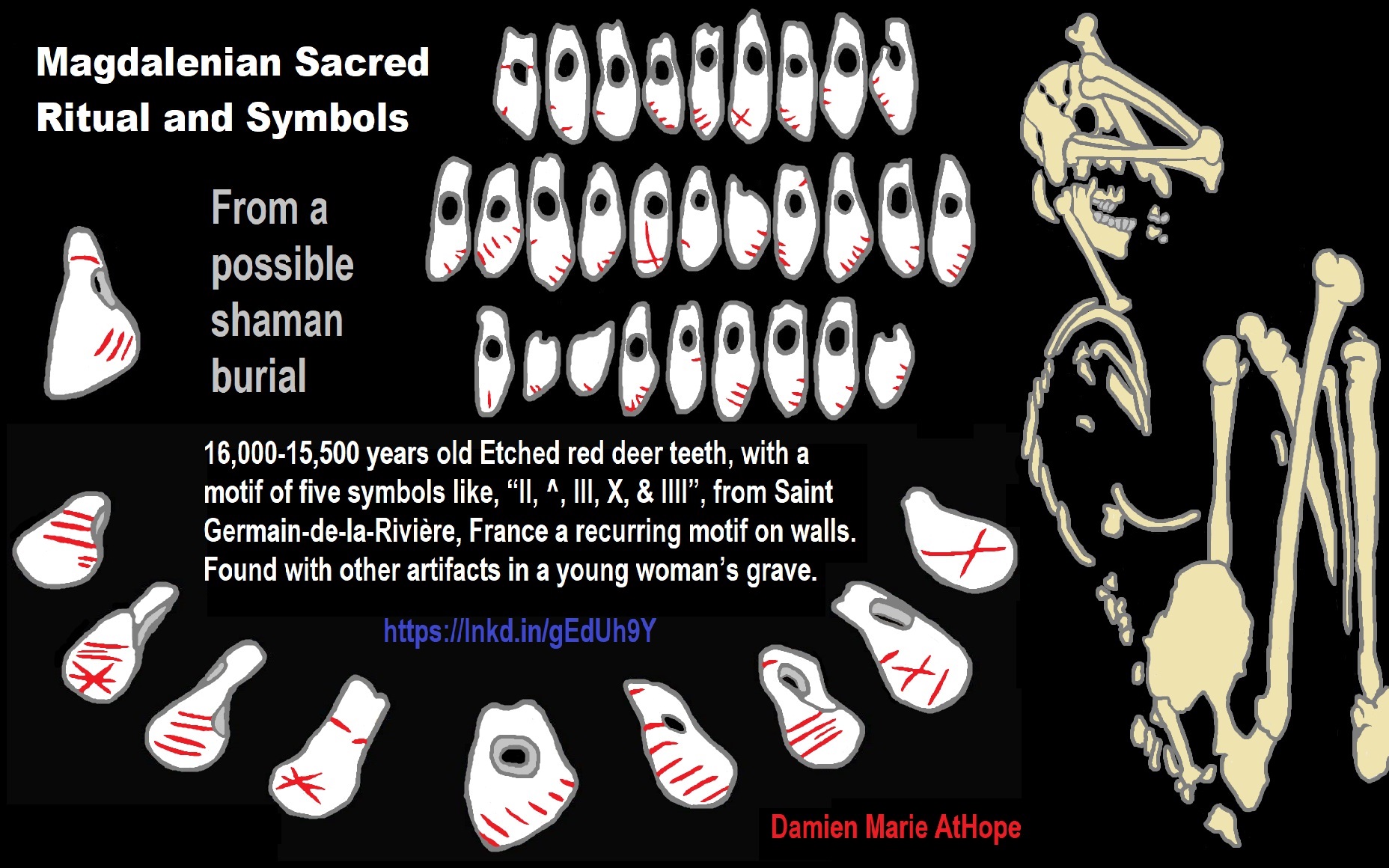

Natufian culture
“Natufian culture is a Late Epipaleolithic archaeological culture of the Neolithic prehistoric Levant in Western Asia, dating to around 15,000 to 11,500 years ago. The culture was unusual in that it supported a sedentary or semi-sedentary population even before the introduction of agriculture. Natufian communities may be the ancestors of the builders of the first Neolithic settlements of the region, which may have been the earliest in the world. Some evidence suggests deliberate cultivation of cereals, specifically rye, by the Natufian culture at Tell Abu Hureyra, the site of the earliest evidence of agriculture in the world. The world’s oldest known evidence of the production of bread-like foodstuff has been found at Shubayqa 1, a 14,400-year-old site in Jordan’s northeastern desert, 4,000 years before the emergence of agriculture in Southwest Asia. In addition, the oldest known evidence of possible beer-brewing, dating to approximately 13,000 years ago, was found in Raqefet Cave on Mount Carmel, although the beer-related residues may simply be a result of a spontaneous fermentation.” ref
“Generally, though, Natufians exploited wild cereals and hunted animals, including gazelles. Archaeogenetic analysis has revealed derivation of later (Neolithic to Bronze Age) Levantines primarily from Natufians, besides substantial admixture from Chalcolithic Anatolians. Dorothy Garrod coined the term Natufian based on her excavations at the Shuqba cave (Wadi an-Natuf) near the town of Shuqba.” ref
“Radiocarbon dating places the Natufian culture at an epoch from the terminal Pleistocene to the very beginning of the Holocene, a time period between 12,500 and 9,500 BCE. The period is commonly split into two subperiods: Early Natufian (12,000–10,800 BCE) and Late Natufian (10,800–9,500 BCE). The Late Natufian most likely occurred in tandem with the Younger Dryas (10,800 to 9,500 BCE). The Levant hosts more than a hundred kinds of cereals, fruits, nuts, and other edible parts of plants, and the flora of the Levant during the Natufian period was not the dry, barren, and thorny landscape of today, but rather woodland.” ref
“The Natufian developed in the same region as the earlier Kebaran culture. It is generally seen as a successor, which evolved out of elements within that preceding culture. There were also other industries in the region, such as the Mushabian culture of the Negev and the Sinai Peninsula, which are sometimes distinguished from the Kebaran or believed to have been involved in the evolution of the Natufian.” ref
“More generally there has been discussion of the similarities of these cultures with those found in coastal North Africa. Graeme Barker notes there are: “similarities in the respective archaeological records of the Natufian culture of the Levant and of contemporary foragers in coastal North Africa across the late Pleistocene and early Holocene boundary”. According to Isabelle De Groote and Louise Humphrey, Natufians practiced the Iberomaurusian and Capsian custom of sometimes extracting their maxillary central incisors (upper front teeth).” ref
“Ofer Bar-Yosef has argued that there are signs of influences coming from North Africa to the Levant, citing the microburin technique and “microlithic forms such as arched backed bladelets and La Mouillah points.” But recent research has shown that the presence of arched backed bladelets, La Mouillah points, and the use of the microburin technique was already apparent in the Nebekian industry of the Eastern Levant. And Maher et al. state that, “Many technological nuances that have often been always highlighted as significant during the Natufian were already present during the Early and Middle EP [Epipalaeolithic] and do not, in most cases, represent a radical departure in knowledge, tradition, or behavior.” ref
“Authors such as Christopher Ehret have built upon the little evidence available to develop scenarios of intensive usage of plants having built up first in North Africa, as a precursor to the development of true farming in the Fertile Crescent, but such suggestions are considered highly speculative until more North African archaeological evidence can be gathered. In fact, Weiss et al. have shown that the earliest known intensive usage of plants was in the Levant 23,000 years ago at the Ohalo II site.” ref
“Anthropologist C. Loring Brace (1993) cross-analysed the craniometric traits of Natufian specimens with those of various ancient and modern groups from the Near East, Africa and Europe. The Late Pleistocene Epipalaeolithic Natufian sample was described as problematic due to its small size (consisting of only three males and one female), as well as the lack of a comparative sample from the Natufians’ putative descendants in the Neolithic Near East. Brace observed that the Natufian fossils lay between those of the Niger–Congo-speaking series included and the other samples (Near East, Europe), which he suggested may point to a Sub-Saharan influence in their constitution. Subsequent ancient DNA analysis of Natufian skeletal remains by Lazaridis et al. (2016) found that the specimens instead were a mix of 50% Basal Eurasian ancestral component (see Archaeogenetics) and 50% West-Eurasian Unknown Hunter Gatherer (UHG) population related to European Western Hunter-Gatherers.” ref
“According to Bar-Yosef and Belfer-Cohen, “It seems that certain preadaptive traits, developed already by the Kebaran and Geometric Kebaran populations within the Mediterranean park forest, played an important role in the emergence of the new socioeconomic system known as the Natufian culture.” Settlements occur mostly in Israel and Palestine. This could be deemed the core zone of the Natufian culture, but Israel is a place that has been excavated more frequently than other places hence the greater number of sites.” ref
“During the years more sites have been found outside the core zone of Israel and Palestine stretching into what now is Syria, Lebanon, Jordan, the Sinai Peninsula, and the Negev desert. The settlements in the Natufian culture were larger and more permanent than in the preceding ones. Some Natufian sites had stone-built architecture; Ain Mallaha is an example of round stone structures. Cave sites are also seen frequently during the Natufian culture. El Wad is a Natufian cave site with occupation in the front part of the cave also called the terrace. Some Natufian sites were located in forest/steppe areas and others near inland mountains. The Natufian settlements appear to be the first to exhibit evidence of food storage; not all Natufian sites have storage facilities, but they have been identified at certain sites.” ref
“The Natufian had a microlithic industry centered on short blades and bladelets. The microburin technique was used. Geometric microliths include lunates, trapezes, and triangles. There are backed blades as well. A special type of retouch (Helwan retouch) is characteristic for the early Natufian. In the late Natufian, the Harif-point, a typical arrowhead made from a regular blade, became common in the Negev. Some scholars use it to define a separate culture, the Harifian. Sickle blades also appear for the first time in the Natufian lithic industry. The characteristic sickle-gloss shows that they were used to cut the silica-rich stems of cereals, indirectly suggesting the existence of incipient agriculture. Shaft straighteners made of ground stone indicate the practice of archery. There are heavy ground-stone bowl mortars as well.” ref
“The Ain Sakhri lovers, a carved stone object held at the British Museum, is the oldest known depiction of a couple having sex. It was found in the Ain Sakhri cave in the Judean desert. Natufian grave goods are typically made of shell, teeth (of red deer), bones, and stone. There are pendants, bracelets, necklaces, earrings, and belt-ornaments as well. The 12,400–12,000 cal BC grave of an apparently significant Natufian female was discovered in a ceremonial pit in the Hilazon Tachtit cave in northern Israel. Media reports referred to this person as a “shaman”. The burial contained the remains of at least three aurochs and 86 tortoises, all of which are thought to have been brought to the site during a funeral feast. The body was surrounded by tortoise shells, the pelvis of a leopard, forearm of a boar, a wingtip of a golden eagle, and skull of a beech marten.” ref
“At Ain Mallaha (in Northern Israel), Anatolian obsidian and shellfish from the Nile valley have been found. The source of malachite beads is still unknown. Epipaleolithic Natufians carried parthenocarpic figs from Africa to the southeastern corner of the Fertile Crescent, c. 10,000 BCE or around 12,000 years ago. There was a rich bone industry, including harpoons and fish hooks. Stone and bone were worked into pendants and other ornaments. There are a few human figurines made of limestone (El-Wad, Ain Mallaha, Ain Sakhri), but the favorite subject of representative art seems to have been animals. Ostrich-shell containers have been found in the Negev.” ref
“The world’s oldest brewery was found, with the residue of 13,000-year-old beer, in a prehistoric cave near Haifa in Israel when researchers were looking for clues into what plant foods the Natufian people were eating. This is 8,000 years earlier than experts previously thought beer was invented. A study published in 2019 shows an advanced knowledge of lime plaster production at a Natufian cemetery in Nahal Ein Gev II site in the Upper Jordan Valley dated to 12,000 years ago. Production of plaster of this quality was previously thought to have been achieved some 2,000 years later. At the Natufian site of Ain Mallaha in Israel, dated to 12,000 BCE, the remains of an elderly human and a four-to-five-month-old puppy were found buried together. At another Natufian site at the cave of Hayonim, humans were found buried with two canids.” ref
“The Natufian people lived by hunting and gathering. The preservation of plant remains is poor because of the soil conditions, but at some sites such as Tell Abu Hureyra substantial amounts of plant remains discovered through flotation have been excavated. However wild cereals like legumes, almonds, acorns, and pistachios have been collected throughout most of the Levant. Animal bones show that mountain and goitered gazelles (Gazella gazella and Gazella subgutturosa) were the main prey. Additionally, deer, aurochs, and wild boar were hunted in the steppe, as well as onagers and caprids (ibex). Waterfowl and freshwater fish formed part of the diet in the Jordan river valley. Animal bones from Salibiya I (12,300 – 10,800 years ago) have been interpreted as evidence for communal hunts with nets, however, the radiocarbon dates are far too old compared to the cultural remains of this settlement, indicating contamination of the samples.” ref
“A pita-like bread has been found from 12,500 BCE or around 14,500 years ago attributed to Natufians. This bread is made of wild cereal seeds and papyrus cousin tubers, ground into flour. According to one theory, it was a sudden change in climate, the Younger Dryas event (c. 10,800 to 9500 BCE), which inspired the development of agriculture. The Younger Dryas was a 1,000-year-long interruption in the higher temperatures prevailing since the Last Glacial Maximum, which produced a sudden drought in the Levant. This would have endangered the wild cereals, which could no longer compete with dryland scrub, but upon which the population had become dependent to sustain a relatively large sedentary population. By artificially clearing scrub and planting seeds obtained from elsewhere, they began to practice agriculture. However, this theory of the origin of agriculture is controversial in the scientific community.” ref
“Ancient DNA analysis has confirmed the genetic relationship between Natufians and other ancient and modern Middle Easterners and the broader West Eurasian meta-population (i.e. Europeans and South-Central Asians). The Natufian population displays also ancestral ties to Paleolithic Taforalt samples, the makers of the Epipaleolithic Iberomaurusian culture of the Maghreb, the Pre-Pottery Neolithic culture of the Levant, the Early Neolithic Ifri N’Amr Ou Moussa culture of the Maghreb, the Late Neolithic Kelif el Boroud culture of the Maghreb, with samples associated with these early cultures all sharing a common genomic component dubbed the “Natufian component”, which diverged from other West Eurasian lineages ~26,000 years ago, and is most closely linked to the Arabian lineage.” ref
“Individuals associated with the Natufian culture have been found to cluster with other West Eurasian populations, but also have substantial higher ancestry that can be traced back to the hypothetical “Basal Eurasian” lineage, which contributed in varying degrees to all West Eurasian lineages, except the Ancient North Eurasians, and peaks among modern Gulf Arabs. The Natufians were already differentiated from other West Eurasian lineages, such as the Anatolian farmers north of the Levant, that contributed to the peopling of Europe in significant amounts, and who had some Western Hunter Gatherer-like (WHG) inferred ancestry, in contrast to Natufians who lacked this component (similar to Neolithic Iranian farmers from the Zagros mountains).” ref
“This might suggest that different strains of West Eurasians contributed to Natufians and Zagros farmers, as both Natufians and Zagros farmers descended from different populations of local hunter gatherers. Contact between Natufians, other Neolithic Levantines, Caucasus Hunter Gatherers (CHG), Anatolian and Iranian farmers is believed to have decreased genetic variability among later populations in the Middle East. Migrations from the Near-East also occurred towards Africa, and the West Eurasian geneflow into the Horn of Africa is best represented by the Levant Neolithic, and may be associated with the spread of Afroasiatic languages. The scientists suggest that the Levantine early farmers may have spread southward into East Africa, bringing along the associated ancestral components.” ref
“According to ancient DNA analyses conducted in 2016 by Iosif Lazaridis et al. and discussed in two articles “The Genetic Structure of the World’s First Farmers” (June 2016) and “Genomic Insights into the Origin of Farming in the Ancient Near East (July 2016) on Natufian skeletal remains in the Raqefet Cave from present-day northern Israel, the remains of 5 Natufians carried the following paternal haplgroups:
Y-DNA
- E1b1b1b2 (xE1b1b1b2a, E1b1b1b2b) – meaning an unspecified branch of E1b1b1b2
- E1b1 (xE1b1a1, E1b1b1b1) – i.e. a branch of E1b1 that is neither E1b1a1 nor E1b1b1b1.
- E1b1b1 – originally classified as CT but further defined as E1b1b1 by Martiniano et al. 2020.” ref
“Daniel Shriner (2018) reported the following maternal haplogroups recovered from three of the same six males at the Raqefet Cave:
Mitochondrial DNA
- J2a2
- J2a2
- N1b
using modern populations as a reference, Shriner et al. also showed indicated Natufians carried 61.2% Arabian, 21.2% Northern African, 10.9% Western Asian, and a small amount of Eastern African ancestry at 6.8% which is associated with the modern Omotic-speaking groups of southern Ethiopia. The study also suggested that this component may be the source of Haplogroup E-M96 (particularly Y-haplogroup E-M215, also known as “E1b1b”) among Natufians.” ref
“Loosedrecht et al. (2018) argues that the Natufians had contributed genetically to the Iberomaurusian peoples of Paleolithic and Mesolithic northwest Africa, with the Iberomaurusians’ other ancestral component being a unique one of sub-Saharan Africa origin (having both West African-like and Hadza-like affinities). The Sub-Saharan African DNA in Taforalt individuals has the closest affinity, most of all, to that of modern West Africans (e.g., Yoruba, or Mende). In addition to having similarity with the remnant of a more basal Sub-Saharan African lineage (e.g., a basal West African lineage shared between Yoruba and Mende peoples), the Sub-Saharan African DNA in the Taforalt individuals of the Iberomaurusian culture may be best represented by modern West Africans.” ref
“Iosif Lazaridis et al. (2018), as summarized by Rosa Fregel (2021), contested the conclusion of Loosdrecht (2018) and argued instead that the Iberomaurusian population of Upper Paleolithic North Africa, represented by the Taforalt sample, can be better modeled as an admixture between a Dzudzuana-like [West-Eurasian] component and an “Ancient North African” component, “that may represent an even earlier split than the Basal Eurasians.” Iosif Lazaridis et al. (2018) also argued that an Iberomaurusian/Taforalt-like population contributed to the genetic composition of Natufians “and not the other way around”, and that this Iberomaurusian/Taforalt lineage also contributed around 13% ancestry to modern West Africans “rather than Taforalt having ancestry from an unknown Sub-Saharan African source”. Fregel (2021) summarized: “More evidence will be needed to determine the specific origin of the North African Upper Paleolithic populations.” Ferreira et al. in 2021 found that ancient Natufians cluster with modern Saudi Arabians and Yemenis.” ref
“Alexander Militarev, Vitaly Shevoroshkin and others have linked the Natufian culture to the proto-Afroasiatic language, which they in turn believe has a Levantine origin. Some scholars, for example Christopher Ehret, Roger Blench and others, contend that the Afroasiatic Urheimat is to be found in North Africa or Northeast Africa, probably in the area of Egypt, the Sahara, Horn of Africa or Sudan. Within this group, Ehret, who like Militarev believes Afroasiatic may already have been in existence in the Natufian period, would associate Natufians only with the Near Eastern Proto-Semitic branch of Afroasiatic.” ref
N1b Haplogroup
“On the origin of Y-chromosome haplogroup N1b: suggest that N1b-P43 mutation may have occurred in the Uralic range rather than in Siberia and much earlier than has been proposed (12.900 years ago instead of 5,200 years ago). Mirabal et al performed high-resolution haplotyping of Y chromosomes from populations in the East European region of Russia and the Uralic mountains and compared them with relevant previously published data. Meanwhile, they did not find it possible to compare the data obtained with South Siberian data set, so we are intending here to make up this deficiency. In addition to the data obtained by Mirabal et al, we have used the data on hg N1b diversity of Northwest Siberian Khants and Mansi and Russian Pomors as well as our published data on N1b diversity in South Siberians (Altaians, Shors, Tuvinians, Tofalars, Sojots, Khakassians, Buryats, Mongolians and Kalmyks) and Central and Northeast Siberians (Yakuts, Evenks, Evens and Koryaks).” ref
“In the latter study, 83 individuals were found as belonging to hg N1b. Median-joining analysis of 53 N1b haplotypes revealed in 168 individuals from Siberia, the Ural mountains and Eastern Europe shows (as in the previous studies) a well-resolved bipartite distribution of haplotypes with separate Siberian and European branches, N1b-A and N1b-E, respectively (Figure 1). Previous studies have shown that the South Siberian subcluster, N1b-A, may have originated first, later giving rise to the derived Northwest Siberian/Uralic/Northeast European subcluster, N1b-E. However, new data presented here do not allow resolving the problem of geographic origin of hg N1b ancestor because the putative ancestral N1b haplotype (indicated by a star in Figure 1) appears to be equally widespread both in South Siberia (among Khakassians, Altaians, Mongolians, Tofalars, Evenks, and Shors) and in Northwest Siberia (among Khants and Mansi). It is noteworthy, however, that the earlier haplotype preceding subcluster N1b-E in the network is the haplotype revealed in Khants, pointing to the possibility of the Northwest Siberian origin of the N1b-E subcluster.” ref
“A possible scenario explaining the phylogeographic pattern of hg N1b is that the subclusters N1b-A and N1b-E might have diverged from a common ancestor anywhere in Siberia approximately 15,000 years ago (with upper bound of divergence as 14,700 years ago). According to STR variation, the expansion of Northwest Siberian/Uralic/Northeast European branch, N1b-E, may have occurred approximately 7,000 years ago, and the expansion of South Siberian branch N1b-A about 5,000 years ago. Divergence time between South Siberian and Northwest Siberian/Uralic N1b-A haplotypes is 4,000 years ago, so this suggests that expansion of N1b-A lineages in Northwest Siberia and Urals (about 3,000 years ago) might have occurred right after their migrations from South Siberia. The age of subcluster N1b-A in Siberian and Uralic populations is 4,200 years ago, with the age prevailing in South Siberia in comparison with Northwest Siberia and Urals (4,800 vs 3,100 years ago, respectively). However, the age of subcluster N1b-E in Northwest Siberian, Uralic, and Northeast European Russian populations is much higher, being equal to 6,800 years ago.” ref
Haplogroup N Asian origin hypothesis
“The hypothesis of Asia as the place of origin of haplogroup N is supported by the following:
- Haplogroup N is found in all parts of the world but has low frequencies in Sub-Saharan Africa. According to a number of studies, the presence of Haplogroup N in Africa is most likely the result of back migration from Eurasia.
- The oldest clades of macrohaplogroup N are found in Asia and Australia.
- It would be paradoxical that haplogroup N had traveled all the distance to Australia or New World yet failed to affect other populations within Africa besides North Africans and Horn Africans.
- The mitochondrial DNA variation in isolated “relict” populations in southeast Asia supports the view that there was only a single dispersal from Africa. The distribution of the earliest branches within haplogroups M, N, and R across Eurasia and Oceania provides additional evidence for a three-founder-mtDNA scenario and a single migration route out of Africa. These findings also highlight the importance of Indian subcontinent in the early genetic history of human settlement and expansion. Therefore, N’s history is similar to M and R which have their most probable origin in South Asia.” ref
“A study (Vai et al. 2019), finds a basal branch of maternal haplogroup N in early Neolithic North African remains from the Libyan site of Takarkori. The authors propose that N most likely split from L3 in the Arabian peninsula and later migrated back to North Africa, with its sister haplogroup M also likely splitting from L3 in the Middle East, but also suggest that N may have possibly diverged in North Africa, and state that more information is necessary to be certain.” ref
“Haplogroup N’s derived clades include the macro-haplogroup R and its descendants, and haplogroups A, I, S, W, X, and Y. Rare unclassified haplogroup N* has been found among fossils belonging to the Cardial and Epicardial culture (Cardium pottery) and the Pre-Pottery Neolithic B. A rare unclassified form of N has been also been reported in modern Algeria.” ref
- “Haplogroup N1’5
- Haplogroup N1 – found in Africa .
- Haplogroup N1b – found in Middle East, Egypt (Gurna), Caucasus and Europe.
- N1a’c’d’e’I
- Haplogroup N1c – Northern Saudi Arabia, Turkey
- N1a’d’e’I
- Haplogroup N1d – India
- N1a’e’I
- Haplogroup N1a – Arabian Peninsula and Northeast Africa. Found also in Central Asia and Southern Siberia. This branch is well attested in ancient people from various cultures of Neolithic Europe, from Hungary to Spain, and among the earliest farmers of Anatolia.” ref
- Haplogroup N1 – found in Africa .
Haplogroup N (M231) is a Y-chromosome DNA
“It is generally considered that N-M231 arose in East Asia approximately 19,400 (±4,800) years ago and populated northern Eurasia after the Last Glacial Maximum. Males carrying the marker apparently moved northwards as the climate warmed in the Holocene, migrating in a counter-clockwise path, to eventually become concentrated in areas as far away as Fennoscandia and the Baltic (Rootsi et al. 2006). The apparent dearth of haplogroup N-M231 amongst Native American peoples indicates that it spread after Beringia was submerged (Chiaroni, Underhill & Cavalli-Sforza 2009), about 11,000 years ago. Haplogroup N has a wide geographic distribution throughout northern Eurasia, and it also has been observed occasionally in other areas, including Central Asia and the Balkans. Among the ancient samples from the Baikal Early Neolithic Kitoi culture, one of the Shamanka II samples (DA250), dated to c. 6,500 years ago.” ref
“N1 (xN1a, N1c) was found in ancient bones of North China Liao civilization
- Niuheliang (Hongshan Culture, 6500–5000 BP) 66.7%(=4/6)
- Halahaigou (Xiaoheyan Culture, 5000–4200 BP) 100.0%(=12/12)
- Dadianzi (Lower Xiajiadian culture, 4200–3600 BP) 60.0%(=3/5).” ref
“N has also been found in many samples of Neolithic human remains exhumed from Liao civilization in northeastern China, and in the circum-Baikal area of southern Siberia. It is suggested that yDNA N, reached southern Siberia from 12,000 to 14,000 years ago. From there it reached southern Europe 8,000-10,000 years ago.” ref
“It has been found with greatest frequency among indigenous peoples of Russia, including Finnic peoples, Mari, Udmurt, Komi, Khanty, Mansi, Nenets, Nganasans, Turkic peoples (Yakuts, Dolgans, Khakasses, Tuvans, Tatars, Chuvashes, etc.), Buryats, Tungusic peoples (Evenks, Evens, Negidals, Nanais, etc.), Yukaghirs, Luoravetlans (Chukchis, Koryaks), and Siberian Eskimos, but certain subclades are very common in Finland, Estonia, Latvia, and Lithuania, and other subclades are found at low frequency in China (Yi, Naxi, Lhoba, Han Chinese, etc.). Especially in ethnic Finnic peoples and Baltic-speaking peoples of northern Europe, the Ob-Ugric-speaking and Northern Samoyed peoples of western Siberia, and Turkic-speaking peoples of Russia (especially Yakuts, but also Altaians, Shors, Khakas, Chuvashes, Tatars, and Bashkirs). Nearly all members of haplogroup N among these populations of northern Eurasia belong to subclades of either haplogroup N-Tat or haplogroup N-P43.” ref
“The mutations that define the subclade N-M46 are M46/Tat and P105. This is the most frequent subclade of N. It probably arose in a Northeast Asian population, because the oldest ancient samples comply with this genetic profile. N has experienced serial bottlenecks in Siberia and secondary expansions in eastern Europe (Rootsi et al. 2006). Haplogroup N-M46 is approximately 14,000 years old.” ref
“In Siberia, haplogroup N-M46 reaches a maximum frequency of approximately 90% among the Yakuts, a Turkic people who live mainly in the Sakha (Yakutia) Republic. However, N-M46 is present with much lower frequency among many of the Yakuts’ neighbors, such as Evenks and Evens. It also has been detected in 5.9% (3/51) of a sample of Hmong Daw from Laos (Cai 2011), 2.4% (2/85) of a sample from Seoul, South Korea (Katoh 2004), and in 1.4% (1/70) of a sample from Tokushima, Japan (Hammer et al. 2005). The haplogroup N-M46 has a low diversity among Yakuts suggestive of a population bottleneck or founder effect (Pakendorf 2002). This was confirmed by a study of ancient DNA which traced the origins of the male Yakut lineages to a small group of horse-riders from the Cis-Baikal area (Crubézy 2010).” ref
“N-Tat has been observed with greatly varying frequency in samples from Sweden. Karlsson et al. (2006) found N-Tat in 44.7% (17/38) of a sample of Saami nomads from Jokkmokk, 19.5% (8/41) of a sample from Västerbotten, 14.5% (8/55) of a sample from Uppsala, 10.0% (4/40) of a sample from Gotland, 9.5% (4/42) of a sample from Värmland, 7.3% (3/41) of a sample from Östergötland/Jönköping, 2.4% (1/41) of a sample from Blekinge/Kristianstad, and 2.2% (1/45) of a sample from Skaraborg. Lappalainen et al. (2008) found N-Tat in 14.4% (23/160) of a sample from Sweden.” ref
“N-M178 was also found in two Na-Dené speaking Tłı̨chǫs in North America. Neolithic samples from Baikal area have yielded plenty of yDNA N specimens, and one sample from Fofonovo, Buryatia, 5000-4000 BCE, or around 7,000-6,000 years ago is among the first Tat samples in the ancient record. Earliest samples of N1a1a-L708 were found in Trans-Baikal (brn008, N1a1a1*-L708; brn003, N1a1a1a1*-M2126) between 8,000 and 6,000 years ago. Downstream samples were found in Yakutia (N4b2, N1a1a1a1a*-Z1979) and Krasnoyarsk Krai (kra001, N1a1a1a1a*-L392), between 5,000 and 4,000 years ago.” ref
“N1a2a-M128 and N1a2b-B523/P43 are estimated to share a most recent common ancestor in N1a2-F1008/L666 approximately 8,600 [95% CI 7,500 <-> 9,800] years ago, 9,200 years ago, or 9,314 [95% CI 7,419 <-> 11,264] years ago. At least three of six tested male specimens from the Early Neolithic (ceramic-using hunter-gatherer of approximately 7200–6200 years ago) layer at the Shamanka archaeological site near the southern end of Lake Baikal have been found to belong to N1a2-L666.” ref

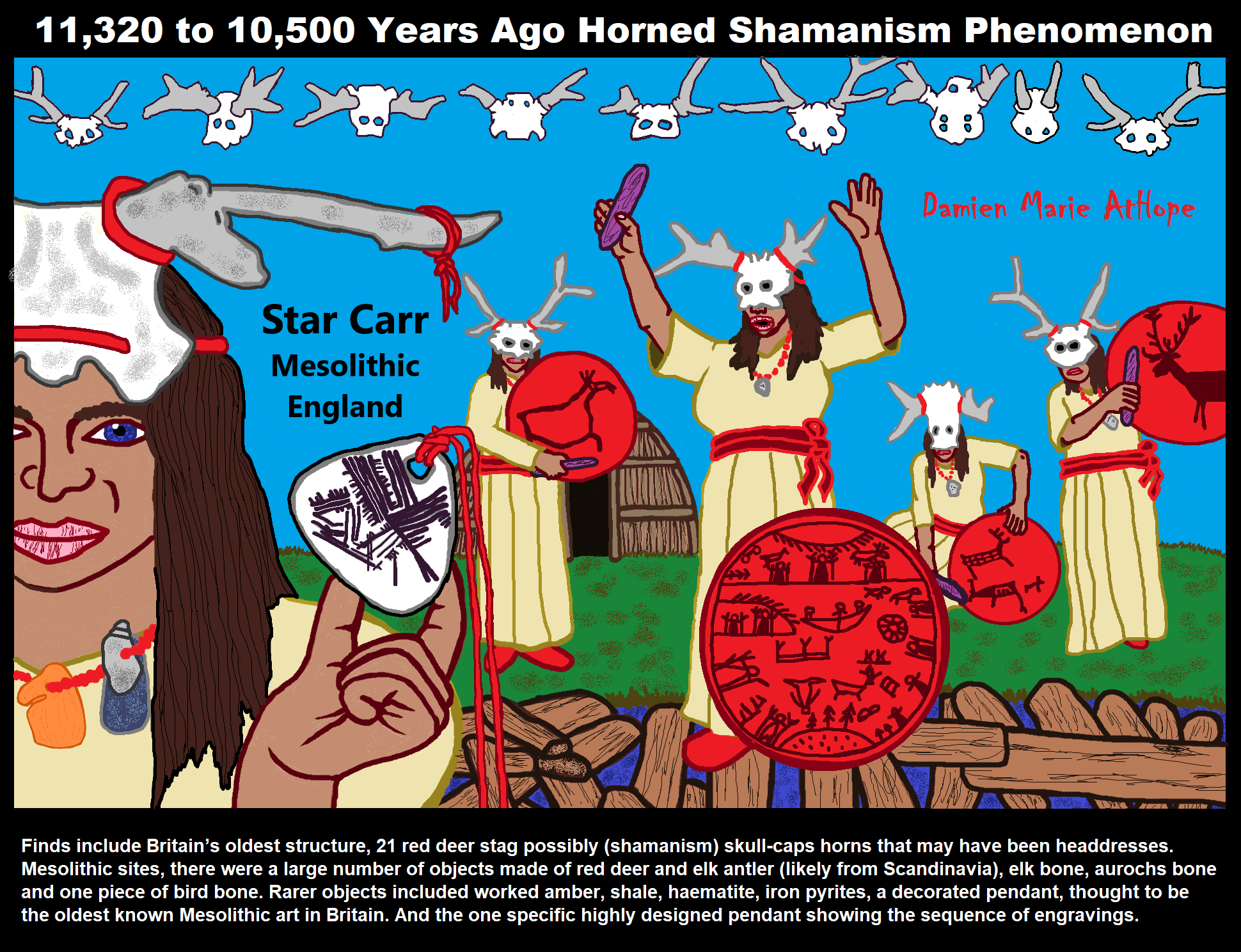
ref, ref, ref, ref, ref, ref, ref, ref, ref, ref, ref
11,320 to 10,500 Years Ago Horned Shamanism Phenomenon
Finds include Britain’s oldest structure, 21 red deer stag possibly (shamanism) skull-caps horns that may have been headdresses. Mesolithic sites, there were a large number of objects made of red deer and elk antler (likely from Scandinavia), elk bone, aurochs bone and one piece of bird bone. Rarer objects included worked amber, shale, haematite, iron pyrites, a decorated pendant, thought to be the oldest known Mesolithic art in Britain. And the one specific highly designed pendant showing the sequence of engravings.” ref, ref
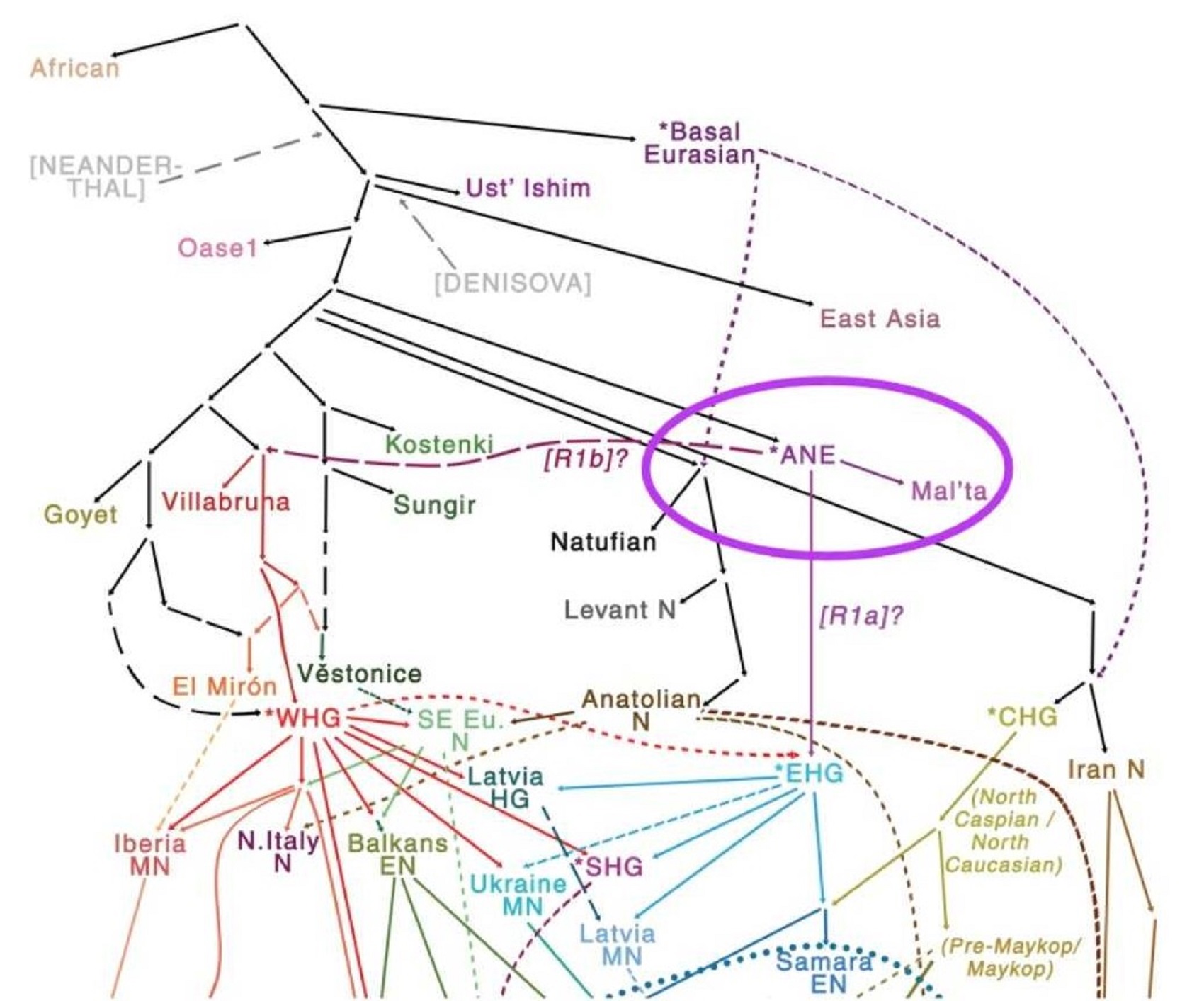

Ancient North Eurasian (ANE)
Ancient Beringian/Ancestral Native American (AB/ANA)
Eastern Hunter-Gatherer (EHG)
Western Hunter-Gatherers (WHG)
Western Steppe Herders (WSH)
Scandinavian Hunter-Gatherer (SHG)
Early European Farmers (EEF)
Jōmon people (Ainu people OF Hokkaido Island)
Neolithic Iranian farmers (Iran_N) (Iran Neolithic)
Haplogroup R possible time of origin about 27,000 years in Central Asia, South Asia, or Siberia:
- Mal’ta–Buret’ culture (24,000-15,000 years ago)
- Afontova Gora culture (21,000-12,000 years ago)
- Trialetian culture (16,000–8000 years ago)
- Samara culture (7,000-6,500 years ago)
- Khvalynsk culture (7,000-6,500 years ago)
- Afanasievo culture (5,300-4,500 years ago)
- Yamna/Yamnaya Culture (5,300-4,500 years ago)
- Andronovo culture (4,000–2,900 years ago) ref
“The ANE lineage is defined by association with the MA-1, or “Mal’ta boy”, remains of 24,000 years ago in central Siberia Mal’ta-Buret’ culture 24,000-15,000 years ago. The Ancient North Eurasians (ANE) samples (Afontova Gora 3, Mal’ta 1, and Yana-RHS) show evidence for minor gene flow from an East Asian-related group (simplified by the Amis, Han, or Tianyuan) but no evidence for ANE-related geneflow into East Asians (Amis, Han, Tianyuan), except the Ainu, of North Japan.” ref
“The ANE lineage is defined by association with the MA-1, or “Mal’ta boy”, remains of 24,000 years ago in central Siberia Mal’ta-Buret’ culture 24,000-15,000 years ago “basal to modern-day Europeans”. Some Ancient North Eurasians also carried East Asian populations, such as Tianyuan Man.” ref
“Bronze-age-steppe Yamnaya and Afanasevo cultures were ANE at around 50% and Eastern Hunter-Gatherer (EHG) at around 75% ANE. Karelia culture: Y-DNA R1a-M417 8,400 years ago, Y-DNA J, 7,200 years ago, and Samara, of Y-haplogroup R1b-P297 7,600 years ago is closely related to ANE from Afontova Gora, 18,000 years ago around the time of blond hair first seen there.” ref
Ancient North Eurasian
“In archaeogenetics, the term Ancient North Eurasian (often abbreviated as ANE) is the name given to an ancestral West Eurasian component that represents descent from the people similar to the Mal’ta–Buret’ culture and populations closely related to them, such as from Afontova Gora and the Yana Rhinoceros Horn Site. Significant ANE ancestry are found in some modern populations, including Europeans and Native Americans.” ref
“The ANE lineage is defined by association with the MA-1, or “Mal’ta boy“, the remains of an individual who lived during the Last Glacial Maximum, 24,000 years ago in central Siberia, Ancient North Eurasians are described as a lineage “which is deeply related to Paleolithic/Mesolithic hunter-gatherers in Europe,” meaning that they diverged from Paleolithic Europeans a long time ago.” ref
“The ANE population has also been described as having been “basal to modern-day Europeans” but not especially related to East Asians, and is suggested to have perhaps originated in Europe or Western Asia or the Eurasian Steppe of Central Asia. However, some samples associated with Ancient North Eurasians also carried ancestry from an ancient East Asian population, such as Tianyuan Man. Sikora et al. (2019) found that the Yana RHS sample (31,600 BP) in Northern Siberia “can be modeled as early West Eurasian with an approximately 22% contribution from early East Asians.” ref
“Populations genetically similar to MA-1 were an important genetic contributor to Native Americans, Europeans, Central Asians, South Asians, and some East Asian groups, in order of significance. Lazaridis et al. (2016:10) note “a cline of ANE ancestry across the east-west extent of Eurasia.” The ancient Bronze-age-steppe Yamnaya and Afanasevo cultures were found to have a noteworthy ANE component at ~50%.” ref
“According to Moreno-Mayar et al. 2018 between 14% and 38% of Native American ancestry may originate from gene flow from the Mal’ta–Buret’ people (ANE). This difference is caused by the penetration of posterior Siberian migrations into the Americas, with the lowest percentages of ANE ancestry found in Eskimos and Alaskan Natives, as these groups are the result of migrations into the Americas roughly 5,000 years ago.” ref
“Estimates for ANE ancestry among first wave Native Americans show higher percentages, such as 42% for those belonging to the Andean region in South America. The other gene flow in Native Americans (the remainder of their ancestry) was of East Asian origin. Gene sequencing of another south-central Siberian people (Afontova Gora-2) dating to approximately 17,000 years ago, revealed similar autosomal genetic signatures to that of Mal’ta boy-1, suggesting that the region was continuously occupied by humans throughout the Last Glacial Maximum.” ref
“The earliest known individual with a genetic mutation associated with blonde hair in modern Europeans is an Ancient North Eurasian female dating to around 16000 BCE from the Afontova Gora 3 site in Siberia. It has been suggested that their mythology may have included a narrative, found in both Indo-European and some Native American fables, in which a dog guards the path to the afterlife.” ref
“Genomic studies also indicate that the ANE component was introduced to Western Europe by people related to the Yamnaya culture, long after the Paleolithic. It is reported in modern-day Europeans (7%–25%), but not of Europeans before the Bronze Age. Additional ANE ancestry is found in European populations through paleolithic interactions with Eastern Hunter-Gatherers, which resulted in populations such as Scandinavian Hunter-Gatherers.” ref
“The Ancient North Eurasians (ANE) split from the ancestors of European peoples somewhere in the Middle East or South-central Asia, and used a northern dispersal route through Central Asia into Northern Asia and Siberia. Genetic analyses show that all ANE samples (Afontova Gora 3, Mal’ta 1, and Yana-RHS) show evidence for minor gene flow from an East Asian-related group (simplified by the Amis, Han, or Tianyuan). In contrast, no evidence for ANE-related geneflow into East Asians (Amis, Han, Tianyuan), except the Ainu, was found.” ref
“Genetic data suggests that the ANE formed during the Terminal Upper-Paleolithic (36+-1,5ka) period from a deeply European-related population, which was once widespread in Northern Eurasia, and from an early East Asian-related group, which migrated northwards into Central Asia and Siberia, merging with this deeply European-related population. These population dynamics and constant northwards geneflow of East Asian-related ancestry would later gave rise to the “Ancestral Native Americans” and Paleosiberians, which replaced the ANE as dominant population of Siberia.” ref
Groups partially derived from the Ancient North Eurasians
“Eastern Hunter-Gatherer (EHG) is a lineage derived predominantly (75%) from ANE. It is represented by two individuals from Karelia, one of Y-haplogroup R1a-M417, dated c. 8.4 kya, the other of Y-haplogroup J, dated c. 7.2 kya; and one individual from Samara, of Y-haplogroup R1b-P297, dated c. 7.6 kya. This lineage is closely related to the ANE sample from Afontova Gora, dated c. 18 kya. After the end of the Last Glacial Maximum, the Western Hunter-Gatherers (WHG) and EHG lineages merged in Eastern Europe, accounting for early presence of ANE-derived ancestry in Mesolithic Europe. Evidence suggests that as Ancient North Eurasians migrated West from Eastern Siberia, they absorbed Western Hunter-Gatherers and other West Eurasian populations as well.” ref
“Caucasian Hunter-Gatherer (CHG) is represented by the Satsurblia individual dated ~13 kya (from the Satsurblia cave in Georgia), and carried 36% ANE-derived admixture. While the rest of their ancestry is derived from the Dzudzuana cave individual dated ~26 kya, which lacked ANE-admixture, Dzudzuana affinity in the Caucasus decreased with the arrival of ANE at ~13 kya Satsurblia.” ref
“Scandinavian Hunter-Gatherer (SHG) is represented by several individuals buried at Motala, Sweden ca. 6000 BC. They were descended from Western Hunter-Gatherers who initially settled Scandinavia from the south, and later populations of EHG who entered Scandinavia from the north through the coast of Norway.” ref
“Iran Neolithic (Iran_N) individuals dated ~8.5 kya carried 50% ANE-derived admixture and 50% Dzudzuana-related admixture, marking them as different from other Near-Eastern and Anatolian Neolithics who didn’t have ANE admixture. Iran Neolithics were later replaced by Iran Chalcolithics, who were a mixture of Iran Neolithic and Near Eastern Levant Neolithic.” ref
“Ancient Beringian/Ancestral Native American are specific archaeogenetic lineages, based on the genome of an infant found at the Upward Sun River site (dubbed USR1), dated to 11,500 years ago. The AB lineage diverged from the Ancestral Native American (ANA) lineage about 20,000 years ago.” ref
“West Siberian Hunter-Gatherer (WSHG) are a specific archaeogenetic lineage, first reported in a genetic study published in Science in September 2019. WSGs were found to be of about 30% EHG ancestry, 50% ANE ancestry, and 20% to 38% East Asian ancestry.” ref
“Western Steppe Herders (WSH) is the name given to a distinct ancestral component that represents descent closely related to the Yamnaya culture of the Pontic–Caspian steppe. This ancestry is often referred to as Yamnaya ancestry or Steppe ancestry.” ref
“Late Upper Paeolithic Lake Baikal – Ust’Kyakhta-3 (UKY) 14,050-13,770 BP were mixture of 30% ANE ancestry and 70% East Asian ancestry.” ref
“Lake Baikal Holocene – Baikal Eneolithic (Baikal_EN) and Baikal Early Bronze Age (Baikal_EBA) derived 6.4% to 20.1% ancestry from ANE, while rest of their ancestry was derived from East Asians. Fofonovo_EN near by Lake Baikal were mixture of 12-17% ANE ancestry and 83-87% East Asian ancestry.” ref
“Hokkaido Jōmon people specifically refers to the Jōmon period population of Hokkaido in northernmost Japan. Though the Jōmon people themselves descended mainly from East Asian lineages, one study found an affinity between Hokkaido Jōmon with the Northern Eurasian Yana sample (an ANE-related group, related to Mal’ta), and suggest as an explanation the possibility of minor Yana gene flow into the Hokkaido Jōmon population (as well as other possibilities). A more recent study by Cooke et al. 2021, confirmed ANE-related geneflow among the Jōmon people, partially ancestral to the Ainu people. ANE ancestry among Jōmon people is estimated at 21%, however, there is a North to South cline within the Japanese archipelago, with the highest amount of ANE ancestry in Hokkaido and Tohoku.” ref
“Haplogroup R1 is very common throughout all of Eurasia except East Asia and Southeast Asia. Its distribution is believed to be associated with the re-settlement of Eurasia following the last glacial maximum. Its main subgroups are R1a and R1b.” ref
“The split of R1a (M420) is computed to ca 25,000 years ago or roughly the last glacial maximum. A large study using 16,244 individuals from over 126 populations from across Eurasia, concluded that there was compelling evidence that “the initial episodes of haplogroup R1a diversification likely occurred in the vicinity of present-day Iran.” ref
“A subclade of haplogroup R1a (especially haplogroup R1a1) is the most common haplogroup in large parts of South Asia, Eastern Europe, Central Asia, Western China, and South Siberia. One subclade of haplogroup R1b (especially R1b1a2), is the most common haplogroup in Western Europe and Bashkortostan which is a federal subject of Russia. It is located between the Volga River and the Ural Mountains.” ref
Haplogroup R possible time of origin about 27,000 years in Central Asia, South Asia, or Siberia:
- Mal’ta–Buret’ culture (24,000-15,000 years ago)
- Afontova Gora culture (21,000-12,000 years ago)
- Trialetian culture (16,000–8000 years ago)
- Samara culture (7,000-6,500 years ago)
- Khvalynsk culture (7,000-6,500 years ago)
- Afanasievo culture (5,300-4,500 years ago)
- Yamna/Yamnaya Culture (5,300-4,500 years ago)
- Andronovo culture (4,000–2,900 years ago) ref
“Sequencing of another south-central Siberian, Afontova Gora-2 dating to approximately 17,000 years ago, revealed similar autosomal genetic signatures as MA-1, suggesting that the region was continuously occupied by humans throughout the Last Glacial Maximum.” ref
“Afontova Gora is a Late Upper Paleolithic Siberian complex of archaeological sites located on the left bank of the Yenisei River near the city of Krasnoyarsk, Russia. Afontova Gora has cultural and genetic links to the people from Mal’ta-Buret’. Afontova Gora II consists of 7 layers. Layer 3 from Afontova Gora II is the most significant: the layer produced the largest amount of cultural artefacts and is the layer where the human fossil remains were discovered. Over 20,000 artefacts were discovered at layer 3: this layer produced over 450 tools and over 250 osseous artefacts (bone, antler, ivory). The human fossil remains of Afontova Gora 2 discovered at Afontova Gora II dated to around 16,930-16,490 years ago. The individual showed close genetic affinities to Mal’ta 1 (Mal’ta boy). Afontova Gora 2 also showed more genetic affinity for the Karitiana people versus Han Chinese. Moreover, human fossil remains consisting of five lower teeth of a young girl (Afontova Gora 3) estimated to be around 14–15 years old is dated to around 16,130-15,749 BC (14,710±60 BP).” ref
“The great majority of European ancestry derives from three distinct sources. 177 First, there is “hunter-gatherer-related” ancestry that is more closely related 178 to Mesolithic hunter-gatherers from Europe than to any other population, and that can be 179 further subdivided into “Eastern” (EHG) and “Western” (WHG) hunter-gatherer-related ancestry. 7 180 Second, there is “NW Anatolian Neolithic-related” ancestry related to the Neolithic farmers of northwest Anatolia and tightly linked to the appearance of agriculture.9,10 181 182 The third source, “steppe-related” ancestry, appears in Western Europe during the Late 183 Neolithic to Bronze Age transition and is ultimately derived from a population related to Yamnaya steppe pastoralists. 184 Steppe-related ancestry itself can be modeled as a mixture of 185 EHG-related ancestry, and ancestry related to Upper Palaeolithic hunter-gatherers of the Caucasus (CHG) and the first farmers of northern Iran.” ref
Map showing Afontova Gora (27) and Mal’ta (29), both circled.
“Afontova Gora is an important site has cultural ties with Mal’ta and Buret’, hundreds of kilometres to the south east. It is on a north flowing river, the Yenisei, Енисея.
The settlement is dated to 20,000 – 18,000 years ago.” ref
Haplogroup R1b (R-M343), is the most frequently occurring paternal lineage in Western Europe, as well as some parts of Russia (e.g. the Bashkir minority) and Central Africa (e.g. Chad and Cameroon). The clade is also present at lower frequencies throughout Eastern Europe, Western Asia, as well as parts of North Africa and Central Asia. R1b also reaches high frequencies in the Americas and Australasia, due largely to immigration from Western Europe. There is an ongoing debate regarding the origins of R1b subclades found at significant levels among some indigenous peoples of the Americas, such as speakers of Algic languages in central Canada. It has been found in Bahrain, Bhutan, Ladakh, Tajikistan, Turkey, and Western China. The point of origin of R1b is thought to lie in Western Eurasia, most likely in Western Asia.” ref
“Within haplogroup R1b, there are extremely large subclades, R-U106 and R-P312. While these subclades are important to the overall picture, their size leads tonoise in the analysis of an R1b origin. It isthe minority branches of R1b (R-L278*, R-V88, R-M73*, R-YSC0000072/PF6426 andR-L23-) that provide the resolution required.(While the data from R-V88 supports anIberian origin, and along the Western Atlantic coast, with R-L278 origins south of the Pyrenees. And the Pyrenees, Spanish Pirineos, French Pyrénées, Catalan Pireneus, mountain chain of southwestern Europe that consists of flat-topped massifs and folded linear ranges. It stretches from the shores of the Mediterranean Sea on the east to the Bay of Biscay on the Atlantic Oceanon the west. The Pyrenees form a high wall between France and Spain that has played a significant role in the history of both countries and of Europe as a whole.” ref, ref
“R1b-V88 originated in Europe about 12 000 years ago and crossed to North Africa by about 8000 years ago; it may formerly have been common in southern Europe, where it has since been replaced by waves of other haplogroups, leaving remnant subclades almost excusively in Sardinia. It first radiated within Africa likely between 7 and 8 000 years ago – at the same time as trans-Saharan expansions within the unrelated haplogroups E-M2 and A-M13 – possibly due to population growth allowed by humid conditions and the adoption of livestock herding in the Sahara. R1b-V1589, the main subclade within R1b-V88, underwent a further expansion around 5500 years ago, likely in the Lake Chad Basin region, from which some lines recrossed the Sahara to North Africa.” ref
“The majority of modern R1b and R1a would have expanded from the Caspian Sea along with the Indo-European languages. And genetic studies support the Kurgan hypothesis regarding the Proto-Indo-European homeland. According to those studies, haplogroups R1b and R1a, now the most common in Europe (R1a is also common in South Asia) would have expanded from the West Eurasian Steppe, along with the Indo-European languages; they also detected an autosomal component present in modern Europeans which was not present in Neolithic Europeans, which would have been introduced with paternal lineages R1b and R1a, as well as Indo-European languages.” ref
The oldest human remains found to carry R1b include:
- Villabruna 1 (individual I9030), found in an Epigravettian culture setting in the Cismon valley (modern Veneto, Italy), who lived circa 14,000 years BP and belonged to R1b-L754,
- numerous individuals from the Mesolithic Iron Gates culture of the central Danube (modern Romania and Serbia), dating from 10,000 to 8,500 BP – most of them falling into R1b-L754;
- two individuals, dating from circa 7,800–6,800 BP, found at the Zvejnieki burial ground, belonging to the Narva culture of the Baltic neolithic, both determined to belong to the R1b-P297 subclade, and;
- the “Samara hunter-gatherer” (I0124/SVP44), who lived approximately 7,500 BP in the Volga River area and carried R1b-L278. ref
“This burial is from the early Mesolithic stage which is proto-Lepenski Vir. Whereas, the general Lepenski Vir, located in Serbia, Mesolithic Iron Gates culture of the Balkans. Around 11,500/9,200–7,900 years ago.” ref,ref, ref
“A particularly important hunter-gatherer population that we report is from the Iron Gates region that straddles the border of present-day Romania and Serbia. This population (Iron_Gates_HG) is represented in our study by 40 individuals from five sites. Modeling Iron Gates hunter-gatherers as a mixture of WHG and EHG (Supplementary Table 3) shows that they are intermediate between WHG (~85%) and EHG (~15%). However, this qpAdm model 244 does not fit well (p=0.0003, Supplementary table 3) and the Iron Gates hunter-gatherers carry mitochondrial haplogroup K1 (7/40) as well as other subclades of haplogroups U (32/40) and H (1/40). This contrasts with WHG, EHG and Scandinavian hunter-gatherers who almost all carry haplogroups U5 or U2. One interpretation is that the Iron Gates hunter-gatherers have ancestry that is not present in either WHG or EHG. Possible scenarios include genetic contact between the ancestors of the Iron Gates population and Anatolia, or that the Iron Gates population is related to the source population from which the WHG split during a reexpansion into Europe from the Southeast after the Last Glacial Maximum.” ref
“A notable finding from the Iron Gates concerns the four individuals from the site of Lepenski Vir, two of whom (I4665 & I5405, 8,200-7,600 years ago), have entirely NW Anatolian Neolithicrelated ancestry. Strontium and Nitrogen isotope data indicate that both these individuals were migrants from outside the Iron Gates, and ate a primarily terrestrial diet. A third individual (I4666, 8,070 years ago) has a mixture of NW Anatolian Neolithic-related and hunter-gatherer-related ancestry and ate a primarily aquatic diet, while a fourth, probably earlier, individual (I5407) had entirely hunter-gatherer-related ancestry. We also identify one individual from Padina (I5232), dated to 7,950 years ago that had a mixture of NW Anatolian Neolithic-related and hunter-gatherer-related ancestry. These results demonstrate that the Iron Gates was a region of interaction between groups distinct in both ancestry and subsistence strategy.” ref
“R-M173, also known as R1, has been common throughout Europe and South Asia since pre-history. It is the second most common haplogroup in Indigenous peoples of the Americasfollowing haplogroup Q-M242, especially in the Algonquian peoples of Canada and the United States. There is a great similarity of many R-M173 subclades found in North America to those found in Siberia, suggesting prehistoric immigration from Asia and/or Beringia.” ref
Picture links: ref, ref, ref, ref
“The Dyuktai culture was defined by Yuri Mochanov in 1967, following the Dyuktai Cave discovery on the Aldan River, Yakutia. In the Pleistocene deposits, at a 2-m depth, lithic tools and Pleistocene animal bones were exposed, radiocarbon dated to 14,000-12,000 BP. Further research in Yakutia resulted in the discovery of other Dyuktai culture sites on the Aldan, Olenyok, and Indigirka rivers. The sites are located along the banks and at the estuary capes of smaller tributaries. The Dyuktai culture tool assemblage is represented by choppers, wedge-shaped cores, microblades, end scrapers on blades, oval bifaces, points, as well as angle, dihedral, and transversal burins on flakes and blades. The emergence of the Dyuktai culture defines the time when the microblade technique first appeared in northeast Asia. Judging by bones found in the same layers with tools, the Dyuktai people used to hunt mammoth, wooly rhino, bison, horse, reindeer, moose, and snow ram. Fishing tools have not been excavated, although a few fish bones were found in the Dyuktai cave Pleistocene cultural levels.” ref
“The cultural materials at the sites were concentrated around small hearths with no special lining. The question of whether the bow and arrow existed in the Dyuktai culture has so far been open, because just a few stone points small enough to be used on arrows were found. Yu. Mochanov associates the Dyuktai culture emergence in Yakutia with the bifacial Paleolithic cultures coming from the southern Urals, Kazakhstan, Mongolia, and northern China. From Dyuktai materials of some stratified sites, Yu. Mochanov dated the Dyuktai culture to 35,000-11,500 BP. This date was broadly discussed by scholars within the debates on the question of the microblade industry emergence in Siberia and aroused some serious objections. The dates exceeding 25,000 BP are deemed to be erroneous, so the microblade technique appeared in Siberia no earlier than 25,000 BP. A. Derevyanko supposes that the origin of the Dyuktai culture can be found on the Selemja River, tributary of the Amur, in the Selemja culture, by 25000-11000 BP.” ref
“The Dyuktai tradition was spread over all of northeast Asia. In Kamchatka, it has been represented by the materials of the Late Ushki Upper Paleolithic culture in levels V and VI of the Ushki I-V sites. It determines the latest period in the Dyuktai tradition development, 10,800-8800 BP. Its general outlook differs significantly from that of the Dyuktai culture in Yakutia. The sites are located on the bank of a small lake in the valley of Kamchatka’s largest river in its medium flow. The exposed dwellings are represented by surface, teepee-type, 8-16 m2, and semi-subterranean with the corridor, 10-44 m2, with circular stone hearths in the center. Several inhabited horizons exposed on the site and numerous stone tools, burials, and caches found in the dwellings testify to its long-term use, perhaps even as a winter camp.” ref
“Judging by tooth remains in the cultural level, its people hunted for reindeer, bison, and moose. Burned salmon and other fish bones found in the hearths as well as the sites location at the spawning lake confirm the existence of fishing. The tool assemblage of the Ushki culture consisted of small- and medium-sized bifacial projectile points; end scrapers; angle, transversal, and dihedral burins; semilunar and oval bifaces; end scrapers on blades and flakes; microblades and wedge-shaped cores; and grooved pumice shaft straighteners. Ornaments were represented by oval pendants. In the dwellings, a pair and a group (as many as five human bodies) children’s burial were found. The corpses in both graves were in a flexed position and covered with ochre. The bottom of the pair-burial grave was covered with lemming incisors; the group burial was covered with a large animal’s scapula. The rich burial inventory included arrow and spear points, leaf-shaped knives, grinding plates, grooved pumice shaft.” ref
“To help with geography, the following google map shows the following locations: A=the Altai Republic, in Russia, B=Mal’ta, the location of the 24,000 year old skeletal remains and C=Lake Baikal, the region from where the Native American population originated in Asia.” ref
The genome from Ust’-Ishim (Main Semi-Related Ancestor DNA Branch)
“The Ust’-Ishim DNA was from northern Siberia that dates to 45,000 years ago, from the bank of the Irtysh River, which is in the Siberian plain near Omsk. Its source lies in the Mongolian Altai in Dzungaria (the northern part of Xinjiang, China) close to the border with Mongolia. The Ob-Irtysh system forms a major drainage basin in Asia, encompassing most of Western Siberia and the Altai Mountains.” ref, ref
“Ust’-Ishim is more similar to genomes of non-Africans than it is to sub-Saharan African genomes. Ust’-Ishim is not more like the Mal’ta genome than it is like any other genomes of Asians or Native Americans. It is not like any living population of Asians or Native Americans more than any other.” ref
Link to Enlarge Population history inferences
“The MA-1 sequence compare to that of another 40,000-year-old individual from Tianyuan Cave, China whose genome has been partially sequenced. This Chinese individual has been shown to be ancestral to both modern-day Asians and Native Americans. This comparison was particularly useful, because it showed that MA-1 is not closely related to the Tianyuan Cave individual, and is more closely related to Native Americans. This means that MA-1’s line and Tianyuan Cave’s line had not yet met and admixed into the population that would become the Native Americans. That occurred sometime later than 24,000 years ago and probably before crossing Beringia into North America sometime between about 18,000 and 20,000 years ago.” ref
“A basal Ancestral Native American (ANA) lineage. This lineage formed by admixture of early East Asian and Ancient North Eurasian lineages prior to the Last Glacial Maximum, ca. 36–25 kya. Basal ANA diverged into an “Ancient Beringian” (AB) lineage at ca. 20 kya. The non-AB lineage further diverged into “Northern Native American” (NNA) and “Southern Native American” (SNA) lineages between about 17.5 and 14.6 kya. Most pre-Columbian lineages are derived from NNA and SNA, except for the American Arctic, where there is evidence of later (after 10kya) admixture from Paleo-Siberian lineages.” ref
“DNA of a 12,500+-year-old infant from Montana was sequenced from a skeleton referred to as Anzick-1, found in close association with several Clovis artifacts. Comparisons showed strong affinities with DNA from Siberian sites, and virtually ruled out that particular individual had any close affinity with European sources (the “Solutrean hypothesis“). The DNA also showed strong affinities with all existing Amerindian populations, which indicated that all of them derive from an ancient population that lived in or near Siberia, the Upper Palaeolithic Mal’ta population.” ref
“Native Americans descend of at least three main migrant waves from East Asia. Most of it is traced back to a single ancestral population, called ‘First Americans’. However, those who speak Inuit languages from the Arctic inherited almost half of their ancestry from a second East Asian migrant wave. And those who speak Na-dene, on the other hand, inherited a tenth of their ancestry from a third migrant wave. The initial settling of the Americas was followed by a rapid expansion southwards, by the coast, with little gene flow later, especially in South America. One exception to this are the Chibcha speakers, whose ancestry comes from both North and South America.” ref
“Linguistic studies have backed up genetic studies, with ancient patterns having been found between the languages spoken in Siberia and those spoken in the Americas. Two 2015 autosomal DNA genetic studies confirmed the Siberian origins of the Natives of the Americas. However an ancient signal of shared ancestry with Australasians (Natives of Australia, Melanesia and the Andaman Islands) was detected among the Natives of the Amazon region. The migration coming out of Siberia would have happened 23,000 years ago.” ref
“R1 is very common throughout all of Eurasia except East Asia and Southeast Asia. R1 (M173) is found predominantly in North American groups like the Ojibwe (50-79%), Seminole (50%), Sioux(50%), Cherokee (47%), Dogrib (40%) and Tohono O’odham (Papago) (38%). Skeletal remain of a south-central Siberian child carrying R* y-dna (Mal’ta boy-1) “is basal to modern-day western Eurasians and genetically closely related to modern-day Amerindians, with no close affinity to east Asians. This suggests that populations related to contemporary western Eurasians had a more north-easterly distribution 24,000 years ago than commonly thought.” Sequencing of another south-central Siberian (Afontova Gora-2) revealed that “western Eurasian genetic signatures in modern-day Amerindians derive not only from post-Columbian admixture, as commonly thought, but also from a mixed ancestry of the First Americans.” It is further theorized if “Mal’ta might be a missing link, a representative of the Asian population that admixed both into Europeans and Native Americans.” ref
Swan Point 15,000 – 14,200 years ago
“It is significant that Swan Point is not only the oldest site (radiocarbon dated between circa 15,000 and 14,200 cal. BP), but also contains microblade technology throughout the multiple components. This makes the site comparable with the other Tanana Valley sites, yet distinctive- a position that may be advantageous for testing theories on site formation, group mobility, and landscape exploitation patterns.” ref
“Microblade technology, exemplified by the Dyuktai culture of Siberia, has been seen as linked to early cultures in Alaska, e.g., Denali complex and American Paleoarctic tradition. Clovis-like characteristics (e.g., blades, bifaces, scrapers and gravers) found in the Nenana complex, have been argued as evidence for a regional presence of the Paleoindian tradition. Swan Point appears to have aspects of both of these complexes at the earliest levels, as well as multiple occupation levels that range from the terminal Pleistocene to the late Holocene. Swan Point has the potential to provide information on past life ways that would be of interest locally, regionally, and hemispherically.” ref
“Evidence of charcoal that has been radiocarbon dated to approximately 14,000 years ago. The charcoal dating makes this the oldest known site in the Tanana River Valley. The mammoth artifacts found in the Latest Pleistocene zone date to approximately 14,000 cal years ago. With no other mammoth remains found beyond tusk ivory, it is assumed that the people who lived on the site scavenged the ivory rather than hunting the mammoth themselves.” ref
Terminal Pleistocene
“This is the oldest cultural level from approximately 11,660 cal – 10,000 cal years ago. Artifactsfound at this level include worked mammoth tusk fragments, microblades, microblade core preparation flakes, blades, dihedral burins, red ochre, pebble hammers, and quartz hammer tools and choppers. The microblades found at this zone are significant as they are the oldest securely dated microblades in eastern Beringia.” ref
Latest Pleistocene
“A variety of bifacial points were found at this level, which dates to approximately 10,230 ± 80 cal years ago, including lanceolate points with convex to straight bases, along with graver spurs, quartz pebble choppers and hammers.The mammoth artifacts found in the Latest Pleistocene zone date to approximately 14,000 cal years ago. With no other mammoth remains found beyond tusk ivory, it is assumed that the people who lived on the site scavenged the ivory rather than hunting the mammoth themselves.” ref
Migration map of Y-haplogroup R1b from the Paleolithic to the end of the Bronze Age (c. 1000BCE) ref
Paleolithic mammoth hunters
“Haplogroup R* originated in North Asia just before the Last Glacial Maximum (26,500-19,000 years ago). This haplogroup has been identified in the remains of a 24,000 year-old boy from the Altai region, in south-central Siberia. This individual belonged to a tribe of mammoth hunters that may have roamed across Siberia and parts of Europe during the Paleolithic. Autosomally this Paleolithic population appears to have contributed mostly to the ancestry of modern Europeans and South Asians, the two regions where haplogroup R also happens to be the most common nowadays (R1b in Western Europe, R1a in Eastern Europe, Central and South Asia, and R2 in South Asia).” ref
“The oldest forms of R1b (M343, P25, L389) are found dispersed at very low frequencies from Western Europe to India, a vast region where could have roamed the nomadic R1b hunter-gatherers during the Ice Age. The three main branches of R1b1 (R1b1a, R1b1b, R1b1c) all seem to have stemmed from the Middle East. The southern branch, R1b1c (V88), is found mostly in the Levant and Africa. The northern branch, R1b1a (P297), seems to have originated around the Caucasus, eastern Anatolia or northern Mesopotamia, then to have crossed over the Caucasus, from where they would have invaded Europe and Central Asia. R1b1b (M335) has only been found in Anatolia.” ref
Neolithic cattle herders
“It has been hypothetised that R1b people (perhaps alongside neighbouring J2 tribes) were the first to domesticate cattle in northern Mesopotamia some 10,500 years ago. R1b tribes descended from mammoth hunters, and when mammoths went extinct, they started hunting other large game such as bisons and aurochs. With the increase of the human population in the Fertile Crescent from the beginning of the Neolithic (starting 12,000 years ago), selective hunting and culling of herds started replacing indiscriminate killing of wild animals. The increased involvement of humans in the life of aurochs, wild boars and goats led to their progressive taming. Cattle herders probably maintained a nomadic or semi-nomadic existence, while other people in the Fertile Crescent (presumably represented by haplogroups E1b1b, G and T) settled down to cultivate the land or keep smaller domesticates.” ref
“The analysis of bovine DNA has revealed that all the taurine cattle (Bos taurus) alive today descend from a population of only 80 aurochs. The earliest evidence of cattle domestication dates from circa 8,500 BCE in the Pre-Pottery Neolithic cultures in the Taurus Mountains. The two oldest archaeological sites showing signs of cattle domestication are the villages of Çayönü Tepesi in southeastern Turkey and Dja’de el-Mughara in northern Iraq, two sites only 250 km away from each others. This is presumably the area from which R1b lineages started expanding – or in other words the “original homeland” of R1b.” ref
“The early R1b cattle herders would have split in at least three groups. One branch (M335) remained in Anatolia, but judging from its extreme rarity today wasn’t very successful, perhaps due to the heavy competition with other Neolithic populations in Anatolia, or to the scarcity of pastures in this mountainous environment. A second branch migrated south to the Levant, where it became the V88 branch. Some of them searched for new lands south in Africa, first in Egypt, then colonising most of northern Africa, from the Mediterranean coast to the Sahel. The third branch (P297), crossed the Caucasus into the vast Pontic-Caspian Steppe, which provided ideal grazing grounds for cattle. They split into two factions: R1b1a1 (M73), which went east along the Caspian Sea to Central Asia, and R1b1a2 (M269), which at first remained in the North Caucasus and the Pontic Steppe between the Dnieper and the Volga. It is not yet clear whether M73 actually migrated across the Caucasus and reached Central Asia via Kazakhstan, or if it went south through Iran and Turkmenistan. In any case, M73 would be a pre-Indo-European branch of R1b, just like V88 and M335.” ref
“R1b-M269 (the most common form in Europe) is closely associated with the diffusion of Indo-European languages, as attested by its presence in all regions of the world where Indo-European languages were spoken in ancient times, from the Atlantic coast of Europe to the Indian subcontinent, which comprised almost all Europe (except Finland, Sardinia and Bosnia-Herzegovina), Anatolia, Armenia, European Russia, southern Siberia, many pockets around Central Asia (notably in Xinjiang, Turkmenistan, Tajikistan and Afghanistan), without forgetting Iran, Pakistan, northern India and Nepal. The history of R1b and R1a are intricately connected to each others.” ref
The Levantine & African branch of R1b (V88)
“Like its northern counterpart (R1b-M269), R1b-V88 is associated with the domestication of cattle in northern Mesopotamia. Both branches of R1b probably split soon after cattle were domesticated, approximately 10,500 years ago (8,500 BCE). R1b-V88 migrated south towards the Levant and Egypt. The migration of R1b people can be followed archeologically through the presence of domesticated cattle, which appear in central Syria around 8,000-7,500 BCE (late Mureybet period), then in the Southern Levant and Egypt around 7,000-6,500 BCE (e.g. at Nabta Playa and Bir Kiseiba). Cattle herders subsequently spread across most of northern and eastern Africa. The Sahara desert would have been more humid during the Neolithic Subpluvial period (c. 7250-3250 BCE), and would have been a vast savannah full of grass, an ideal environment for cattle herding.” ref
“Evidence of cow herding during the Neolithic has shown up at Uan Muhuggiag in central Libya around 5500 BCE, at the Capeletti Cave in northern Algeria around 4500 BCE. But the most compelling evidence that R1b people related to modern Europeans once roamed the Sahara is to be found at Tassili n’Ajjer in southern Algeria, a site famous pyroglyphs (rock art) dating from the Neolithic era. Some painting dating from around 3000 BCE depict fair-skinned and blond or auburn haired women riding on cows. The oldest known R1b-V88 sample in Europe is a 6,200 year-old farmer/herder from Catalonia. Autosomally this individual was a typical Near Eastern farmer, possessing just a little bit of Mesolithic West European admixture.” ref
“After reaching the Maghreb, R1b-V88 cattle herders could have crossed the Strait of Gibraltar to Iberia, probably accompanied by G2 farmers, J1 and T1a goat herders. These North African Neolithic farmers/herders could have been the ones who established the Almagra Pottery culturein Andalusia in the 6th millennium BCE. R1b-V88 would have crossed the Sahara between 9,200 and 5,600 years ago, and is most probably associated with the diffusion of Chadic languages, a branch of the Afroasiatic languages. V88 would have migrated from Egypt to Sudan, then expanded along the Sahel until northern Cameroon and Nigeria. However, R1b-V88 is not only present among Chadic speakers, but also among Senegambian speakers (Fula-Hausa) and Semitic speakers (Berbers, Arabs).” ref
“R1b-V88 is found among the native populations of Rwanda, South Africa, Namibia, Angola, Congo, Gabon, Equatorial Guinea, Ivory Coast, Guinea-Bissau. The wide distribution of V88 in all parts of Africa, its incidence among herding tribes, and the coalescence age of the haplogroup all support a Neolithic dispersal. In any case, a later migration out of Egypt would be improbable since it would have brought haplogroups that came to Egypt during the Bronze Age, such as J1, J2, R1a or R1b-L23.” ref
The maternal lineages associated with the spread of R1b-V88 in Africa are mtDNA haplogroups J1b, U5 and V, and perhaps also U3 and some H subclades (=> see Retracing the mtDNA haplogroups of the original R1b people). ref
The North Caucasus and the Pontic-Caspian steppe : the Indo-European link
“Modern linguists have placed the Proto-Indo-European homeland in the Pontic-Caspian Steppe, a distinct geographic and archeological region extending from the Danube estuary to the Ural mountains to the east and North Caucasus to the south. The Neolithic, Eneolithic and early Bronze Age cultures in Pontic-Caspian steppe has been called the Kurgan culture (4200-2200 BCE) by Marija Gimbutas, due to the lasting practice of burying the deads under mounds (“kurgan”) among the succession of cultures in that region. It is now known that kurgan-type burials only date from the 4th millenium BCE and almost certainly originated south of the Caucasus. The genetic diversity of R1b being greater around eastern Anatolia, it is hard to deny that R1b evolved there before entering the steppe world.” ref
“Horse domesticated around 4600 BCE in the Caspian Steppe, perhaps somewhere around the Don or the lower Volga, and soon became a defining element of steppe culture. Nevertheless it is unlikely that R1b was already present in the eastern steppes at the time, so the domestication of the horse should be attributed to the indigenous R1a people, or tribes belonging to the older R1b-P297 branch, which settled in eastern Europe during the Late Paleolithic or Mesolithic period. Samples from Mesolithic Samara (Haak 2015) and Latvia (Jones 2017) all belonged to R1b-P297. Autosomally these Mesolithic R1a and R1b individuals were nearly pure Mesolithic East European, sometimes with a bit of Siberian admixture, but lacked the additional Caucasian admixture found in the Chalcolithic Afanasevo, Yamna and Corded Ware samples.” ref
It is not yet entirely clear when R1b-M269 crossed over from the South Caucasus to the Pontic-Caspian steppe. This might have happened with the appearance of the Dnieper-Donets culture(c. 5100-4300 BCE). This was the first truly Neolithic society in the Pontic-Caspian Steppe. Domesticated animals (cattle, sheep and goats) were herded throughout the steppes and funeral rituals were elaborate. Sheep wool would play an important role in Indo-European society, notably in the Celtic and Germanic (R1b branches of the Indo-Europeans) clothing traditions up to this day. However, many elements indicate a continuity in the Dnieper-Donets culture with the previous Mesolithic hunter-gatherers, and at the same time an influence from the Balkans and Carpathians, with regular imports of pottery and copper objects. It is therefore more likely that Dnieper-Donets marked the transition of indigenous R1a and/or I2a1b people to early agriculture, perhaps with an influx of Near Eastern farmers from ‘Old Europe’.
“Over 30 DNA samples from Neolithic Ukraine (5500-4800 BCE). They belonged to Y-haplogroups I, I2a2, R1a, R1b1a (L754) and one R1b1a2 (L388). None of them belonged to R1b-M269 or R1b-L23 clades, which dominated during the Yamna period. Mitochondrial lineages were also exclusively of Mesolithic European origin (U4a, U4b, U4d, U5a1, U5a2, U5b2, as well as one J2b1 and one U2e1). None of those maternal lineages include typical Indo-European haplogroups, like H2a1, H6, H8, H15, I1a1, J1b1a, W3, W4 or W5 that would later show up in the Yamna, Corded Ware and Unetice cultures. Indeed, autosomally genomes from Neolithic Ukraine were purely Mesolithic European (about 90% EHG and 10% WHG) and completely lacked the Caucasian (CHG) admxiture later found in Yamna and subsequent Indo-European cultures during the Bronze Age.” ref
“The first clearly Proto-Indo-European cultures were the Khvalynsk (5200-4500 BCE) and Sredny Stog (4600-3900 BCE) cultures in the Pontic-Caspian Steppe. This is when small kurgan burials begin to appear, with the distinctive posturing of the dead on the back with knees raised and oriented toward the northeast, which would be found in later steppe cultures as well. There is evidence of population blending from the variety of skull shapes. Towards the end of the 5th millennium, an elite starts to develop with cattle, horses and copper used as status symbols. It is at the turn of the Khvalynsk and Sredny Stog periods that R1b-M269’s main subclade, L23, is thought to have appeared, around 4,500 BCE. 99% of Indo-European R1b descends from this L23 clade. The other branch descended from M269 is PF7562, which is found mostly in the Balkans, Turkey and Armenia today, and may represent an early Steppe migration to the Balkans dating from the Sredny Stog period.” ref
“Another migration across the Caucasus happened shortly before 3700 BCE, when the Maykop culture, the world’s first Bronze Age society, suddenly materialised in the north-west Caucasus, apparently out of nowhere. The origins of Maykop are still uncertain, but archeologists have linked it to contemporary Chalcolithic cultures in Assyria and western Iran. Archeology also shows a clear diffusion of bronze working and kurgan-type burials from the Maykop culture to the Pontic Steppe, where the Yamna culture developed soon afterwards (from 3500 BCE). Kurgan (a.k.a. tumulus) burials would become a dominant feature of ancient Indo-European societies and were widely used by the Celts, Romans, Germanic tribes, and Scythians, among others.” ref
“The Yamna period (3500-2500 BCE) is the most important one in the creation of Indo-European culture and society. Middle Eastern R1b-M269 people had been living and blending to some extent with the local R1a foragers and herders for over a millennium, perhaps even two or three. The close cultural contact and interactions between R1a and R1b people all over the Pontic-Caspian Steppe resulted in the creation of a common vernacular, a new lingua franca, which linguists have called Proto-Indo-European (PIE). It is pointless to try to assign another region of origin to the PIE language. Linguistic similarities exist between PIE and Caucasian and Hurrian languages in the Middle East on the one hand, and Uralic languages in the Volga-Ural region on the other hand, which makes the Pontic Steppe the perfect intermediary region.” ref
“During the Yamna period cattle and sheep herders adopted wagons to transport their food and tents, which allowed them to move deeper into the steppe, giving rise to a new mobile lifestyle that would eventually lead to the great Indo-European migrations. This type of mass migration in which whole tribes moved with the help of wagons was still common in Gaul at the time of Julius Caesar, and among Germanic peoples in the late Antiquity. The Yamna horizon was not a single, unified culture. In the south, along the northern shores of the Black Sea coast until the the north-west Caucasus, was a region of open steppe, expanding eastward until the Caspian Sea, Siberia and Mongolia (the Eurasian Steppe).” ref
“The western section, between the Don and Dniester Rivers (and later the Danube), was the one most densely settled by R1b people, with only a minority of R1a people (5-10%). The eastern section, in the Volga basin until the Ural mountains, was inhabited by R1a people with a substantial minority of R1b people (whose descendants can be found among the Bashkirs, Turkmans, Uyghurs and Hazaras, among others). The northern part of the Yamna horizon was forest-steppe occupied by R1a people, also joined by a small minority of R1b (judging from Corded Ware samples and from modern Russians and Belarussians, whose frequency of R1b is from seven to nine times lower than R1a). The western branch would migrate to the Balkans and Greece, then to Central and Western Europe, and back to their ancestral Anatolia in successive waves (Hittites, Phrygians, Armenians, etc.). The eastern branch would migrate to Central Asia, Xinjiang, Siberia, and South Asia (Iran, Pakistan, India). The northern branch would evolve into the Corded Ware culture and disperse around the Baltic, Poland, Germany and Scandinavia.” ref
The Maykop culture, the R1b link to the Steppe?
“The Maykop culture (3700-2500 BCE) in the north-west Caucasus was culturally speaking a sort of southern extension of the Yamna horizon. Although not generally considered part of the Pontic-Caspian steppe culture due to its geography, the North Caucasus had close links with the steppes, as attested by numerous ceramics, gold, copper and bronze weapons and jewelry in the contemporaneous cultures of Mikhaylovka, Sredny Stog and Kemi Oba. The link between the northern Black Sea coast and the North Caucasus is older than the Maykop period. Its predecessor, the Svobodnoe culture (4400-3700 BCE), already had links to the Suvorovo-Novodanilovka and early Sredny Stog cultures. The even older Nalchik settlement (5000-4500 BCE) in the North Caucasus displayed a similar culture as Khvalynsk in the Caspian Steppe and Volga region. This may be the period when R1b started interracting and blending with the R1a population of the steppes.” ref
“The Yamna and Maykop people both used kurgan burials, placing their deads in a supine position with raised knees and oriented in a north-east/south-west axis. Graves were sprinkled with red ochre on the floor, and sacrificed domestic animal buried alongside humans. They also had in common horses, wagons, a heavily cattle-based economy with a minority of sheep kept for their wool, use of copper/bronze battle-axes (both hammer-axes and sleeved axes) and tanged daggers. In fact, the oldest wagons and bronze artefacts are found in the North Caucasus, and appear to have spread from there to the steppes.” ref
“Maykop was an advanced Bronze Age culture, actually one of the very first to develop metalworking, and therefore metal weapons. The world’s oldest sword was found at a late Maykop grave in Klady kurgan 31. Its style is reminiscent of the long Celtic swords, though less elaborated. Horse bones and depictions of horses already appear in early Maykop graves, suggesting that the Maykop culture might have been founded by steppe people or by people who had close link with them. However, the presence of cultural elements radically different from the steppe culture in some sites could mean that Maykop had a hybrid population. Without DNA testing it is impossible to say if these two populations were an Anatolian R1b group and a G2a Caucasian group, or whether R1a people had settled there too. The two or three ethnicities might even have cohabited side by side in different settlements. The one typical Caucasian Y-DNA lineage that does follow the pattern of Indo-European migrations is G2a-L13, which is found throughout Europe, Central Asia and South Asia. In the Balkans, the Danube basin and Central Europe its frequency is somewhat proportional to the percentage of R1b.” ref
“Maykop people are the ones credited for the introduction of primitive wheeled vehicles (wagons) from Mesopotamia to the Steppe. This would revolutionise the way of life in the steppe, and would later lead to the development of (horse-drawn) war chariots around 2000 BCE. Cavalry and chariots played an vital role in the subsequent Indo-European migrations, allowing them to move quickly and defeat easily anybody they encountered. Combined with advanced bronze weapons and their sea-based culture, the western branch (R1b) of the Indo-Europeans from the Black Sea shores are excellent candidates for being the mysterious Sea Peoples, who raided the eastern shores of the Mediterranean during the second millennium BCE.” ref
“The rise of the IE-speaking Hittites in Central Anatolia happened a few centuries after the disappearance of the Maykop and Yamna cultures. Considering that most Indo-European forms of R1b found in Anatolia today belong to the R1b-Z2103 subclade, it makes little doubt that the Hittites came to Anatolia via the Balkans, after Yamna/Maykop people invaded Southeast Europe. The Maykop and Yamna cultures were succeeded by the Srubna culture (1600-1200 BCE), possibly representing an advance of R1a-Z282 people from the northern steppes towards the Black Sea shores, filling the vacuum left by the R1b tribes who migrated to Southeast Europe and Anatolia.” ref
Trialetian culture (16,000–8000 years ago)
“Trialetian is the name for an Upper Paleolithic–Epipaleolithic stone tool industry from the area south of the Caucasus Mountains and to the northern Zagros Mountains. It is tentatively dated to the period between 14,000 / 11,000 BCE and 6,000 BCE. The Trialetian culture was preceded by the Baradostian culture and followed by the Nemrikian culture. The name of the archaeological culture derives from sites in the district of Trialeti in south Georgian Khrami river basin. These sites include Barmaksyzkaya and Edzani-Zurtaketi. Major sites Trialeti, Shanidar Cave, Huto and Kamarband Caves, Kotias Klde. In Edzani, an Upper Paleolithic site, a significant percentage of the artifacts are made of obsidian. The Caucasian–Anatolian area of Trialetian culture was adjacent to the Iraqi–Iranian Zarzian culture to the east and south as well as the Levantine Natufian to the southwest. Alan H. Simmons describes the culture as “very poorly documented”. In contrast, recent excavations in the Valley of Qvirila river, to the north of the Trialetian region, display a Mesolithic culture. The subsistence of these groups were based on hunting Capra caucasica, wild boar and brown bear.” ref
“Early Anatolian farmers derived the vast majority of their ancestry (~90%) from a population related to the Anatolian hunter-gatherer in the study. “This suggests a long-term genetic stability in central Anatolia over five millennia, despite changes in climate and subsistence strategy.” ref
“The Proto-Neolithic begins about 12500 cal BC and ended about 8400 cal BC, spanning more than four millennia. Therefore, we must acknowledge that this period, which includes the Natufian in the Levant and other contemporary cultures in the East (Zarzian and Trialetian) and also the PPNA (Period 2) in the Levant, and other contemporary cultures in the East (Mlefatian and Nemrikian). In the period begins about 14,500 – 11,500 cal years ago there are two noticeable peaks: the first one around 14,000 cal years ago applies to the Ancient Natufian culture found in the Levant, as confirmed by the dates from Hammeh, Mallaha, Beidha, the Hayonim cave or El Wad. It is interesting to note that sites further east that belong to different cultures such as Belt (the Trialetian culture), Shanidar (the Zarzian culture) or Okuzini are also occupied during this period. Ali Tappeh, on the Caspian Sea.” ref
“The second peak, around 13,000 cal years ago corresponds to the Recent Natufian culture where the majority of sites are found. The central point of the period is at around 13,098 cal years ago. Rosh Horesha, Nahal Oren, Mureybet, and Abu Hureyra stand out as being of a somewhat later Natufian culture. The two sites on the Euphrates mark the northern boundary of the Natufian region. At Abu Hureyra though, most of the dates are clustered between 13,000 – 12,000 cal years ago, a series of accelerated dates (OxA) would suggest occupation continued there until beyond 11,500 cal years ago. These could be indicative of a problem with the samples or the stratigraphy. At Mureybet, occupation would have taken place between 12,600 – 11,600 cal years ago.” ref
This could relate to the “Urfa Man and Gobekli Tepe both in the similar region and at a seeming similar time as the Trialetian culture.
“13,500-year-old statue, the world’s oldest, discovered during an excavation in Balıklıgöl.” ref
Shown in Turkey from the Province of Şanlıurfa
“Urfa man, known formally as the Balikligöl statue, is the oldest human-size statue of a man yet discovered in the world. If Urfa man embraced a notion of fertility, and if he depicts a deceased person, it might not directly relate to the human, but symbolise the annual reappearance of the seasons, comparable to the Egyptian god Osiris who mysteriously germinated the world from his invisible realm of the dead. In relation to this, we recall the theme of a headless, ithyphallic man on pillar 43 (the ‘vulture-stone’) at Göbekli Tepe. This image merges a figure of death with a continuity of fecundity. Conversely, so to speak, there have been detached stone phalluses discovered at the site. It is likely that Urfa man, fervent in deceptive silence and stood at the boundary of the living and the dead, was consulted at night.” ref
“The European takeover of the Colony of Vancouver Island began in 1851. First Nations peoples vastly outnumbered settlers in 1860, yet almost no sign of their presence can be seen in the panorama of Victoria. The commonly used term Totem Pole refers to the tall cedar poles with multiple figures carved by Native people of the northern Northwest Coast. Several different types of monumental poles include: Mortuary poles made in the nineteenth century which housed the coffins of important people in a niche at the top; free standing memorial poles placed in front of houses to honor deceased chiefs; house frontal poles placed against the house front, often serving as doorways of houses; carved interior house posts that support roof beams. Carved of red cedar logs, the figures on totem poles are inherited crests, which identify the pole owners and tell their family histories.” ref, ref
“Totem poles (Gyáa’aang in the Haida language) are monumental carvings, a type of Northwest Coast art, consisting of poles, posts or pillars, carved with symbols or figures. They are usually made from large trees, mostly western red cedar, by First Nations and indigenous peoples of the Pacific Northwest coastincluding northern Northwest Coast Haida, Tlingit, and Tsimshiancommunities in Southeast Alaska and British Columbia, Kwakwaka’wakw and Nuu-chah-nulthcommunities in southern British Columbia, and the Coast Salish communities in Washingtonand British Columbia.” ref, ref
“Totem poles have been made throughout the history of the Inuit People. When christian settlers, missionaries, invaded these areas they either convinced the Inuits to destroy them (seeing them as heathen forms of worship) or destroyed them themselves. Currently the oldest still standing totem’s are from the mid 1800’s. While poles made by Native American tribes are the most famously known, the Mayans, Aztecs, Native Canadians, Native Australians, Maori, ingenious Koreans and ingenious Chinese are also known to have built totem poles. Totem poles are an ancient cultural practice of the Pacific Northwest, British Columbia, and Alaska. They have probably been made for as long as these areas have been inhabited but then don’t tend to last over 100 years.” ref, ref
“Anybody who claims the Native Americans were the first to build totem poles are actually incorrect. Truth is, we don’t know where they originated from. The empires of ancient China and ancient Korea have existed long before the native Americans settled. Ancient ingenious Chinese and Koreans erected small totems to signify their obedience to their Gods and respect to their ancestors. They were often also used by Native Australian tribes and Maori tribes to mark their territories, warning rival tribes that they are entering their land, as well as to tell stories like most totem poles. Aztec and Mayan totem poles were carved from stone, mostly limestone. The poles are carved with images or representations of great battles and representations of Gods.” ref
“The word totem derives from the Algonquian word odoodem [oˈtuːtɛm] meaning “(his) kinship group”. The carvings may symbolize or commemorate ancestors, cultural beliefs that recount familiar legends, clan lineages, or notable events. The poles may also serve as functional architectural features, welcome signs for village visitors, mortuary vessels for the remains of deceased ancestors, or as a means to publicly ridicule someone. They may embody a historical narrative of significance to the people carving and installing the pole. Given the complexity and symbolic meanings of totem pole carvings, their placement and importance lies in the observer’s knowledge and connection to the meanings of the figures and the culture in which they are embedded.” ref
“‘Urfa Man’ is not from Göbekli Tepe and was found in the area of the Pre-Pottery Neolithic site at Urfa-Yeni Mahalle / Yeni Yol, broken in four nearly equal pieces. The settlement was largely destroyed, but it featured a small T-shaped pillar similar to those from Göbekli Tepe’s Layer II. This speaks for a PPN B date, as does the archaeological material recovered. The presence of a sculpture like the ‘Urfa Man’ and of T-shaped pillars are strong evidence for the presence of a special building inside the settlement at Urfa-Yeni Yol. It may have been comparable to the PPN B ‘cult buildings’ of Nevalı Çori.” ref
“New Neolithic cult centers and domestic settlements in the light of Urfa Region Surveys: The study concerns Neolithic period cult centres and settlements discovered recently during surface surveys in the central district of Urfa (Sanlıurfa) region in south-eastern Turkey. The presence of T-shaped pillars was ascertained at Ayanlar Höyük and Kurt Tepesi cult sites. Other settlements are domestic settlements arranged around cult centre settlements. Some sites belong to Pre Pottery Neolithic, and the others to Pottery Neolithic. They are believed to be coeval with Göbekli Tepe and Nevali Çori cult sites. Nineteen Neolithic sites were examined as a result of the studies conducted in the Urfa region, at Kurt Te-pesi, Guhera Abid Mevkii, Selamet Kuzey Mevkii, Se-lamet Kuzey Höyügü, Çam-çak Tepesi, Terzi Village Batı Mevkii, Sıluba Tepesi, Asagı Yazıcı Güney Mevkii, Mınzilit Feris, Mınzilit Hıleyil, Mınzilit I ·sa, KarakusKuzeybatı Mev-kii, Çillo Mevkii 1, Çillo Mev-kii 2, omuzcurnu Tepesi, Ne-bi Tarlası, Ömer AltundagTar-lası, Hasan Sırtı and Ayanlar Höyük, respectively.” ref
“Among these sites, T-shaped pillars were discovered at Kurt Te-pesi. At Ayanlar Höyük, on the other hand, a pedestal piece of what are thought to be T-shaped pillars and a lion head used for cult purposes have been unearthed. Based on these finds, Ayanlar Höyük is also thought to be a cult center. Flintstone tools and ceramics with characteristics of the Neolithic have been found at other sites. Selamet Guhera Abid Mevkii is one of the interesting sites discovered, and is thought to be a large snare area designed for catch-ing animals during this period.” ref
Assessment and conclusion of the 19 Neolithic sites in Urfa
“Circular building architecture was unearthed at Se-lamet Kuzey Höyügü and Çamçak Tepe amongst the recently discovered sites. The remains of circular buildings were observed at Herzo Tepe, I ·nanlı Tepe, Hamzan Tepe and Sanlıurfa-Yeni Mahalle during studies conduct-ed in the region in previous years. Both T-shaped pil-lars and remains of circular buildings were encountered at Hamzan Tepe. Likewise, a body piece of a T-shaped pillar as well as the remains of circular ar-chitectural buildings were also discovered at Yeni Mahalle.” ref
“The number of examples of this architectural tradition, which also resembles the circular cult buildings from Layers II and III of Göbekli Tepe, is gradually rising every day as a result of surface surveys. Examples of such buildings should date to the early stages of the Pre-Pottery Neolithic period. Similar buildings were also encountered at settle-ments such as Çayönü, Hallan Çemi, Gusir Höyük, Hasankeyf Höyük and Körtik Tepe. The presence of T-shaped pillars is a feature com-mon to the Göbekli Tepe, Nevali Çori, Karahan Te-pe, Sefer Tepe, Taslı Tepe, Hamzan Tepe and Adıya-man Kilisik settlements. These pillars were also en-countered at Kurt Tepesi.” ref
“One of the pillars unearth-ed at Kurt Tepesi has necktie-shaped groove and chevron pattern relief that we recognise from Göbekli Tepe and Nevali Çori. The chevron pattern on the pillar at Kurt Tepesi is dis-tinct from the pattern on the pillars at Nevali Çori, as this pattern has a single strip. However, this pat-tern is similar to the single-strip pattern on pillar 18 at the center of building D in Göbekli Tepe. In particular, the T-shaped pillars un-earthed at Kurt Tepesi have several characteristics in common with Layer II of Göbekli Tepe and the cult building at Nevali Çori. Due to such similarities, Kurt Tepesi should be dated to the late PPPA and early PPNB.” ref
“Located approx. 10–15 km southeast of Karahan Te-pe, the Mınzilit I ·sa, Mınzilit Feris, Mınzilit Hıleyil and Asagı Yazıcı Güney Mevkii settlements present, due to their location, characteristics distinct from the Neolithic settlements. The common feature of these settlements is that they are generally found on the southern slope of a rocky plateau and that they were inhabited in all periods. No architectural ele-ments were encountered, as agricultural activities are being conducted on the land where the settle-ments are located. The fact that such small-scale set-tlements are located in the vicinity of Karahan Tepe, and that such settlements contain no cult finds sug-gest they might have been domestic settlements af-filiated with Karahan Tepe cult center.” ref
“Studies are being conducted at an area located ap-prox. 25km west of Sanlıurfa city centre in order to understand the discovery site of two artefacts from the Pre-Pottery Neolithic brought to Sanlıurfa Mu-seum in 2013 (Ercan, Çelik 2013.Figs. 1a–d, 3a–d). The studies conducted revealed that Ayanlar Höyük extends over an area of approx. 14ha. As a result of the research, the settlement was identified as a set-tlement inhabited during the Pre-Pottery Neolithic. Furthermore, seven additional satellite settlements thought to be affiliated to this settlement were also discovered during the surface survey carried out south of the Ayanlar Höyük.” ref
“Domuzcurnu Tepesi, Nebi Tarlası, Ömer AltundagTarlası, Hasan Sırtı, Çil-lo Mevkii 1 and Çillo Mevkii 2 settlements, located at distances varying from 2–7km from Ayanlar Hö-yük. Finds from both the Pre-Pottery and Pottery Neolithic were unearthed at these settlements. These settlements are arranged in the form of a large set-tlement site at the centre with smaller domestic set-tlements arranged around it, as at Karahan Tepe and Kurt Tepesi. Guhera Abid Mevkii was probably used for mass hunting and snaring of wild animals. The site is lo-cated approx. 3km southeast of the Selamet Kuzey Mevkii, Selamet Kuzey Höyügü and Kurt Tepesi set-tlements. This large snare area, the largest encoun-tered in the region so far, lies in a pass that sepa-rates the Harran Plain and Viransehir plain.” ref
“This site was most probably used for hunting antelope during the Neolithic period. The Çamçak Tepesi and Terzi village Batı Mevkii Neolithic settlements are located approx. 7km north- west of the Sefer Tepe site. These settlements were also probably domestic settlements of Sefer Tepe, like the Kocanizam, Basaran Höyük, Herzo Tepesi and I·nanlı Tepesi settlements. The Kurt Tepesi site has T-shaped pillars. An inter-esting fact is that this settlement is located at equal distances from both Karahan Tepe and Taslı Tepe. Karahan Tepe, Taslı Tepe and Kurt Tepesi are align-ed in a north-south direction, with 15km distance between the settlements.” ref
“Another common aspect of these settlements, which are not yet excavated, is that probably all three were constructed only for cult purposes. The studies conducted indicate that the number of settlements in the region from the Neolithic period is considerable. Moreover, the finds unearthed from several settlements not only represent the Pre-Pot-tery Neolithic but also the Pottery Neolithic period. The surface surveys revealed new cult buildings and domestic settlements that we believe were affiliated with such cult buildings. Research will continue in the future around the previously discovered cult buildings.” ref
“During the first phase, belonging to the Pre-Pottery Neolithic A (PPNA), circles of massive T-shaped stone pillars were erected – the world’s oldest known megaliths. More than 200 pillars in about 20 circles are currently known through geophysical surveys. Each pillar has a height of up to 6 m (20 ft) and weighs up to 10 tons. They are fitted into sockets that were hewn out of the bedrock. In the second phase, belonging to the Pre-Pottery Neolithic B (PPNB), the erected pillars are smaller and stood in rectangular rooms with floors of polished lime. The site was abandoned after the PPNB.” ref
Layer I
“Layer I is the uppermost part of the hill. It is the shallowest, but accounts for the longest stretch of time. It consists of loose sediments caused by erosion and the virtually-uninterrupted use of the hill for agricultural purposes since it ceased to operate as a ceremonial center. The site was deliberately backfilled sometime after 8000 BCE: the buildings were buried under debris, mostly flint gravel, stone tools, and animal bones. In addition to Byblos points (weapon heads, such as arrowheads etc.) and numerous Nemrik points, Helwan-points, and Aswad-points dominate the backfill’s lithic inventory.” ref
Layer II
“Creation of the circular enclosures in layer III later gave way to the construction of small rectangular rooms in layer II. Rectangular buildings make a more efficient use of space compared with circular structures. They often are associated with the emergence of the Neolithic, but the T-shaped pillars, the main feature of the older enclosures, also are present here, indicating that the buildings of Layer II continued to serve the same function in the culture, presumably as sanctuaries. Layer II is assigned to Pre-Pottery Neolithic B (PPNB).” ref
“The several adjoining rectangular, doorless and windowless rooms have floors of polished lime reminiscent of Roman terrazzo floors. Carbon dating has yielded dates between 8800 and 8000 BCE. Several T-pillars up to 1.5 meters tall occupy the center of the rooms. A pair decorated with fierce-looking lions is the rationale for the name “lion pillar building” by which their enclosure is known. A stone pillar resembling totem pole designs was discovered at Göbekli Tepe, Layer II in 2010. It is 1.92 metres high, and is superficially reminiscent of the totem poles in North America. The pole features three figures, the uppermost depicting a predator, probably a bear, and below it a human-like shape. Because the statue is damaged, the interpretation is not entirely clear. Fragments of a similar pole also were discovered about 20 years ago in another Turkey site at Nevalı Çori. Also, an older layer at Gobekli features some related sculptures portraying animals on human heads.” ref
Layer III
“At this early stage of the site’s history, circular compounds or temene first appear. They range from 10 to 30 metres in diameter. Their most notable feature is the presence of T-shaped limestone pillars evenly set within thick interior walls composed of unworked stone. Four such circular structures have been unearthed so far. Geophysical surveys indicate that there are 16 more, enclosing up to eight pillars each, amounting to nearly 200 pillars in all. The slabs were transported from bedrock pits located approximately 100 metres (330 ft) from the hilltop, with workers using flint points to cut through the limestone bedrock. Two taller pillars stand facing one another at the centre of each circle. Whether the circles were provided with a roof is uncertain. Stone benches designed for sitting are found in the interior.” ref
“Many of the pillars are decorated with abstract, enigmatic pictograms and carved animal reliefs. The pictograms may represent commonly understood sacred symbols, as known from Neolithiccave paintings elsewhere. The reliefs depict mammals such as lions, bulls, boars, foxes, gazelles, and donkeys; snakes and other reptiles; arthropods such as insects and arachnids; and birds, particularly vultures. At the time the edifice was constructed, the surrounding country was likely to have been forested and capable of sustaining this variety of wildlife, before millennia of human settlement and cultivation led to the near–Dust Bowl conditions prevalent today. Vultures also feature prominently in the iconography of Çatalhöyük and Jericho.” ref
“Few humanoid figures have appeared in the art at Göbekli Tepe. Some of the T-shaped pillars have human arms carved on their lower half, however, suggesting to site excavator Schmidt that they are intended to represent the bodies of stylized humans (or perhaps deities). Loincloths appear on the lower half of a few pillars. The horizontal stone slab on top is thought by Schmidt to symbolize shoulders, which suggests that the figures were left headless. Whether they were intended to serve as surrogate worshippers, symbolize venerated ancestors, or represent supernatural, anthropomorphic beings is not known.Some of the floors in this, the oldest, layer are made of terrazzo (burnt lime), others are bedrock from which pedestals to hold the large pair of central pillars were carved in high relief. Radiocarbon dating places the construction of these early circles in the range of 9600 to 8800 BCE. Carbon dating suggests that (for reasons unknown) the enclosures were backfilled during the Stone Age.” ref
“Karahan Tepe is the sister site to the enigmatic Göbekli Tepe, that sits around 23 miles southeast of Göbekli, upon an elevated limestone ridge. It has many striking similarities to Göbekli. Firstly, it consists of T-Shaped pillars – 266 of them that mostly form parallel rows. The pillars have relief carvings, and the site appears, like Göbekli, to be deliberately buried under a great artificial mound, although this could be natural, as after 10,500 years the accumulation of dirt, combined with high winds, could have covered it back up. The comparisons do not end there. It also has serpent relief carvings, strange rock indentations, large cup-marks, porthole stones, and an unfinished T-shaped pillar still in the quarry. Like Göbekli Tepe it is located within the boundaries of Sanliurfa (ancient Edessa – the birthplace of Abraham) around 30 miles from the city.” ref
“One T-shaped pillar measure it and discovered it was indeed 18 feet (5.5 metres) in length with a maximum width of 6.6 feet (2 metres) across its T-shaped head. This is similar in size to the twin monoliths at the centre of Göbekli’s Enclosure C and D. (3). The weathering was vey bad, much like the exposed parts of the pillars on the main hill. However, what lies underneath could be as well preserved as Göbekli Tepe. There was further evidence of another unfinished T-shaped pillar on the eastern slope, next to other carvings, and what looked like a water channel leading through the bedrock. This pillar was smaller, perhaps 12-14ft long, and was more difficult to discern to the naked eye. As with Göbekli Tepe, there are cup-marks all over the bedrock, which indicates this was in use long before the cup-mark phenomenon began in Britain, and could have even been the inspiration for it. Altogether, Karahan Tepe is a fascinating site that begs excavation, as the significance of the nearby Göbekli Tepe has now hit the headlines.” ref
“The Tektek Mountains are a range of mountains located east of Şanlıurfa (Urfa, formerly Edessa) in southeastern Turkey near the border with Syria known for the proliferation of large stone markers and cairns at summit of every height. There are also at least two ancient sites located there: Karahan Tepe and Sumatar Harabesi. The Tektek Mountains are located on the northern border of the Urfa-Harran plain, between the headwaters of the Tigris and Euphrates rivers, some 63 kilometers (39 mi) east of Urfa, and Sumatar Harabesi, some 60 kilometers (37 mi) from the same. Sumatar Harabesi is an oasis that served as an ancient watering hole for semi-nomadic peoples, as well as a sacred site with baetyls and altars dedicated to the worship of the deity, Sin.” ref
“This entire complex was buried around 10,000 years ago.” ref
“Haplogroup X is subdivided into two major branches, here defined as “X1” and “X2.” Subhaplogroup X1 diversity indicates an early coalescence time and is restricted to the populations of North and East Africa and the Near East.” ref
“X2 encompasses all X mtDNAs from Europe, western and Central Asia, Siberia, and the great majority of the Near East, as well as some North African samples. X2 has apparently undergone a more recent population expansion in Eurasia, most likely around or after the last glacial maximum. It is notable that X2 includes the two complete Native American X sequences that constitute the distinctive X2a clade, a clade that lacks close relatives in the entire Old World, including Siberia. The position of X2a in the phylogenetic tree suggests an early split from the other X2 clades, likely at the very beginning of their expansion and spread from the Near East.” ref
“Haplogroup X is an exception to this pattern of limited geographical distribution. It is found, generally at low frequencies, in both West Eurasians but, intriguingly, it is absent in modern north Siberian and East Asian populations which are genetically and geographically closest to those of Native Americans. Among Siberians, haplogroup X mtDNAs have only been detected in some Altaian populations of southwestern Siberia.” ref
“Haplogroup X mtDNAs from Europe and the Near East are found to yield similar coalescence times: 17,000–30,000 years before present (YBP) and 13,700–26,600 YBP, respectively. These estimates are consistent with a pre-Holocene origin and spread of this haplogroup into West Eurasia. For Native Americans, the relatively old presence of haplogroup X is confirmed by the analysis of ancient human remains. Moreover, Native American haplogroup X mtDNAs form a clade distinct from that of West Eurasians and with coalescence time estimates varying widely depending on both the method of estimation and the number of assumed founders. Thus, the coalescence times ranged from 12,000–17,000 YBP to 23,000–36,000 YBP, times that are consistent with both a pre- and a postglacial population diffusion.” ref
“Virtually all (97.2%) haplogroup X mtDNAs from the Near East, the South Caucasus, and Europe were found to belong to subhaplogroup X2, as did all (100%) of those from Siberia and Central Asia and some (36.8%) of those from North Africa (table 2). Thus, subhaplogroup X2 is characterized by a very wide geographic range but also by an infrequent occurrence. Indeed, it generally comprises <5% of the mtDNAs in West Eurasian and North African populations (table 1). Three exceptions include the Druze, the Georgians, and the Orkney Islanders, among whom the frequency of X2 reaches 11%, 8%, and 7%, respectively. The high frequencies of X2 in the Druze and the Orkney Islanders are combined with a low haplotype diversity (0.400 and 0.473, respectively), and the relatively high frequency in these populations is most likely due to genetic drift and founder events.
“Overall, it appears that the populations of the Near East, the Caucasus, and Mediterranean Europe harbor subhaplogroup X2 at higher frequencies than those of northern and northeastern Europe (P<.05) and that X2 is rare in Eastern European as well as Central Asian, Siberian, and Indian populations and is virtually absent in the Finno-Ugric and Turkic-speaking people of the Volga-Ural region. Coalescence time estimates based on HVS-I and coding region variation—17,900 ± 2,900 YBP and 21,600 ± 4,000 YBP, respectively and are consistent with the range expansion of X2 around or after the last glacial maximum (LGM). It is intriguing that the estimated coalescence time for X2 alone is very close to that obtained from HVS-I data for the entire haplogroup X (20,200 ± 3,100 YBP) (fig. 2). However, the latter is probably an underestimate due to both the higher proportion (>90%) of X2 mtDNAs included in the calculations and the fact that the HVS-I consensus sequence of X2 is completely identical to that of the overall haplogroup X. ” ref
“Two-thirds of the subhaplogroup X2 sequences fall into the five clades X2b–X2f (fig. 2). Two sequences—one from Lebanon and one from Georgia—lacked the transition at np 1719, suggesting either the presence of an early X2 branch or a reversion at that nucleotide position. The sister groups X2b and X2c (X1 and X2, respectively, encompass one-third of the European sequences (excluding the samples from the North Caucasus). It is of interest that some North African sequences (from Morocco and Algeria) belong to X2b as well. Subhaplogroup X2b shows a diversity that is consistent with a postglacial population expansion in both West Eurasia and North Africa.” ref
“Clades X2e and X2f encompass the majority (87.1%) of the sequences from the South Caucasus area and show coalescence times (12,000 ± 4,000 YBP and 10,800 ± 5,000 YBP, respectively) consistent with a Late Upper Paleolithic (LUP) origin and a subsequent spread in the region. We found significant differences between the haplogroup distribution between the North and the South Caucasian samples, a result that indicates a major geographical barrier between the two regions. The South Caucasian sample is enriched in mtDNAs belonging to clades X2e and X2f (P<.01), whereas the North Caucasian sample shows a higher proportion of sequences derived at nps 225 and 16248 (P<.01).” ref
“Clade X2e, defined by the synonymous substitution at 15310, encompasses all haplogroup X sequences in the Altaians (fig. 2). Among the nine Altaian X sequences, eight harbor the founder HVS-I motif of X2e, and seven of these eight also carry the HVS-II founder motif. As a result, a very low haplotype diversity of haplogroup X (0) in the Altaian region was obtained, making it significantly different from the haplotype diversities for haplogroups C and D (0.835 and 0.943, respectively) in the same region. Moreover, the nine Altaian mtDNAs do not harbor any nucleotide difference between nps 16090 and 16365.” ref
“Therefore, under the assumption that these sequences are a random sample of the Altaian haplogroup X, an estimated ρ value <0.33 (P<.05) was obtained. This value corresponds to a time depth of <6,700 years, and it would suggest that Altaians have acquired haplogroup X2 only relatively recently. This scenario is supported by the concomitant presence in the Altaians of a wide range of other West Eurasian haplogroups (H, J, I, T, U1, U4, and U5) that comprise ∼27% of their mtDNAs. Indeed, any recent migration (for example, from the [southern] Caucasus region) that might have carried X2e mtDNA sequences to the Altai region would also explain the presence of the other West Eurasian mtDNA haplogroups in modern Altaians.” ref
“Further northeast of the Altai area, haplogroup X sequences were detected in the Tungusic-speaking Evenks, of the Podkamennaya Tunguska basin (Central Siberia). In contrast to the Altaians, the Evenks did not harbor any West Eurasian mtDNA haplogroups other than X. However, neither of the two Evenk X haplotypes showed mutations characteristic of the Native American clade X2a. Instead, one sequence was a member of X2b and the other of X2* (fig. 2). Thus, one possible scenario is that several X haplotypes arrived in Siberia from western Asia during the Palaeolithic, but only X2a crossed Beringia and survived in modern Native Americans. Alternatively, the presence of two phylogenetically different haplogroup X mtDNA sequences in this particular subpopulation of Evenks might be due to recent gene flow. ” ref
‘The Native American–specific clade X2a appears to be defined by five mutations, three in the coding region (8913, 12397, and 14502) and two in the control region (200 and 16213) (fig. 1). The transition at np 200 was seen in virtually all previously analyzed Native American haplogroup X mtDNAs, whereas the transition at np 16213 was absent in some of the Ojibwa. We surveyed our Old World haplogroup X mtDNAs for the five diagnostic X2a mutations (table 2) and found a match only for the transition at np 12397 in a single X2* sequence from Iran.” ref
“In a parsimony tree, this Iranian mtDNA would share a common ancestor with the Native American clade (fig. 2). Yet, the nonsynonymous substitution at np 12397 converting threonine to alanine cannot be regarded a conservative marker, as it has also been observed in two different phylogenetic contexts—in haplogroups J1 and L3e—among 794 complete mtDNA sequences. Therefore, the scenario that the threonine to alanine change in the haplogroup X background is indeed due to recurrence appears most plausible.” ref
“These findings leave unanswered the question of the geographic source of Native American X2a in the Old World, although our analysis provides new clues about the time of the arrival of haplogroup X in the Americas. Indeed, if we assume that the two complete Native American X sequences (from one Navajo and one Ojibwa) began to diverge while their common ancestor was already in the Americas, we obtain a coalescence time of 18,000 ± 6,800 YBP, implying an arrival time not later than 11,000 YBP. ” ref
“The results of this study point to the following conclusions. First, haplogroup X variation is completely captured by two ancient clades that display distinctive phylogeographic patterns—X1 is largely restricted to North and East Africa, whereas X2 is spread widely throughout West Eurasia. Second, it is apparent that the Native American haplogroup X mtDNAs derive from X2 by a unique combination of five mutations. Third, the few Altaian and Siberian haplogroup X lineages are not related to the Native American cluster, and they are more likely explained by recent gene flow from Europe or from West Asia. Fourth, the split between “African” X1 and “Eurasian” X2 subhaplogroups of X is phylogenetically as deep as that within the branches of haplogroup U that also differ profoundly in their phylogeography.” ref
“Thus, subhaplogroup U6 is largely restricted to North Africa (as X1), whereas subhaplogroup U5 is widespread in West Eurasia (as X2). The phylogeographic patterns and the coalescence times that we obtained here suggest that the basic phylogenetic structures of the mtDNA haplogroups in West Eurasia and North Africa are as ancient as the beginning of the spread of anatomically modern humans in this region. Finally, phylogeography of the subclades of haplogroup X suggests that the Near East is the likely geographical source for the spread of subhaplogroup X2, and the associated population dispersal occurred around, or after, the LGM when the climate ameliorated. The presence of a daughter clade in northern Native Americans testifies to the range of this population expansion.” ref
mtDNA haplogroup X: An ancient link between Europe/Western Asia and North America?
Brown MD1, Hosseini SH, Torroni A, Bandelt HJ, Allen JC, Schurr TG, Scozzari R, Cruciani F, Wallace DC.
Author information
Abstract
“On the basis of comprehensive RFLP analysis, it has been inferred that approximately 97% of Native American mtDNAs belong to one of four major founding mtDNA lineages, designated haplogroups “A”-“D.” It has been proposed that a fifth mtDNA haplogroup (haplogroup X) represents a minor founding lineage in Native Americans. Unlike haplogroups A-D, haplogroup X is also found at low frequencies in modern European populations. To investigate the origins, diversity, and continental relationships of this haplogroup, we performed mtDNA high-resolution RFLP and complete control region (CR) sequence analysis on 22 putative Native American haplogroup X and 14 putative European haplogroup X mtDNAs. The results identified a consensus haplogroup X motif that characterizes our European and Native American samples.” ref
“Among Native Americans, haplogroup X appears to be essentially restricted to northern Amerindian groups, including the Ojibwa, the Nuu-Chah-Nulth, the Sioux, and the Yakima, although we also observed this haplogroup in the Na-Dene-speaking Navajo. Median network analysis indicated that European and Native American haplogroup X mtDNAs, although distinct, nevertheless are distantly related to each other. Time estimates for the arrival of X in North America are 12,000-36,000 years ago, depending on the number of assumed founders, thus supporting the conclusion that the peoples harboring haplogroup X were among the original founders of Native American populations. To date, haplogroup X has not been unambiguously identified in Asia, raising the possibility that some Native American founders were of Caucasian ancestry.” ref
Early agriculture from Iran
A quite useful map from the press release of this paper:
“The following map from an accompanying perspective is also quite interesting; “Dates in blue denote early cultivation of wild cereals” but “Ongoing excavations in central Anatolia and Cyprus are pushing dates back in these areas.” ref
“The issue of whether there was a single or (more likely multiple) areas of early agriculture is potentially important as it would imply that there were genetically differentiated (due to geographic distance) populations in the Neolithic womb of nations. In a global, or even a Eurasian context, these populations would be relatively genetically close, but not identical; it would be interesting to see to what extent present-day differentiation in the Near East reflects those early differences as opposed to more recent events.
Science 5 July 2013: Vol. 341 no. 6141 pp. 65-67
Emergence of Agriculture in the Foothills of the Zagros Mountains of Iran
Simone Riehl et al.
“The role of Iran as a center of origin for domesticated cereals has long been debated. High stratigraphic resolution and rich archaeological remains at the aceramic Neolithic site of Chogha Golan (Ilam Province, present-day Iran) reveal a sequence ranging over 2200 years of cultivation of wild plants and the first appearance of domesticated-type species. The botanical record from Chogha Golan documents how the inhabitants of the site cultivated wild barley (Hordeum spontaneum) and other wild progenitor species of modern crops, such as wild lentil and pea. Wild wheat species (Triticum spp.) are initially present at less than 10% of total plant species but increase to more than 20% during the last 300 years of the sequence. Around 9800 calendar years before the present, domesticated-type emmer appears. The archaeobotanical remains from Chogha Golan represent the earliest record of long-term plant management in Iran.” ref
How Agriculture Changed the Life of Paleo Indians
Human societies evolve for a number of reasons. Economic shifts, religious influences, leadership changes, environmental impacts and the availability of food all play a role in the changes that take place within a culture. We see these changes, or at least the evidence of them, within any number of different modern cultures, but within Paleo-Indian cultures the change was less dramatic and a good deal less wide-spread.” ref
“Agriculture first began developing in the Americas approximately 10,000 years ago. Beginning as hunter-gatherer societies, groups of people began by simply collecting wild resources, from game to tubers, nuts, berries and later grass seeds. In time, through selective seed use, the first crops began providing a sedentary source of food. The primary source of food for these groups shifted from the herds of buffalo, elk and deer to those things that could be easily harvested or collected. The shift from hunter-gatherer to agrarian society did not take hold with all Paleo-Indian groups though, taking root, so to speak, in the Eastern United States, the Mississippi floodplain, and to a lesser extent along the Pacific coast.” ref
“It wasn’t just food that changed, though. Where once it was necessary to be mobile, agrarian tribes began changing their building techniques, adapting to a more stationary existence. We see evidence of this in the long houses of the Iroquois, and the Temple Mounds of Cahokia. Permanent structures built of earthworks, or painstakingly crafted from readily available resources. Homes and structures which, unlike the hide lodges of the nomadic plains groups, could not be taken along with them if the need to move arose. Agricultural societies expected to be in one place for a long time, because that was where their food was.” ref
“The last thing to change was the expression of their spirituality. Where nomadic groups kept small trinkets and fetishes as a representation of their beliefs or religion, the sedentary agrarian societies erected monuments, and towering structures to demonstrate their link to the spiritual aspects of life. Indeed, the Iroquois even adopted gods to match with the predominant plants they were harvesting. The Three Sisters of the Iroquois were a spiritual expression of their planting practices, where beans, squash and corn were all planted within the same hill and each helped the other two to grow and flourish. These three plants were also the result of the previous 9,000 years of human influence. Through careful seed selection, and harvest, corn changed from a willowy grass into what we enjoy today while squash and beans evolved from a floodplain weed into hardy staples of agriculture. So, while agriculture changes society, so too does human society change agriculture.” ref
Foundation, N. S. (2005, May 27). Scientists Trace Corn Ancestry from Ancient Grass to Modern Crop. Retrieved from NSF.ORG: http://www.nsf.gov/news/news_summ.jsp?cntn_id=104207
“The Yamna descended partially from the Ice Age Mal`ta Buret culture that existed on the western side of lake Baikal 15.000 years ago. Genome studies of skeletons from this culture show that these Baikal people of East Central Asia were also among the ancestors to Siberian and Native American peoples. Some 15.000 years ago, some of these East Asians moved further east and north and entered the American continent, others moved north and became Siberians, while others still moved west and roamed the Pontic Caspian steppes until they reached the area to the north of the Caucasus, where they mingled with descendants of Ice Age Europeans and Ice Age Middle Eastern peoples. By 6.000 years ago, this mix of three different geographical and ethnic origins, all Ice Age hunter-gatherers, had become a culture in their own right, the shepherding Yamna, and the first speakers of an Indo-European language.” ref
“One of the earliest cultures known to archaeology that is associated with the Indo-European language family is the Yamna. This culture is now regarded as the most likely candidate for a Proto-Indo-European culture which existed between 6.000 and 4.300 years ago (4.000-2.300 BCE). The name of this culture is Ukrainian for “Pit Grave” culture, a name given by archaeologists based on their burial customs. It is also associated with (identical to) the Kurgans.” ref
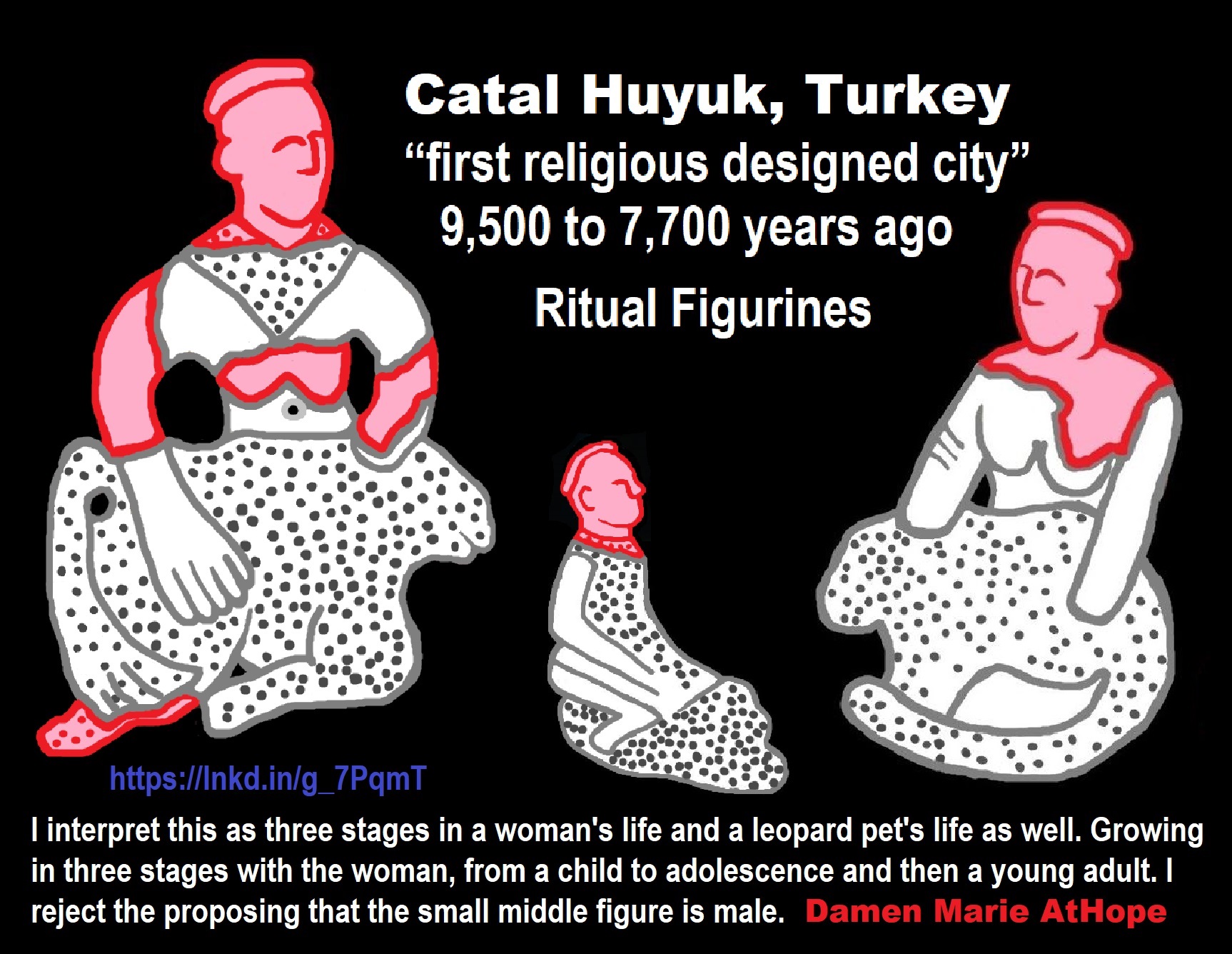
I assume this group of connected figurines is tracking the life of a female shaman, which is my speculation.
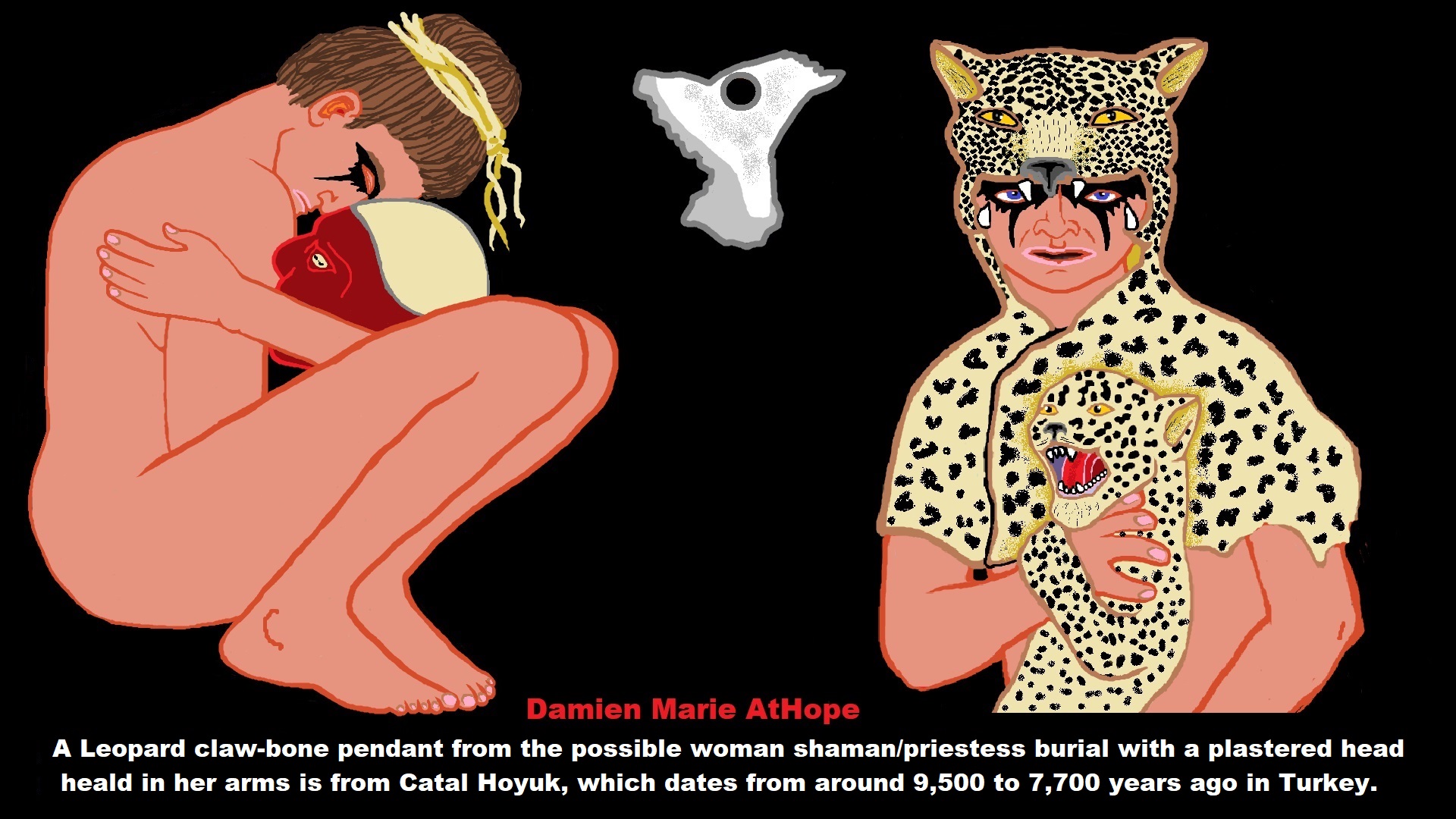
There are other clothing resembling miniskirts that have been identified by archaeologists and historians as far back as 3,390–3,370 years ago. But this is much older. ref
Leopard claw-bone pendant from the Possible Woman Shaman/Priestess burial with the plastered and painted woman’s head in her arms that is several generations removed. She was buried under the floor of the history house (house with multiple burials beyond that of the connected family) with the twin facing leopards at Catal Huyuk. Ref
“From about 7500 B.C.E to 5700 B.C.E., early farmers grew wheat, barley, and peas, and raised sheep, goats, and cattle. At its height, some 10,000 people lived there. Among its more noteworthy features, Çatalhöyük’s inhabitants were obsessed with plaster, lining their walls with it, using it as a canvas for artwork, and even coating the skulls of their dead to recreate the lifelike countenances of their loved ones.” ref
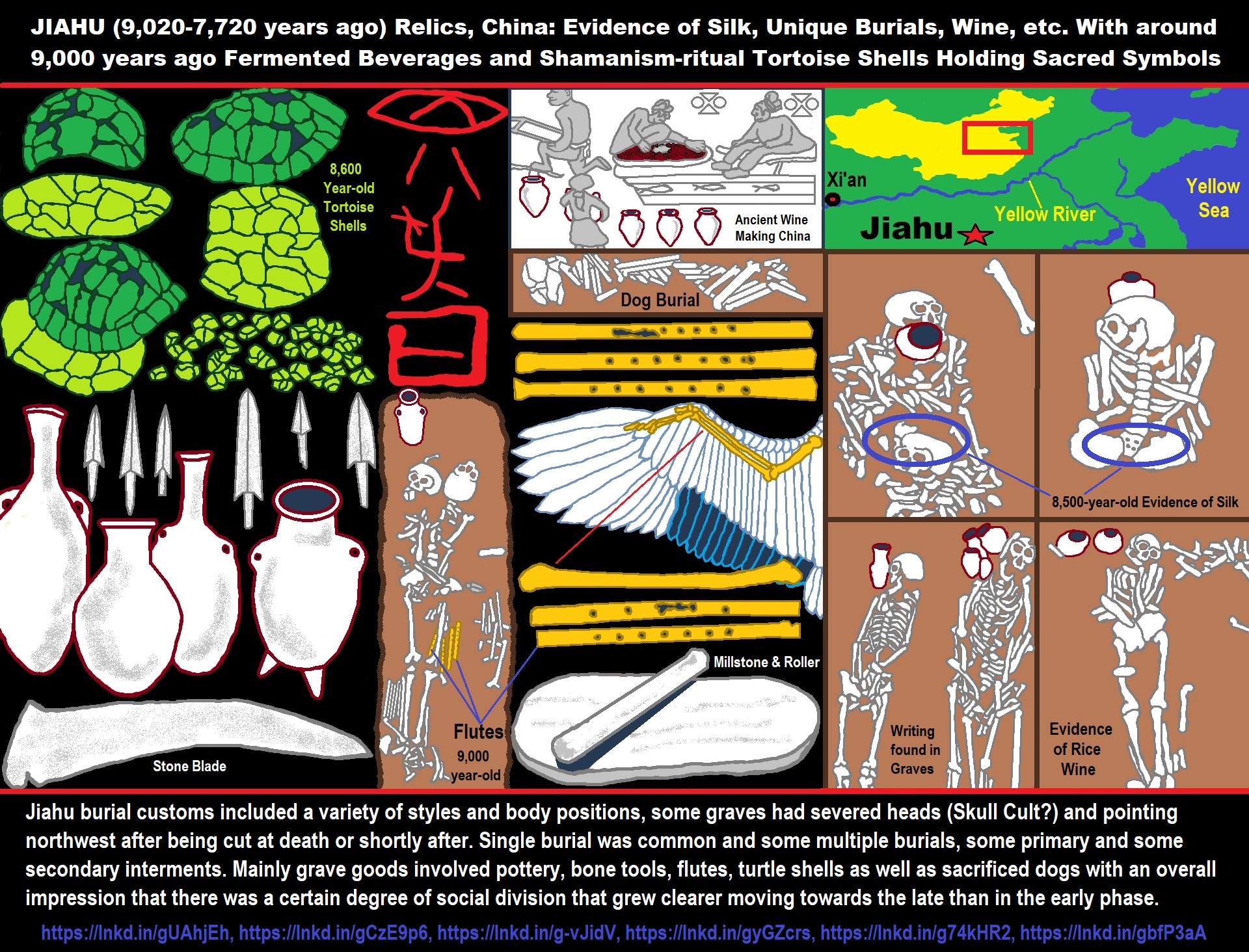
“The seeming origins of specialized pottery and diverse alcohol fermentation techniques in Early Neolithic China were found in Jiahu. China is well-known for its distinctive techniques in alcohol fermentation. Here we present archaeological evidence of alcohol making based on analyses of starch granules, phytoliths, and fungi in food residues adhering to 8,000- to 7,000-y-old Neolithic pottery vessels. We demonstrate the earliest association between the wide occurrences of globular jars as liquid storage vessels and the development of two methods of alcohol making: use of cereal malts and use of moldy grain and herbs as starters. The latter method was arguably a unique invention initiated in China. Neolithic people made low-alcohol beverages with broomcorn millet, Triticeae grasses, Job’s tears, rice, beans, snake gourd root, ginger, yam, lily, and so forth. Such fermented beverages may have served social, spiritual, and medicinal functions. In China, pottery containers first appeared about 20000 cal. BP, and became diverse in form during the Early Neolithic (9000–7000 cal. BP), signaling the emergence of functionally specialized vessels. China is also well-known for its early development of alcohol production. However, few studies have focused on the connections between the two technologies. Based on the analysis of residues (starch, phytolith, and fungus) adhering to pottery from two Early Neolithic sites in north China, here we demonstrate that three material changes occurring in the Early Neolithic signal innovation of specialized alcoholic making known in north China: (i) the spread of cereal domestication (millet and rice), (ii) the emergence of dedicated pottery types, particularly globular jars as liquid storage vessels, and (iii) the development of cereal-based alcohol production with at least two fermentation methods: the use of cereal malts and the use of moldy grain and herbs (qu and caoqu) as starters. The latter method was arguably a unique invention initiated in China, and our findings account for the earliest known examples of this technique. The major ingredients include broomcorn millet, Triticeae grasses, Job’s tears, rice, beans, snake gourd root, ginger, possible yam and lily, and other plants, some probably with medicinal properties (e.g., ginger). Alcoholic beverages made with these methods were named li, jiu, and chang in ancient texts, first recorded in the Shang oracle-bone inscriptions (ca. 3200 cal. BP); our findings have revealed a much deeper history of these diverse fermentation technologies in China.” ref
“Zhang Juzhong and Cui Qilong wrote in “A Companion to Chinese Archaeology”: “Dog sacrifice is another characteristic of Jiahu culture. The sacrificial offering of animals has a long history in China. Domesticated animals such as horses, cattle, sheep, chickens, dogs, and pigs, and wild animals such as deer and birds were all sacrificed during ceremonies in various periods. It seems that dog sacrifice has the longest history. During the Jiahu period, dog sacrifice was common, with dogs placed near graves or in marginal areas and not directly in graves. Dogs also were buried beside house foundations. It is possible that dogs were regarded as a public property of social groups such as clans or families and were used for protecting areas such as burial grounds. There would have been ceremonies performed at the time these dogs were buried. Ethnographic data can help us interpret the remains at Jiahu. For example, the Hani people (of southwest China [Ed.”) believe that dogs are the managers of their villages. Therefore, they often sacrifice dogs as offerings to ensure the protection of the village. They perform a divination ceremony at the same time; if the result is regarded as bad, the ritual specialist kills another dog outside of the back entrance of the village. Judging from the chronology of the evidence for dog sacrifice in antiquity in other parts of China, the upper Huai river valley, where Jiahu is located, was the origin of the practice, which then spread to other areas. It eventually became an important aspect of ritual during the Shang period (after c. 1600 B.C.).” ref
JIAHU (7000 B.C. to 5700 B.C.): HOME OF THE WORLD’S OLDEST WINE AND SOME OF THE WORLD’S OLDEST FLUTES, WRITING, POTTERY, AND ANIMAL SACRIFICES
“The archaeological site of Jiahu in the Yellow River basin of Henan Province, central China, is remarkable for the cultural and artistic remains uncovered there. These remains, such as houses, kilns, pottery, turquoise carvings, tools made from stone and bone—and most remarkably—bone flutes, are evidence of a flourishing and complex society as early as the Neolithic period, when Jiahu was first occupied. Fragments of thirty flutes were discovered in the burials at Jiahu, and six of these represent the earliest examples of playable musical instruments ever found. The flutes were carved from the wing bone of the red-crowned crane, with five to eight holes capable of producing varied sounds in a nearly accurate octave. The intended use of the flutes for the Neolithic musician is unknown, but it is speculated that they functioned in rituals and special ceremonies. Chinese myths are known from nearly 6,000 years after the flutes were made tell of the cosmological importance of music and the association of flute playing and cranes. The sound of the flutes is alleged to lure cranes to a waiting hunter. Whether the same association between flutes and cranes existed for the Neolithic inhabitants at Jiahu is not known, but the remains there may provide clues to the underpinnings of later cultural traditions in central China. Pictograms, signs carved on tortoiseshells, were also uncovered at Jiahu. In later Chinese culture dating to around 3500 B.C., shells were used as a form of divination. They were subjected to intense heat, and the cracks that formed were read as omens. The cracks were then carved as permanent marks on the surface of the shell. The evidence of shell pictograms from Jiahu may indicate that this tradition, or a related one, has much deeper roots than previously considered.” ref
“The world’s oldest SILK: Evidence of the luxury material is found in 8,500-year-old tombs in China. Legend puts the discovery of silk down to an empress thousands of years ago. Researchers studied the soil found in three tombs in a Neolithic burial site. They found proteins present in silk, and think people were buried in silk clothes. This makes it the oldest evidence for silk in the world, 3,500 years older than previous discoveries. The site is famous for the discovery of the earliest playable musical instrument (bone flutes), the earliest mixed fermented beverage of rice, honey and fruit, the earliest domesticated rice in northern China, and possibly the earliest Chinese pictographic writing. The researchers were intrigued by the possibility silk was made at the site, after hearing tales suggesting silkworm breeding and silk weaving began around the area. When they studied the soil from three tombs, they found peptides of silk fibroin, a protein present in silk. Previously, evidence of silk-making in the Neolithic Age had only been provided in the form of silk-making tools, like spinning wheels. A lack of direct evidence remains a challenge for demonstrating the existence of silk (derived from silkworm) during the Neolithic Age. Silk itself is rarely found in old tombs because it breaks down easily. Rough weaving tools and bone needles were also excavated, indicating the possibility that the Jiahu residents may possess the basic weaving and sewing skills in making textile,’ the authors said. It is possible the people in the tombs were buried in silk clothing, but further evidence will make this clearer. In their future research, the scientists will hunt for other signs of silk at this and other sites.” ref
Flutes Found in Jiahu
“The oldest playable flute, a seven-holed instrument carved 8,000 years ago from the hollow wing bone of a large bird, was unearthed in Jiahu. It and other bone flutes were found, the flutes were cut, smoothed at the ends, polished, and finally drilled with a row of holes on one side. One of the broken flutes was repaired by drilling fourteen tiny holes along the breakage lines and then tying the section together with string. For a while, the Jiahu flutes were declared the world’s oldest flutes and musical instruments, but in June 2009, a 35,000-year-old bird bone flute found in a cave in Tuebingen, Germany was declared the world’s oldest flute. In 2012, a 40,000-year-old bird bone flute from the site of Geißenklösterle, a part of the Swabian caves system in southern Germany, was declared the world’s oldest flute and musical instrument. Thirty-three flutes—including around 20 intact flutes and several broken or fragmented ones and several more unfinished ones— have been found at Jiahu. All are between seven and 10 inches in length and are made of wing bones from the red-crowned crane, a bird that stands five feet tall and has a wing span of eight feet and is famous for its courtship dance. It seems plausible that ancient flutes were also made from bamboo. Ancient myths described bamboo flutes but no ancient ones have been found in all likelihood because bamboo decays more quickly than bone and doesn’t survive burial for thousands of years like bone does. The flutes have between five and eight holes. They play in the so-called pentatonic scale, in which octaves are divided into five notes—the basis of many kinds of music, including Chinese folk music and rock n’ roll. The fact that the flute has a scale indicates that its original players played music rather than just single notes. The flutes were probably used in some kind of ceremonial capacity but may have been played for entertainment. The flutes were found along with evidence of early wine making, which suggests that the people who played them could have been a festive bunch. A Companion to Chinese Archaeology”: “The earliest bone flutes were found in burial M78, one on each side of the left femur of the skeleton. Each bone tube had seven small drilled holes. Their similarity to modern flutes or vertical bamboo flutes attracted our curiosity. During 1987 two broken flutes were discovered in general cultural (midden) deposits. The total quantity to date is 25; 22 of them were grave goods…This kind of ancient artifact is extremely rare in the history of music. 15 years after the first discovery of bone flutes, during the seventh excavation of the Jiahu site, we discovered 10 more flutes, seven of which could be repaired. A new type of bone flute with two holes was discovered in burial M521. In the middle of the back of the flute are beautiful and delicate incised decorations. The length of the decorative belt is about 18 cm. It includes a cluster of rhombuses and one section that resembles a curled snake. In our understanding, the Jiahu bone flutes represent the earliest well-preserved musical instrument in the world.” ref
“Archeologists have divided the flutes found in Jiahu into three groups: 1) the early phase, those between 9,000 and 8,600 years old; 2) the middle phase, those between 8,600 and 8,200 years old; 3) the late phase, those between 8,200 and 7,800 years old. The 23 complete flutes can be divided into three types based on shape. During the early phase at Jiahu there were five or six holes in the bone flutes, which can, therefore, perform scales with four and scales with five notes. Flutes from the middle phase have seven holes, permitting six-note scales. During the late phase, bone flutes with eight holes appeared while the seven-hole flute was still in use. (With the eightholed flute, one can perform scales with seven notes.) Only two flutes from the early phase were recovered, both from the grave of an adult male. One has five holes and can produce six distinct pitches. The other has five holes and can produce seven distinct pitches, including two notes repeated an octave apart. About two dozen flutes from the middle phase were unearthed. Fifteen are intact or could be reconstructed. One has two holes. The others all have seven holes and can play eight pitches. Despite some differences in the range of pitches, the intervals between them are similar. Seven flutes from the late phase were unearthed. One of them can still be played. These have eight holes and pitch intervals close together and are capable of a variety of melodic structures. A flute from the late phase found 80 miles from Jiahu in Zhinghanzhai has tens holes, staggered on two parallel lines with the intervals between them close to half steps.” ref
“Notes from the playable flute have been recorded and analyzed. The flute produces a rough scale covering the modern octave, beginning close to the second A above middle C, and appears to have been tuned—a tiny hole was drilled near the seventh hole, with effect of raising that hole’s tone from roughly G-sharp to A, completing the octave. How were these flutes played? What kind of melody could be produced? The author took flute 20 from burial M282 to Beijing for analysis by a musician after finishing the excavation. This flute was made from the ulna of a large bird ’’s wing. The bird has been identified as a red-crested crane. The two ends of the ulna were removed, making a hollow bone tube. The total length of the flute is 23.60 cm. Despite its more than 8,000 years of existence, the bone flute is still quite shiny and smooth.” ref
“Xiao Xinghua, the director of the folk music laboratory, Graduate Institute of Music, Chinese National Academy of Arts, first confirmed that the object is an instrument. We also had the director of the Chinese National Orchestra, Liu Wenjin, arrange a trial performance. It was performed by a flautist, Ning Baosheng, who produced the notes by holding the flute at an angle. After that, Xiao Xinghua asked a famous musical theorist, Huang Xiangpeng, to make an official test of the flute. The crucial step in producing the flute was to decide the locations of the holes, because they directly affect the pitch and scale. Locations for boring the holes were marked with many dots and lines before drilling and are still visible today. Some researchers proposed that the Jiahu people used some kind of mathematical method to decide the distance between each hole. At the very least the production required long experience.” ref
Jiahu Burial Customs
“Jiahu villagers practiced some unusual burial customs. In some graves, the heads were severed from the body and pointed towards the northwest. Cut marks made when the bones were fresh indicates the heads were cut when the person was still alive or shortly after they died. Adults were generally buried whole in pits; juveniles were buried in pots. Most were buried in individual plots. Some were buried in groups up to six with a mix of sexes and ages. The burials of Jiahu site were superimposed or extended and included a variety of styles and body positions. There were both single and multiple burials, the latter containing up to six skeletons. The types of burials include primary single burials and primary multiple burials in extended positions ( yangshen zhizhi), secondary burials with single or multiple skeletons, and burials with some primary and some secondary interments. The burials mostly faced to the west. Mortuary goods mainly consisted of pottery vessels and bone tools, as well as paired turtleshells (upper and lower carapace) and sacrificed dogs. This is noteworthy because mortuary objects represent the social status of the deceased. After classifying mortuary objects and burial styles, we concluded that there was a certain degree of social division at the Jiahu site. The division is clearer in the late than in the early phase.” ref
Evidence for Social Differentiation in Jiahu Burials
Zhang Juzhong and Cui Qilong wrote in “A Companion to Chinese Archaeology”: “In this section I refer to the three initial phases identified for the site: early (first phase), middle (second phase), and late (third phase). Social-cultural development almost reached its zenith during the second phase, and it rose a little more during the third phase before declining. There is evidence for a social division of labor that becomes clearer over time, especially from the burials. For the early phase at Jiahu, there were differences in the number and size of mortuary objects among burials. It appears that some social inequality existed in early Jiahu society. There were relatively large burials that had more mortuary objects such as production tools or special objects including turtle shells, bone flutes, and fork-shaped tools, all of which probably had spiritual/religious meanings. The tombs with special objects in this period not only contain many objects but are also large in size. With few exceptions, however, these burials also contain tools, especially those for fishing and hunting. This suggests that some individuals who often participated in productive activities also had some special skills related to music and religion. These people included religious specialists such as shamans ( wu..) who probably had higher social status. The deceased in these burials obtained higher status by their own physical labor or special skills. Therefore social inequality at this time did not involve a privileged class, but early Jiahu society does not seem to be a society with full equality. For the middle phase, there were a few burials with more grave goods than others, up to 60 in one burial, although these were small objects such as bone rings, needles, or projectile points. Mortuary objects during this time were mainly production tools made of bone, and fishing and hunting tools. These were quite common for the site as a whole, so it is difficult to demonstrate differences in wealth. The pattern could suggest instead the work of the deceased when they were alive. Three tombs with secondary burials in the middle phase were all relatively small. In the middle phase, differences between graves with respect to size – a direct reflection of labor cost – were lower. The low degree of variation in grave size means that a standardized burial system such as usually exists in a divisional society (e.g., a ranked society [Ed.”) had not developed. There appear to be no regulations for the scale of the grave, a number of artifacts, or burial tradition according to social rank. For the middle phase, the difference in social status between males and females was larger than that between individuals in different age groups. At this time differences in social status probably were not only based on labor but also associated with gender roles. It appears that the status of males was higher than that of females. For the late phase at Jiahu, the differences among burials with respect to size (a direct reflection of labor cost), were lower. The differences in tomb size are in the range of expected values to represent social equality, except that some single burials have more objects than others. Several tombs have not only the largest number of mortuary objects and size, but also are located in the central area of the burial ground. These tombs generally contain special mortuary objects or production tools, such as the burial with a male skeleton, M73, in area B. The tombs which contain special objects usually have more grave goods and are larger in size. In general, males had a higher status than females during the late phase at Jiahu. The difference in social status between males and females was larger than that between individuals in different age groups. In sum, social division in the late phase at the Jiahu site was not distinctive, but it is difficult to confirm that individuals in the society were totally equal.” ref
Jiahu Shamanism and Turtle Sacrifices
“Ancient people in many areas espoused animism, a belief that many organisms and inanimate objects had spirits and that every phenomenon is controlled by supernatural forces. People believed they could induce or even force the natural world to work as they wished by undertaking certain ceremonies. Probably the most basic type of rituals involved shamanism, which makes use of specialists, shamans, who could act as mediators between the gods and humans. Their extraordinary abilities brought them respect, and they sometimes became leaders of the tribes or clans. Shamans were the transmitters of human wisdom and traditional cultural knowledge and were thus the intellectuals of the culture. During their social and religious activities, they probably accumulated a large amount of knowledge about astronomy, some sort of calendar system, biology, medicine, music, dance, and some type of early recordkeeping. There are two kinds of evidence for such shamanistic rituals at Jiahu, involving the sacrificial offerings of turtles and dogs. We found that the Jiahu people had a distinctive tradition of turtle sacrifice. There were complete turtleshells in burials, trash pits, and house remains. Among the 349 excavated burials, 23 burials contained roughly 90 turtleshells and parts of shells. There were three patterns for these turtleshells in the burials: a pair of shells – carapace and plastron – placed together, a single complete shell, and shell fragments. Most complete shells and part of shell fragments were discovered with pebbles. There were some turtleshell objects that could have been used to produce a sound, perhaps for divination. These were made by drilling holes in a complete turtle carapace, putting pebbles inside, and attaching a plastron on the bottom with some kind of string to seal the pebbles inside. Based on divination methods used in Chinese history, the turtleshells with pebbles probably represent some kind of divination using numbers. Some of the turtleshells also contained bone needles or bone awls which may have been used for medicinal purposes. The positions of the paired shells with pebbles in the graves varied. Some were located beside the arms of the skeletons, others by the lower legs. One of these burials, M344, is particularly distinctive. There are skeletal remains of a male, but the skull is missing. M344 has a large number of grave goods, including eight turtleshells with pebbles inside. One of them has proto-characters inscribed on it (discussed below). There were also two seven-hole bone flutes (also discussed below), and fork-shaped bone tools ( chaxingqi) found together with the turtleshells. These objects were probably used for shamanism. Each turtleshell was placed upon a different body part of the deceased, and most of the turtleshells contained pebbles. This deceased individual most likely was a shaman. There is evidence for ritual activity with turtleshells in habitation contexts as well. We found the remains of a turtle in the foundation of F17, the large early-phase structure previously described. There was a complete turtleshell and plastron in the bottom of a posthole, underneath an earthen wall. The turtle ’’s head faced west, the same direction as the door. It appears that the turtle had been placed there before the wall was built. Therefore, it obviously was a sacrifice for the house foundation.” ref
8,600-year-old Tortoise Shells in Neolithic graves in central China
have Early Writing and Shamanism
Neolithic graves in central China may hide the world’s earliest writing, if the “signs” carved into 8,600-year-old tortoise shells, and could involve a shaman rattle.
“The symbols were laid down in the late Stone Age, or Neolithic Age. They predate the earliest recorded writings from Mesopotamia – in what is now Iraq – by more than 2,000 years. The archaeologists say they bear similarities to written characters used thousands of years later during the Shang dynasty, which lasted from 1700-1100 BC. But the discovery has already generated controversy, with one leading researcher in the field branding it “an anomaly”. The archaeologists have identified 11 separate symbols inscribed on the tortoise shells. The shells were found buried with human remains in 24 Neolithic graves unearthed at Jiahu in Henan province, western China. The site has been radiocarbon dated to between 6,600 and 6,200 BC. The Neolithic markings include symbols that resemble the characters for “eye” and “window” and the numerals eight and 20 in the Shang script. The persistence of sign use at different sites along the Yellow River throughout the Neolithic and up to the Shang period, when a complex writing system appears. Shaman rituals, with indications the Neolithic culture at Jiahu may not have been complex enough to require a writing system. But the signs appeared to be highly “schematized” or stylised. This is a feature of Chinese written characters. Aggregations of small pebbles were found close to several of the tortoise shells. The Jiahu researchers propose that the shells once contained the pebbles and were used as musical rattles in shamanistic rituals. In one grave, eight sets of tortoise shells were placed above the skeletal remains of a man whose head was missing. The shells come from graves where, in 1999, the researchers unearthed ancient bone flutes. These flutes are the earliest musical instruments known to date. ref
Jiahu and Peiligang Culture
“The Peiligang culture was a Neolithic culture in the Yi-Luo river basin (in modern Henan Province, China) that existed from 7000 to 5000 BC. Over 100 sites have been identified with the Peiligang culture, nearly all of them in a fairly compact area of about 100 square kilometers in the area just south of the river and along its banks. Archaeologists believe that the Peiligang culture was egalitarian, with little political organization. The culture practiced agriculture in the form of cultivating millet and animal husbandry in the form of raising pigs, cattle, and poultry.[1] The people hunted deer and wild boar, and fished for carp in the nearby river, using nets made from hemp fibers. The culture is also one of the oldest in ancient China to make pottery. This culture typically had separate residential and burial areas, or cemeteries, like most Neolithic cultures. Common artifacts include stone arrowheads, spearheads, and axe heads; stone tools such as chisels, awls, and sickles for harvesting grain; and a broad assortment of pottery items for such purposes as cooking and storing grain.” ref
“The site at Jiahu is the earliest site associated with Peiligang culture. There are many similarities between the main group of Peiligang settlements and the Jiahu culture, which was isolated several days’ travel to the south of the main group. Archaeologists are divided about the relationship between Jiahu and the main group. Most agree that Jiahu was part of the Peiligang culture, pointing to the many similarities. A few archaeologists are pointing to the differences, as well as the distance, believing that Jiahu was a neighbor that shared many cultural characteristics with Peiligang, but was a separate culture. The cultivation of rice, for example, was unique to Jiahu and was not practiced among the villages of the main Peiligang group in the north. Also, Jiahu existed for several hundred years before any of the settlements of the main group.” ref
“Jiahu was the site of a Neolithic settlement based in the central plain of ancient China, near the Yellow River. It is located between the floodplains of the Ni River to the north, and the Sha River to the south, 22 km (14 mi) north of the modern city of Wuyang, Henan Province. However, most archaeologists consider the site to be one of the earliest examples of the Peiligang culture. Settled around 7000 BC, the site was later flooded and abandoned around 5700 BC. The settlement was surrounded by a moat and covered a relatively large area of 55,000 square meters (5.5 hectare). At one time, it was “a complex, highly organized Chinese Neolithic society,” home to at least 250 people and perhaps as many as 800. The important discoveries of the Jiahu archaeological site include the Jiahu symbols, possibly an early example of proto-writing, carved into tortoise shells and bones; the thirty-three Jiahu flutes carved from the wing bones of cranes, believed to be among the oldest playable musical instruments in the world; and evidence of wine fermented from rice, honey, and hawthorn leaves. A broad variety of other artifacts indicates a fairly advanced settlement for the early Neolithic period, including residences, burial sites, pottery kilns, an assortment of implements made of stone and earthenware, and a large central structure believed to be a communal workspace. To date, 45 residences have been excavated at Jiahu. Most of these are small, between four and ten meters. Most of these were semi-subterranean (partially dug into the earth) and with a single room; however, some of these had additional rooms built on later. Rubbish pits and storage cellars were also excavated, and nine pottery kilns were identified.” ref
“Some archaeologists point to cultural distinctions between Jiahu and Peiligang, as well as the distance: Jiahu is isolated, many kilometers south of the larger Peiligang grouping of over 100 archaeological sites in a fairly compact area. The distance would have represented a journey on foot of several days in the Neolithic era. This school of thought suggests that Jiahu and Peiligang represented separate, neighboring cultures that interacted and shared many characteristics. Other early Neolithic settlements in this part of the world were much farther south and east. Archaeologists have divided Jiahu into three distinct phases. The oldest phase ranges from 7000 to 6600 BC; the middle phase ranges from 6600 to 6200 BC; and the last phase ranges from 6200 to 5700 BC. The last two phases correspond to the Peiligang culture, while the earliest phase is unique to Jiahu. Careful examination of the skeletons of over 400 individuals, removed from more than 300 graves, by several scientific teams over the course of the past 30 years proves that the Jiahu ethnic group was a part of the North Asian Mongoloid group, and identified closely with the Miaodigou and Xiawanggang sub-groups which were also descendants of hunting and gathering tribes in Henan Province, and the Dawenkou, Xixiahou and Yedian sub-groups that were later found in Shandong Province.” ref
“Early Neolithic pig domestication at Jiahu, Henan Province, China: clues from molar shape analyses. The zooarchaeology of pig domestication in China is a challenging task due to its wild boar ancestors being widespread throughout Eurasia. However using geometric morphometric approaches on molar tooth (M2), shape and size variations, from modern and Neolithic suids, using Yangshao pigs as a surrogate for the Neolithic domestic form, we have addressed the identification of morphological change during the early step of domestication in three early Neolithic sites where claims of pig domestication have been made. Phenetic relationships here have revealed clear and interpretable phenotypic signatures in the samples of modern and Neolithic pigs; which provide evidence for pig domestication at the site of Jiahu from at least 6600 BC cal., re-establishing the Yellow River region as one of the earliest centers of independent Chinese pig domestication.” ref
“Rice (Oryza sativa) is one of the most important cereal grains in the world today and serves as a staple food source for more than half of the world’s population. Research into when, where, and how rice was brought into cultivation and eventually domesticated, along with its development into a staple food source, is thus essential. These questions have been a point of nearly continuous research in both archaeology and genetics, and new information has continually come to light as theory, data acquisition, and analytical techniques have advanced over time. Here, we review the broad history of our scientific understanding of the rice domestication process from both an archaeological and genetic perspective and examine in detail the information that has come to light in both of these fields in the last 10 y. Current findings from genetics and archaeology are consistent with the domestication of O. sativa japonica in the Yangtze River valley of southern China. Interestingly, although it appears rice was cultivated in the area by as early 8000 BP, the key domestication trait of nonshattering was not fixed for another 1,000 y or perhaps longer. Rice was also cultivated in India as early as 5000 BP, but the domesticated indica subspecies currently appears to be a product of the introgression of favorable alleles from japonica. These findings are reshaping our understanding of rice domestication and also have implications for understanding the complex evolutionary process of plant domestication.” ref
“Many scholars now accept that the Yangtze River area in China is the place where rice was originally domesticated as a consequence of these newer findings (11, 19–23). However, as discussed elsewhere in this paper, whether indica and japonica had single or multiple origins is a question under active research in the genetic and archaeological arenas, and there is little consensus of opinion with regard to the available genetic evidence (24). The resolution of this question depends to a large extent on archaeological research, which has revealed separate cultivation origins for indica and japonica. Current arguments in archaeology are also focused on fundamental questions of when rice cultivation began in China and how long the domestication process took. Cultivation and subsequent domestication are increasingly seen as being considerably more separated in time than once thought, as a horizon of what’s termed “predomestication cultivation” sometimes lasting thousands of years is being increasingly documented in the Old World (see Introduction in this volume), and this also appears true for rice. Moreover, recent studies suggest that there is no clear boundary line between hunting-gathering and agriculture and that the transformation between the two is not a revolutionary change but rather a slow process of qualitative and quantitative shifts that may have taken thousands of years. These questions, in turn, are related to theories of agricultural origins in China and around the world that are currently of great interest in anthropology and archaeology. Accordingly, we now focus on new archaeobotanical data bearing on these issues and the subsequent spread of rice into the Korean Peninsula, the Japanese archipelago, and India.” ref
“The earliest rice remains recovered in China have been reported from three archaeological sites: Xianrendong and Diaotonghuan in Jiangxi Province and Shangshan in Zhejiang Province. The cultural remains of these sites are dated to around 10,000 BP (all dates are in calibrated years), although it should be noted that the cultural deposits in the Xianrendong cave site have a very long sequence; the lower layer was recently dated to about 20,000 BP. This information suggests that a new date might also be needed for the rice remains found in the upper layers of this site.” ref
“Locations of the sites with early rice remains in the Yangtze Rivers areas: (1) Yuchanyan; (2) Pengtoushan; (3) Bashidang; (4) Jiahu; (5) Xianrendong/Diaotonghuan; (6) Shangshan; (7) Kuahuqiao; (8) Xiaohuangshan; (9) Hemudu/Tianluoshan.” ref
“Shangshan is an early Neolithic settlement with house and pit features, and artifactual remains that include pottery and stone tools. The cultural assemblage recorded can be divided into two periods: the Shangshan culture dated to ∼11,000–9000 BP, and the Kuahuqiao culture dated to 8000–7000 BP. Although more than 400 soil samples were floated, only 10 charred rice grains and a few rice spikelet bases were recovered. Most of these belong to the Kuahuqiao cultural horizon. A few rice grains were recovered from the Shangshan culture horizon. Rice remains were also found by other methods. For example, rice husks can be easily identified in the paste of pottery sherds, and they were commonly found in sherds dating to both of the two periods. Heaps of rice husks were also found in burnt soil blocks from the early period layers of the site. The combined evidence indicates that Shangshan people intensively exploited rice. The Shangshan rice was believed to be in an early stage of domestication, based on grain size and morphological characteristics (e.g., length-to-width ratios). However, others note that grain size and shape may exhibit considerable variability in wild and domesticated populations, some of which is probably influenced by plant responses to environmental factors and therefore may not be a reliable indicator of early domestication. In light of the abundance of rice husks in the pottery and other site contexts, it seems that Shangshan people had a high demand for rice, and the cultivation of rice may have begun at that time. Further work is required to unequivocally establish rice cultivation; if it occurred, it could be interpreted as being primarily an attempt to improve the yield of wild rice. In China, the time around 8,000 years ago appears to have been critical for agricultural origins, not only for rice in the Yangtze River area, but also for millet agriculture in the Yellow River system of northern China. For example, several archaeological sites exhibiting the characteristics of early rice farming have all been dated to around 8000 BP. They are Pengtoushan and Bashidang in Hunan Province, Kuahiao, and Xiaohuangshan in Zhejiang Province, and Jiahu in Henan Province. Jiahu was a permanent village dated by dozens of radiocarbon determinations to a period between 9000 and 7800 BP. Flotation work was carried out on a total of 125 soil samples, and a large number of charred plant remains were recovered, including several hundred rice grains. Other plant remains include soybean (Glycine sp.), water chestnut (Trapa sp.), lotus roots (Nelumbo nucifera), and acorn (Quecus sp.). Zhao’s research on the Jiahu rice indicates that it may well be domesticated, as its grain phenotypic characteristics, including size and shape, are much like modern domesticated rice. A discussion has ensued about these characteristics. For example, it has been suggested that Jiahu rice might belong to a wild rice species because the grains are remarkably small. Alternatively, it has also been argued that the Jiahu rice grains are not small but characterized by a great variation in size, based on measurements of hundreds of rice grains recently recovered from Jiahu. Another factor that should be considered in establishing the status of the Jiahu rice is the abundance of weedy grasses, which may represent weeds of cultivation (e.g., Digitaria and Echinochloa spp.). Furthermore, the location of the Jiahu site is far from the natural distribution of wild rice today. All of these factors indicate that domesticated rice and rice agriculture were established at the site 8,000 y ago. It should also be noted that the rice remains at Jiahu were accompanied by a large amount of wild food resources, such as lotus and water chestnut, along with fish bones and shells. Quantitative analysis of the plant remains showed that rice was not the dominant plant in the remains. It appears that rice did not play a dominant role in the subsistence of the Jiahu people and that the overall subsistence economy was a mixture of plant cultivation, fishing, and other wild resource procurement. This type of mixed subsistence is a pattern coming to light in other regions of the world where early agriculture was established.” ref
Common carp aquaculture in Neolithic China dates back 8,000 years
“Using age-mortality and species-selection profiles of fish bones from prehistoric East Asia to show that managed aquaculture of common carp (Cyprinus carpio) was present at the Early Neolithic Jiahu site, Henan Province, China, by around 6000 BC.” ref
Jiahu symbols
“The Jiahu symbols consist of 16 distinct markings on prehistoric artifacts found in Jiahu, a neolithic Peiligang culture site found in Henan, China. The Jiahu symbols are dated to around 6000 BC. The archaeologists who made the original finds believed the markings to be similar in form to some characters used in the much later oracle bone script (e.g. similar markings of 目 “eye”, 日 “sun; day”), but most doubt that the markings represent systematic writing. A report in Antiquity interpreted them “not as writing itself, but as features of a lengthy period of sign-use which led eventually to a fully-fledged system of writing.” The earliest known body of writing in the oracle bone script dates much later to the reign of the late Shang dynasty king Wu Ding which started about c. 1250 BC or 1200 BC.” ref
End of the village: a flood?
“Based on the archaeological evidence, a severe flood from the nearby rivers submerged most or all of the Jiahu settlement under a few feet of water sometime around 5700 BC. The inhabitants evacuated. It is not known where they went. The absence of tools and weapons in most of the residences indicates that they were able to salvage most of their belongings. They may have built a new village that has not been discovered, emigrated to the Peiligang villages, or scattered. Zhang Juzhong imagines that they were led by their tribal priest to build a new village nearby on higher ground, so that they could send salvage parties to the old village site. The new village site has never been found. The demolishing of older structures to salvage materials for the construction of new ones may have eradicated the site of the new village if it existed.” ref
“Jiahu 1: earliest farmers beyond the Yangtze River: The authors summarise the latest evidence for the introduction of rice cultivation into northern China, and show that it most probably began there in the early seventh millennium BC as a result of influence.” ref
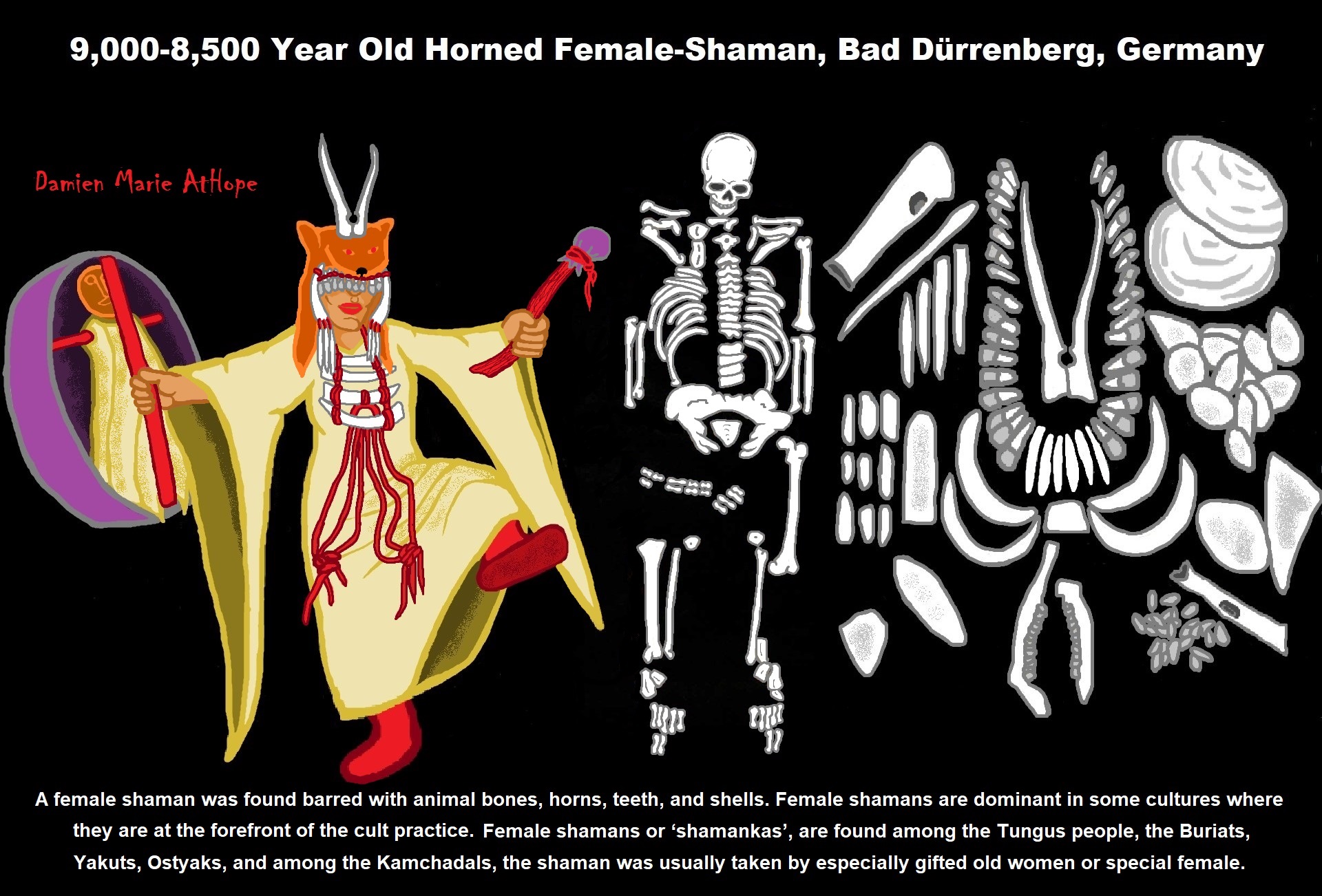
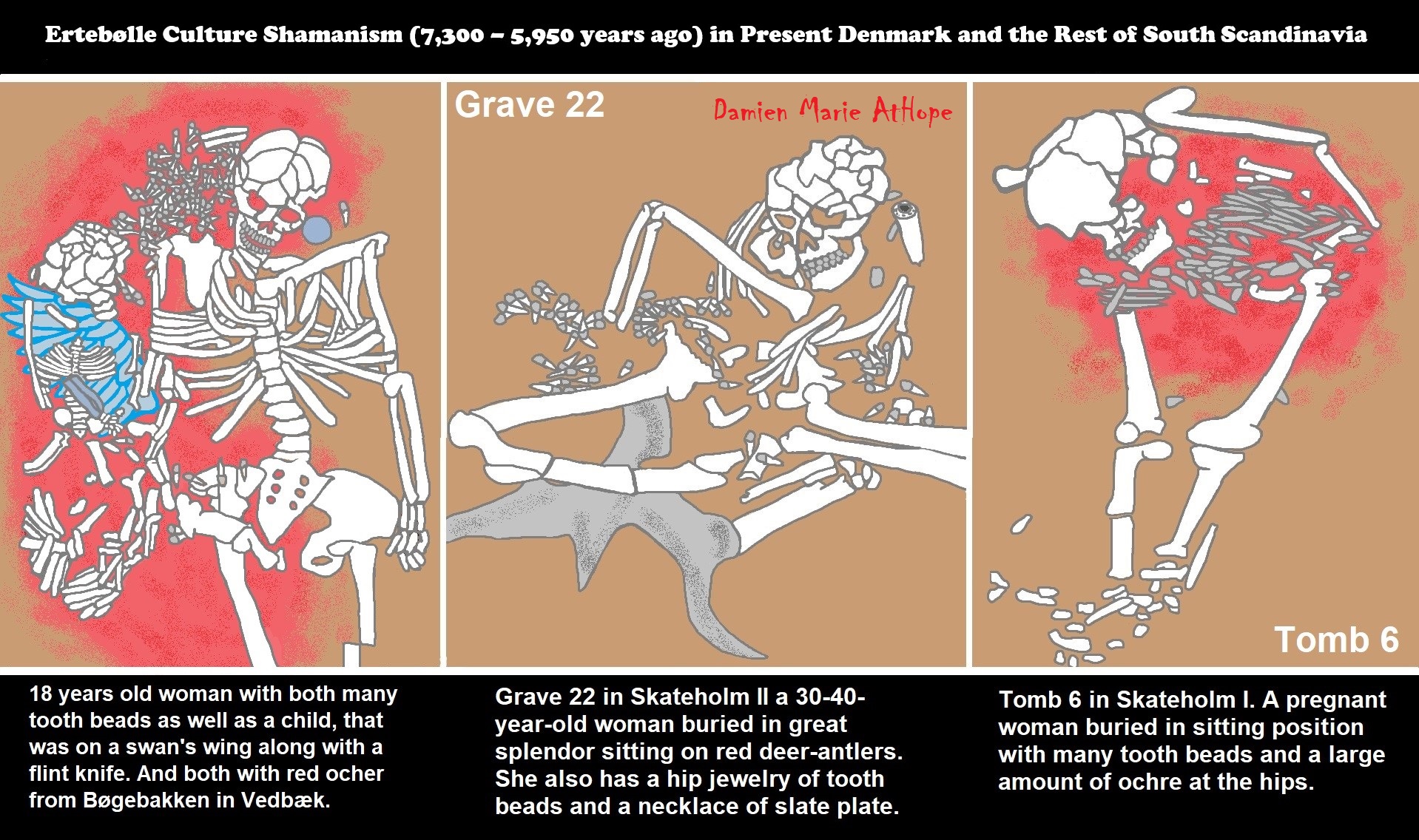
“The Ertebølle culture (ca 5300 BC – 3950 BC) is the name of a hunter-gatherer and fisher, pottery-making culture dating to the end of the Mesolithic period. The culture was concentrated in Southern Scandinavia but genetically linked to strongly related cultures in Northern Germany and the Northern Netherlands. It is named after the type site, a location in the small village of Ertebølle on Limfjorden in Danish Jutland. In the 1890s, the National Museum of Denmark excavated heaps of oyster shells there, mixed with mussels, snails, bones and bone, antler, and flint artifacts, which were evaluated as kitchen middens, or refuse dumps. Accordingly, the culture is less commonly named the Kitchen Midden. As it is approximately identical to the Ellerbek culture of Schleswig-Holstein, the combined name, Ertebølle-Ellerbek is often used. The Ellerbek culture (German Ellerbek Kultur) is named after a type site in Ellerbek, a community on the edge of Kiel, Germany.” ref
“The Ertebølle culture was roughly contemporaneous with the Linear Pottery culture, food-producers whose northernmost border was located just to the south. The Ertebølle did not practice agriculture but it did utilize domestic grain in some capacity, which it must have obtained from the south.” ref
“The Ertebølle culture replaced the earlier Kongemose culture of Denmark. It was limited to the north by the Scandinavian Nøstvet and Lihult cultures. It is divided into an early phase ca 5300 BC-ca 4500 BC, and a later phase ca 4500 BC-3950 BC. Shortly after 4100 BC, the Ertebølle began to expand along the Baltic coast at least as far as Rügen. Shortly thereafter it was replaced by the Funnelbeaker culture.” ref
“In recent years archaeologists have found the acronym EBK most convenient, parallel to LBK for German Linearbandkeramik (Linear Pottery culture) and TRB for German Trichterbecher, Danish Tragtbæger (Funnelbeaker culture) and Dutch trechterbekercultuur. Ostensibly for Ertebølle Kultur, EBK could be either German or Danish and has the added advantage that Ellerbek also begins with E.” ref
“The Ertebølle population derived its living from a variety of means, but chiefly from the sea. They prospered, grew healthy, and multiplied on a diet of fish. They were masters of the inland waters, which they traversed in paddled dugouts. Like many peoples known in history, they were able to hunt whales and seals from their dugouts. Their materials were mainly wood, with bone, antler, and flint for functions requiring harder surfaces. Homes were constructed of brush or light wood. The materials encourage us to view them as transitory. They were, nevertheless, able to place the dead in longer-used cemeteries. Perhaps the dwelling-places were transitory, but the territories were not.” ref
“Pottery was manufactured from native clays tempered with sand, crushed stone and organic material. The EBK pot was made by coil technique, being fired on the open bed of hot coals. It was not like the neighbouring Neolithic Linearbandkeramik and appears related instead to a pottery type that first appears in Europe in the Samara region of Russia c. 7000 cal BC, and spread up the Volga to the Eastern Baltic and then westward along the shore.” ref
“The many settlements on the coast and in the hinterland vary between large all-year-round settlements and smaller seasonal settlements. A settlement consisted of huts, probably brush supported by posts. The huts were in no special order. Fire pits located outside the huts indicate that most village functions were performed outdoors, with the dwellings used perhaps for storage and sleeping. At the time winters were mild.” ref
“An external fireplace from Ronaes Skae was constructed as a perimeter of stones surrounding a mud and clay hearth on which charred wood was found in a spoke pattern. The wood was collected from the shore. Fungus was used for tinder.” ref
“It is a common feature of all the southern Scandinavian settlements of Ertebølle time that the graves are located very close to the settlements. The burial site was actually a part of the settlement. The ancient hunters had a very close relationship with their deceased ancestors. In some of the tombs, skeletons lack head or other major bones, as for example the thigh bone or forearm-bone. One can find scattered human bones in the settlements. One can imagine that the dead’s skulls and other bones were used by the livings in ceremonies, which should preserve the deceased’s hunting luck or other good qualities for their descendants.” ref
“Cemeteries, such as the ones at Vedbæk and Skateholm, give a “sedentary” character to the settlements. Red ochre and deer antlers were placed in some graves, but not others. Some social distinctions may, therefore, have been made. There was some appreciation of sexual dimorphism: the women wore necklaces and belts of animal teeth and shells. No special body position was used. Both burial and cremation were practiced. At Møllegabet, an individual was buried in a dugout, which some see as the beginning of Scandinavian boat burials. Skateholm contained also a dog cemetery. Dog graves were prepared and gifted the same as humans, with ochre, antler, and grave goods. In either history or prehistory, the dog is an invaluable animal and is often treated as a person.” ref
1. “Skeleton of a woman with a child from the settlement on Bøgebakken in Vedbæk. The woman was about 18 years old, when she died. The child was laid to rest on a spread out swan’s wing. A flint knife at the hip indicates that it was a boy. The red soil around the mother’s head and hips and around the dead child may be due to red ocher-colored clothing. Attached to these were many tooth beads, which are seen as an irregular lump on the left of the woman’s head. Other tooth beads can be glimpsed in the ground around her hips.” ref
2. “Grave 22 in Skateholm II a 30-40-year-old woman has been buried in great splendor sitting on red deer-antlers. She also has hip jewelry of tooth beads and a necklace of slate plate. Red deer-antlers may have been the ultimate symbol of status, happiness, and fertility.” ref
3. “Tomb 6 in Skateholm I. A pregnant woman buried in sitting position with many tooth beads and a large amount of ochre at the hips.” ref
“There is some evidence of conflict between Ertebølle settlements: an arrowhead in a pelvis at Skateholm, Sweden; a bone point in a throat at Vedbæk, Zealand; a bone point in the chest at Stora Biers, Sweden. More significant is evidence of cannibalism at Dyrholmen, Jutland, and Møllegabet on Ærø. Their human bones were broken open to obtain the marrow. The evidence of marrow exploitation in the Ertebølle remains indicates dietary rather than ritual cannibalism; as marrow is never the subject of ritualistic cannibalism.” ref
“Skateholm consists of at least nine separate Late Mesolithic settlements, all located around what at the time was a brackish lagoon on the coast of the Scania region of southern Sweden, and occupied between ~6000-400 BC. In general, archaeologists have believed that the people who lived at Skateholm were hunter-fishers, who exploited the lagoon’s marine resources. However, the size and complexity of the associated cemetery area suggests to some that the cemetery was used for a broader purpose: as a set-aside burial place for “special” individuals.” ref
“The largest of the sites are Skateholm I and II. Skateholm I includes a handful of huts with central hearths, and a cemetery of 65 burials. Skateholm II is located about 150 m southeast of Skateholm I; its cemetery contains some 22 graves, and the occupation had a few huts with central hearths. Skateholm’s cemeteries are among the earliest known cemeteries in the world.” ref
“Both humans and dogs are buried in the cemeteries. While most of the burials are placed lying on their back with their limbs extended, some of the bodies are buried sitting up, some lying down, some crouching, some cremations. Some burials contained grave goods: a young man was buried with several pairs of red deer antlers placed above his legs; a dog burial with an antler headdress and three flint blades was recovered at one of the sites. At Skateholm I, elderly men and young women received the largest quantity of grave goods. “Osteological evidence of the graves suggests that it represents a normal working cemetery: the burials show a normal distribution of gender and age at the time of death. However, the differences within the cemetery might represent phases of occupation of Skateholm, and changing methods of burial rituals, rather than just a place for “special” individuals. The largest of the sites are Skateholm I and II. Skateholm I includes a handful of huts with central hearths, and a cemetery of 65 burials. Skateholm II is located about 150 m southeast of Skateholm I; its cemetery contains some 22 graves, and the occupation had a few huts with central hearths.” ref
Cemeteries at Skateholm
Skateholm’s cemeteries are among the earliest known cemeteries in the world. Both humans and dogs are buried in the cemeteries. While most of the burials are placed lying on their back with their limbs extended, some of the bodies are buried sitting up, some lying down, some crouching, some cremations. Some burials contained grave goods: a young man was buried with several pairs of red deer antlers placed above his legs; a dog burial with an antler headdress and three flint blades was recovered at one of the sites. At Skateholm I, elderly men and young women received the largest quantity of grave goods.
Osteological evidence of the graves suggests that it represents a normal working cemetery: the burials show a normal distribution of gender and age at the time of death. However, Fahlander (2008, 2010) has pointed out that the differences within the cemetery might represent phases of occupation of Skateholm, and changing methods of burial rituals, rather than a place for “special” individuals, however that is defined.” ref

ref, ref, ref, ref, ref, ref, ref
6810-5750-Years-Old Teviec, Sacrificed, Shaman Burial Site in France
This is the sacred grave of two women who died violently, were found at Teviec, buried under a “roof” of antlers and honored by shells (like stars of the afterlife?) as well as decorated with necklaces made of shells including a bracelet. ref
“The island is one of only a few known Mesolithic sites in Brittany, along with Pointe de la Torche, Hoëdic and Beg er Vil on the Quiberon peninsula. During the Mesolithic period, the sea level was much lower and it was possible to walk from France to England, and Téviec was situated in a lagoon.” ref
“Extensive middens were found near places of habitation on the island, containing the remains of shellfish, crustaceans, squid, fish, birds, cetaceans, and terrestrial mammals including wild boar, red deer, roe deer, dogs and so on. The hunter-gatherers of Téviec buried their own dead in the middens. This helped to preserve the graves, as the carbonates from the shells in the middens insulated human bones from the acid soil.” ref
“Many tools made of bone and antler were found along with numerous flint microliths. They were originally believed to date to between 6740 and 5680 years BP. This indicates a longer occupation than previously thought, with its end coming at the beginning of the Neolithic period. Ten multiple graves were discovered at Téviec containing a total of 23 individuals, including adults and children.” ref
“Some of the remains were scattered between different locations. Several of those interred appear to have died violent deaths. One individual was found to have a flint arrowhead stuck in a vertebra. In another grave, the skeletons of two women aged 25–35, dubbed the “ladies of Téviec”, were found with signs of violence on both. One had sustained five blows to the head, two of which would have been fatal, and had received at least one arrow shot between the eyes. The other had also traces of injuries. However, this diagnosis is disputed by some archaeologists, who have suggested that the weight of earth above the grave may have been responsible for damaging the skeletons.” ref
“The bodies had been buried with great care in a pit that was partly dug into the ground and covered over with debris from the midden. They had been protected by a roof made of antlers and provided with a number of grave goods including pieces of flint and boar bones, and jewelry made of seashells drilled and assembled into necklaces, bracelets, and ringlets for the legs. The grave assemblage was excavated from the site in one piece and is now on display at the Muséum de Toulouse, where its restoration in 2010 earned a national award.” ref
“The late Mesolithic sites of Tdviec and Hoedic, located on what are now small islands off the Breton coast, provide evidence for elaborate burial practices and may be precursors of the megalithic tradition of Brittany and western Europe in general. The shell middens TQviec and Hoedic are located on what are now small islands in the Bay of Quiberon in Brittany, off the Atlantic coast of northwest France. An abundant microlithic industry and a single radiocarbon estimate places them in the late Mesolithic. Teviec and Hoedic are roughly contemporaneous, based on similarities in tool typology and burial practices. A single radio-carbon determination on charcoal from a hearth in the lower part of the midden at Hoedic provides an estimate of 6575+350 years ago.” ref
“The sites are best known for their evidence of elaborate burial practices, with stone and red-deer antler structures, evidence for ceremonial burning and feasting, and abundant and varied grave goods. Together they constitute some two-thirds of known French Mesolithic burials. Teviec and Hoedic are critical to our understanding of the late Mesolithic and the transition to the Neolithic. The sites are part of the phenomenon of increasing ‘complexity’ in the late Mesolithic of northwest Europe: they also fill a geographical gap between the cemeteries of south-central Portugal and those of southern Scandinavia.” ref
The burials themselves mainly remain undated. The large standard error of this date limits its usefulness; at two standard deviations, it overlaps dates for Breton early Neolithic passage-graves and long mounds at around 5,700 years ago. No stratigraphic breaks were noted within the Mesolithic levels at either site, and the materials recovered were described as homogeneous throughout the 0.5 to 1.0 m of deposits. Neolithic deposits were encountered at Hoedic, but the 0.3 to 0.5 m of Mesolithic deposits were apparently entirely sealed by a layer of sterile gravel. Unfortunately, the rise in sea-levels from Atlantic times means that the sites must be looked at in isolation the now-submerged coastal plain on which they were high points was undoubtedly the focus of Mesolithic settlement in the area. Additional Mesolithic sites in Brittany include both shell-midden sites and many more non-shell-midden sites. With a 10-m drop in sea level around 6,000 years ago
“Many tools made of bone and antler were found along with numerous flint microliths dated to between 6,740-5,680 years ago. The hunter-gatherers of Téviec often buried their own dead in the middens. Extensive middens were found near places of habitation on the island, containing the remains of shellfish, crustaceans, squid, fish, birds, cetaceans, and terrestrial mammals including wild boar, red deer, roe deer, dogs and so on. During the Mesolithic period, the sea level was much lower – it was possible to walk from France to England– and Téviec was situated in a lagoon.” ref
“Ten multiple graves were discovered at Téviec containing a total of 23 individuals, including adults and children. Some of the remains were scattered between different locations. Several of those interred appear to have died violent deaths. One individual was found to have a flint arrowhead stuck in a vertebra. In another grave, the skeletons of two women aged 25–35, dubbed the “ladies of Téviec”, were found with signs of violence on both. One had sustained five blows to the head, two of which would have been fatal, and had received at least one arrow shot between the eyes. The other had also traces of injuries. However, this diagnosis is disputed by some archaeologists, who have suggested that the weight of earth above the grave may have been responsible for damaging the skeletons. The bodies had been buried with great care in a pit that was partly dug into the ground and covered over with debris from the midden. They had been protected by a roof made of antlers and provided with a number of grave goods including pieces of flint and boar bones, and jewelery made of sea shells drilled and assembled into necklaces, bracelets and ringlets for the legs.” ref
Rethinking Shell Middens
“Mounds of shells left by prehistoric people used to be considered mere trash. Now researchers recognize they can be monumental works of architecture that provide key insights into ancient cultures. Researcher Schwadron launched an ambitious, years-long study of some of the world’s largest and most complex prehistoric constructions made from shells. She and her colleagues have mapped more than a dozen major shellworks in the Ten Thousand Islands, as well as more than forty smaller shell structures. They have recovered nearly 50,000 artifacts, including ceramics and tools made from animal bones and shells. Radiocarbon dating of shell fragments and other materials indicates that people began creating the shell structures in the Ten Thousand Islands at least 3,500 years ago, during the Late Archaic period. The findings are helping reshape how scholars perceive North America’s prehistoric hunter-gatherers, and the numerous mounds of oyster, mussel, and snail shells they often left behind.” ref
Heightened interaction between neolithic migrants and hunter-gatherers in Western Europe
“The Neolithic lifestyle, including farming, animal domestication, and the development of new technologies, emerged in the Near East around 12,000 years ago and contributed profoundly to the modern way of life. The Neolithic spread rapidly across Europe, mainly along the Danube valley and the Mediterranean coastline, reaching the Atlantic coast around 5000-4500 BCE or around 7,020 to 6,520 years ago. The existing archaeogenetic data from prehistoric European farmers indicates that the spread of farming is due to expanding populations of early farmers who mixed little, if at all, with indigenous hunter-gatherer groups. However, until now, no archaeogenetic data were available for France.” ref
“These interactions seem to vary greatly from one region to another, attesting to a diverse cultural mosaic in early Neolithic Western Europe. The study, published in Science Advances, reports new genome-wide data for 101 prehistoric individuals from 12 archaeological sites in today’s France and Germany, dating from 7000-3000 BCE or around 9,020 to 5,020 years ago.” ref
High levels of hunter-gatherer ancestry in early farmers from France
“The new results showed evidence for a higher level of admixture, or the combination of genetic information from genetically distant populations, between early migrant farmers and local hunter-gatherers in France. The genetic mixture in this region is unprecedented in the rest of Europe for the early stages of the Neolithic expansion. The genetic contribution of hunter-gatherers is particularly high in the south of France, roughly 31% on average, compared with 3% in Central Europe or 13% in the Iberian Peninsula.” ref
“Intriguingly, in an individual from the Pendimoun site in Provence (5480-5360 BCE or around 7,500 to 7,380 years ago), the genetic contribution of local hunter-gatherers was as high as 55%. The team could show that the admixture in this individual occurred recently, about four generations before, shortly after the first Neolithic farmers settled on that part of the French coast. “These findings suggest continuous contacts between both groups for at least a century,” says Maïté Rivollat, a postdoc in the INTERACT project and lead author of the study.” ref
Genetic evidence for the two routes of the Neolithic expansion
“Leveraging the genetic substructure observed in European hunter-gatherers, the team was able to retrace the dynamics of admixture in various European regions. Neolithic farmers in central Europe carry a very small hunter-gatherer component, which had already been mixed in and brought in from southeastern Europe. This accounts for the rapid spread of Neolithic groups with a negligible amount of interaction with local hunter-gatherers. On the other hand, Neolithic farmers from west of the Rhine river (in France, Spain, Great Britain) carry a genetic component inherited from local Mesolithic groups, implying a process of late and local admixture.” ref
“The new data highlight the complexity and regional variability of biological and cultural interactions between farmer and hunter-gatherer communities during the Neolithic expansion. “This study shows that we can add a lot more detail with focused sampling and unravel the regional dynamics of the farmer-forager interactions,” concludes Rivollat. “With the increasing amount of genetic data, we gain the much-needed resolution to investigate biological processes in the past and to understand their relations with observed cultural phenomena.” ref
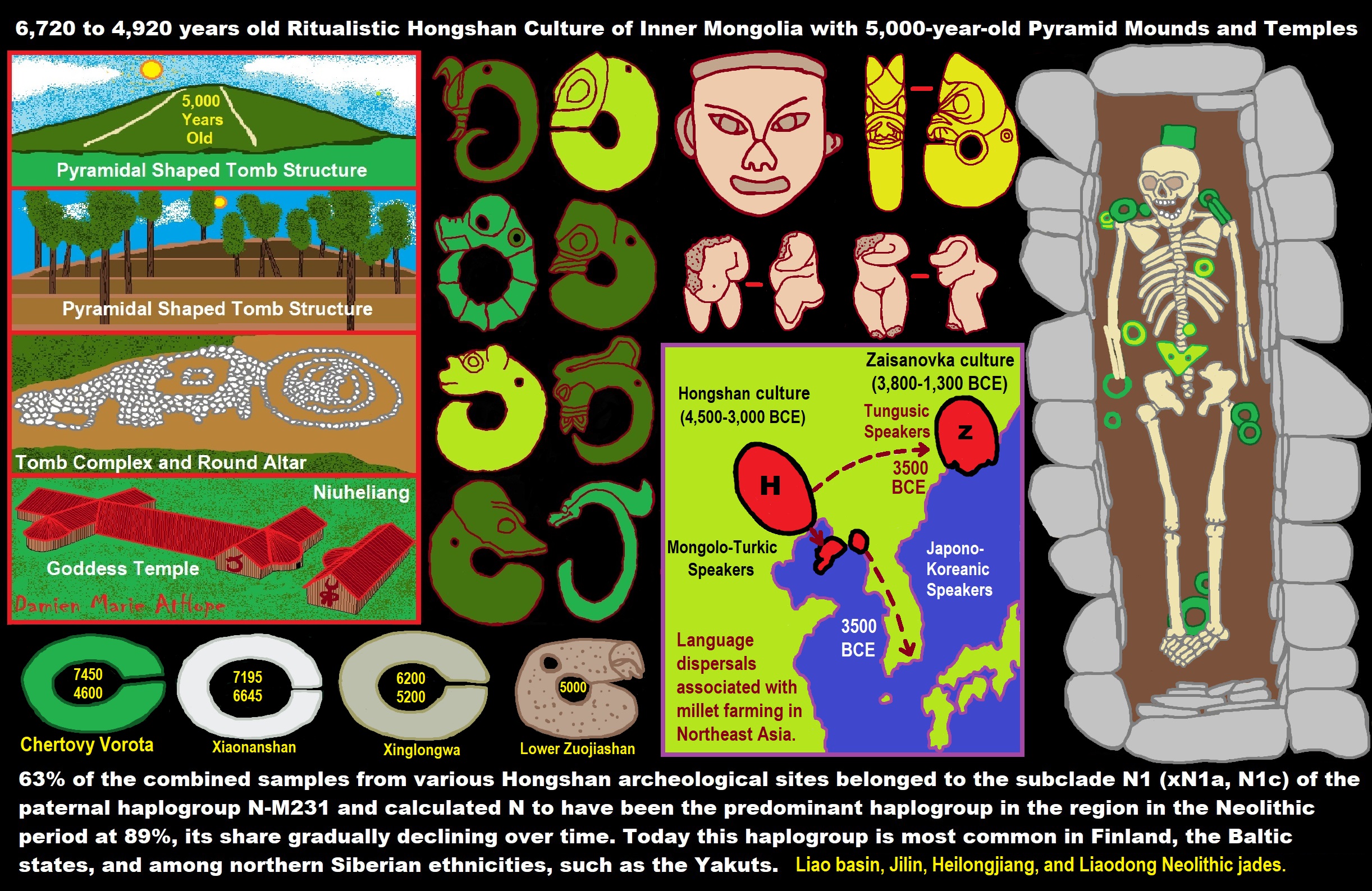
Neolithic cultures of China
“This is a list of Neolithic cultures of China that have been unearthed by archaeologists, however, it would seem that the definition of Neolithic in China is undergoing changes. The discovery in 2012 of pottery about 20,000 years BC indicates that this measure alone can no longer be used to define the period. It will fall to the more difficult task of determining when cereal domestication started. And these cultures existed in a varied range but many differences in opinion by dating these cultures can be offered, so the dates chosen here are tentative.” ref
| Dates (BC) | English name | Chinese name | Modern-day name and location |
|---|---|---|---|
| 18000–7000 | Xianren Cave culture (Paleolithic) |
仙人洞、吊桶环遗址 | Wannian County, Shangrao, Jiangxi |
| 8500–7700 | Nanzhuangtou culture | 南莊頭遺址 | Yellow River region in southern Hebei |
| 7500–6100 | Pengtoushan culture | 彭頭山文化 | central Yangtze region in northwestern Hunan |
| 7000–5000 | Peiligang culture | 裴李崗文化 | Yi-Luo river basin valley in Henan |
| 6500–5500 | Houli culture | 後李文化 | Shandong |
| 6200–5400 | Xinglongwa culture | 興隆洼文化 | Inner Mongolia–Liaoning border |
| 6000–5000 | Kuahuqiao culture | 跨湖桥文化 | Zhejiang |
| 6000–5500 | Cishan culture | 磁山文化 | southern Hebei |
| 5800–5400 | Dadiwan culture | 大地灣文化 | Gansu and western Shaanxi |
| 5500–4800 | Xinle culture | 新樂文化 | lower Liao River on the Liaodong Peninsula |
| 5400–4500 | Zhaobaogou culture | 趙宝溝文化 | Luan River valley in Inner Mongolia and northern Hebei |
| 5300–4100 | Beixin culture | 北辛文化 | Shandong |
| 5000–4500 | Hemudu culture | 河姆渡文化 | Yuyao and Zhoushan, Zhejiang |
| 5000–3000 | Daxi culture | 大溪文化 | Three Gorges region |
| 5000–3000 | Majiabang culture | 馬家浜文化 | Lake Tai area and north of Hangzhou Bay |
| 5000–3000 | Yangshao culture | 仰韶文化 | Henan, Shaanxi, and Shanxi |
| 4700–2900 | Hongshan culture | 紅山文化 | Inner Mongolia, Liaoning, and Hebei |
| 4100–2600 | Dawenkou culture | 大汶口文化 | Shandong, Anhui, Henan, and Jiangsu |
| 3800–3300 | Songze culture | 崧澤文化 | Lake Tai area |
| 3400–2250 | Liangzhu culture | 良渚文化 | Yangtze River Delta |
| 3100–2700 | Majiayao culture | 馬家窯文化 | upper Yellow River region in Gansu and Qinghai |
| 3100–2700 | Qujialing culture | 屈家嶺文化 | middle Yangtze region in Hubei and Hunan |
| 3000–2000 | Longshan culture | 龍山文化 | central and lower Yellow River |
| 2800–2000 | Baodun culture | 寶墩文化 | Chengdu Plain |
| 2500–2000 | Shijiahe culture | 石家河文化 | middle Yangtze region in Hubei |
| 1900–1500 | Yueshi culture | 岳石文化 | lower Yellow River region in Shandong |
Neolithic signs in China
“Since the second half of the 20th century, inscriptions have been found on pottery in a variety of locations in China, such as Banpo near Xi’an, as well as on bone and bone marrows at Hualouzi, Chang’an County near Xi’an. These simple, often geometric, marks have been frequently compared to some of the earliest known Chinese characters appearing on the oracle bones, and some have taken them to mean that the history of Chinese writing extends back over six millennia. However, only isolated instances of these symbols have been found, and they show no indication of representing speech or of the non-pictorial processes that a writing system requires.” ref
Oracle bone (pieces of ox scapula and turtle plastron)
“Oracle bones (Chinese: 甲骨; pinyin: jiǎgǔ) are pieces of ox scapula and turtle plastron, which were used for pyromancy – a form of divination – in ancient China, mainly during the late Shang dynasty. Scapulimancy is the correct term if ox scapulae were used for the divination, plastromancy if turtle plastrons were used. Diviners would submit questions to deities regarding future weather, crop planting, the fortunes of members of the royal family, military endeavors, and other similar topics. These questions were carved onto the bone or shell in oracle bone script using a sharp tool. Intense heat was then applied with a metal rod until the bone or shell cracked due to thermal expansion. The diviner would then interpret the pattern of cracks and write the prognostication upon the piece as well. Pyromancy with bones continued in China into the Zhou dynasty, but the questions and prognostications were increasingly written with brushes and cinnabar ink, which degraded over time.” ref
“The oracle bones bear the earliest known significant corpus of ancient Chinese writing, using an early form of Chinese characters. The inscriptions contain around 5,000 different characters, though only about 1,200 of them have been identified with certainty. They provide important information on the late Shang period, and scholars have reconstructed the Shang royal genealogy from the cycle of ancestral sacrifices they record. When they were discovered in the end of the nineteenth century and deciphered in the early twentieth century, these records confirmed the existence of the Shang, which some scholars had until then doubted. Oraculology is the discipline for the study of Oracle bones and the Oracle bone script. When deciphered, the inscriptions on the oracle bones turned out to be the records of the divinations performed for or by the royal household. These, together with royal-sized tombs, proved beyond a doubt for the first time the existence of the Shang dynasty, which had recently been doubted, and the location of its last capital, Yin. Today, Xiǎotún at Anyang is thus also known as the Ruins of Yin, or Yinxu.” ref
“At a range of Neolithic sites in China, small numbers of symbols of either pictorial or simple geometric nature have been unearthed which were incised into or drawn or painted on artifacts, mostly on pottery but in some instances on turtle shells, animal bones or artifacts made from bone or jade. These sites include those pertaining to the cultures of Yangshao, Liangzhu, Majiayao, and Longshan. There is not scholarly consensus on whether such symbols are writing, primitive or proto-writing, or merely non-writing symbols for other purposes, such as identification. Proponents of the view that they are early Chinese writing tend to see evidence in comparisons of individual signs with individual oracle bone script characters. Others believe that Neolithic signs are part of an incipient semiotic system that eventually led to the development of mature Chinese writing.” ref
“William G. Boltz of the University of Washington’s Department of Asian Languages and Literature points out that such comparisons are “notoriously risky and inconclusive” when based on such primitive scratch marks rather than on similarity in function (2003, p. 38). Boltz adds:
“There does not seem to be any meaningful order of repetition or concatenation that would lead us to suspect anything more than that these are random and largely unorganized, unsystematic markings.” — p.35” ref
“In general, the Neolithic symbols which have been unearthed to date are found in isolated use (as would be expected with ownership marks or clan symbols) rather than in sequences consistent with representation of the spoken language, and there is no evidence of processes fundamental to the beginnings of a true, useful writing system such as phonetic loan usage. As Qiu Xigui (2000, p. 39) explains:
Only when symbols…are consciously used to record words used to form sentences is there a true sign that the development of script has begun.
Furthermore, the evidence is still extremely scanty, even when the early Shang period evidence is added to the picture:
While these materials are very valuable, they are unfortunately few in number and most of them are rather fragmentary so that they are far from being able to provide an ample basis for solving the problem of the formation of Chinese writing. — Qiu 2000, pp.29–30” ref
“It is still safe to conclude that the earliest known undisputed examples of true writing in China (that is, symbols used to fully record language rather than isolated meanings) are the oracle bones of the late Shang dynasty, c. 1250 BCE.” ref
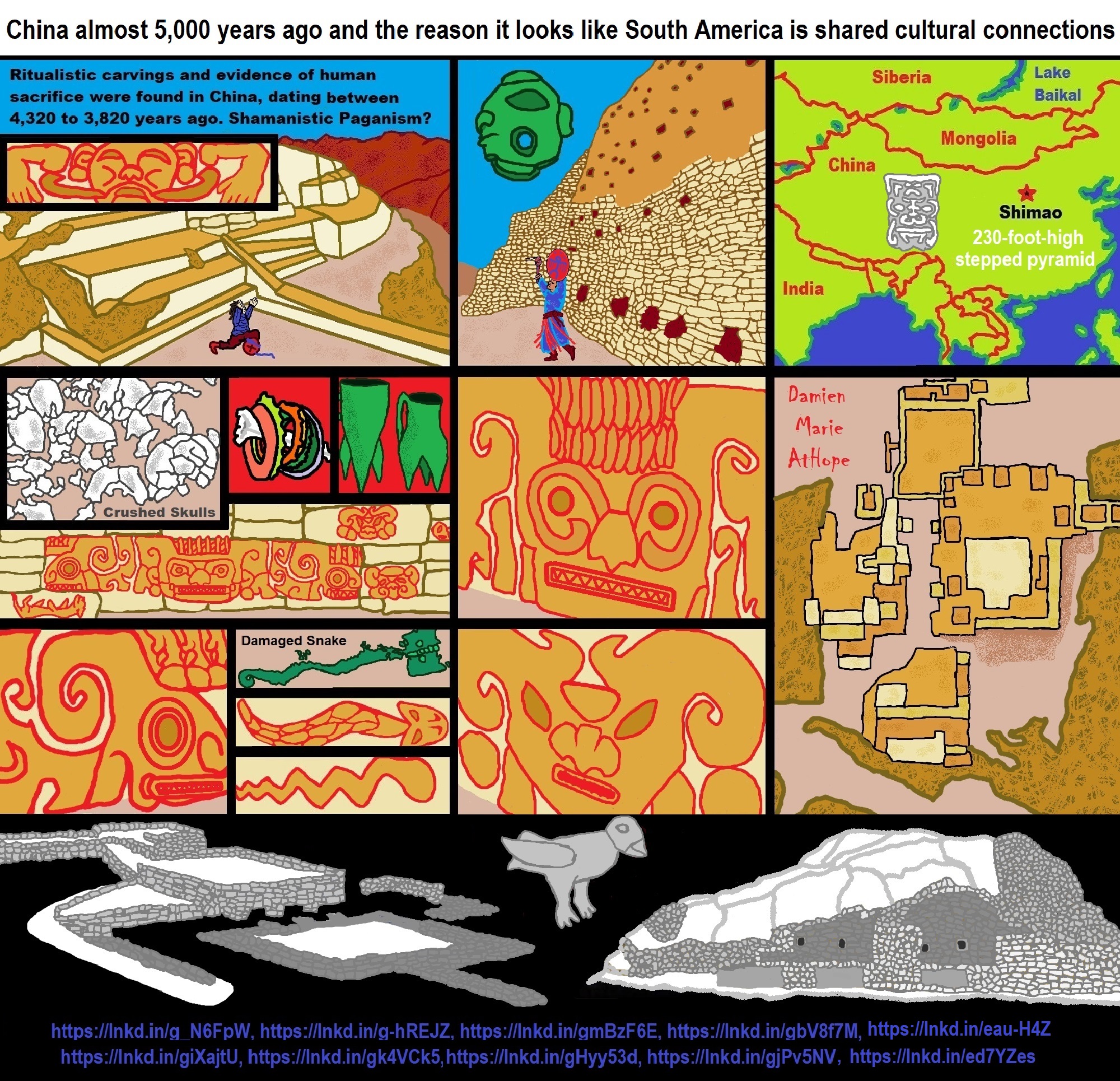
Paganism? Siberian Shamanism migrated to Turkey and then emerged as Paganism because of Agriculture.
Shimao
“Shimao is a site in Shenmu County, Shaanxi, China. The site is located in the northern part of the Loess Plateau, on the southern edge of the Ordos Desert. It is dated to around 2000 BCE or around 4,000 years ago or so, near the end of the Longshan period, and is the largest known walled site of that period in China, at 400 ha. The fortifications of Shimao were originally believed by to be a section of the Great Wall of China, but the discovery of jade pieces prompted an archaeological investigation.” ref
“The city was surrounded by inner and outer stone walls, in contrast to the rammed earth walls typical of Longshan sites in the Central Plain and Shandong. The walls were 2.5 meters thick on average, with perimeters of approximately 4200 m and 5700 m respectively, and feature gates, turrets, and watchtowers. The earliest site, the “palace center”, was a large stepped pyramid based on a loess hill which had been reworked to make 11 platforms, with a height of 70m. Each of these was reinforced by stone buttresses. At the top of this pyramid palaces of rammed earth were built. The inner city contained a stone-walled platform, interpreted as a palatial complex, and densely packed residential zones, cemeteries, and craft workshops. Unusual features include jade embedded in the city walls, possibly to provide spiritual protection, relief sculptures of serpents and monsters, and paintings of geometrical patterns on the inner walls. Approximately 80 human skulls were found under the city gate, mainly of young girls, suggesting ritual sacrifice.” ref
“Developments such as bronze working, wheat, barley, sheep, goats, and cattle seem to appear here earlier than elsewhere in China, showing that its inhabitants were communicating with Eurasian Steppe peoples across extensive trade networks. Additionally, materials likely from Southern China, such as alligator skin drums, have been found, indicating a north-south commerce across what is now modern China. Thin curved bones discovered at Shimao are believed to be the earliest known evidence of the jaw harp, an instrument that has spread to over 100 different ethnic groups, suggesting possible Chinese origins.” ref
“The prevailing hypothesis concerning the abandonment of Shimao is tied to a rapid shift to a cooler, drier climate on the Loess Plateau, from 2000 to 1700 BCE. This environmental change likely led populations to shift to the Central Plain, leaving the site to be forgotten until the 21st century.” ref
Mysterious carvings and evidence of human sacrifice uncovered in the ancient city of Shimao
Neolithic City of Shimao in Shaanxi Province, China
China’s Shimao ruins among top 10 archaeological finds of the past decade
Shimao: Massive Pyramid, Lost City, and Ancient Human Sacrifices Unearthed in China
Shimao and Erlitou: new perspectives on the origins of the bronze industry in central China
Shimao, a 4,300-year-old Chinese City Built with Ritual Stones
‘Pyramid of eyes’ discovered at the heart of the 4,300-year-old city of Shimao in northern China
Large-Scale Cemetery Of Shimao Culture Found In NW China
The first Neolithic urban center on China’s north Loess Plateau: The rise and fall of Shimao
Who is that Human at Shimao? China’s Ancient Belief in Metamorphic Power

ref, ref, ref, ref, ref, ref, ref, ref
Sky Burials: Animism, Totemism, Shamanism, and Paganism
“In archaeology and anthropology, the term excarnation (also known as defleshing) refers to the practice of removing the flesh and organs of the dead before burial, leaving only the bones. Excarnation may be precipitated through natural means, involving leaving a body exposed for animals to scavenge, or it may be purposefully undertaken by butchering the corpse by hand. Practices making use of natural processes for excarnation are the Tibetan sky burial, Comanche platform burials, and traditional Zoroastrian funerals (see Tower of Silence). Some Native American groups in the southeastern portion of North America practiced deliberate excarnation in protohistoric times. Archaeologists believe that in this practice, people typically left the body exposed on a woven litter or altar.” ref
Ancient Headless Corpses Were Defleshed By Griffon Vultures
Sky burial ( Animal Worship mixed with Ancestor Worship) is a funeral practice where a human corpse is placed on a mountaintop, elevated ground, tree, or constructed perch to decompose while be eaten by scavenging animals, especially birds. This Animal Worship (or Zoolatry) rituals may go back to the Neanderthals who seem to Sacralize birds starting around 130,000 years ago in Croatia with eagle talon jewelry and oldest confirmed burial. Or possible (Aurignacian) “Bird Worship” at Hohle Fels cave, Germany, early totemism and small bird figurine at around 33,000 years old, which had been cited as evidence of shamanism.
As well as possible ‘Bird Worship’ (in the Pavlovian culture/Gravettian culture) part of Early Shamanism at Dolní Věstonice (Czech Republic) from around 31,000-25,000 years ago, which held the “first shaman burial.” The shamanistic Mal’ta–Buret’ culture of Siberia, dating to 24,000-15,000 years ago, who connect to the indigenous peoples of the Americas show Bird Worship. The Magdalenian cultures in western Europe, dating from around 17,000-12,000 years ago have a famous artistic mural with a bird that I think could relate to reincarnation and at least bird symbolism. Likewise, there is evidence of possible ‘Bird Worship’ at Göbekli Tepe (Turkey), dated to around 13,000/11,600-9,370 Years ago with “first human-made temple” and at Çatalhöyük (Turkey), dated to around 9,500-7,700 Years ago with “first religious designed city” both with seeming ancestor, animal, and possible goddess worship.
The Tibetan sky-burials appear to have evolved from ancient practices of defleshing corpses as discovered in archeological finds in the region. These practices most likely came out of practical considerations, but they could also be related to more ceremonial practices similar to the suspected sky burial evidence found at Göbekli Tepe (11,500 years ago) and Stonehenge (4,500 years ago). ref
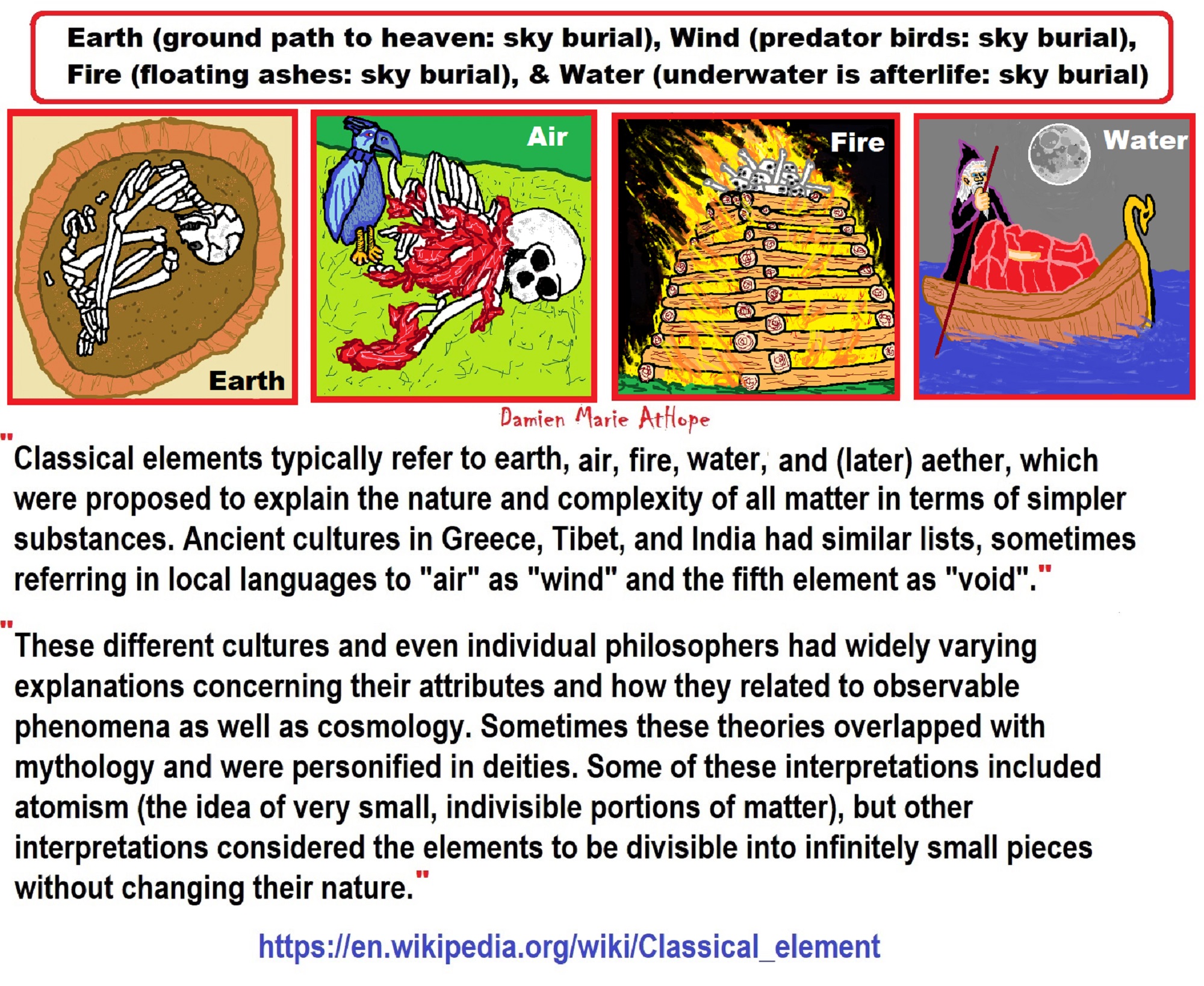
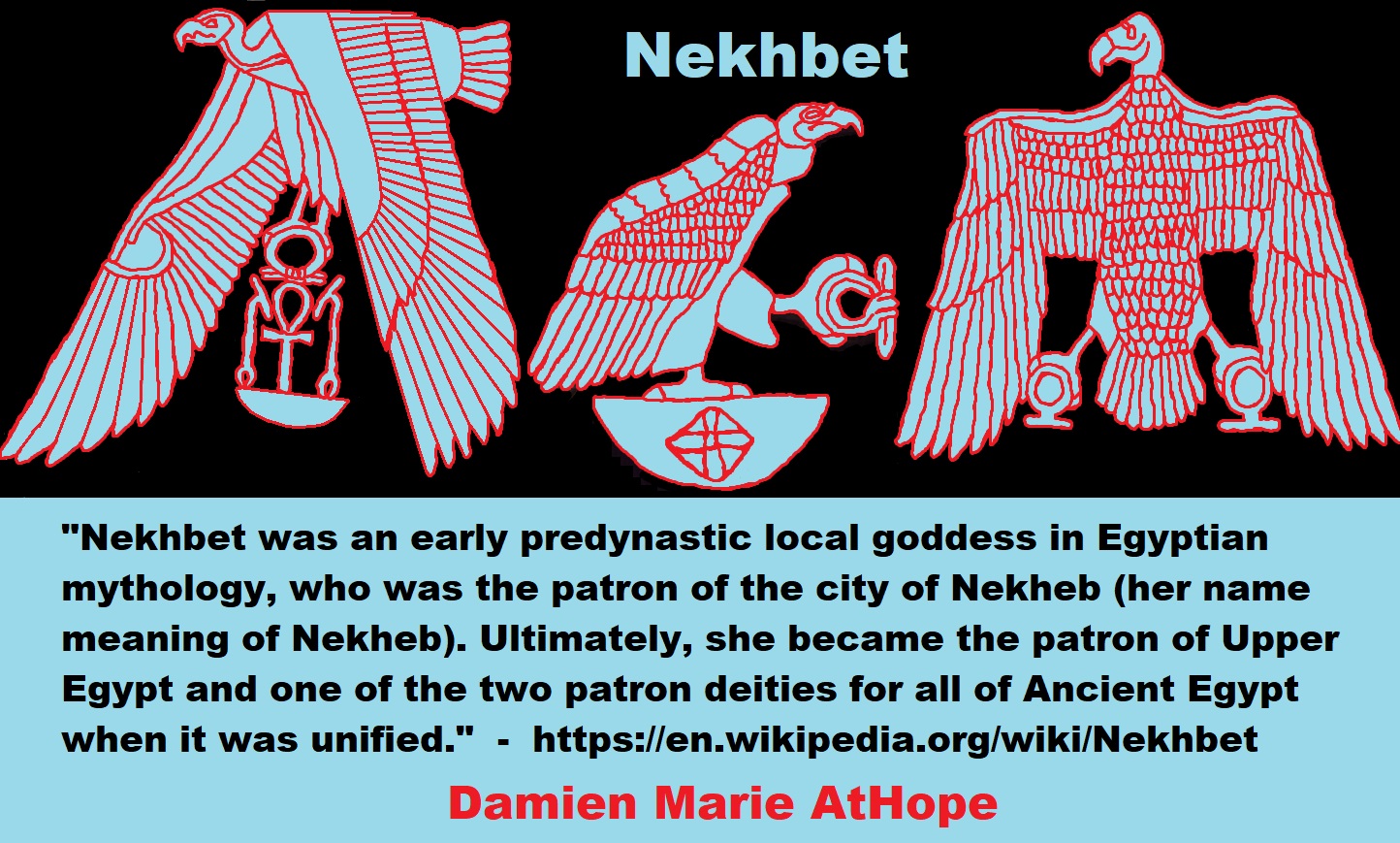
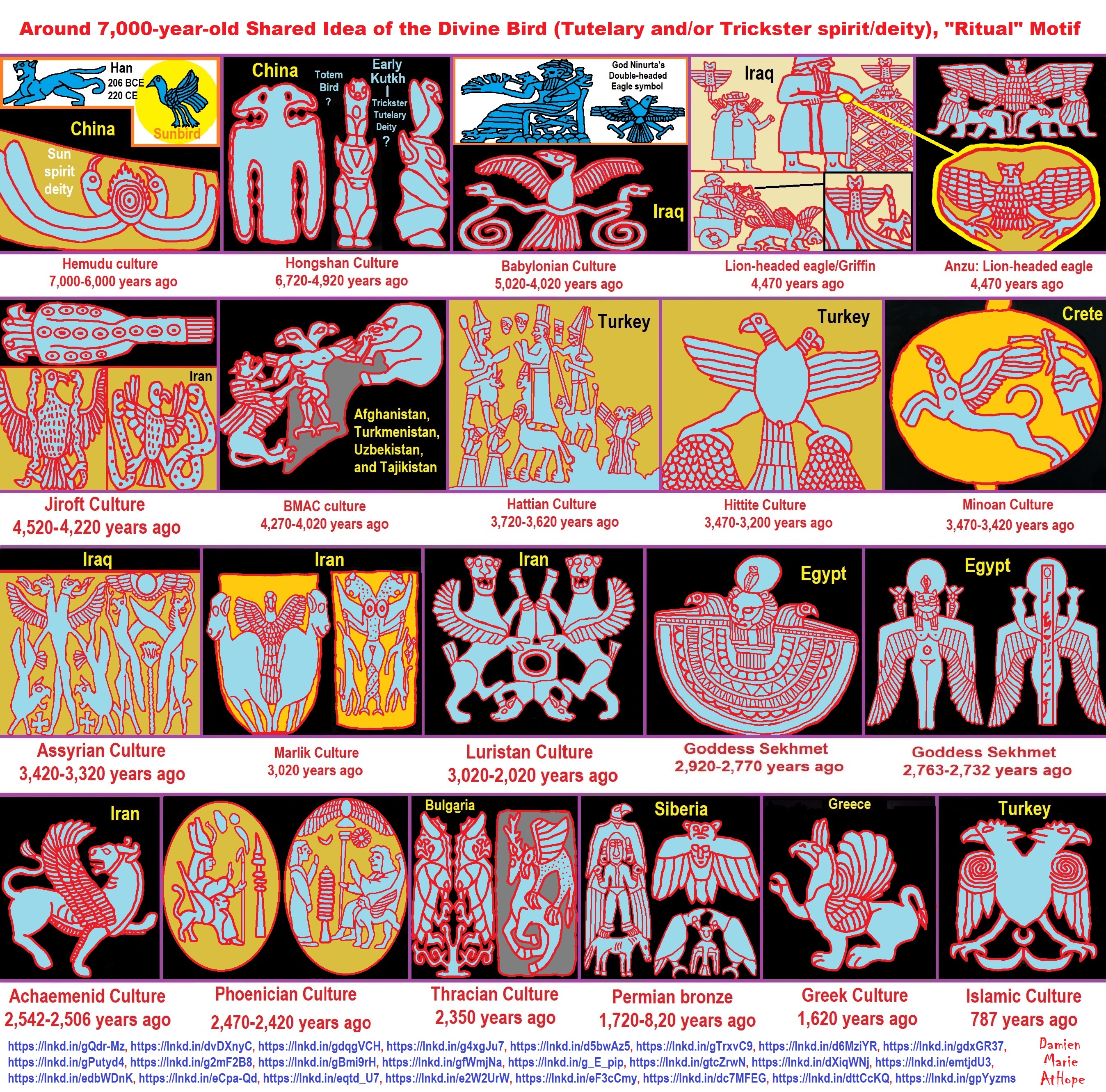
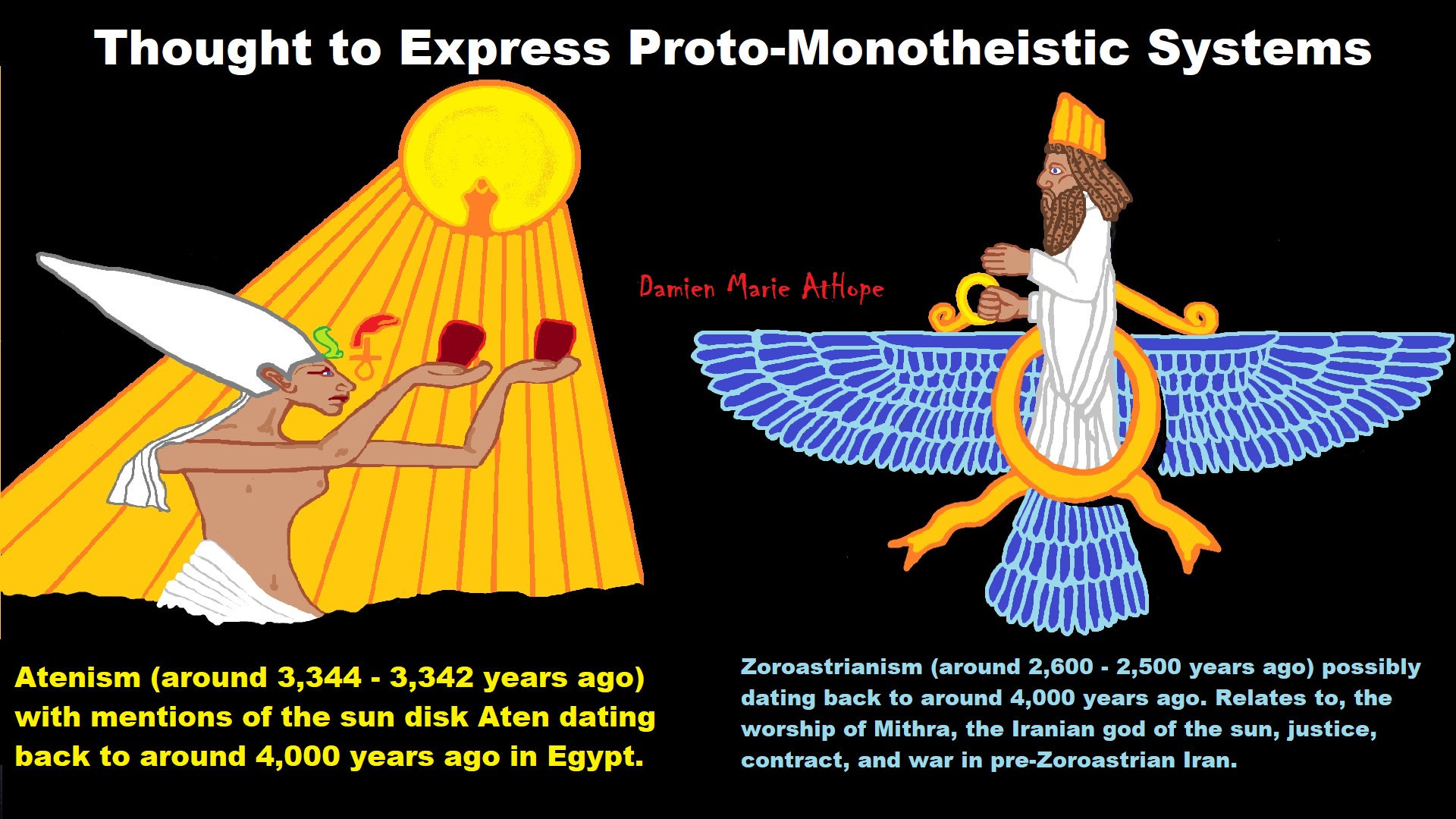
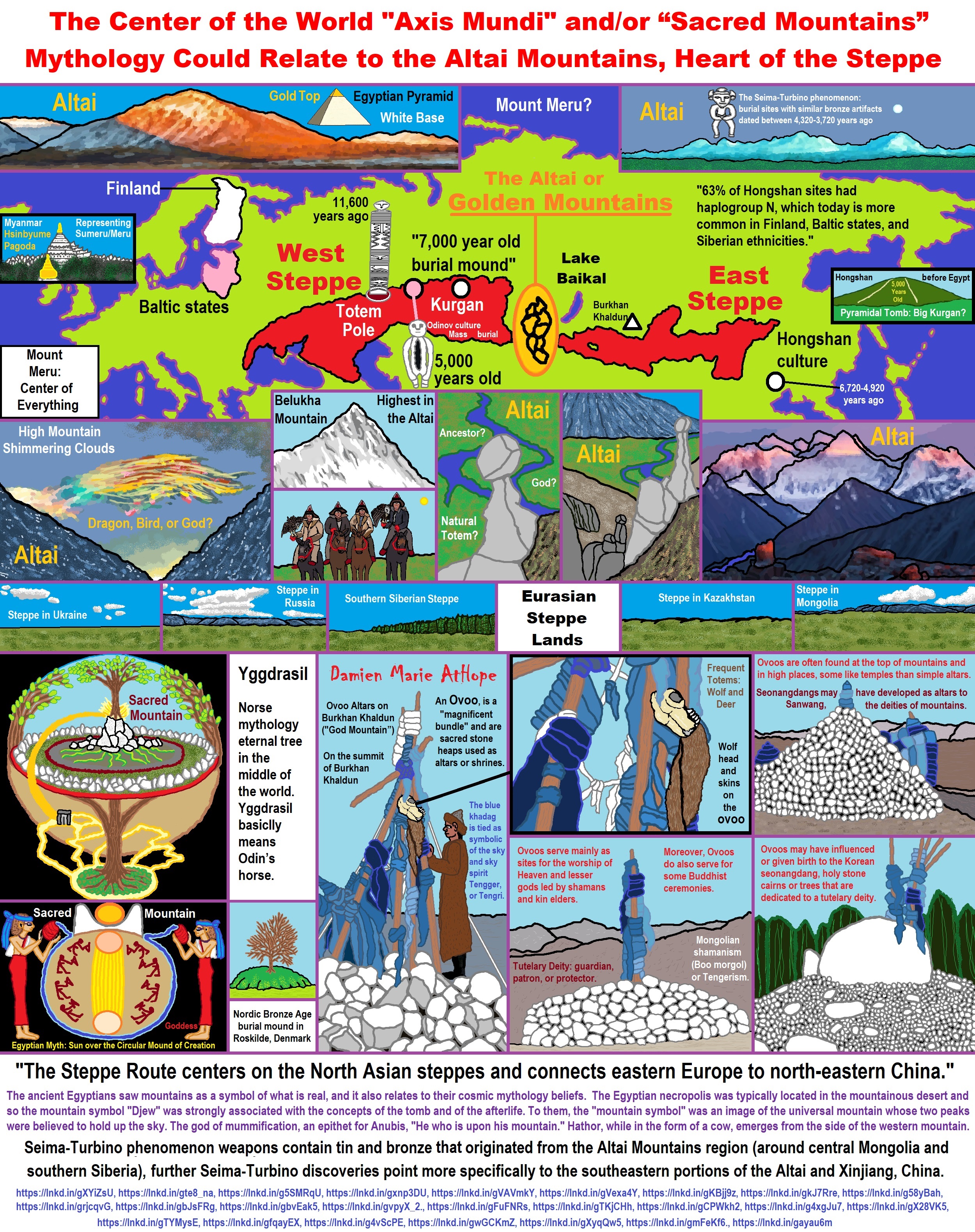
Axis Mundi
“In astronomy, axis mundi is the Latin term for the axis of Earth between the celestial poles. In a geocentric coordinate system, this is the axis of rotation of the celestial sphere. Consequently, in ancient Greco-Roman astronomy, the axis mundi is the axis of rotation of the planetary spheres within the classical geocentric model of the cosmos. In 20th-century comparative mythology, the term axis mundi – also called the cosmic axis, world axis, world pillar, center of the world, or world tree – has been greatly extended to refer to any mythological concept representing “the connection between Heaven and Earth” or the “higher and lower realms”. Mircea Eliade introduced the concept in the 1950s. Axis mundi closely relates to the mythological concept of the omphalos (navel) of the world or cosmos. Items adduced as examples of the axis mundi by comparative mythologists include plants (notably a tree but also other types of plants such as a vine or stalk), a mountain, a column of smoke or fire, or a product of human manufacture (such as a staff, a tower, a ladder, a staircase, a maypole, a cross, a steeple, a rope, a totem pole, a pillar, a spire). Its proximity to heaven may carry implications that are chiefly religious (pagoda, temple mount, minaret, church) or secular (obelisk, lighthouse, rocket, skyscraper). The image appears in religious and secular contexts. The axis mundi symbol may be found in cultures utilizing shamanic practices or animist belief systems, in major world religions, and in technologically advanced “urban centers”. In Mircea Eliade‘s opinion: “Every Microcosm, every inhabited region, has a Centre; that is to say, a place that is sacred above all.” ref
“There are multiple interpretations about the origin of the concept of the axis mundi. One psychological and sociological interpretation suggests that the symbol originates in a natural and universal psychological perception – i.e., that the particular spot that one occupies stands at “the center of the world”. This space serves as a microcosm of order because it is known and settled. Outside the boundaries of the microcosm lie foreign realms that – because they are unfamiliar or not ordered – represent chaos, death, or night. From the center, one may still venture in any of the four cardinal directions, make discoveries, and establish new centers as new realms become known and settled. The name of China — meaning “Middle Nation” (中国 pinyin: Zhōngguó) – is often interpreted as an expression of an ancient perception that the Chinese polity (or group of polities) occupied the center of the world, with other lands lying in various directions relative to it.” ref
“A second interpretation suggests that ancient symbols such as the axis mundi lie in a particular philosophical or metaphysical representation of a common and culturally shared philosophical concept, which is that of a natural reflection of the macrocosm (or existence at grand scale) in the microcosm (which consists of either an individual, community, or local environment that shares the same principles and structures as the macrocosm). In this metaphysical representation of the universe, mankind is placed into an existence that serves as a microcosm of the universe or the entire cosmic existence, and who – in order to achieve higher states of existence or liberation into the macrocosm – must gain necessary insights into universal principles that can be represented by his life or environment in the microcosm.” ref
“In many religious and philosophical traditions around the world, mankind is seen as a sort of bridge between either: two worlds, the earthly and the heavenly (as in Hindu, and Taoist philosophical and theological systems); or three worlds, namely the earthly, heavenly, and the “sub-earthly” or “infra-earthly” (e.g., the underworld, as in the Ancient Greek, Incan, Mayan, and Ancient Egyptian religious systems). Spanning these philosophical systems is the belief that man traverses a sort of axis, or path, which can lead from man’s current central position in the intermediate realms into heavenly or sub-earthly realms. Thus, in this view, symbolic representations of a vertical axis represent a path of “ascent” or “descent” into other spiritual or material realms, and often capture a philosophy that considers human life to be a quest in which one develops insights or perfections in order to move beyond this current microcosmic realm and to engage with the grand macrocosmic order.” ref
“In other interpretations, an axis mundi is more broadly defined as a place of connection between heavenly and the earthly realms – often a mountain or other elevated site. Tall mountains are often regarded as sacred and some have shrines erected at the summit or base. Mount Kunlun fills a similar role in China. Mount Kailash is holy to Hinduism and several religions in Tibet. The Pitjantjatjara people in central Australia consider Uluru to be central to both their world and culture. The Teide volcano was for the Canarian aborigines (Guanches) a kind of axis mundi. In ancient Mesopotamia, the cultures of ancient Sumer and Babylon built tall platforms, or ziggurats, to elevate temples on the flat river plain. Hindu temples in India are often situated on high mountains – e.g., Amarnath, Tirupati, Vaishno Devi, etc. The pre-Columbian residents of Teotihuacán in Mexico erected huge pyramids, featuring staircases leading to heaven.” ref
“These Amerindian temples were often placed on top of caves or subterranean springs, which were thought to be openings to the underworld. Jacob’s Ladder is an axis mundi image, as is the Temple Mount. For Christians, the Cross on Mount Calvary expresses this symbol. The Middle Kingdom, China, had a central mountain, Kunlun, known in Taoist literature as “the mountain at the middle of the world”. To “go into the mountains” meant to dedicate oneself to a spiritual life. As the abstract concept of axis mundi is present in many cultural traditions and religious beliefs, it can be thought to exist in any number of locales at once. Mount Hermon was regarded as the axis mundi in Canaanite tradition, from where the sons of God are introduced descending in 1 Enoch. The ancient Armenians had a number of holy sites, the most important of which was Mount Ararat, which was thought to be the home of the gods as well as the center of the universe.” ref
“Likewise, the ancient Greeks regarded several sites as places of Earth’s omphalos (navel) stone, notably the oracle at Delphi, while still maintaining a belief in a cosmic world tree and in Mount Olympus as the abode of the gods. Judaism has the Temple Mount; Christianity has the Mount of Olives and Calvary; and Islam has the Ka’aba (said to be the first building on Earth), as well as the Temple Mount (Dome of the Rock). In Hinduism, Mount Kailash is identified with the mythical Mount Meru and regarded as the home of Shiva; in Vajrayana Buddhism, Mount Kailash is recognized as the most sacred place where all the dragon currents converge and is regarded as the gateway to Shambhala. In Shinto, the Ise Shrine is the omphalos.” ref
“Sacred places can constitute world centers (omphaloi), with an altar or place of prayer as the axis. Altars, incense sticks, candles, and torches form the axis by sending a column of smoke, and prayer, toward heaven. It has been suggested by Romanian religious historian Mircea Eliade that the architecture of sacred places often reflects this role: “Every temple or palace – and by extension, every sacred city or royal residence – is a Sacred Mountain, thus becoming a Centre.” Pagoda structures in Asian temples take the form of a stairway linking earth and heaven. A steeple in a church or a minaret in a mosque also serves as connections of earth and heaven. Structures such as the maypole, derived from the Saxons‘ Irminsul, and the totem pole among indigenous peoples of the Americas also represent world axes. The calumet, or sacred pipe, represents a column of smoke (the soul) rising from a world center. A mandala creates a world center within the boundaries of its two-dimensional space analogous to that created in three-dimensional space by a shrine. In the classical elements and the Vedic Pancha Bhoota, the axis mundi corresponds to Aether, the quintessence.” ref
“Plants often serve as images of the axis mundi. The image of the Cosmic Tree provides an axis symbol that unites three planes: sky (branches), earth (trunk), and underworld (roots). In some Pacific Island cultures, the banyan tree – of which the Bodhi tree is of the Sacred Fig variety – is the abode of ancestor spirits. In Hindu religion, the banyan tree is considered sacred and is called ashwath vriksha (“Of all trees I am the banyan tree” – Bhagavad Gita). It represents eternal life because of its seemingly ever-expanding branches. The Bodhi tree is also the name given to the tree under which Gautama Siddhartha, the historical Buddha, sat on the night he attained enlightenment. The Mesoamerican world tree connects the planes of the underworld and the sky with that of the terrestrial realm.” ref
“The Yggdrasil, or World Ash, functions in much the same way in Norse mythology; it is the site where Odin found enlightenment. Other examples include Jievaras in Lithuanian mythology and Thor’s Oak in the myths of the pre-Christian Germanic peoples. The Tree of Life and the Tree of Knowledge of Good and Evil in Genesis present two aspects of the same image. Each is said to stand at the center of the paradise garden from which four rivers flow to nourish the whole world. Each tree confers a boon. Bamboo, the plant from which Asian calligraphy pens are made, represents knowledge and is regularly found on Asian college campuses. The Christmas tree, which can be traced in its origins back to pre-Christian European beliefs, represents an axis mundi.” ref
“The human body can express the symbol of the world axis. Some of the more abstract Tree of Life representations, such as the sefirot in Kabbalism and the chakra system recognized by Hinduism and Buddhism, merge with the concept of the human body as a pillar between heaven and earth. Disciplines such as yoga and tai chi begin from the premise of the human body as axis mundi. The Buddha represents a world center in human form. Large statues of a meditating figure unite the human form with the symbolism of the temple and tower. Astrology in all its forms assumes a connection between human health and affairs and celestial-body orientation. World religions regard the body itself as a temple and prayer as a column uniting earth and heaven. The ancient Colossus of Rhodes combined the role of the human figure with those of portal and skyscraper. The Renaissance image known as the Vitruvian Man represented a symbolic and mathematical exploration of the human form as world axis.” ref
“Secular structures can also function as axes mundi. In Navajo culture, the hogan acts as a symbolic cosmic center. In some Asian cultures, houses were traditionally laid out in the form of a square oriented toward the four compass directions. A traditional home was oriented toward the sky through feng shui, a system of geomancy, just as a palace would be. Traditional Arab houses are also laid out as a square surrounding a central fountain that evokes a primordial garden paradise. Mircea Eliade noted that “the symbolism of the pillar in [European] peasant houses likewise derives from the ‘symbolic field’ of the axis mundi. In many archaic dwellings the central pillar does in fact serve as a means of communication with the heavens, with the sky.” The nomadic peoples of Mongolia and the Americas more often lived in circular structures. The central pole of the tent still operated as an axis, but a fixed reference to the four compass points was avoided.” ref
“A common shamanic concept, and a universally told story, is that of the healer traversing the axis mundi to bring back knowledge from the other world. It may be seen in the stories from Odin and the World Ash Tree to the Garden of Eden and Jacob’s Ladder to Jack and the Beanstalk and Rapunzel. It is the essence of the journey described in The Divine Comedy by Dante Alighieri. The epic poem relates its hero’s descent and ascent through a series of spiral structures that take him through the core of the earth, from the depths of hell to celestial paradise. It is also a central tenet in the Southeastern Ceremonial Complex. Anyone or anything suspended on the axis between heaven and earth becomes a repository of potential knowledge. A special status accrues to the thing suspended: a serpent, a rod, a fruit, mistletoe. Derivations of this idea find form in the Rod of Asclepius, an emblem of the medical profession, and in the caduceus, an emblem of correspondence and commercial professions. The staff in these emblems represents the axis mundi, while the serpents act as guardians of, or guides to, knowledge.” ref
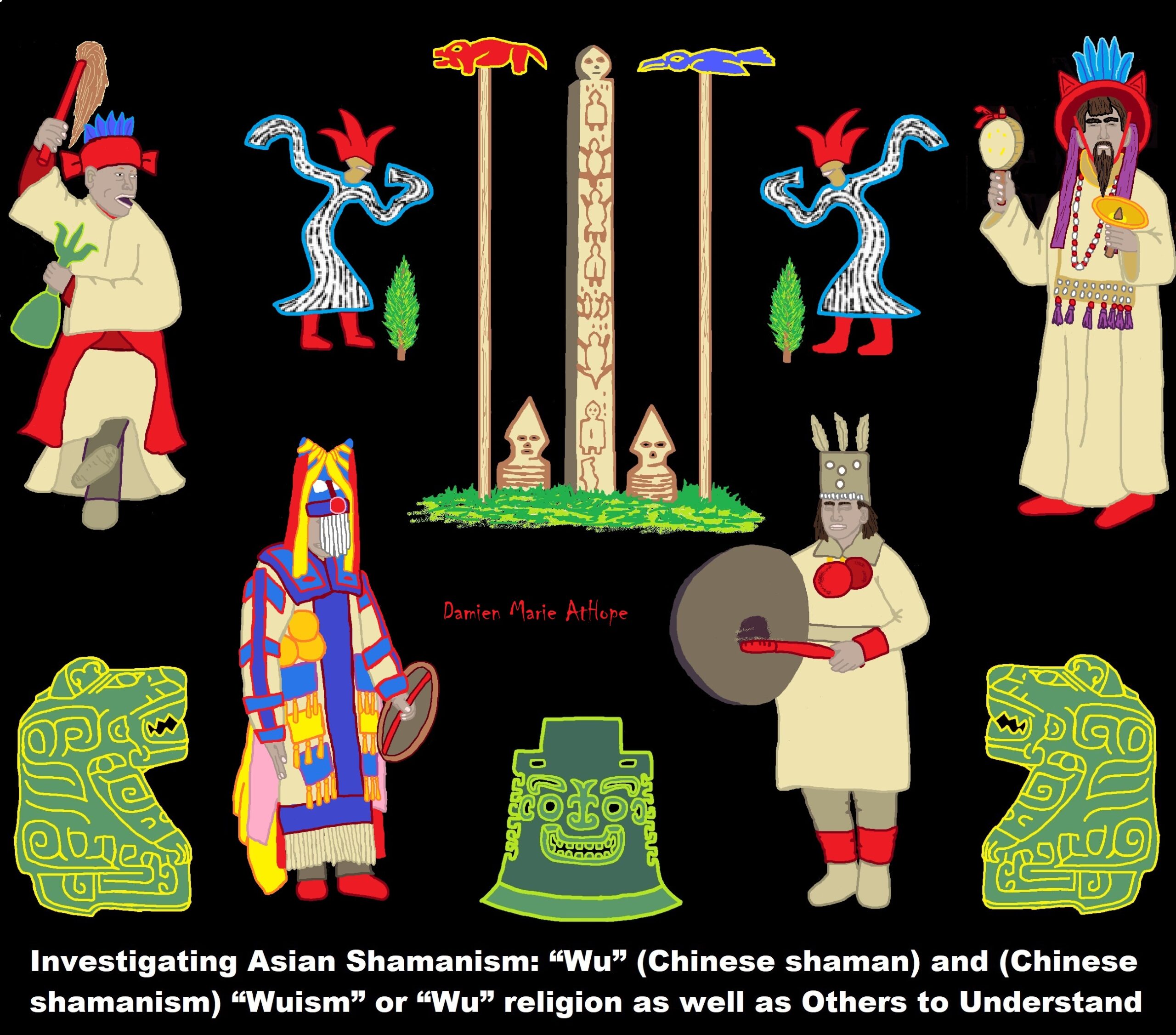
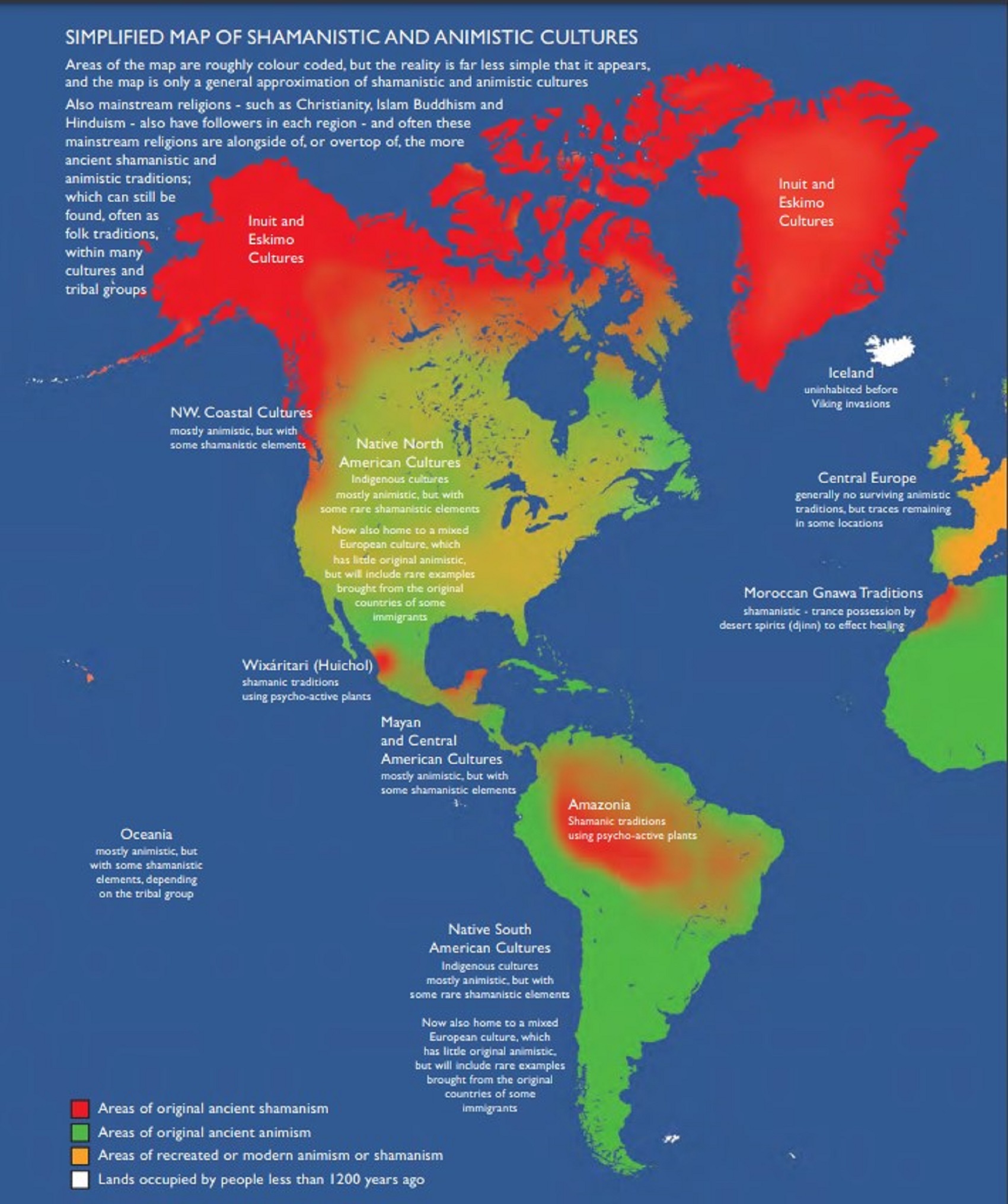
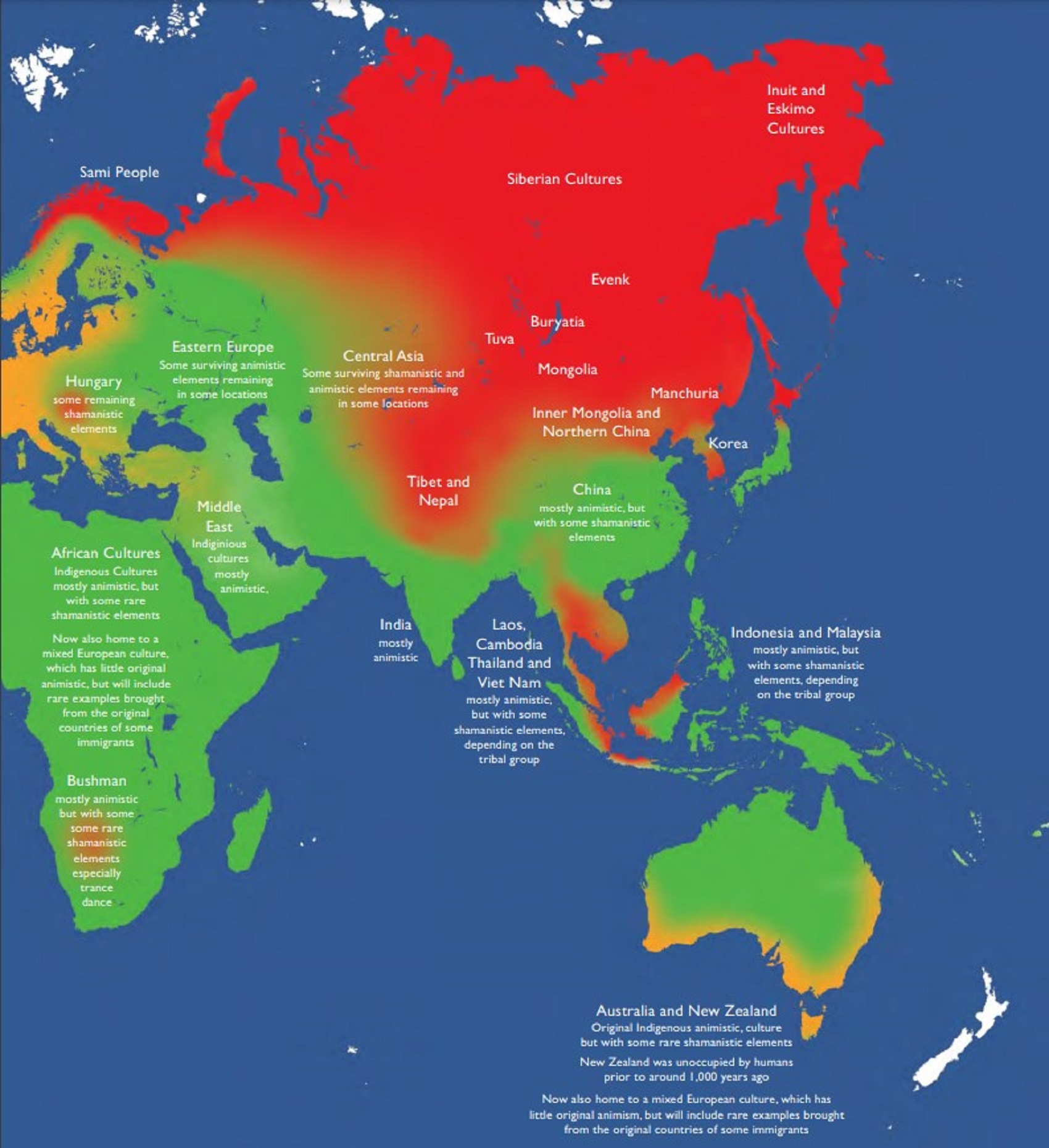
Shamanistic and Animistic Cultures map by “The Shamanism Magazine” (http://SacredHoop.org)
https://sacredhoop.org/Free-Guide-To-Shamanism/Sacred-Hoop-Free-Guide-To-Shamanism.pdf
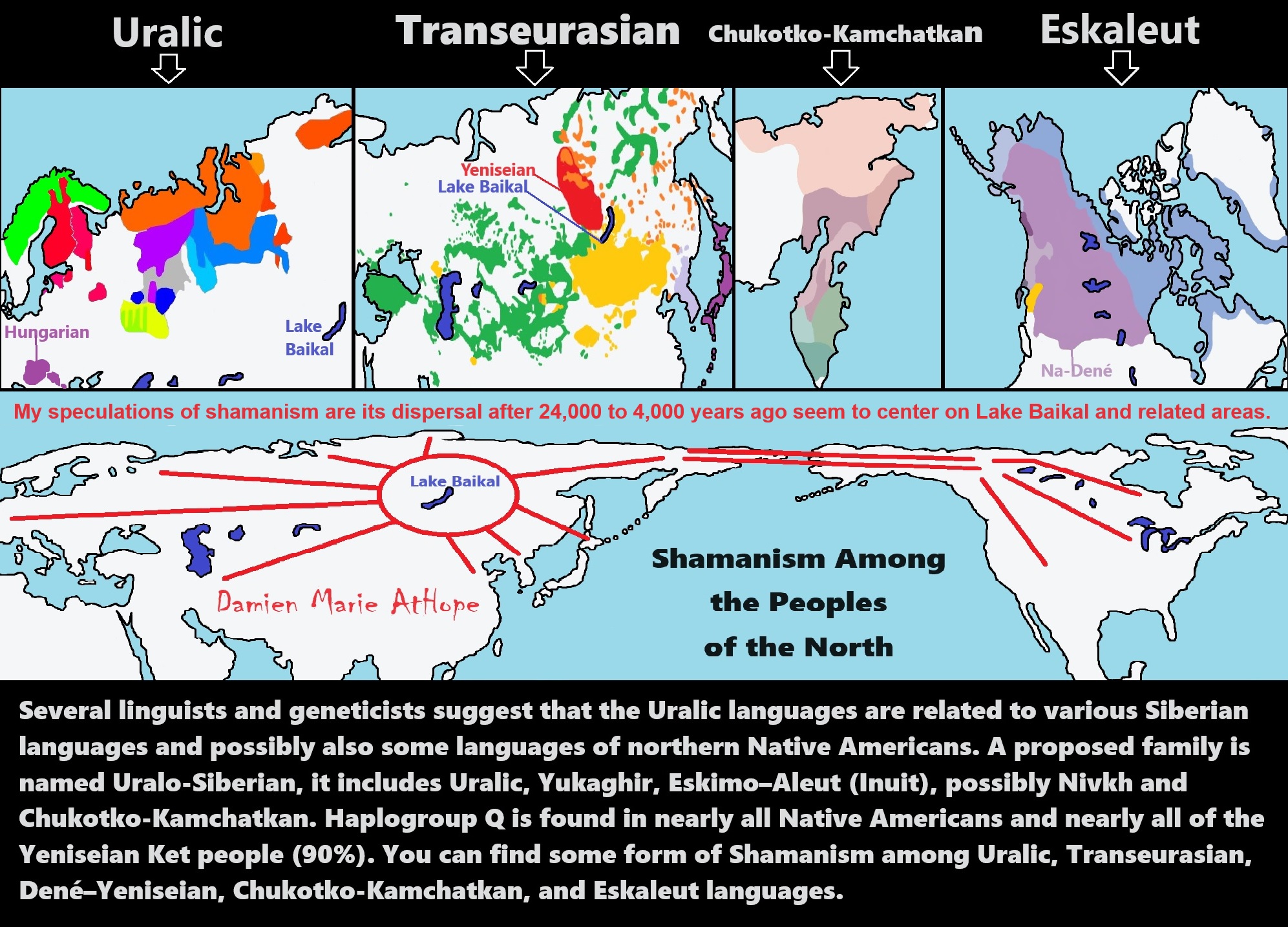
ref, ref, ref, ref, ref, ref, ref, ref, ref
“Several linguists and geneticists suggest that the Uralic languages are related to various Siberian languages and possibly also some languages of northern Native Americans. A proposed family is named Uralo-Siberian, it includes Uralic, Yukaghir, Eskimo–Aleut (Inuit), possibly Nivkh, and Chukotko-Kamchatkan. Haplogroup Q is found in nearly all Native Americans and nearly all of the Yeniseian Ket people (90%).” ref, ref
You can find some form of Shamanism, among Uralic, Transeurasian, Dené–Yeniseian, Chukotko-Kamchatkan, and Eskaleut languages.
My speculations of shamanism are its dispersals, after 24,000 to 4,000 years ago, seem to center on Lake Baikal and related areas. To me, the hotspot of Shamanism goes from west of Lake Baikal in the “Altai Mountains” also encompassing “Lake Baikal” and includes the “Amur Region/Watershed” east of Lake Baikal as the main location Shamanism seems to have radiated out from.

“1 central Eurasian Neolithic individual from Tajikistan (around 8,000 years ago) and approximately 8,200 years ago Yuzhniy Oleniy Ostrov group from Karelia in western Russia formed by 19 genomes affinity to Villabruna ancestry than all the other Eastern Hunter-Gatherer groups” https://www.nature.com/articles/s41586-023-05726-0
Eastern Hunter-Gatherer?
“In archaeogenetics, the term Eastern Hunter-Gatherer (EHG), sometimes East European Hunter-Gatherer, or Eastern European Hunter-Gatherer is the name given to a distinct ancestral component that represents descent from Mesolithic hunter-gatherers of Eastern Europe. The Eastern Hunter Gatherer genetic profile can be modeled as an admixture between a Siberian Paleolithic population called Ancient North Eurasians (ANE) with European Western Hunter-Gatherers (WHG), although the relationship between the ANE and EHG ancestral components is not yet well understood due to lack of samples that could bridge the spatiotemporal gap. During the Mesolithic, the EHGs inhabited an area stretching from the Baltic Sea to the Urals and downwards to the Pontic–Caspian steppe.” ref
“Along with Scandinavian Hunter-Gatherers (SHG) and Western Hunter-Gatherers (WHG), the EHGs constituted one of the three main genetic groups in the postglacial period of early Holocene Europe. The border between WHGs and EHGs ran roughly from the lower Danube, northward along the western forests of the Dnieper towards the western Baltic Sea. During the Neolithic and early Eneolithic, likely during the 4th millennium BC EHGs on the Pontic–Caspian steppe mixed with Caucasus hunter-gatherers (CHGs) with the resulting population, almost half-EHG and half-CHG, forming the genetic cluster known as Western Steppe Herder (WSH). WSH populations closely related to the people of the Yamnaya culture are supposed to have embarked on a massive migration leading to the spread of Indo-European languages throughout large parts of Eurasia.” ref
“Haak et al. (2015) identified the Eastern Hunter-Gatherers (EHG) as a distinct genetic cluster in two males only. The EHG male of Samara (dated to ca. 5650-5550 BCE) carried Y-haplogroup R1b1a1a* and mt-haplogroup U5a1d. The other EHG male, buried in Karelia (dated to ca. 5500-5000 BCE) carried Y-haplogroup R1a1 and mt-haplogoup C1g. The authors of the study also identified a Western Hunter-Gatherer (WHG) cluster and a Scandinavian Hunter-Gatherer (SHG) cluster, intermediate between WHG and EHG. Also, Lazaridis et al. (2016) confirmed SHGs to be a mix of EHGs and WHGs. They suggested that EHGs harbored mixed ancestry from Ancient North Eurasians (ANEs) and WHGs. The people of the Yamnaya culture were found to be a mix of EHG and a “Near Eastern related population”. During the 3rd millennium BC, the Yamnaya people embarked on a massive expansion throughout Europe, which significantly altered the genetic landscape of the continent. The expansion gave rise to cultures such as Corded Ware, and was possibly the source of the distribution of Indo-European languages in Europe.” ref
“EHGs may have mixed with “an Armenian-like Near Eastern source”, which formed the Yamnaya culture, as early as the Eneolithic (5200-4000 BCE). Researchers have found that EHGs may have derived different amounts of their ancestry from WHGs and ANEs. Their relationship to the WHG and ANE is not well clarified. The people of the Mesolithic Kunda culture and the Narva culture of the eastern Baltic were a mix of WHG and EHG, showing the closest affinity with WHG. Samples from the Ukrainian Mesolithic and Neolithic were found to cluster tightly together between WHG and EHG, suggesting genetic continuity in the Dnieper Rapids for a period of 4,000 years. The Ukrainian samples belonged exclusively to the maternal haplogroup U, which is found in around 80% of all European hunter-gatherer samples.” ref
“The people of the Pit–Comb Ware culture (PCW/CCC) of the eastern Baltic bear 65% EHG ancestry. This is in contrast to earlier hunter-gatherers in the area, who were more closely related to WHG. This was demonstrated using a sample of Y-DNA extracted from a Pit–Comb Ware individual. This belonged to R1a15-YP172. The four samples of mtDNA extracted constituted two samples of U5b1d1, one sample of U5a2d, and one sample of U4a. Günther et al. (2018) analyzed 13 SHGs and found all of them to be of EHG ancestry. Generally, SHGs from western and northern Scandinavia had more EHG ancestry (ca 49%) than individuals from eastern Scandinavia (ca. 38%). The authors suggested that the SHGs were a mix of WHGs who had migrated into Scandinavia from the south, and EHGs who had later migrated into Scandinavia from the northeast along the Norwegian coast. SHGs displayed higher frequencies of genetic variants that cause light skin (SLC45A2 and SLC24A5), and light eyes (OCA/Herc2), than WHGs and EHGs.” ref
“Members of the Kunda culture and Narva culture were also found to be more closely related with WHG, while the Pit–Comb Ware culture was more closely related to EHG. Northern and eastern areas of the eastern Baltic were found to be more closely related to EHG than southern areas. The study noted that EHGs, like SHGs and Baltic hunter-gatherers, carried high frequencies of the derived alleles for SLC24A5 and SLC45A2, which are codings for light skin. Mathieson et al. (2018) analyzed the genetics of a large number of skeletons of prehistoric Eastern Europe. Thirty-seven samples were from Mesolithic and Neolithic Ukraine (9500-6000 BC). These were classified as intermediate between EHG and SHG. The males belonged exclusively to R haplotypes (particularly subclades of R1b1 and R1a) and I haplotypes (particularly subclades of I2). Mitochondrial DNA belonged almost exclusively to U (particularly subclades of U5 and U4).” ref
“A large number of individuals from the Zvejnieki burial ground, which mostly belonged to the Kunda culture and Narva culture in the eastern Baltic, were analyzed. These individuals were mostly of WHG descent in the earlier phases, but over time EHG ancestry became predominant. The Y-DNA of this site belonged almost exclusively to haplotypes of haplogroup R1b1a1a and I2a1. The mtDNA belonged exclusively to haplogroup U (particularly subclades of U2, U4 and U5). Forty individuals from three sites of the Iron Gates Mesolithic in the Balkans were estimated to be of 85% WHG and 15% EHG descent. The males at these sites carried exclusively R1b1a and I (mostly subclades of I2a) haplotypes. mtDNA belonged mostly to U (particularly subclades of U5 and U4).” ref
“People of the Cucuteni–Trypillia culture were found to harbor about 20% hunter-gatherer ancestry, which was intermediate between EHG and WHG. Narasimshan et al. (2019) coined a new ancestral component, West Siberian Hunter-Gatherer (WSHG). WSHGs contained about 30% EHG ancestry, 50% ANE ancestry, and 20% East Asian ancestry. Unlike the Yamnaya culture, in the Dnieper–Donets culture no Caucasian Hunter-Gatherer (CHG) or Early European Farmer (EEF) ancestry has been detected. Dnieper-Donets males and Yamnaya males carry the same paternal haplogroups (R1b and I2a), suggesting that the CHG and EEF admixture among the Yamnaya came through EHG males mixing with EEF and CHG females. According to David W. Anthony, this suggests that the Indo-European languages were initially spoken by EHGs living in Eastern Europe.” ref
Yamnaya Western Steppe Herders
“According to Jones et al. (2015) and Haak et al. (2015), autosomal tests indicate that the Yamnaya people were the result of a genetic admixture between two different hunter-gatherer populations: distinctive “Eastern Hunter-Gatherers” (EHG), from Eastern Europe, with high affinity to the Mal’ta–Buret’ culture or other, closely related people from Siberia and a population of “Caucasus hunter-gatherers” (CHG) who probably arrived from the Caucasus or Iran. Each of those two populations contributed about half the Yamnaya DNA. This admixture is referred to in archaeogenetics as Western Steppe Herder (WSH) ancestry. Admixture between EHGs and CHGs is believed to have occurred on the eastern Pontic-Caspian steppe starting around 5,000 BCE, while admixture with Early European Farmers (EEF) happened in the southern parts of the Pontic-Caspian steppe sometime later. More recent genetic studies have found that the Yamnaya were a mixture of EHGs, CHGs, and to a lesser degree Anatolian farmers and Levantine farmers, but not EEFs from Europe due to lack of WHG DNA in the Yamnaya. This occurred in two distinct admixture events from West Asia into the Pontic-Caspian steppe.” ref
“Haplogroup R1b, especially subclades of R1b-M269, is the most common Y-DNA haplogroup found among both the Yamnaya and modern-day Western Europeans. Additionally, a minority are found to belong to haplogroup I2. They are found to belong to a wider variety of mtDNA haplogroups, including U, T, and haplogroups associated with Caucasus Hunter-Gatherers and Early European Farmers. People of the Yamnaya culture are believed to have had mostly brown eye colour, light to intermediate skin, and brown hair colour, with some variation. A 022 study by Lazaridis et al. found that the typical phenotype among the Yamnaya population was brown eyes, brown hair, and intermediate skin color. None of the Yamnaya samples were predicted to have either blue eyes or blonde hair. Some individuals are believed to have carried a mutation to the KITLG gene associated with blond hair, as several individuals with Steppe ancestry are later found to carry this mutation. The Ancient North Eurasian population, who contributed significant ancestry to Western Steppe Herders, are believed to be the source of this mutation. A study in 2015 found that Yamnaya had the highest ever calculated genetic selection for height of any of the ancient populations tested. It has been hypothesized that an allele associated with lactase persistence (conferring lactose tolerance into adulthood) was brought to Europe from the steppe by Yamnaya-related migrations.” ref
“The geneticist David Reich has argued that the genetic data supports the likelihood that the people of the Yamnaya culture were a “single, genetically coherent group” who were responsible for spreading many Indo-European languages. Reich’s group recently suggested that the source of Anatolian and Indo-European subfamilies of the Proto-Indo-European (PIE) language was in west Asia and the Yamna were responsible for the dissemination of the latter. Reich also argues that the genetic evidence shows that Yamnaya society was an oligarchy dominated by a small number of elite males. The genetic evidence for the extent of the role of the Yamnaya culture in the spread of Indo-European languages has however been questioned by Russian archaeologist Leo Klejn and Balanovsky et al., who note a lack of male haplogroup continuity between the people of the Yamnaya culture and the contemporary populations of Europe. Klejn has also suggested that the autosomal evidence does not support a Yamnaya migration, arguing that Western Steppe Herder ancestry in both contemporary and Bronze Age samples is lowest around the Danube in Hungary, near the western limits of the Yamnaya culture, and highest in Northern Europe, which Klejn argues is the opposite of what would be expected if the geneticists’ hypothesis is correct.” ref
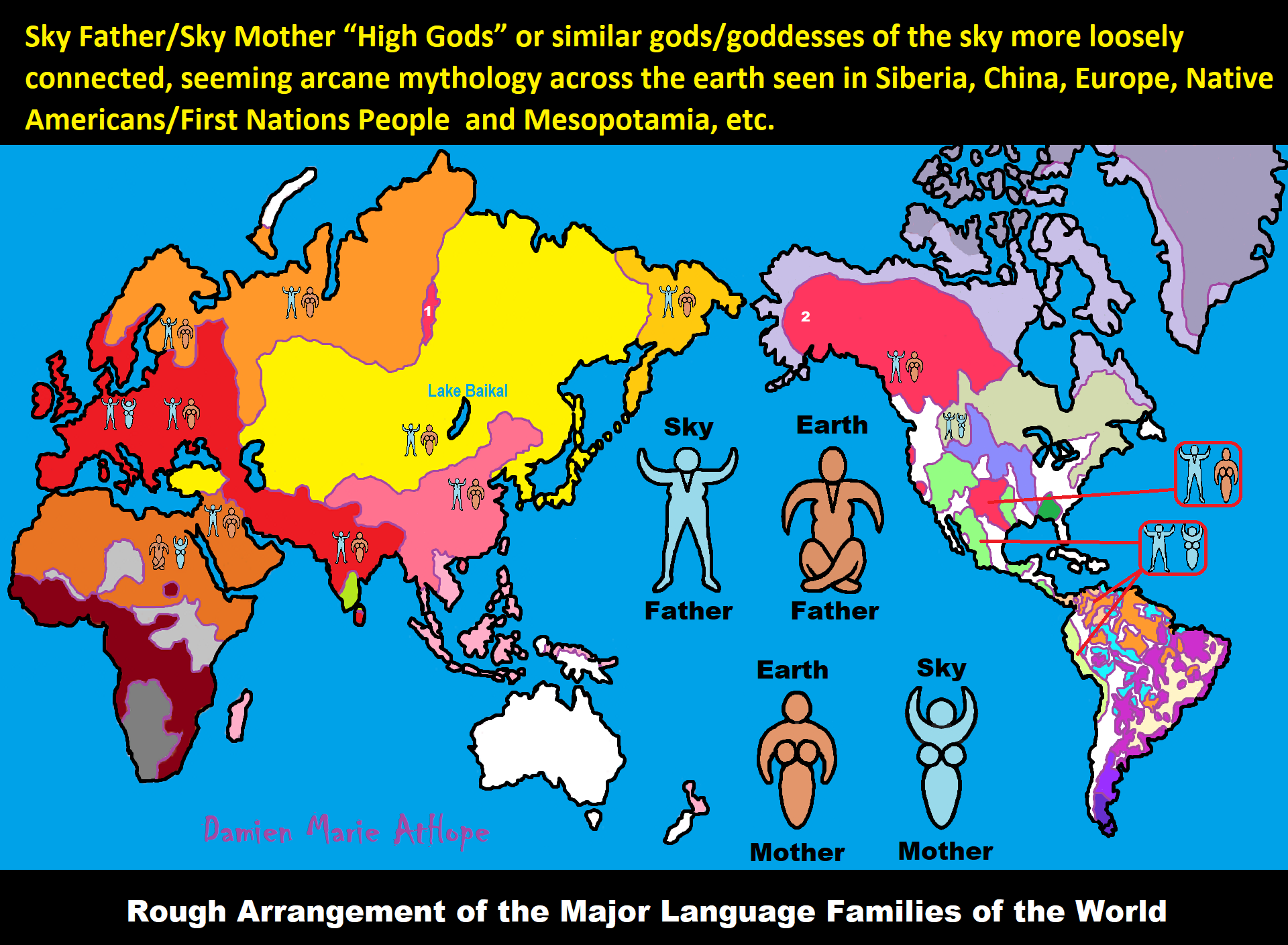
ref, ref, ref, ref, ref, ref, ref, ref, ref, ref, ref, ref, ref, ref, ref, ref, ref
“These ideas are my speculations from the evidence.”
I am still researching the “god‘s origins” all over the world. So you know, it is very complicated but I am smart and willing to look, DEEP, if necessary, which going very deep does seem to be needed here, when trying to actually understand the evolution of gods and goddesses. I am sure of a few things and less sure of others, but even in stuff I am not fully grasping I still am slowly figuring it out, to explain it to others. But as I research more I am understanding things a little better, though I am still working on understanding it all or something close and thus always figuring out more.
Sky Father/Sky God?
“Egyptian: (Nut) Sky Mother and (Geb) Earth Father” (Egypt is different but similar)
Turkic/Mongolic: (Tengri/Tenger Etseg) Sky Father and (Eje/Gazar Eej) Earth Mother *Transeurasian*
Hawaiian: (Wākea) Sky Father and (Papahānaumoku) Earth Mother *Austronesian*
New Zealand/ Māori: (Ranginui) Sky Father and (Papatūānuku) Earth Mother *Austronesian*
Proto-Indo-European: (Dyḗus/Dyḗus ph₂tḗr) Sky Father and (Dʰéǵʰōm/Pleth₂wih₁) Earth Mother
Indo-Aryan: (Dyaus Pita) Sky Father and (Prithvi Mata) Earth Mother *Indo-European*
Italic: (Jupiter) Sky Father and (Juno) Sky Mother *Indo-European*
Etruscan: (Tinia) Sky Father and (Uni) Sky Mother *Tyrsenian/Italy Pre–Indo-European*
Hellenic/Greek: (Zeus) Sky Father and (Hera) Sky Mother who started as an “Earth Goddess” *Indo-European*
Nordic: (Dagr) Sky Father and (Nótt) Sky Mother *Indo-European*
Slavic: (Perun) Sky Father and (Mokosh) Earth Mother *Indo-European*
Illyrian: (Deipaturos) Sky Father and (Messapic Damatura’s “earth-mother” maybe) Earth Mother *Indo-European*
Albanian: (Zojz) Sky Father and (?) *Indo-European*
Baltic: (Perkūnas) Sky Father and (Saulė) Sky Mother *Indo-European*
Germanic: (Týr) Sky Father and (?) *Indo-European*
Colombian-Muisca: (Bochica) Sky Father and (Huythaca) Sky Mother *Chibchan*
Aztec: (Quetzalcoatl) Sky Father and (Xochiquetzal) Sky Mother *Uto-Aztecan*
Incan: (Viracocha) Sky Father and (Mama Runtucaya) Sky Mother *Quechuan*
China: (Tian/Shangdi) Sky Father and (Dì) Earth Mother *Sino-Tibetan*
Sumerian, Assyrian and Babylonian: (An/Anu) Sky Father and (Ki) Earth Mother
Finnish: (Ukko) Sky Father and (Akka) Earth Mother *Finno-Ugric*
Sami: (Horagalles) Sky Father and (Ravdna) Earth Mother *Finno-Ugric*
Puebloan-Zuni: (Ápoyan Ta’chu) Sky Father and (Áwitelin Tsíta) Earth Mother
Puebloan-Hopi: (Tawa) Sky Father and (Kokyangwuti/Spider Woman/Grandmother) Earth Mother *Uto-Aztecan*
Puebloan-Navajo: (Tsohanoai) Sky Father and (Estsanatlehi) Earth Mother *Na-Dene*
ref, ref, ref, ref, ref, ref, ref, ref, ref, ref, ref, ref, ref, ref, ref, ref, ref, ref, ref, ref, ref, ref, ref, ref, ref, ref, ref
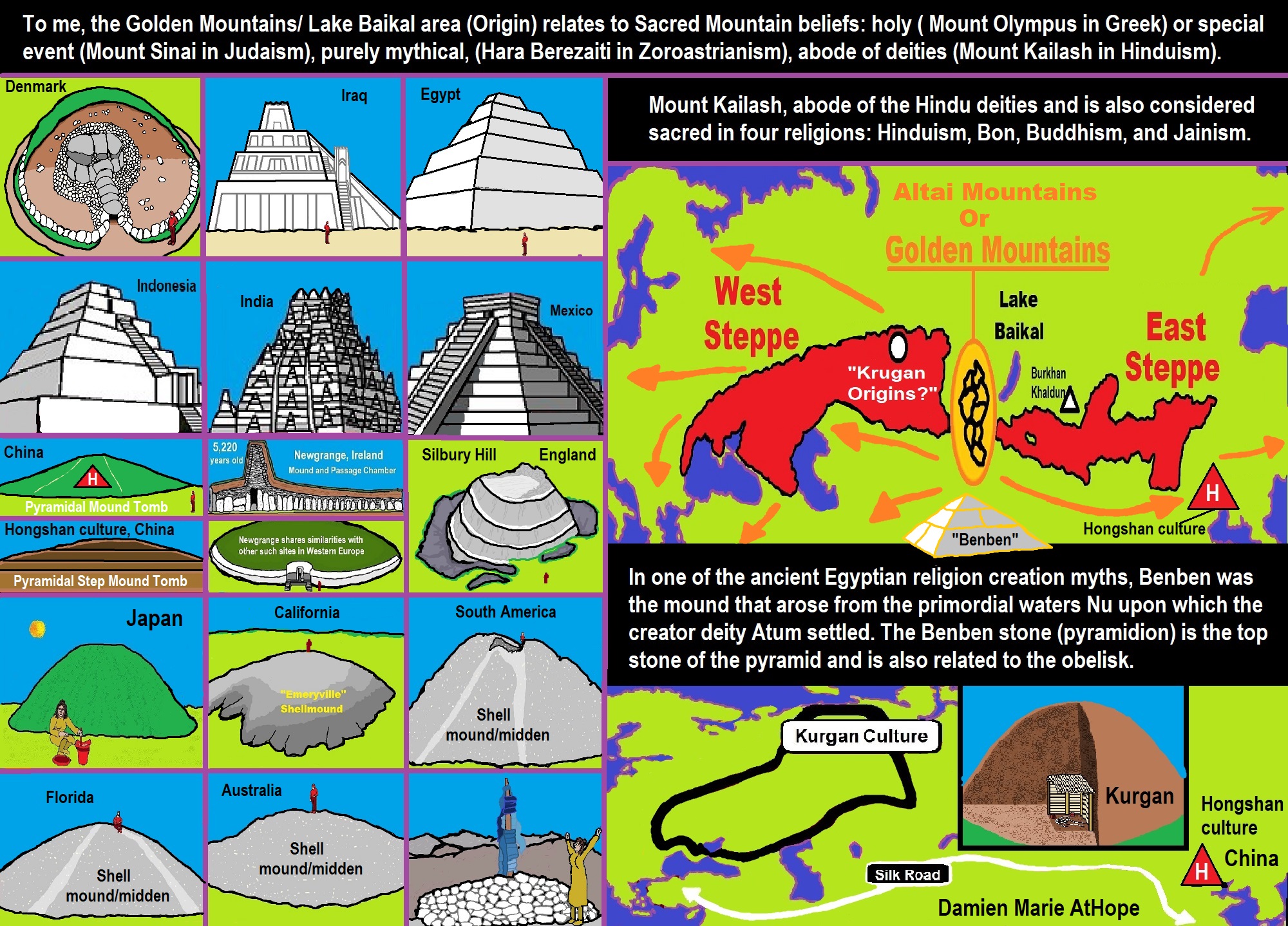
My Speculations are in Comparative Mythologies?
For instance, the mytheme of an ancient belief that is seemingly shared though changed and adapted, a fundamental generic unit of narrative structure seems to be shared a common relation with mountains/ancestors/gods or sacred animals with Sacred Mounds, Mountains, Kurgans, and Pyramids.
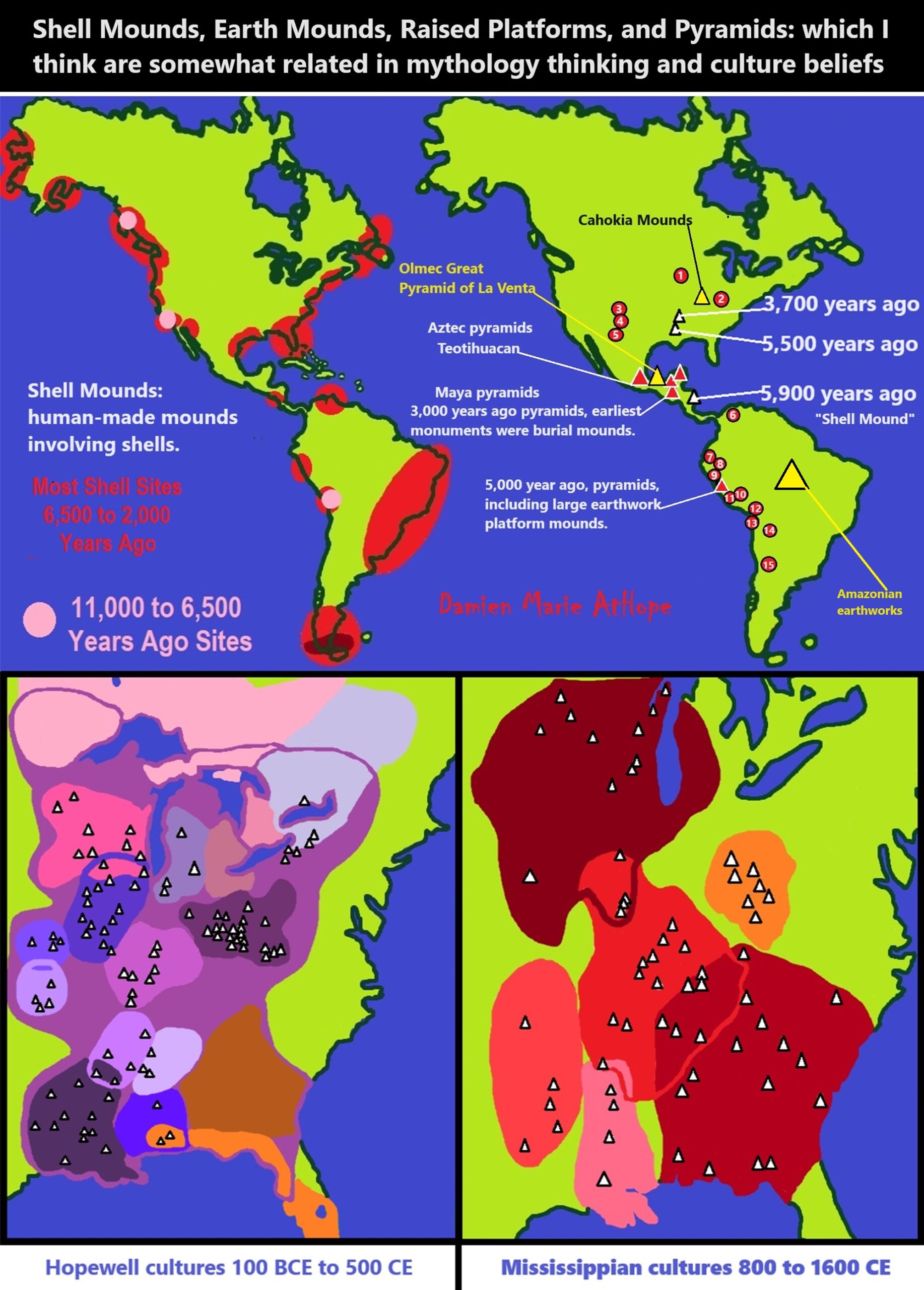
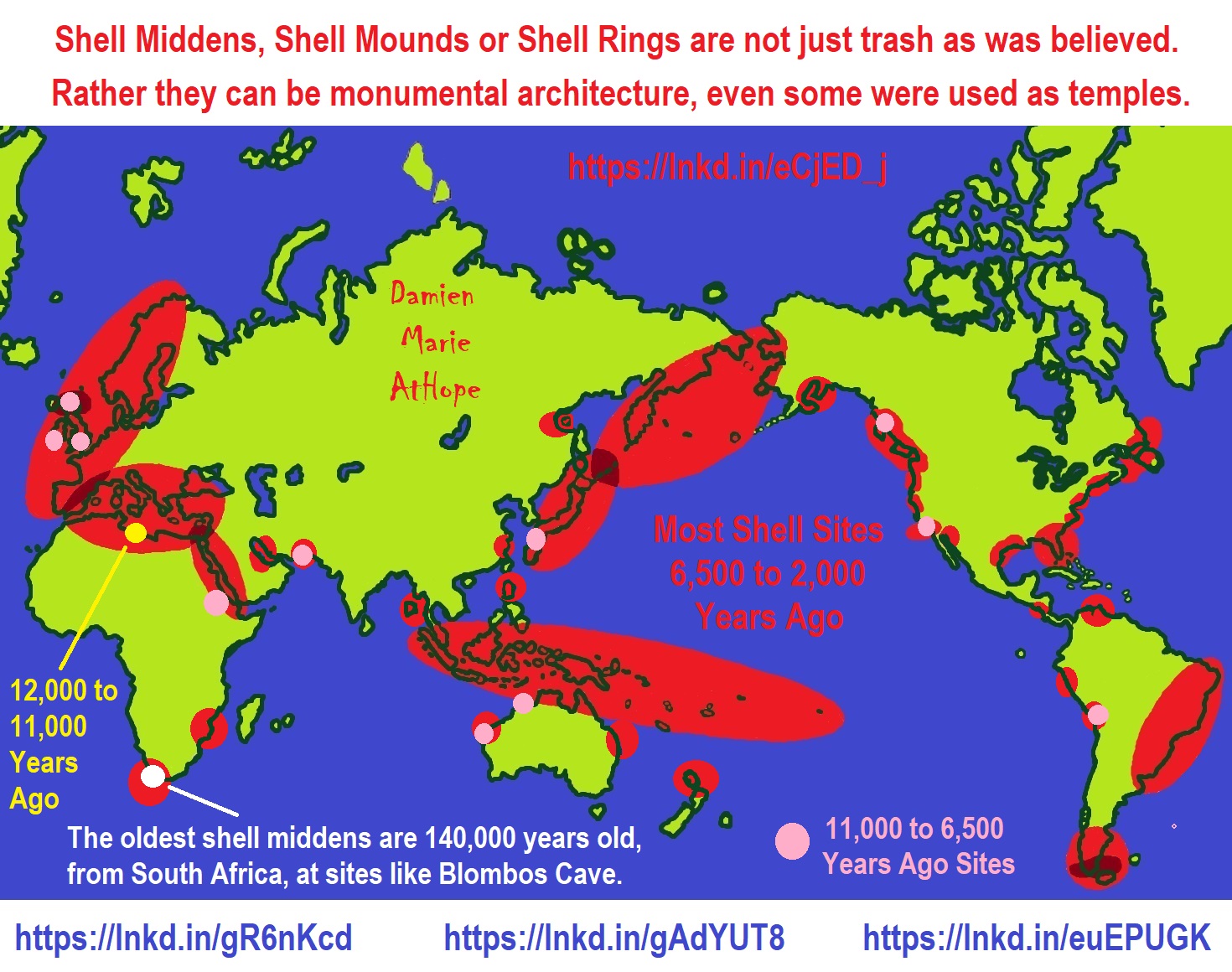
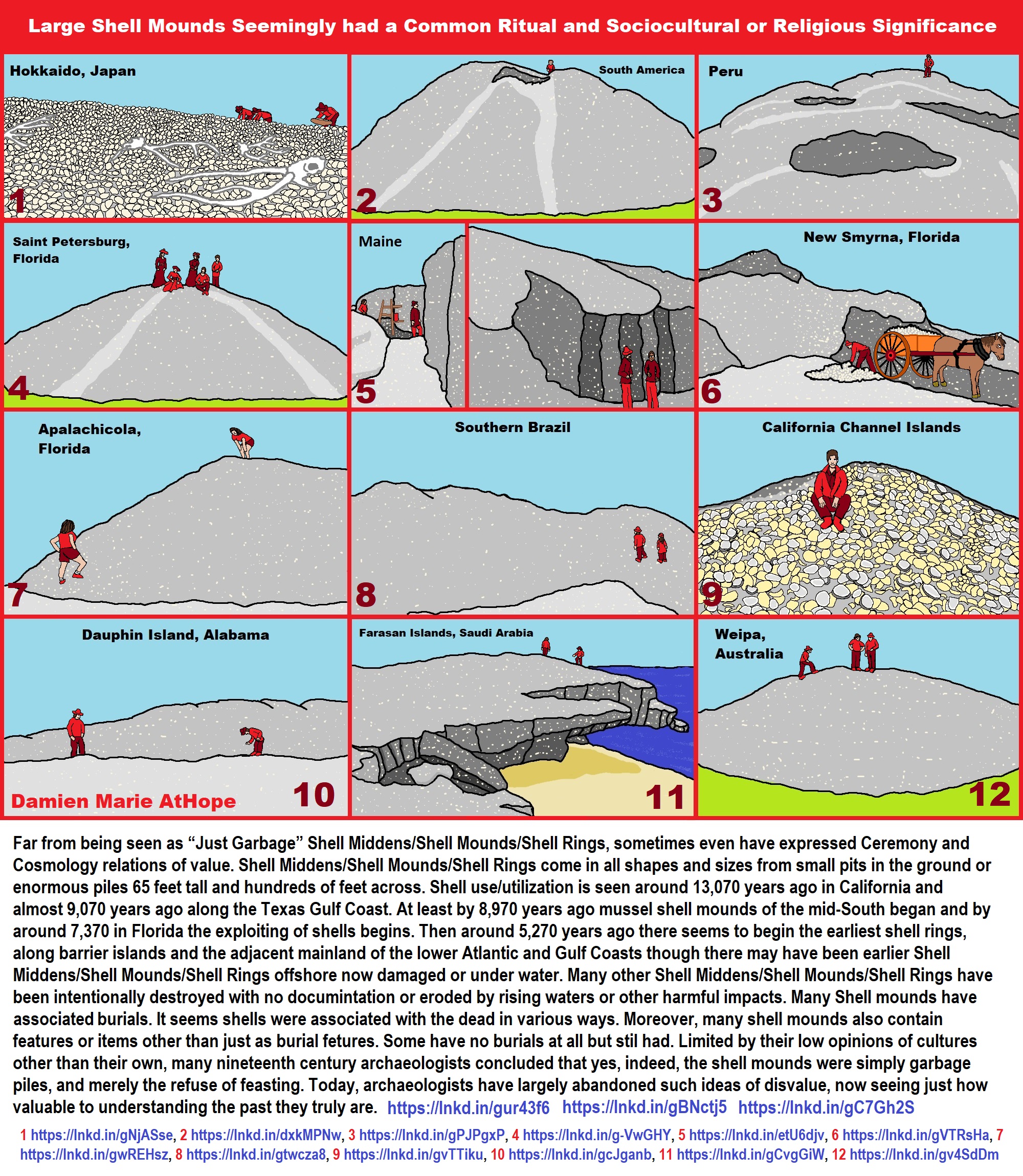
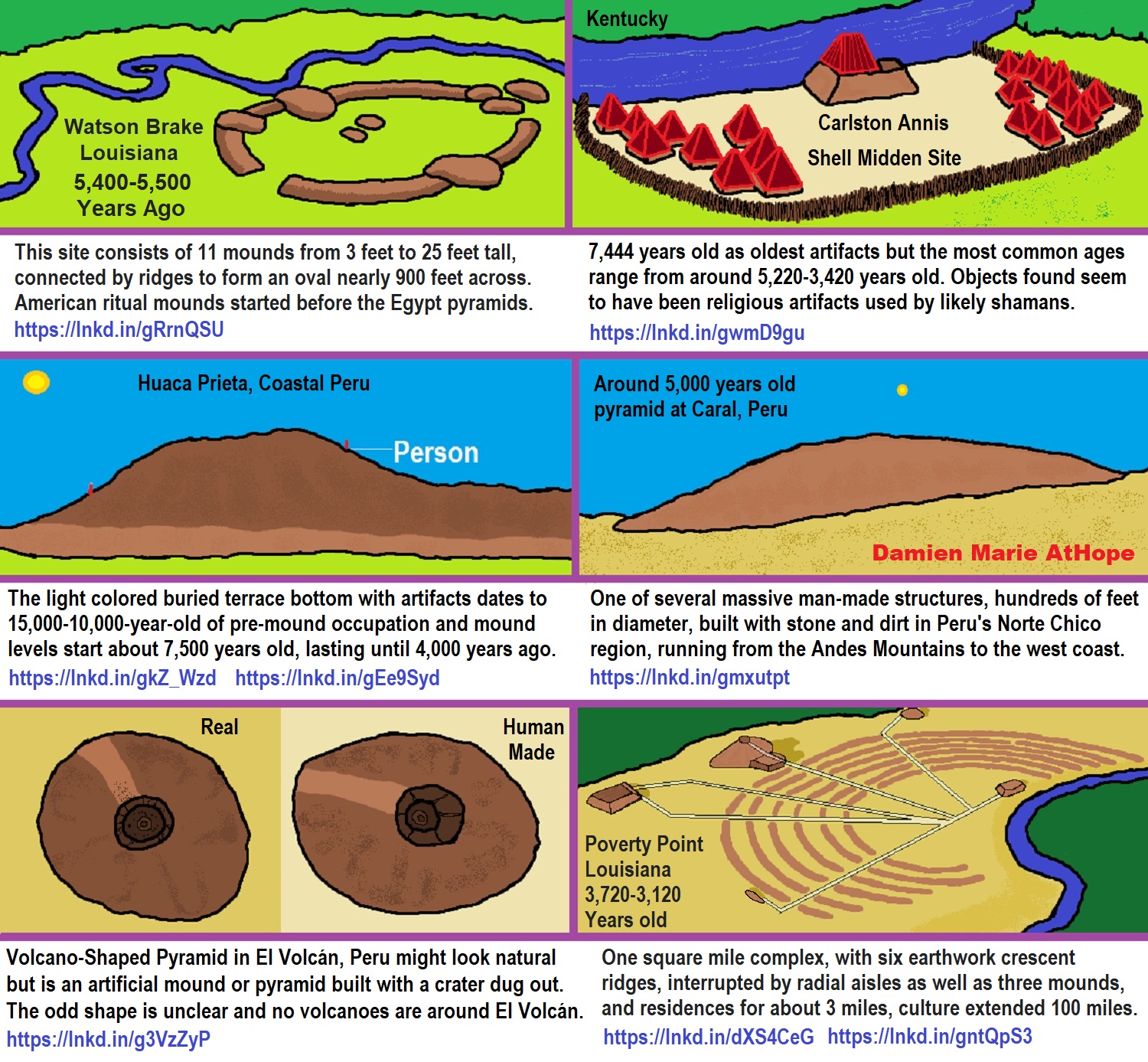
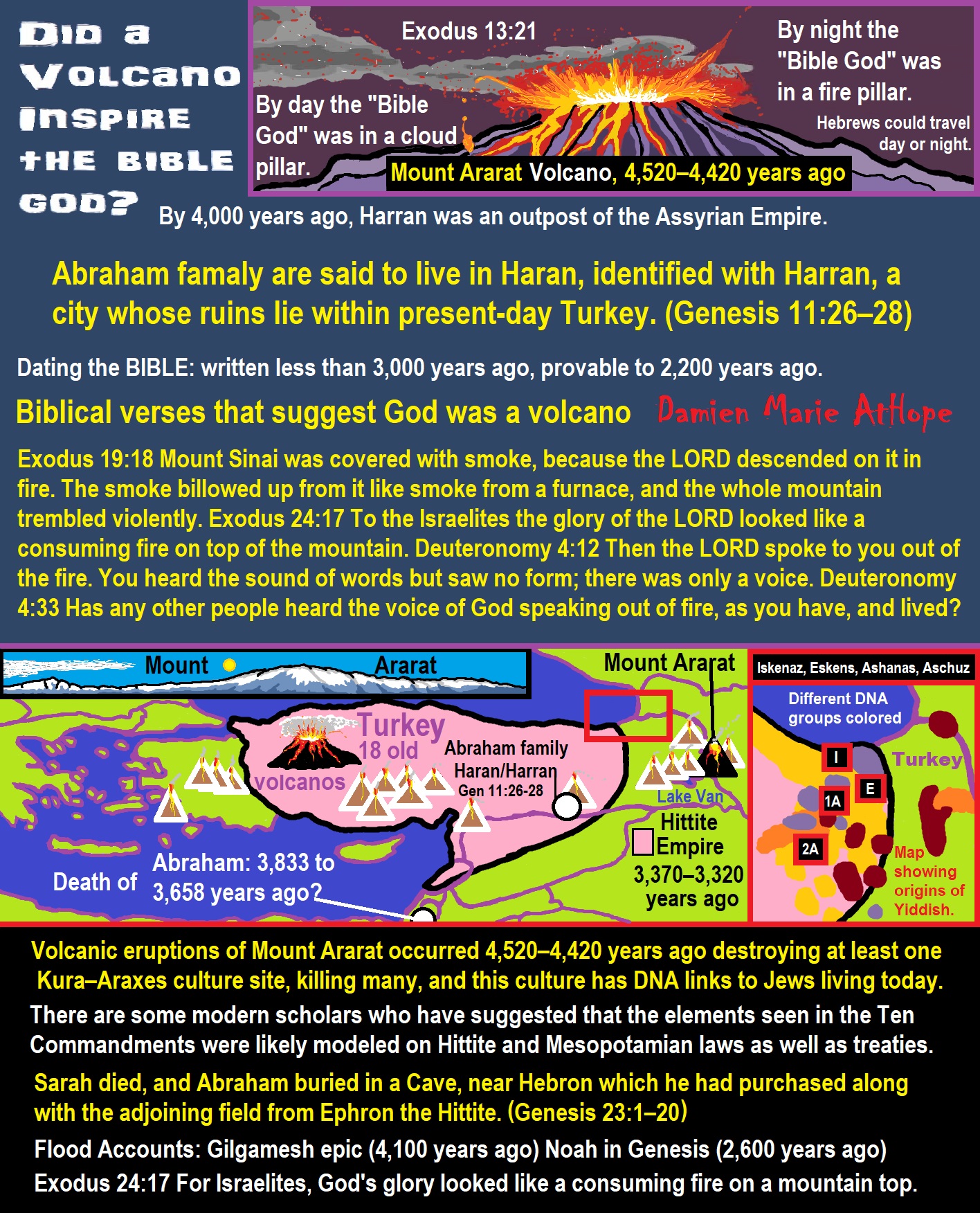
ref, ref, ref, ref, ref, ref, ref, ref, ref, ref, ref, ref, ref
By day the LORD went ahead of them in a pillar of cloud to guide them on their way and by night in a pillar of fire to give them light, so that they could travel by day or night.
- By day the “Bible God” was in a cloud pillar.
- By night the “Bible God” was in a fire pillar.
It seems ancient peoples had to survived amazing threats in a “dangerous universe (by superstition perceived as good and evil),” and human “immorality or imperfection of the soul” which was thought to affect the still living, leading to ancestor worship. This ancestor worship presumably led to the belief in supernatural beings, and then some of these were turned into the belief in gods. This feeble myth called gods were just a human conceived “made from nothing into something over and over, changing, again and again, taking on more as they evolve, all the while they are thought to be special,” but it is just supernatural animistic spirit-belief perceived as sacred.
Quick Evolution of Religion?
Pre-Animism (at least 300,000 years ago) pre-religion is a beginning that evolves into later Animism. So, Religion as we think of it, to me, all starts in a general way with Animism (Africa: 100,000 years ago) (theoretical belief in supernatural powers/spirits), then this is physically expressed in or with Totemism (Europe: 50,000 years ago) (theoretical belief in mythical relationship with powers/spirits through a totem item), which then enlists a full-time specific person to do this worship and believed interacting Shamanism (Siberia/Russia: 30,000 years ago) (theoretical belief in access and influence with spirits through ritual), and then there is the further employment of myths and gods added to all the above giving you Paganism (Turkey: 12,000 years ago) (often a lot more nature-based than most current top world religions, thus hinting to their close link to more ancient religious thinking it stems from). My hypothesis is expressed with an explanation of the building of a theatrical house (modern religions development). Progressed organized religion (Egypt: 5,000 years ago) with CURRENT “World” RELIGIONS (after 4,000 years ago).
Historically, in large city-state societies (such as Egypt or Iraq) starting around 5,000 years ago culminated to make religion something kind of new, a sociocultural-governmental-religious monarchy, where all or at least many of the people of such large city-state societies seem familiar with and committed to the existence of “religion” as the integrated life identity package of control dynamics with a fixed closed magical doctrine, but this juggernaut integrated religion identity package of Dogmatic-Propaganda certainly did not exist or if developed to an extent it was highly limited in most smaller prehistoric societies as they seem to lack most of the strong control dynamics with a fixed closed magical doctrine (magical beliefs could be at times be added or removed). Many people just want to see developed religious dynamics everywhere even if it is not. Instead, all that is found is largely fragments until the domestication of religion.
Religions, as we think of them today, are a new fad, even if they go back to around 6,000 years in the timeline of human existence, this amounts to almost nothing when seen in the long slow evolution of religion at least around 70,000 years ago with one of the oldest ritual worship. Stone Snake of South Africa: “first human worship” 70,000 years ago. This message of how religion and gods among them are clearly a man-made thing that was developed slowly as it was invented and then implemented peace by peace discrediting them all. Which seems to be a simple point some are just not grasping how devastating to any claims of truth when we can see the lie clearly in the archeological sites.
I wish people fought as hard for the actual values as they fight for the group/clan names political or otherwise they think support values. Every amount spent on war is theft to children in need of food or the homeless kept from shelter.
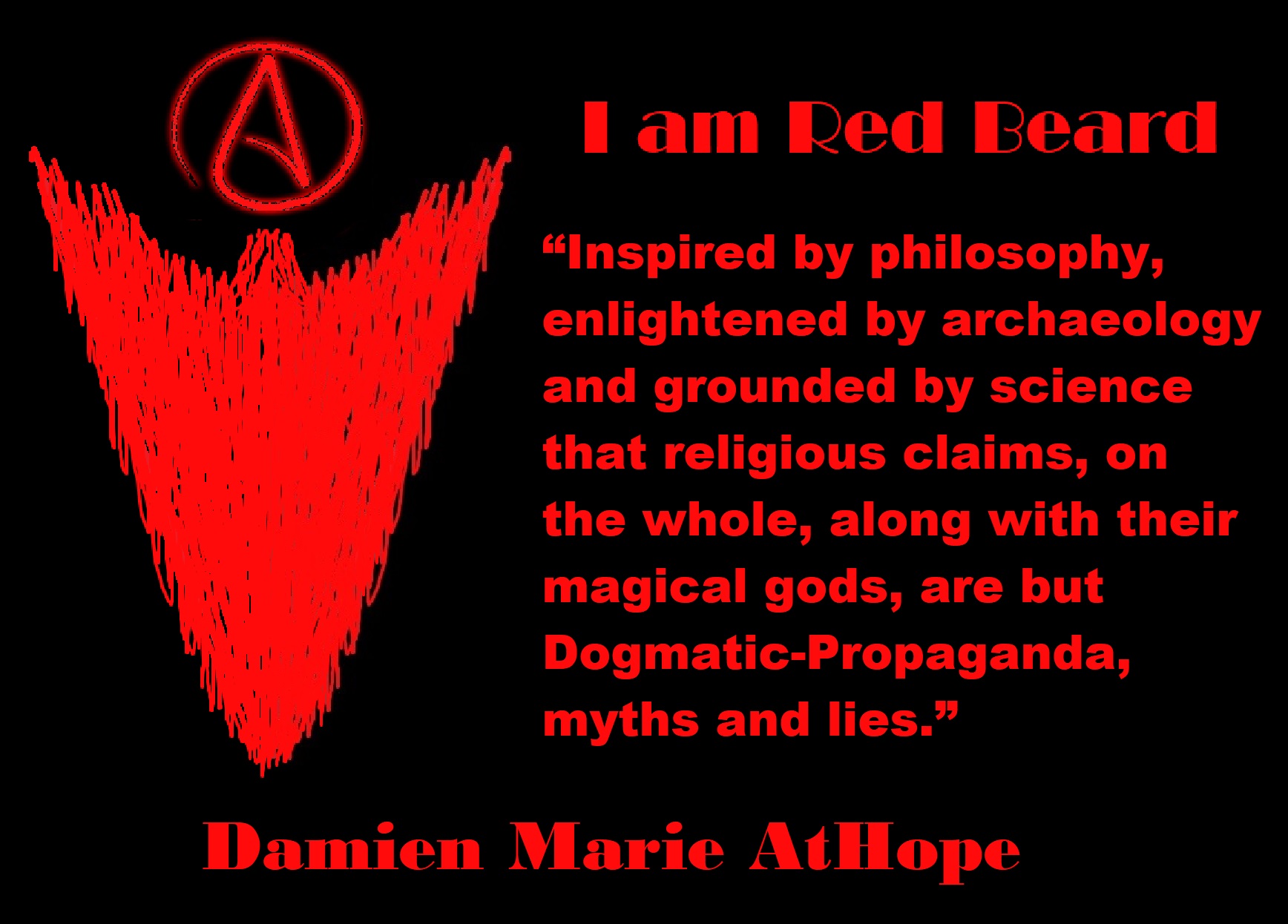
People don’t commonly teach religious history, even that of their own claimed religion. No, rather they teach a limited “pro their religion” history of their religion from a religious perspective favorable to the religion of choice.
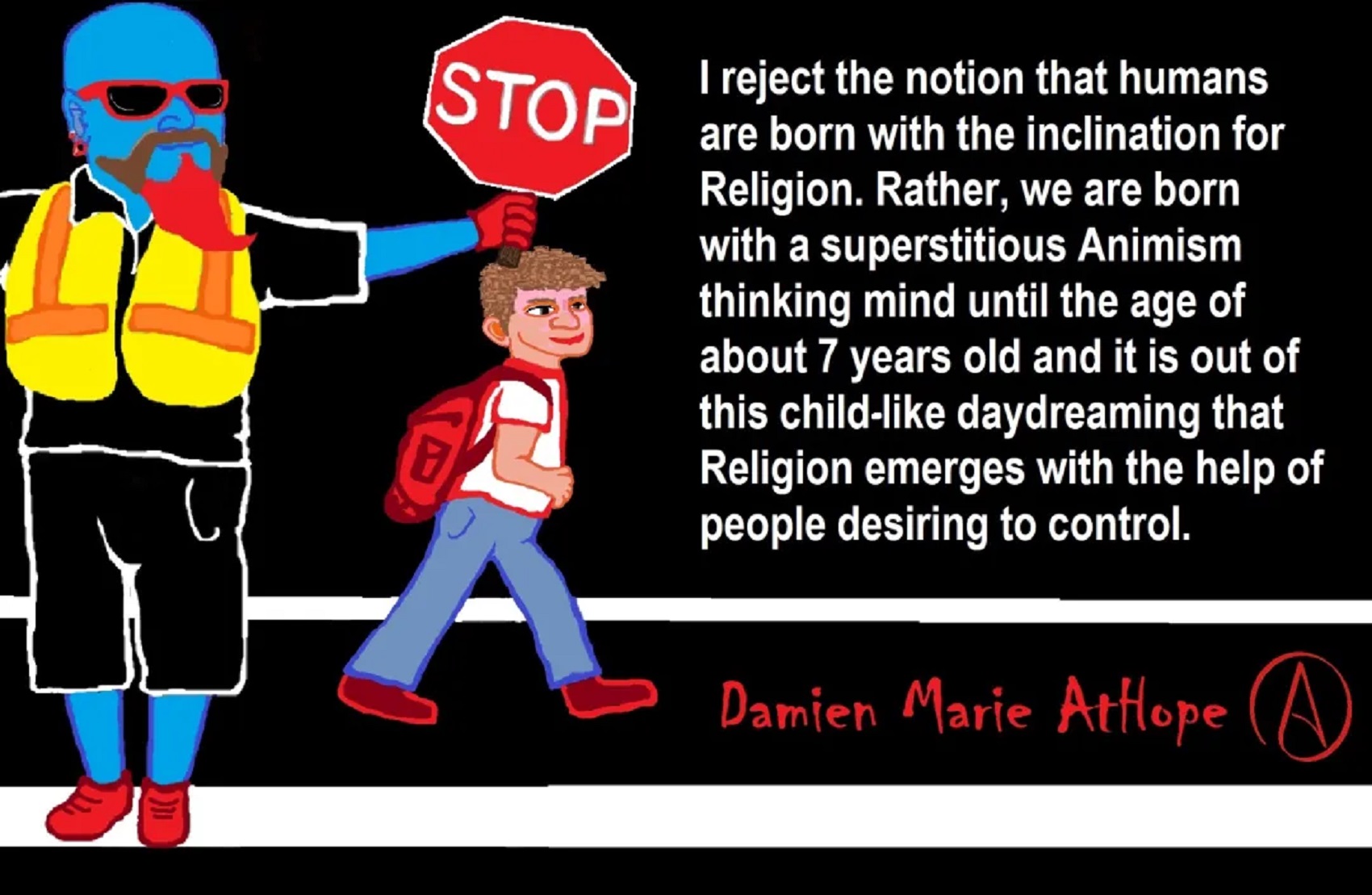
Do you truly think “Religious Belief” is only a matter of some personal choice?
Do you not see how coercive one’s world of choice is limited to the obvious hereditary belief, in most religious choices available to the child of religious parents or caregivers? Religion is more commonly like a family, culture, society, etc. available belief that limits the belief choices of the child and that is when “Religious Belief” is not only a matter of some personal choice and when it becomes hereditary faith, not because of the quality of its alleged facts or proposed truths but because everyone else important to the child believes similarly so they do as well simply mimicking authority beliefs handed to them. Because children are raised in religion rather than being presented all possible choices but rather one limited dogmatic brand of “Religious Belief” where children only have a choice of following the belief as instructed, and then personally claim the faith hereditary belief seen in the confirming to the belief they have held themselves all their lives. This is obvious in statements asked and answered by children claiming a faith they barely understand but they do understand that their family believes “this or that” faith, so they feel obligated to believe it too. While I do agree that “Religious Belief” should only be a matter of some personal choice, it rarely is… End Hereditary Religion!
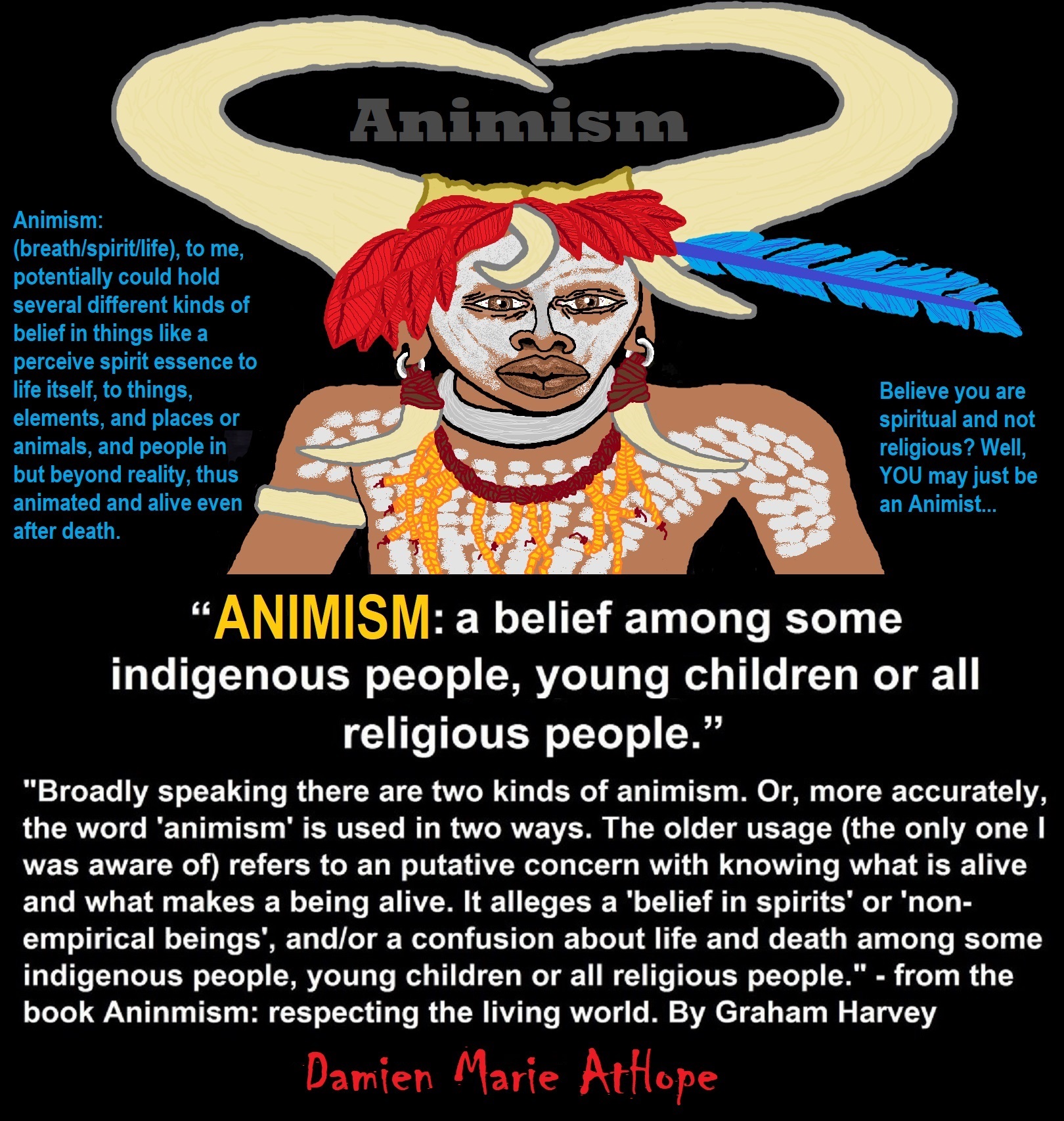
Animism: Respecting the Living World by Graham Harvey
“How have human cultures engaged with and thought about animals, plants, rocks, clouds, and other elements in their natural surroundings? Do animals and other natural objects have a spirit or soul? What is their relationship to humans? In this new study, Graham Harvey explores current and past animistic beliefs and practices of Native Americans, Maori, Aboriginal Australians, and eco-pagans. He considers the varieties of animism found in these cultures as well as their shared desire to live respectfully within larger natural communities. Drawing on his extensive casework, Harvey also considers the linguistic, performative, ecological, and activist implications of these different animisms.” ref
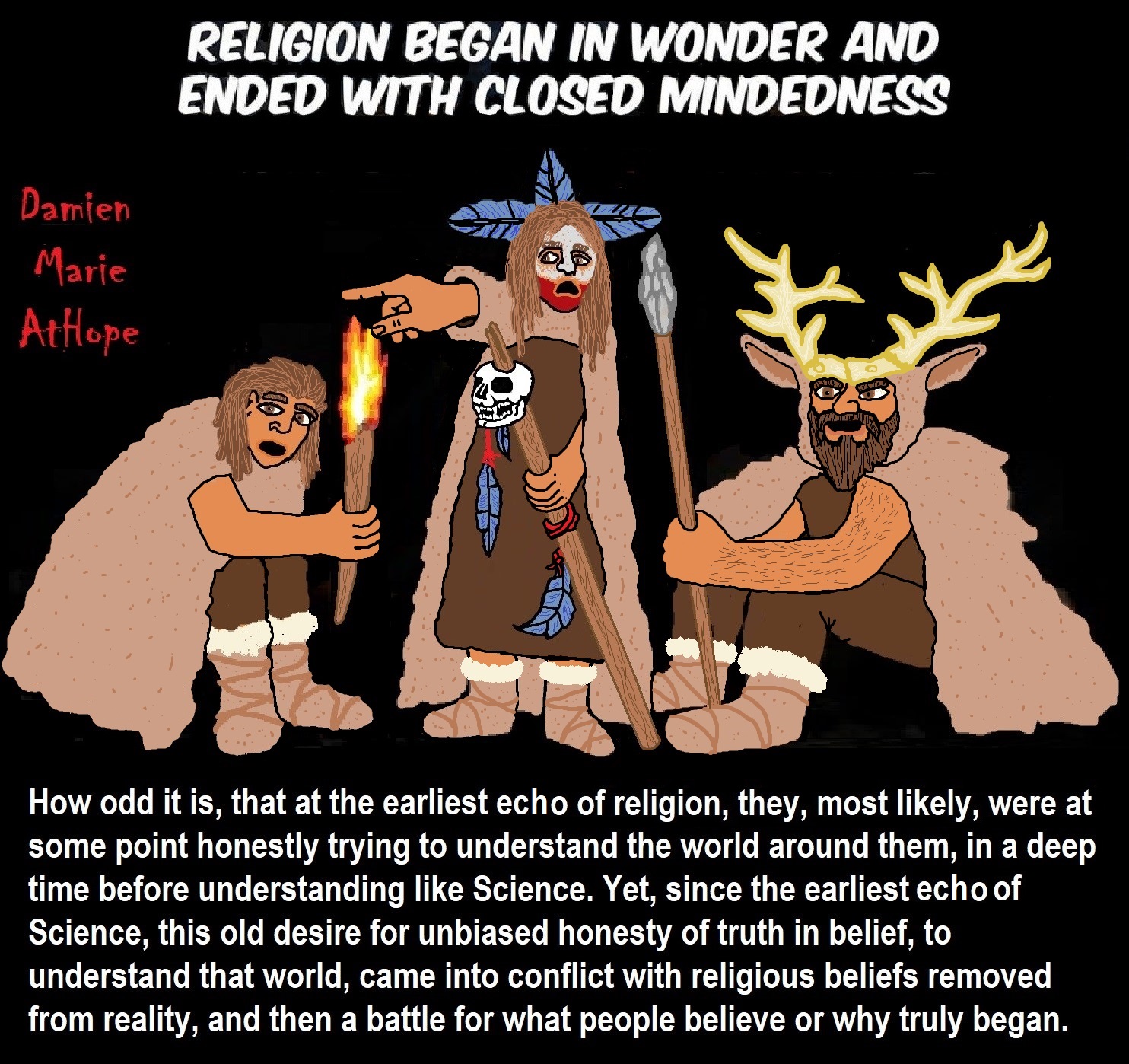
We are like believing machines we vacuum up ideas, like Velcro sticks to almost everything. We accumulate beliefs that we allow to negatively influence our lives, often without realizing it. Our willingness must be to alter skewed beliefs that impend our balance or reason, which allows us to achieve new positive thinking and accurate outcomes.
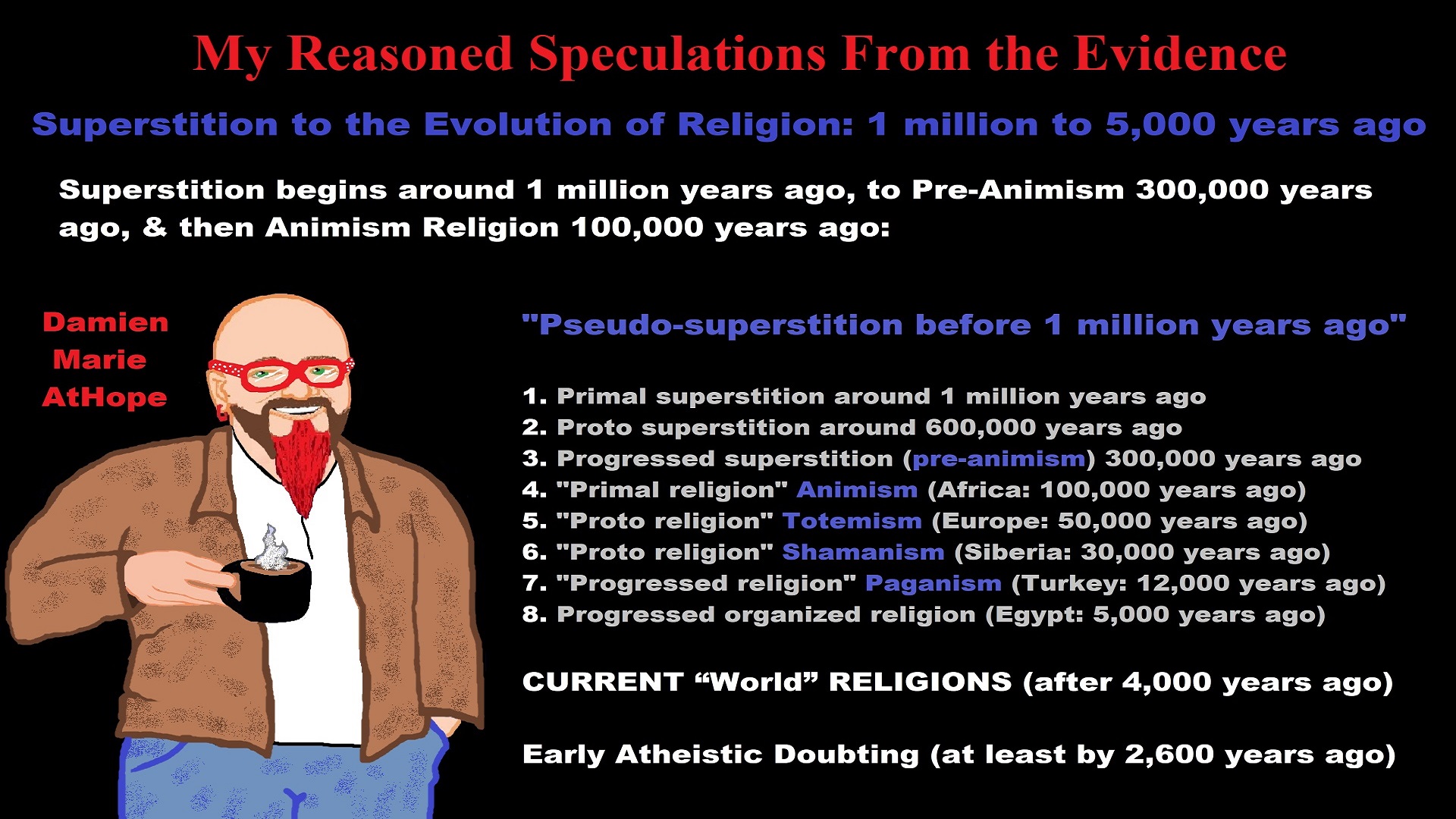
My thoughts on Religion Evolution with external links for more info:
- (Pre-Animism Africa mainly, but also Europe, and Asia at least 300,000 years ago), (Pre-Animism – Oxford Dictionaries)
- (Animism Africa around 100,000 years ago), (Animism – Britannica.com)
- (Totemism Europe around 50,000 years ago), (Totemism – Anthropology)
- (Shamanism Siberia around 30,000 years ago), (Shamanism – Britannica.com)
- (Paganism Turkey around 12,000 years ago), (Paganism – BBC Religion)
- (Progressed Organized Religion “Institutional Religion” Egypt around 5,000 years ago), (Ancient Egyptian Religion – Britannica.com)
- (CURRENT “World” RELIGIONS after 4,000 years ago) (Origin of Major Religions – Sacred Texts)
- (Early Atheistic Doubting at least by 2,600 years ago) (History of Atheism – Wikipedia)
“Religion is an Evolved Product” and Yes, Religion is Like Fear Given Wings…
Atheists talk about gods and religions for the same reason doctors talk about cancer, they are looking for a cure, or a firefighter talks about fires because they burn people and they care to stop them. We atheists too often feel a need to help the victims of mental slavery, held in the bondage that is the false beliefs of gods and the conspiracy theories of reality found in religions.
Understanding Religion Evolution:
- Pre-Animism (at least 300,000 years ago)
- Animism (Africa: 100,000 years ago)
- Totemism (Europe: 50,000 years ago)
- Shamanism (Siberia: 30,000 years ago)
- Paganism (Turkey: 12,000 years ago)
- Progressed organized religion (Egypt: 5,000 years ago), (Egypt, the First Dynasty 5,150 years ago)
- CURRENT “World” RELIGIONS (after 4,000 years ago)
- Early Atheistic Doubting (at least by 2,600 years ago)
“An Archaeological/Anthropological Understanding of Religion Evolution”
It seems ancient peoples had to survived amazing threats in a “dangerous universe (by superstition perceived as good and evil),” and human “immorality or imperfection of the soul” which was thought to affect the still living, leading to ancestor worship. This ancestor worship presumably led to the belief in supernatural beings, and then some of these were turned into the belief in gods. This feeble myth called gods were just a human conceived “made from nothing into something over and over, changing, again and again, taking on more as they evolve, all the while they are thought to be special,” but it is just supernatural animistic spirit-belief perceived as sacred.
Quick Evolution of Religion?
Pre-Animism (at least 300,000 years ago) pre-religion is a beginning that evolves into later Animism. So, Religion as we think of it, to me, all starts in a general way with Animism (Africa: 100,000 years ago) (theoretical belief in supernatural powers/spirits), then this is physically expressed in or with Totemism (Europe: 50,000 years ago) (theoretical belief in mythical relationship with powers/spirits through a totem item), which then enlists a full-time specific person to do this worship and believed interacting Shamanism (Siberia/Russia: 30,000 years ago) (theoretical belief in access and influence with spirits through ritual), and then there is the further employment of myths and gods added to all the above giving you Paganism (Turkey: 12,000 years ago) (often a lot more nature-based than most current top world religions, thus hinting to their close link to more ancient religious thinking it stems from). My hypothesis is expressed with an explanation of the building of a theatrical house (modern religions development). Progressed organized religion (Egypt: 5,000 years ago) with CURRENT “World” RELIGIONS (after 4,000 years ago).
Historically, in large city-state societies (such as Egypt or Iraq) starting around 5,000 years ago culminated to make religion something kind of new, a sociocultural-governmental-religious monarchy, where all or at least many of the people of such large city-state societies seem familiar with and committed to the existence of “religion” as the integrated life identity package of control dynamics with a fixed closed magical doctrine, but this juggernaut integrated religion identity package of Dogmatic-Propaganda certainly did not exist or if developed to an extent it was highly limited in most smaller prehistoric societies as they seem to lack most of the strong control dynamics with a fixed closed magical doctrine (magical beliefs could be at times be added or removed). Many people just want to see developed religious dynamics everywhere even if it is not. Instead, all that is found is largely fragments until the domestication of religion.
Religions, as we think of them today, are a new fad, even if they go back to around 6,000 years in the timeline of human existence, this amounts to almost nothing when seen in the long slow evolution of religion at least around 70,000 years ago with one of the oldest ritual worship. Stone Snake of South Africa: “first human worship” 70,000 years ago. This message of how religion and gods among them are clearly a man-made thing that was developed slowly as it was invented and then implemented peace by peace discrediting them all. Which seems to be a simple point some are just not grasping how devastating to any claims of truth when we can see the lie clearly in the archeological sites.
I wish people fought as hard for the actual values as they fight for the group/clan names political or otherwise they think support values. Every amount spent on war is theft to children in need of food or the homeless kept from shelter.
Here are several of my blog posts on history:
- To Find Truth You Must First Look
- (Magdalenian/Iberomaurusian) Connections to the First Paganists of the early Neolithic Near East Dating from around 17,000 to 12,000 Years Ago
- Natufians: an Ancient People at the Origins of Agriculture and Sedentary Life
- Possible Clan Leader/Special “MALE” Ancestor Totem Poles At Least 13,500 years ago?
- Jewish People with DNA at least 13,200 years old, Judaism, and the Origins of Some of its Ideas
- Baltic Reindeer Hunters: Swiderian, Lyngby, Ahrensburgian, and Krasnosillya cultures 12,020 to 11,020 years ago are evidence of powerful migratory waves during the last 13,000 years and a genetic link to Saami and the Finno-Ugric peoples.
- The Rise of Inequality: patriarchy and state hierarchy inequality
- Fertile Crescent 12,500 – 9,500 Years Ago: fertility and death cult belief system?
- 12,400 – 11,700 Years Ago – Kortik Tepe (Turkey) Pre/early-Agriculture Cultic Ritualism
- Ritualistic Bird Symbolism at Gobekli Tepe and its “Ancestor Cult”
- Male-Homosexual (female-like) / Trans-woman (female) Seated Figurine from Gobekli Tepe
- Could a 12,000-year-old Bull Geoglyph at Göbekli Tepe relate to older Bull and Female Art 25,000 years ago and Later Goddess and the Bull cults like Catal Huyuk?
- Sedentism and the Creation of goddesses around 12,000 years ago as well as male gods after 7,000 years ago.
- Alcohol, where Agriculture and Religion Become one? Such as Gobekli Tepe’s Ritualistic use of Grain as Food and Ritual Drink
- Neolithic Ritual Sites with T-Pillars and other Cultic Pillars
- Paganism: Goddesses around 12,000 years ago then Male Gods after 7,000 years ago
- First Patriarchy: Split of Women’s Status around 12,000 years ago & First Hierarchy: fall of Women’s Status around 5,000 years ago.
- Natufians: an Ancient People at the Origins of Agriculture and Sedentary Life
- J DNA and the Spread of Agricultural Religion (paganism)
- Paganism: an approximately 12,000-year-old belief system
- Paganism 12,000 years old: related to “Anarchism and Socialism” (Pre-Capitalism)
- Shaman burial in Israel 12,000 years ago and the Shamanism Phenomena
- Need to Mythicized: gods and goddesses
- 12,000 – 7,000 Years Ago – Paleo-Indian Culture (The Americas)
- 12,000 – 2,000 Years Ago – Indigenous-Scandinavians (Nordic)
- Norse did not wear helmets with horns?
- Pre-Pottery Neolithic Skull Cult around 11,500 to 8,400 Years Ago?
- 10,400 – 10,100 Years Ago, in Turkey the Nevail Cori Religious Settlement
- 9,000-6,500 Years Old Submerged Pre-Pottery/Pottery Neolithic Ritual Settlements off Israel’s Coast
- Catal Huyuk “first religious designed city” around 9,500 to 7,700 years ago (Turkey)
- Cultic Hunting at Catal Huyuk “first religious designed city”
- Special Items and Art as well as Special Elite Burials at Catal Huyuk
- New Rituals and Violence with the appearance of Pottery and People?
- Haplogroup N and its related Uralic Languages and Cultures
- Ainu people, Sámi people, Native Americans, the Ancient North Eurasians, and Paganistic-Shamanism with Totemism
- Ideas, Technology and People from Turkey, Europe, to China and Back again 9,000 to 5,000 years ago?
- First Pottery of Europe and the Related Cultures
- 9,000 years old Neolithic Artifacts Judean Desert and Hills Israel
- 9,000-7,000 years-old Sex and Death Rituals: Cult Sites in Israel, Jordan, and the Sinai
- 9,000-8500 year old Horned Female shaman Bad Dürrenberg Germany
- Neolithic Jewelry and the Spread of Farming in Europe Emerging out of West Turkey
- 8,600-year-old Tortoise Shells in Neolithic graves in central China have Early Writing and Shamanism
- Swing of the Mace: the rise of Elite, Forced Authority, and Inequality begin to Emerge 8,500 years ago?
- Migrations and Changing Europeans Beginning around 8,000 Years Ago
- My “Steppe-Anatolian-Kurgan hypothesis” 8,000/7,000 years ago
- Around 8,000-year-old Shared Idea of the Mistress of Animals, “Ritual” Motif
- Pre-Columbian Red-Paint (red ochre) Maritime Archaic Culture 8,000-3,000 years ago
- 7,522-6,522 years ago Linear Pottery culture which I think relates to Arcane Capitalism’s origins
- Arcane Capitalism: Primitive socialism, Primitive capital, Private ownership, Means of production, Market capitalism, Class discrimination, and Petite bourgeoisie (smaller capitalists)
- 7,500-4,750 years old Ritualistic Cucuteni-Trypillian culture of Moldova, Romania, and Ukraine
- Roots of a changing early society 7,200-6,700 years ago Jordan and Israel
- Agriculture religion (Paganism) with farming reached Britain between about 7,000 to 6,500 or so years ago and seemingly expressed in things like Western Europe’s Long Barrows
- My Thoughts on Possible Migrations of “R” DNA and Proto-Indo-European?
- “Millet” Spreading from China 7,022 years ago to Europe and related Language may have Spread with it leading to Proto-Indo-European
- Proto-Indo-European (PIE), ancestor of Indo-European languages: DNA, Society, Language, and Mythology
- The Dnieper–Donets culture and Asian varieties of Millet from China to the Black Sea region of Europe by 7,022 years ago
- Kurgan 6,000 years ago/dolmens 7,000 years ago: funeral, ritual, and other?
- 7,020 to 6,020-year-old Proto-Indo-European Homeland of Urheimat or proposed home of their Language and Religion
- Ancient Megaliths: Kurgan, Ziggurat, Pyramid, Menhir, Trilithon, Dolman, Kromlech, and Kromlech of Trilithons
- The Mytheme of Ancient North Eurasian Sacred-Dog belief and similar motifs are found in Indo-European, Native American, and Siberian comparative mythology
- Elite Power Accumulation: Ancient Trade, Tokens, Writing, Wealth, Merchants, and Priest-Kings
- Sacred Mounds, Mountains, Kurgans, and Pyramids may hold deep connections?
- Between 7,000-5,000 Years ago, rise of unequal hierarchy elite, leading to a “birth of the State” or worship of power, strong new sexism, oppression of non-elites, and the fall of Women’s equal status
- Paganism 7,000-5,000 years old: related to “Anarchism and Socialism” (Capitalism) (World War 0) Elite & their slaves
- Hell and Underworld mythologies starting maybe as far back as 7,000 to 5,000 years ago with the Proto-Indo-Europeans?
- The First Expression of the Male God around 7,000 years ago?
- White (light complexion skin) Bigotry and Sexism started 7,000 years ago?
- Around 7,000-year-old Shared Idea of the Divine Bird (Tutelary and/or Trickster spirit/deity), “Ritual” Motif
- Nekhbet an Ancient Egyptian Vulture Goddess and Tutelary Deity
- 6,720 to 4,920 years old Ritualistic Hongshan Culture of Inner Mongolia with 5,000-year-old Pyramid Mounds and Temples
- First proto-king in the Balkans, Varna culture around 6,500 years ago?
- 6,500–5,800 years ago in Israel Late Chalcolithic (Copper Age) Period in the Southern Levant Seems to Express Northern Levant Migrations, Cultural and Religious Transfer
- KING OF BEASTS: Master of Animals “Ritual” Motif, around 6,000 years old or older…
- Around 6000-year-old Shared Idea of the Solid Wheel & the Spoked Wheel-Shaped Ritual Motif
- “The Ghassulian Star,” a mysterious 6,000-year-old mural from Jordan; a Proto-Star of Ishtar, Star of Inanna or Star of Venus?
- Religious/Ritual Ideas, including goddesses and gods as well as ritual mounds or pyramids from Northeastern Asia at least 6,000 years old, seemingly filtering to Iran, Iraq, the Mediterranean, Europe, Egypt, and the Americas?
- Maykop (5,720–5,020 years ago) Caucasus region Bronze Age culture-related to Copper Age farmers from the south, influenced by the Ubaid period and Leyla-Tepe culture, as well as influencing the Kura-Araxes culture
- 5-600-year-old Tomb, Mummy, and First Bearded Male Figurine in a Grave
- Kura-Araxes Cultural 5,520 to 4,470 years old DNA traces to the Canaanites, Arabs, and Jews
- Minoan/Cretan (Keftiu) Civilization and Religion around 5,520 to 3,120 years ago
- Evolution Of Science at least by 5,500 years ago
- 5,500 Years old birth of the State, the rise of Hierarchy, and the fall of Women’s status
- “Jiroft culture” 5,100 – 4,200 years ago and the History of Iran
- Stonehenge: Paganistic Burial and Astrological Ritual Complex, England (5,100-3,600 years ago)
- Around 5,000-year-old Shared Idea of the “Tree of Life” Ritual Motif
- Complex rituals for elite, seen from China to Egypt, at least by 5,000 years ago
- Around 5,000 years ago: “Birth of the State” where Religion gets Military Power and Influence
- The Center of the World “Axis Mundi” and/or “Sacred Mountains” Mythology Could Relate to the Altai Mountains, Heart of the Steppe
- Progressed organized religion starts, an approximately 5,000-year-old belief system
- China’s Civilization between 5,000-3,000 years ago, was a time of war and class struggle, violent transition from free clans to a Slave or Elite society
- Origin of Logics is Naturalistic Observation at least by around 5,000 years ago.
- Paganism 5,000 years old: progressed organized religion and the state: related to “Anarchism and Socialism” (Kings and the Rise of the State)
- Ziggurats (multi-platform temples: 4,900 years old) to Pyramids (multi-platform tombs: 4,700 years old)
- Did a 4,520–4,420-year-old Volcano In Turkey Inspire the Bible God?
- Finland’s Horned Shaman and Pre-Horned-God at least 4,500 years ago?
- 4,000-year-Old Dolmens in Israel: A Connected Dolmen Religious Phenomenon?
- Creation myths: From chaos, Ex nihilo, Earth-diver, Emergence, World egg, and World parent
- Bronze Age “Ritual” connections of the Bell Beaker culture with the Corded Ware/Single Grave culture, which were related to the Yamnaya culture and Proto-Indo-European Languages/Religions
- Low Gods (Earth/ Tutelary deity), High Gods (Sky/Supreme deity), and Moralistic Gods (Deity enforcement/divine order)
- The exchange of people, ideas, and material-culture including, to me, the new god (Sky Father) and goddess (Earth Mother) religion between the Cucuteni-Trypillians and others which is then spread far and wide
- Koryaks: Indigenous People of the Russian Far East and Big Raven myths also found in Tlingit, Haida, Tsimshian, and other Indigenous People of North America
- 42 Principles Of Maat (Egyptian Goddess of the justice) around 4,400 years ago, 2000 Years Before Ten Commandments
- “Happy Easter” Well Happy Eostre/Ishter
- 4,320-3,820 years old “Shimao” (North China) site with Totemistic-Shamanistic Paganism and a Stepped Pyramid
- 4,250 to 3,400 Year old Stonehenge from Russia: Arkaim?
- 4,100-year-old beaker with medicinal & flowering plants in a grave of a woman in Scotland
- Early European Farmer ancestry, Kelif el Boroud people with the Cardial Ware culture, and the Bell Beaker culture Paganists too, spread into North Africa, then to the Canary Islands off West Africa
- Flood Accounts: Gilgamesh epic (4,100 years ago) Noah in Genesis (2,600 years ago)
- Paganism 4,000 years old: related to “Anarchism and Socialism” (First Moralistic gods, then the Origin time of Monotheism)
- When was the beginning: TIMELINE OF CURRENT RELIGIONS, which start around 4,000 years ago.
- Early Religions Thought to Express Proto-Monotheistic Systems around 4,000 years ago
- Kultepe? An archaeological site with a 4,000 years old women’s rights document.
- Single God Religions (Monotheism) = “Man-o-theism” started around 4,000 years ago with the Great Sky Spirit/God Tiān (天)?
- Confucianism’s Tiān (Shangdi god 4,000 years old): Supernaturalism, Pantheism or Theism?
- Yes, Your Male God is Ridiculous
- Mythology, a Lunar Deity is a Goddess or God of the Moon
- Sacred Land, Hills, and Mountains: Sami Mythology (Paganistic Shamanism)
- Horse Worship/Sacrifice: mythical union of Ruling Elite/Kingship and the Horse
- The Amorite/Amurru people’s God Amurru “Lord of the Steppe”, relates to the Origins of the Bible God?
- Bronze Age Exotic Trade Routes Spread Quite Far as well as Spread Religious Ideas with Them
- Sami and the Northern Indigenous Peoples Landscape, Language, and its Connection to Religion
- Prototype of Ancient Analemmatic Sundials around 3,900-3,150 years ago and a Possible Solar Connection to gods?
- Judaism is around 3,450 or 3,250 years old. (“Paleo-Hebrew” 3,000 years ago and Torah 2,500 years ago)
- The Weakening of Ancient Trade and the Strengthening of Religions around 3000 years ago?
- Are you aware that there are religions that worship women gods, explain now religion tears women down?
- Animistic, Totemistic, and Paganistic Superstition Origins of bible god and the bible’s Religion.
- Myths and Folklore: “Trickster gods and goddesses”
- Jews, Judaism, and the Origins of Some of its Ideas
- An Old Branch of Religion Still Giving Fruit: Sacred Trees
- Dating the BIBLE: naming names and telling times (written less than 3,000 years ago, provable to 2,200 years ago)
- Did a Volcano Inspire the bible god?
- Dené–Yeniseian language, Old Copper Complex, and Pre-Columbian Mound Builders?
- No “dinosaurs and humans didn’t exist together just because some think they are in the bible itself”
- Sacred Shit and Sacred Animals?
- Everyone Killed in the Bible Flood? “Nephilim” (giants)?
- Hey, Damien dude, I have a question for you regarding “the bible” Exodus.
- Archaeology Disproves the Bible
- Bible Battle, Just More, Bible Babble
- The Jericho Conquest lie?
- Canaanites and Israelites?
- Accurate Account on how did Christianity Began?
- Let’s talk about Christianity.
- So the 10 commandments isn’t anything to go by either right?
- Misinformed christian
- Debunking Jesus?
- Paulism vs Jesus
- Ok, you seem confused so let’s talk about Buddhism.
- Unacknowledged Buddhism: Gods, Savior, Demons, Rebirth, Heavens, Hells, and Terrorism
- His Foolishness The Dalai Lama
- Yin and Yang is sexist with an ORIGIN around 2,300 years ago?
- I Believe Archaeology, not Myths & Why Not, as the Religious Myths Already Violate Reason!
- Archaeological, Scientific, & Philosophic evidence shows the god myth is man-made nonsense.
- Aquatic Ape Theory/Hypothesis? As Always, Just Pseudoscience.
- Ancient Aliens Conspiracy Theorists are Pseudohistorians
- The Pseudohistoric and Pseudoscientific claims about “Bakoni Ruins” of South Africa
- Why do people think Religion is much more than supernaturalism and superstitionism?
- Religion is an Evolved Product
- Was the Value of Ancient Women Different?
- 1000 to 1100 CE, human sacrifice Cahokia Mounds a pre-Columbian Native American site
- Feminist atheists as far back as the 1800s?
- Promoting Religion as Real is Mentally Harmful to a Flourishing Humanity
- Screw All Religions and Their Toxic lies, they are all fraud
- Forget Religions’ Unfounded Myths, I Have Substantiated “Archaeology Facts.”
- Religion Dispersal throughout the World
- I Hate Religion Just as I Hate all Pseudoscience
- Exposing Scientology, Eckankar, Wicca and Other Nonsense?
- Main deity or religious belief systems
- Quit Trying to Invent Your God From the Scraps of Science.
- Archaeological, Scientific, & Philosophic evidence shows the god myth is man-made nonsense.
- Ancient Alien Conspiracy Theorists: Misunderstanding, Rhetoric, Misinformation, Fabrications, and Lies
- Misinformation, Distortion, and Pseudoscience in Talking with a Christian Creationist
- Judging the Lack of Goodness in Gods, Even the Norse God Odin
- Challenging the Belief in God-like Aliens and Gods in General
- A Challenge to Christian use of Torture Devices?
- Yes, Hinduism is a Religion
- Trump is One of the Most Reactionary Forces of Far-right Christian Extremism
- Was the Bull Head a Symbol of God? Yes!
- Primate Death Rituals
- Christian – “God and Christianity are objectively true”
- Australopithecus afarensis Death Ritual?
- You Claim Global Warming is a Hoax?
- Doubter of Science and Defamer of Atheists?
- I think that sounds like the Bible?
- History of the Antifa (“anti-fascist”) Movements
- Indianapolis Anti-Blasphemy Laws #Free Soheil Rally
- Damien, you repeat the golden rule in so many forms then you say religion is dogmatic?
- Science is a Trustable Methodology whereas Faith is not Trustable at all!
- Was I ever a believer, before I was an atheist?
- Atheists rise in reason
- Mistrust of science?
- Open to Talking About the Definition of ‘God’? But first, we address Faith.
- ‘United Monarchy’ full of splendor and power – Saul, David, and Solomon? Most likely not.
- Is there EXODUS ARCHAEOLOGY? The short answer is “no.”
- Lacking Proof of Bigfoots, Unicorns, and Gods is Just a Lack of Research?
- Religion and Politics: Faith Beliefs vs. Rational Thinking
- Hammer of Truth that lying pig RELIGION: challenged by an archaeologist
- “The Hammer of Truth” -ontology question- What do You Mean by That?
- Navigation of a bad argument: Ad Hominem vs. Attack
- Why is it Often Claimed that Gods have a Gender?
- Why are basically all monotheistic religions ones that have a male god?
- Shifting through the Claims in support of Faith
- Dear Mr. AtHope, The 20th Century is an Indictment of Secularism and a Failed Atheist Century
- An Understanding of the Worldwide Statistics and Dynamics of Terrorist Incidents and Suicide Attacks
- Intoxication and Evolution? Addressing and Assessing the “Stoned Ape” or “Drunken Monkey” Theories as Catalysts in Human Evolution
- Sacred Menstrual cloth? Inanna’s knot, Isis knot, and maybe Ma’at’s feather?
- Damien, why don’t the Hebrews accept the bible stories?
- Dealing with a Troll and Arguing Over Word Meaning
- Knowledge without Belief? Justified beliefs or disbeliefs worthy of Knowledge?
- Afrocentrism and African Religions
- Crecganford @crecganford offers history & stories of the people, places, gods, & culture
- Empiricism-Denier?
I am not an academic. I am a revolutionary that teaches in public, in places like social media, and in the streets. I am not a leader by some title given but from my commanding leadership style of simply to start teaching everywhere to everyone, all manner of positive education.
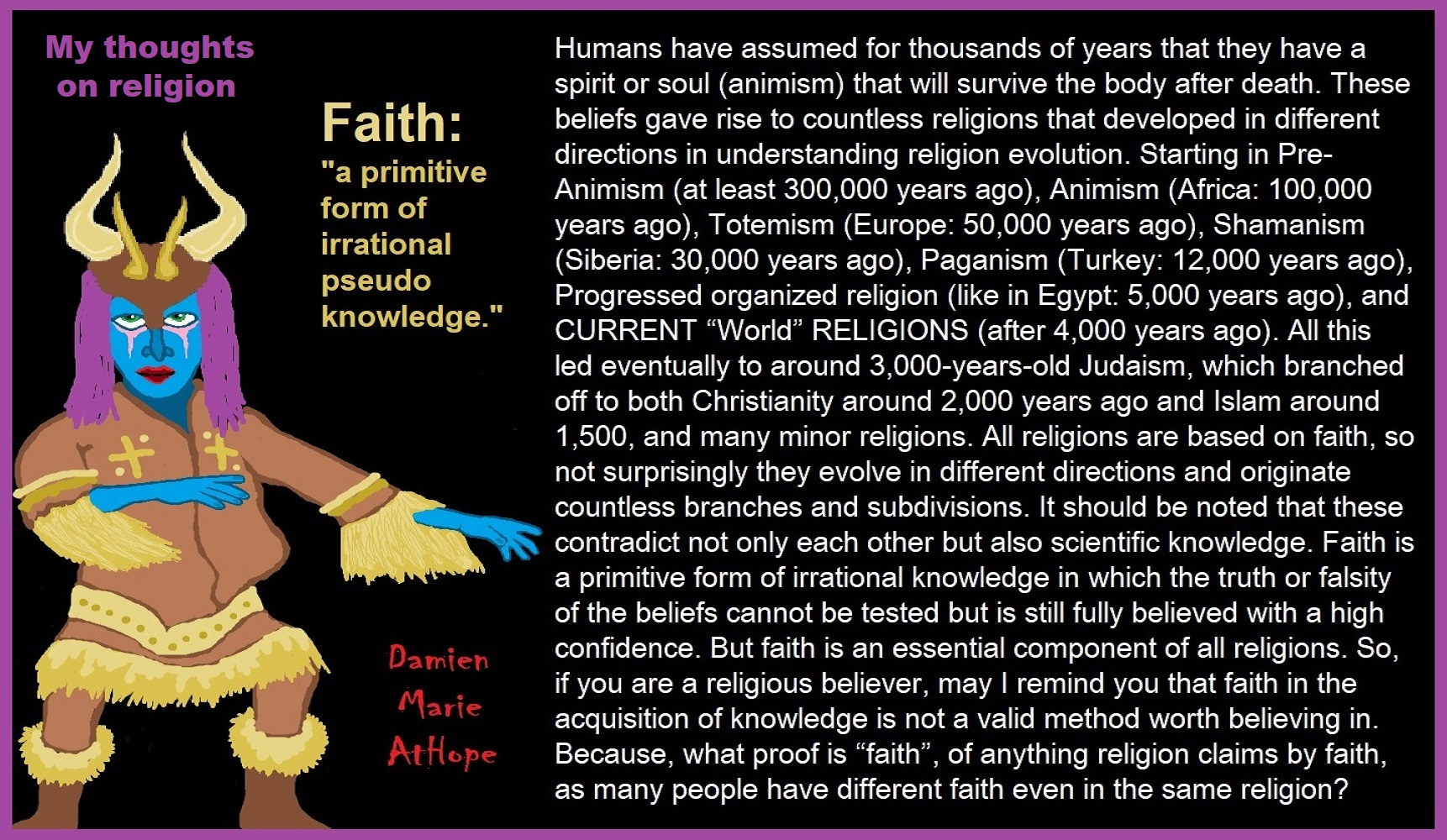
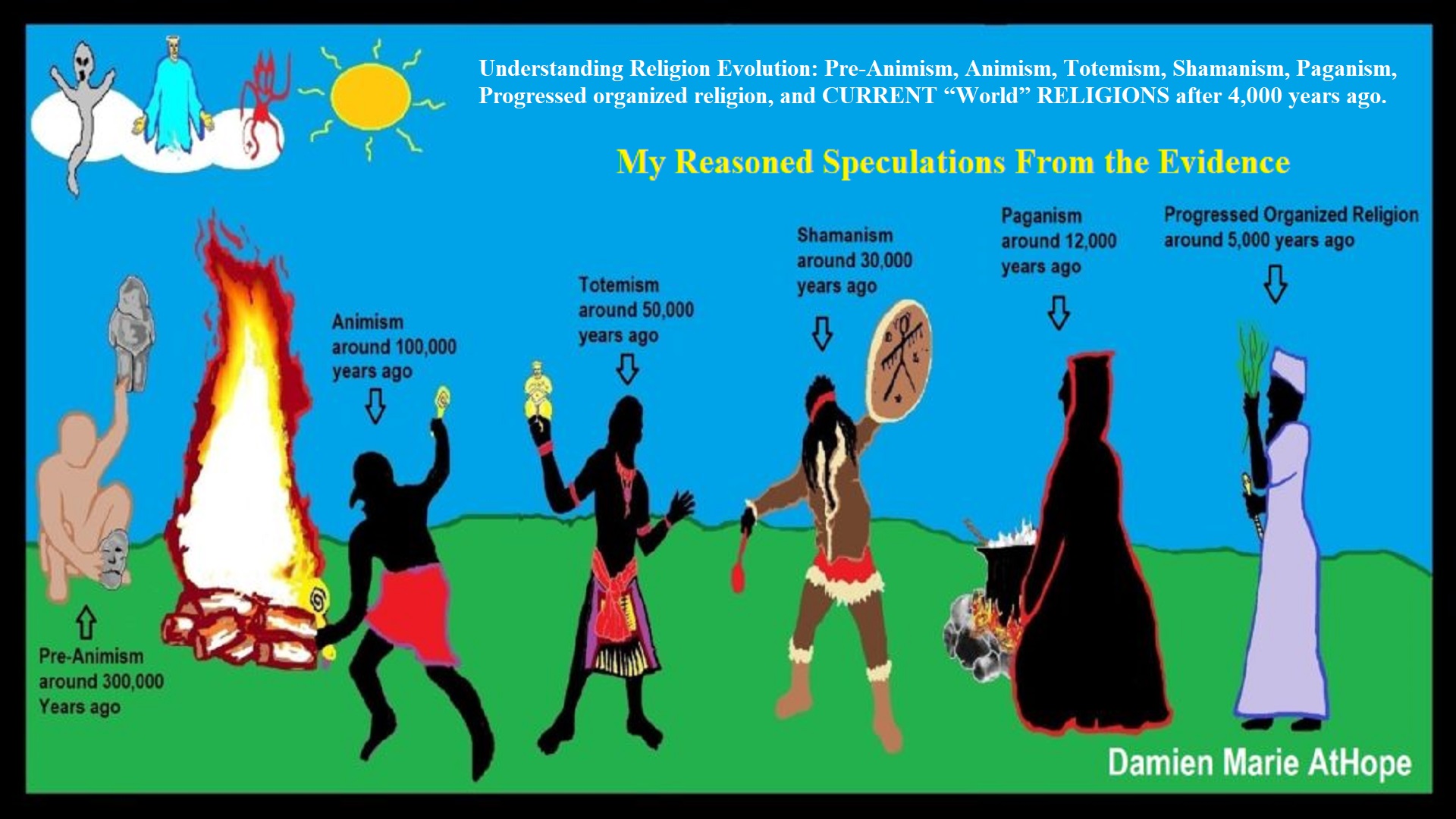
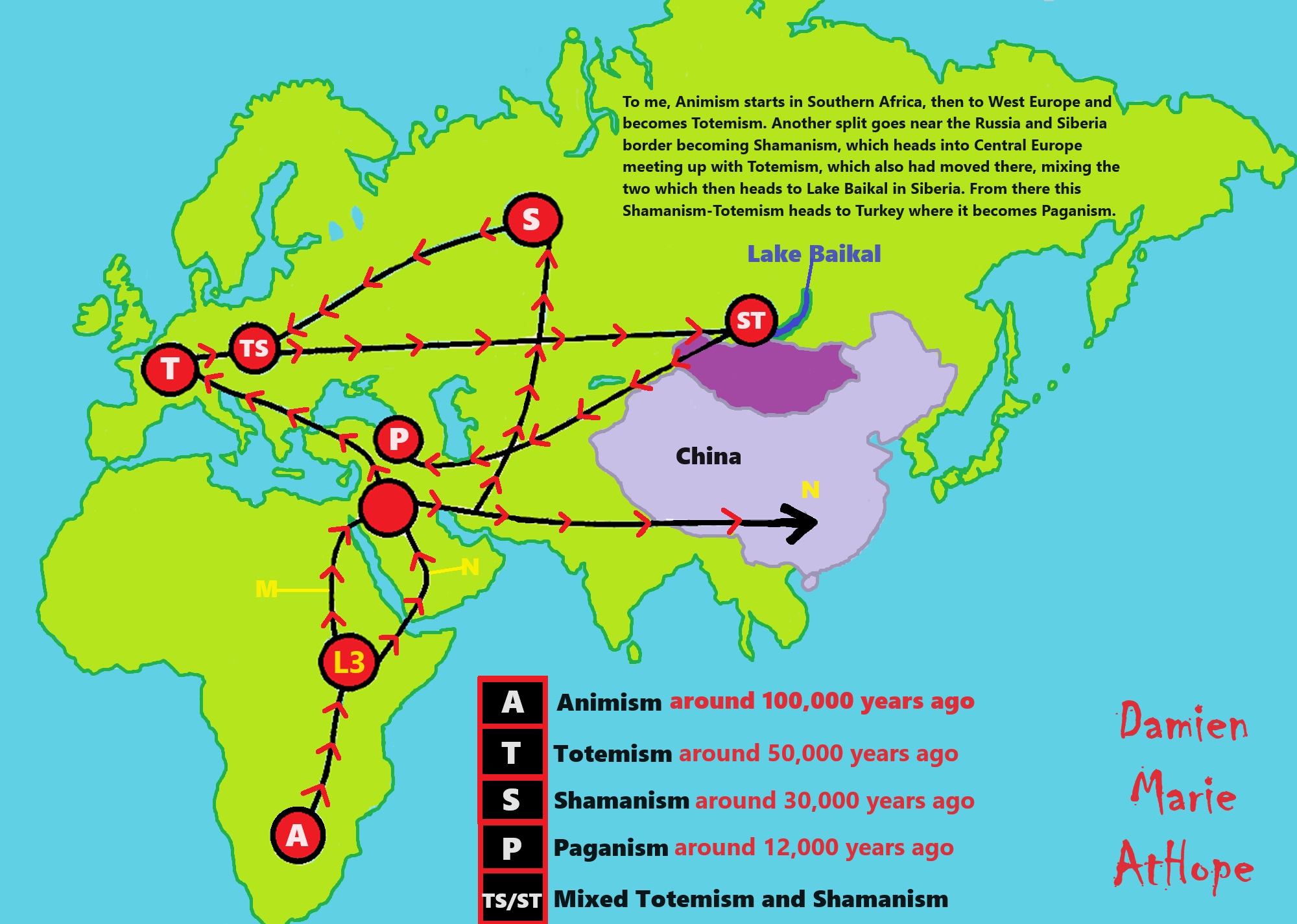
To me, Animism starts in Southern Africa, then to West Europe, and becomes Totemism. Another split goes near the Russia and Siberia border becoming Shamanism, which heads into Central Europe meeting up with Totemism, which also had moved there, mixing the two which then heads to Lake Baikal in Siberia. From there this Shamanism-Totemism heads to Turkey where it becomes Paganism.
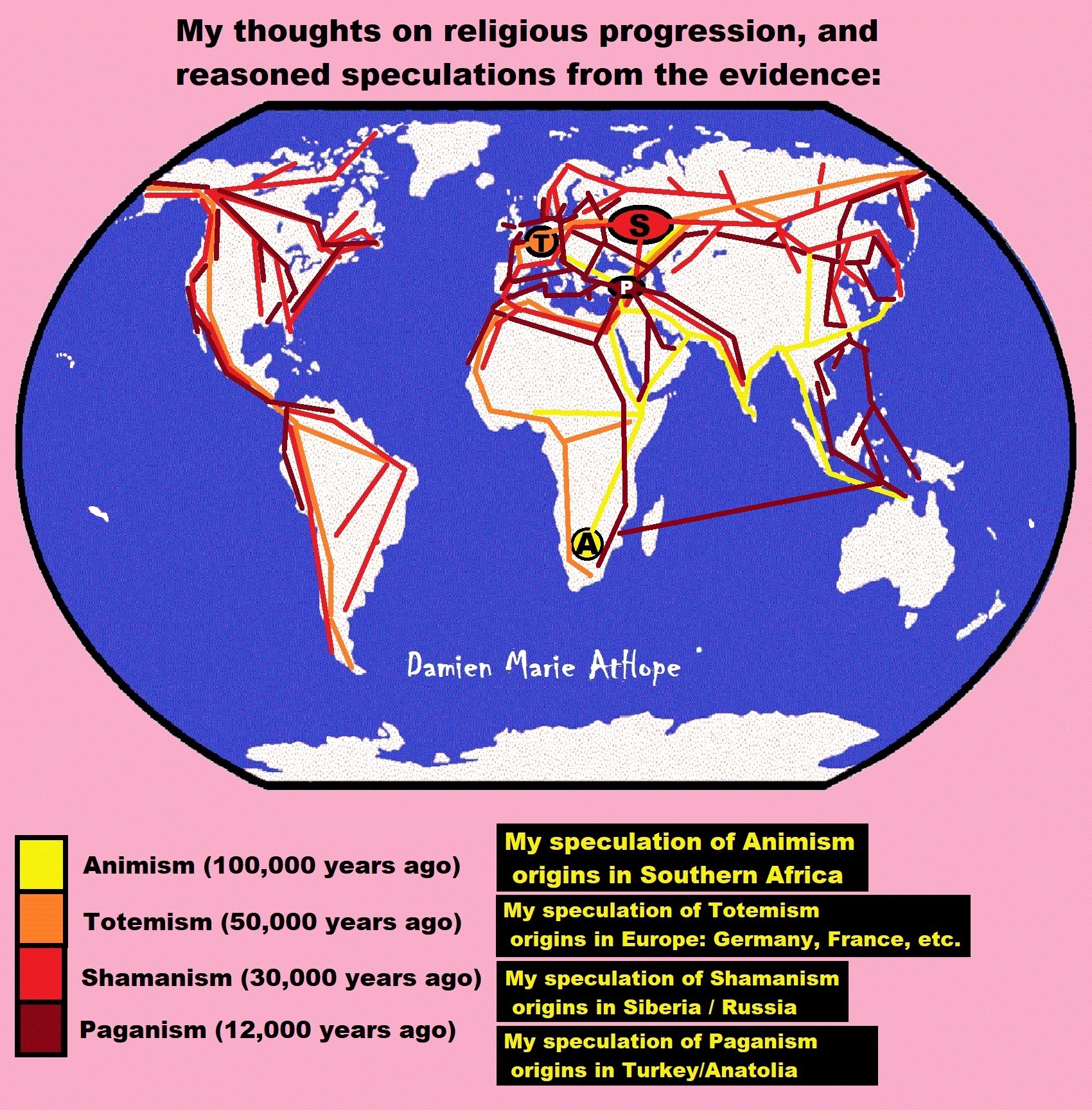
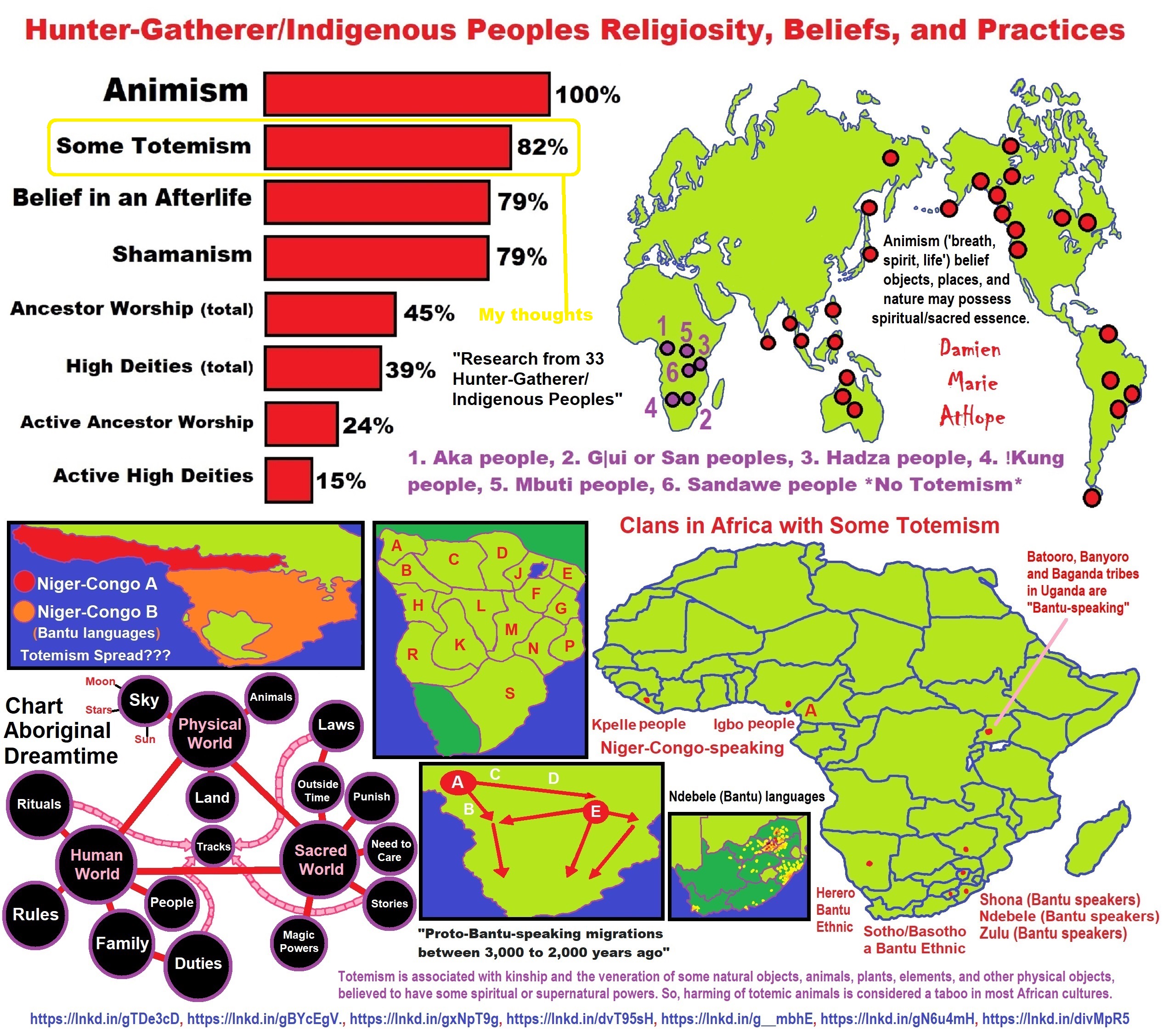
Not all “Religions” or “Religious Persuasions” have a god(s) but
All can be said to believe in some imaginary beings or imaginary things like spirits, afterlives, etc.
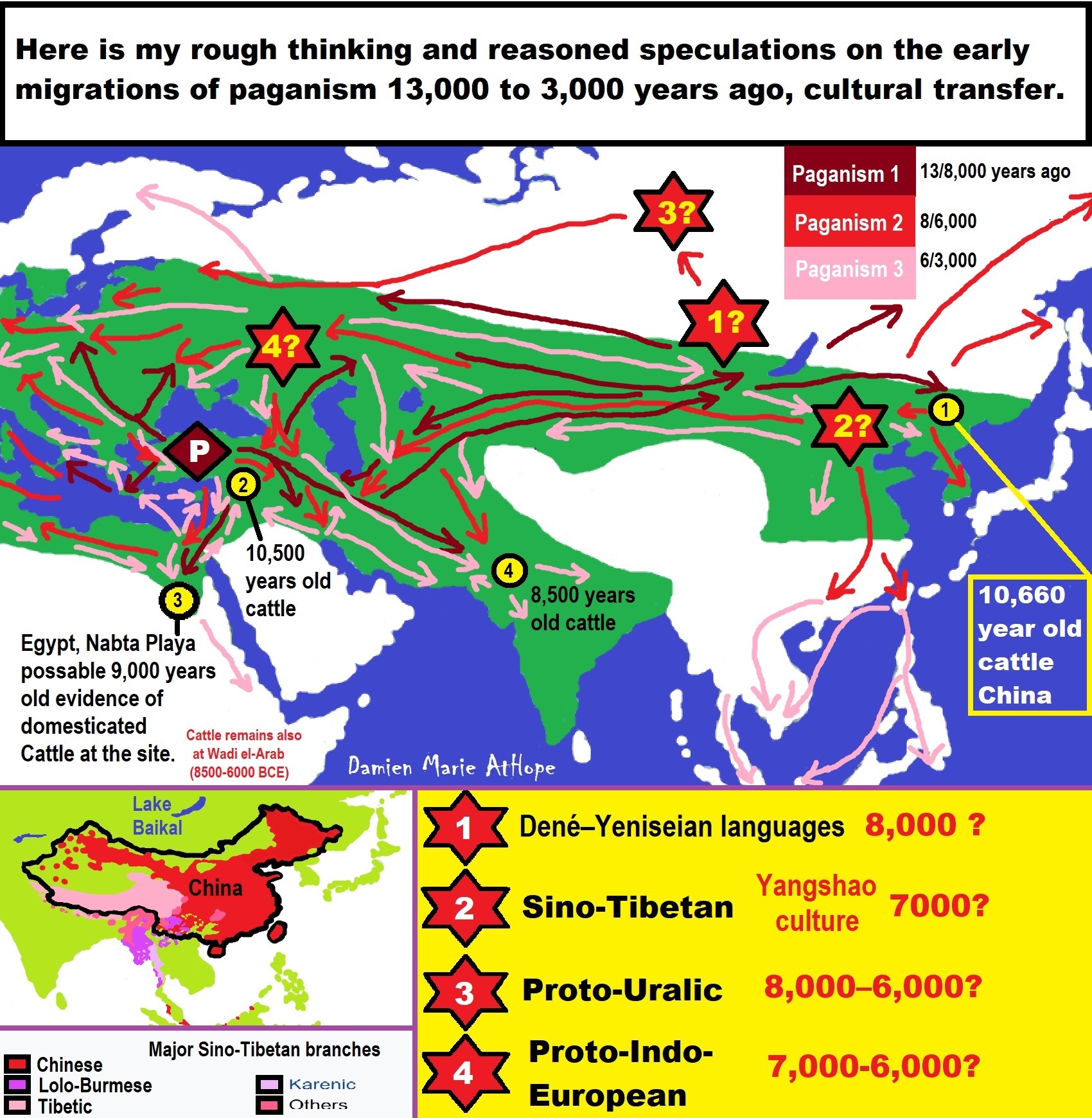
Paganism 12,000-4,000 years old
12,000-7,000 years old: related to (Pre-Capitalism)
7,000-5,000 years old: related to (Capitalism) (World War 0) Elite and their slaves!
5,000 years old: related to (Kings and the Rise of the State)
4,000 years old: related to (First Moralistic gods, then the Origin time of Monotheism)

ref, ref, ref, ref, ref, ref, ref, ref, ref, ref, ref, ref, ref, ref, ref, ref, ref, ref, ref, ref, ref
Low Gods “Earth” or Tutelary deity and High Gods “Sky” or Supreme deity
“An Earth goddess is a deification of the Earth. Earth goddesses are often associated with the “chthonic” deities of the underworld. Ki and Ninhursag are Mesopotamian earth goddesses. In Greek mythology, the Earth is personified as Gaia, corresponding to Roman Terra, Indic Prithvi/Bhūmi, etc. traced to an “Earth Mother” complementary to the “Sky Father” in Proto-Indo-European religion. Egyptian mythology exceptionally has a sky goddess and an Earth god.” ref
“A mother goddess is a goddess who represents or is a personification of nature, motherhood, fertility, creation, destruction or who embodies the bounty of the Earth. When equated with the Earth or the natural world, such goddesses are sometimes referred to as Mother Earth or as the Earth Mother. In some religious traditions or movements, Heavenly Mother (also referred to as Mother in Heaven or Sky Mother) is the wife or feminine counterpart of the Sky father or God the Father.” ref
“Any masculine sky god is often also king of the gods, taking the position of patriarch within a pantheon. Such king gods are collectively categorized as “sky father” deities, with a polarity between sky and earth often being expressed by pairing a “sky father” god with an “earth mother” goddess (pairings of a sky mother with an earth father are less frequent). A main sky goddess is often the queen of the gods and may be an air/sky goddess in her own right, though she usually has other functions as well with “sky” not being her main. In antiquity, several sky goddesses in ancient Egypt, Mesopotamia, and the Near East were called Queen of Heaven. Neopagans often apply it with impunity to sky goddesses from other regions who were never associated with the term historically. The sky often has important religious significance. Many religions, both polytheistic and monotheistic, have deities associated with the sky.” ref
“In comparative mythology, sky father is a term for a recurring concept in polytheistic religions of a sky god who is addressed as a “father”, often the father of a pantheon and is often either a reigning or former King of the Gods. The concept of “sky father” may also be taken to include Sun gods with similar characteristics, such as Ra. The concept is complementary to an “earth mother“. “Sky Father” is a direct translation of the Vedic Dyaus Pita, etymologically descended from the same Proto-Indo-European deity name as the Greek Zeûs Pater and Roman Jupiter and Germanic Týr, Tir or Tiwaz, all of which are reflexes of the same Proto-Indo-European deity’s name, *Dyēus Ph₂tḗr. While there are numerous parallels adduced from outside of Indo-European mythology, there are exceptions (e.g. In Egyptian mythology, Nut is the sky mother and Geb is the earth father).” ref
Tutelary deity
“A tutelary (also tutelar) is a deity or spirit who is a guardian, patron, or protector of a particular place, geographic feature, person, lineage, nation, culture, or occupation. The etymology of “tutelary” expresses the concept of safety and thus of guardianship. In late Greek and Roman religion, one type of tutelary deity, the genius, functions as the personal deity or daimon of an individual from birth to death. Another form of personal tutelary spirit is the familiar spirit of European folklore.” ref
“A tutelary (also tutelar) in Korean shamanism, jangseung and sotdae were placed at the edge of villages to frighten off demons. They were also worshiped as deities. Seonangshin is the patron deity of the village in Korean tradition and was believed to embody the Seonangdang. In Philippine animism, Diwata or Lambana are deities or spirits that inhabit sacred places like mountains and mounds and serve as guardians. Such as: Maria Makiling is the deity who guards Mt. Makiling and Maria Cacao and Maria Sinukuan. In Shinto, the spirits, or kami, which give life to human bodies come from nature and return to it after death. Ancestors are therefore themselves tutelaries to be worshiped. And similarly, Native American beliefs such as Tonás, tutelary animal spirit among the Zapotec and Totems, familial or clan spirits among the Ojibwe, can be animals.” ref
“A tutelary (also tutelar) in Austronesian beliefs such as: Atua (gods and spirits of the Polynesian peoples such as the Māori or the Hawaiians), Hanitu (Bunun of Taiwan‘s term for spirit), Hyang (Kawi, Sundanese, Javanese, and Balinese Supreme Being, in ancient Java and Bali mythology and this spiritual entity, can be either divine or ancestral), Kaitiaki (New Zealand Māori term used for the concept of guardianship, for the sky, the sea, and the land), Kawas (mythology) (divided into 6 groups: gods, ancestors, souls of the living, spirits of living things, spirits of lifeless objects, and ghosts), Tiki (Māori mythology, Tiki is the first man created by either Tūmatauenga or Tāne and represents deified ancestors found in most Polynesian cultures). ” ref, ref, ref, ref, ref, ref, ref
Mesopotamian Tutelary Deities can be seen as ones related to City-States
“Historical city-states included Sumerian cities such as Uruk and Ur; Ancient Egyptian city-states, such as Thebes and Memphis; the Phoenician cities (such as Tyre and Sidon); the five Philistine city-states; the Berber city-states of the Garamantes; the city-states of ancient Greece (the poleis such as Athens, Sparta, Thebes, and Corinth); the Roman Republic (which grew from a city-state into a vast empire); the Italian city-states from the Middle Ages to the early modern period, such as Florence, Siena, Ferrara, Milan (which as they grew in power began to dominate neighboring cities) and Genoa and Venice, which became powerful thalassocracies; the Mayan and other cultures of pre-Columbian Mesoamerica (including cities such as Chichen Itza, Tikal, Copán and Monte Albán); the central Asian cities along the Silk Road; the city-states of the Swahili coast; Ragusa; states of the medieval Russian lands such as Novgorod and Pskov; and many others.” ref
“The Uruk period (ca. 4000 to 3100 BCE; also known as Protoliterate period) of Mesopotamia, named after the Sumerian city of Uruk, this period saw the emergence of urban life in Mesopotamia and the Sumerian civilization. City-States like Uruk and others had a patron tutelary City Deity along with a Priest-King.” ref
“Chinese folk religion, both past, and present, includes myriad tutelary deities. Exceptional individuals, highly cultivated sages, and prominent ancestors can be deified and honored after death. Lord Guan is the patron of military personnel and police, while Mazu is the patron of fishermen and sailors. Such as Tu Di Gong (Earth Deity) is the tutelary deity of a locality, and each individual locality has its own Earth Deity and Cheng Huang Gong (City God) is the guardian deity of an individual city, worshipped by local officials and locals since imperial times.” ref
“A tutelary (also tutelar) in Hinduism, personal tutelary deities are known as ishta-devata, while family tutelary deities are known as Kuladevata. Gramadevata are guardian deities of villages. Devas can also be seen as tutelary. Shiva is the patron of yogis and renunciants. City goddesses include: Mumbadevi (Mumbai), Sachchika (Osian); Kuladevis include: Ambika (Porwad), and Mahalakshmi. In NorthEast India Meitei mythology and religion (Sanamahism) of Manipur, there are various types of tutelary deities, among which Lam Lais are the most predominant ones. Tibetan Buddhism has Yidam as a tutelary deity. Dakini is the patron of those who seek knowledge.” ref
“A tutelary (also tutelar) The Greeks also thought deities guarded specific places: for instance, Athena was the patron goddess of the city of Athens. Socrates spoke of hearing the voice of his personal spirit or daimonion:
You have often heard me speak of an oracle or sign which comes to me … . This sign I have had ever since I was a child. The sign is a voice which comes to me and always forbids me to do something which I am going to do, but never commands me to do anything, and this is what stands in the way of my being a politician.” ref
“Tutelary deities who guard and preserve a place or a person are fundamental to ancient Roman religion. The tutelary deity of a man was his Genius, that of a woman her Juno. In the Imperial era, the Genius of the Emperor was a focus of Imperial cult. An emperor might also adopt a major deity as his personal patron or tutelary, as Augustus did Apollo. Precedents for claiming the personal protection of a deity were established in the Republican era, when for instance the Roman dictator Sulla advertised the goddess Victory as his tutelary by holding public games (ludi) in her honor.” ref
“Each town or city had one or more tutelary deities, whose protection was considered particularly vital in time of war and siege. Rome itself was protected by a goddess whose name was to be kept ritually secret on pain of death (for a supposed case, see Quintus Valerius Soranus). The Capitoline Triad of Juno, Jupiter, and Minerva were also tutelaries of Rome. The Italic towns had their own tutelary deities. Juno often had this function, as at the Latin town of Lanuvium and the Etruscan city of Veii, and was often housed in an especially grand temple on the arx (citadel) or other prominent or central location. The tutelary deity of Praeneste was Fortuna, whose oracle was renowned.” ref
“The Roman ritual of evocatio was premised on the belief that a town could be made vulnerable to military defeat if the power of its tutelary deity were diverted outside the city, perhaps by the offer of superior cult at Rome. The depiction of some goddesses such as the Magna Mater (Great Mother, or Cybele) as “tower-crowned” represents their capacity to preserve the city. A town in the provinces might adopt a deity from within the Roman religious sphere to serve as its guardian, or syncretize its own tutelary with such; for instance, a community within the civitas of the Remi in Gaul adopted Apollo as its tutelary, and at the capital of the Remi (present-day Rheims), the tutelary was Mars Camulus.” ref
Household deity (a kind of or related to a Tutelary deity)
“A household deity is a deity or spirit that protects the home, looking after the entire household or certain key members. It has been a common belief in paganism as well as in folklore across many parts of the world. Household deities fit into two types; firstly, a specific deity – typically a goddess – often referred to as a hearth goddess or domestic goddess who is associated with the home and hearth, such as the ancient Greek Hestia.” ref
“The second type of household deities are those that are not one singular deity, but a type, or species of animistic deity, who usually have lesser powers than major deities. This type was common in the religions of antiquity, such as the Lares of ancient Roman religion, the Gashin of Korean shamanism, and Cofgodas of Anglo-Saxon paganism. These survived Christianisation as fairy-like creatures existing in folklore, such as the Anglo-Scottish Brownie and Slavic Domovoy.” ref
“Household deities were usually worshipped not in temples but in the home, where they would be represented by small idols (such as the teraphim of the Bible, often translated as “household gods” in Genesis 31:19 for example), amulets, paintings, or reliefs. They could also be found on domestic objects, such as cosmetic articles in the case of Tawaret. The more prosperous houses might have a small shrine to the household god(s); the lararium served this purpose in the case of the Romans. The gods would be treated as members of the family and invited to join in meals, or be given offerings of food and drink.” ref
“In many religions, both ancient and modern, a god would preside over the home. Certain species, or types, of household deities, existed. An example of this was the Roman Lares. Many European cultures retained house spirits into the modern period. Some examples of these include:
- Brownie (Scotland and England) or Hob (England) / Kobold (Germany) / Goblin / Hobgoblin
- Domovoy (Slavic)
- Nisse (Norwegian or Danish) / Tomte (Swedish) / Tonttu (Finnish)
- Húsvættir (Norse)” ref
“Although the cosmic status of household deities was not as lofty as that of the Twelve Olympians or the Aesir, they were also jealous of their dignity and also had to be appeased with shrines and offerings, however humble. Because of their immediacy they had arguably more influence on the day-to-day affairs of men than the remote gods did. Vestiges of their worship persisted long after Christianity and other major religions extirpated nearly every trace of the major pagan pantheons. Elements of the practice can be seen even today, with Christian accretions, where statues to various saints (such as St. Francis) protect gardens and grottos. Even the gargoyles found on older churches, could be viewed as guardians partitioning a sacred space.” ref
“For centuries, Christianity fought a mop-up war against these lingering minor pagan deities, but they proved tenacious. For example, Martin Luther‘s Tischreden have numerous – quite serious – references to dealing with kobolds. Eventually, rationalism and the Industrial Revolution threatened to erase most of these minor deities, until the advent of romantic nationalism rehabilitated them and embellished them into objects of literary curiosity in the 19th century. Since the 20th century this literature has been mined for characters for role-playing games, video games, and other fantasy personae, not infrequently invested with invented traits and hierarchies somewhat different from their mythological and folkloric roots.” ref
“In contradistinction to both Herbert Spencer and Edward Burnett Tylor, who defended theories of animistic origins of ancestor worship, Émile Durkheim saw its origin in totemism. In reality, this distinction is somewhat academic, since totemism may be regarded as a particularized manifestation of animism, and something of a synthesis of the two positions was attempted by Sigmund Freud. In Freud’s Totem and Taboo, both totem and taboo are outward expressions or manifestations of the same psychological tendency, a concept which is complementary to, or which rather reconciles, the apparent conflict. Freud preferred to emphasize the psychoanalytic implications of the reification of metaphysical forces, but with particular emphasis on its familial nature. This emphasis underscores, rather than weakens, the ancestral component.” ref
“William Edward Hearn, a noted classicist, and jurist, traced the origin of domestic deities from the earliest stages as an expression of animism, a belief system thought to have existed also in the neolithic, and the forerunner of Indo-European religion. In his analysis of the Indo-European household, in Chapter II “The House Spirit”, Section 1, he states:
The belief which guided the conduct of our forefathers was … the spirit rule of dead ancestors.” ref
“In Section 2 he proceeds to elaborate:
It is thus certain that the worship of deceased ancestors is a vera causa, and not a mere hypothesis. …
In the other European nations, the Slavs, the Teutons, and the Kelts, the House Spirit appears with no less distinctness. … [T]he existence of that worship does not admit of doubt. … The House Spirits had a multitude of other names which it is needless here to enumerate, but all of which are more or less expressive of their friendly relations with man. … In [England] … [h]e is the Brownie. … In Scotland this same Brownie is well known. He is usually described as attached to particular families, with whom he has been known to reside for centuries, threshing the corn, cleaning the house, and performing similar household tasks. His favorite gratification was milk and honey.” ref

ref, ref, ref, ref, ref, ref, ref, ref, ref, ref, ref, ref, ref, ref, ref, ref, ref
“These ideas are my speculations from the evidence.”
I am still researching the “god‘s origins” all over the world. So you know, it is very complicated but I am smart and willing to look, DEEP, if necessary, which going very deep does seem to be needed here, when trying to actually understand the evolution of gods and goddesses. I am sure of a few things and less sure of others, but even in stuff I am not fully grasping I still am slowly figuring it out, to explain it to others. But as I research more I am understanding things a little better, though I am still working on understanding it all or something close and thus always figuring out more.
Sky Father/Sky God?
“Egyptian: (Nut) Sky Mother and (Geb) Earth Father” (Egypt is different but similar)
Turkic/Mongolic: (Tengri/Tenger Etseg) Sky Father and (Eje/Gazar Eej) Earth Mother *Transeurasian*
Hawaiian: (Wākea) Sky Father and (Papahānaumoku) Earth Mother *Austronesian*
New Zealand/ Māori: (Ranginui) Sky Father and (Papatūānuku) Earth Mother *Austronesian*
Proto-Indo-European: (Dyḗus/Dyḗus ph₂tḗr) Sky Father and (Dʰéǵʰōm/Pleth₂wih₁) Earth Mother
Indo-Aryan: (Dyaus Pita) Sky Father and (Prithvi Mata) Earth Mother *Indo-European*
Italic: (Jupiter) Sky Father and (Juno) Sky Mother *Indo-European*
Etruscan: (Tinia) Sky Father and (Uni) Sky Mother *Tyrsenian/Italy Pre–Indo-European*
Hellenic/Greek: (Zeus) Sky Father and (Hera) Sky Mother who started as an “Earth Goddess” *Indo-European*
Nordic: (Dagr) Sky Father and (Nótt) Sky Mother *Indo-European*
Slavic: (Perun) Sky Father and (Mokosh) Earth Mother *Indo-European*
Illyrian: (Deipaturos) Sky Father and (Messapic Damatura’s “earth-mother” maybe) Earth Mother *Indo-European*
Albanian: (Zojz) Sky Father and (?) *Indo-European*
Baltic: (Perkūnas) Sky Father and (Saulė) Sky Mother *Indo-European*
Germanic: (Týr) Sky Father and (?) *Indo-European*
Colombian-Muisca: (Bochica) Sky Father and (Huythaca) Sky Mother *Chibchan*
Aztec: (Quetzalcoatl) Sky Father and (Xochiquetzal) Sky Mother *Uto-Aztecan*
Incan: (Viracocha) Sky Father and (Mama Runtucaya) Sky Mother *Quechuan*
China: (Tian/Shangdi) Sky Father and (Dì) Earth Mother *Sino-Tibetan*
Sumerian, Assyrian and Babylonian: (An/Anu) Sky Father and (Ki) Earth Mother
Finnish: (Ukko) Sky Father and (Akka) Earth Mother *Finno-Ugric*
Sami: (Horagalles) Sky Father and (Ravdna) Earth Mother *Finno-Ugric*
Puebloan-Zuni: (Ápoyan Ta’chu) Sky Father and (Áwitelin Tsíta) Earth Mother
Puebloan-Hopi: (Tawa) Sky Father and (Kokyangwuti/Spider Woman/Grandmother) Earth Mother *Uto-Aztecan*
Puebloan-Navajo: (Tsohanoai) Sky Father and (Estsanatlehi) Earth Mother *Na-Dene*
ref, ref, ref, ref, ref, ref, ref, ref, ref, ref, ref, ref, ref, ref, ref, ref, ref, ref, ref, ref, ref, ref, ref, ref, ref, ref, ref
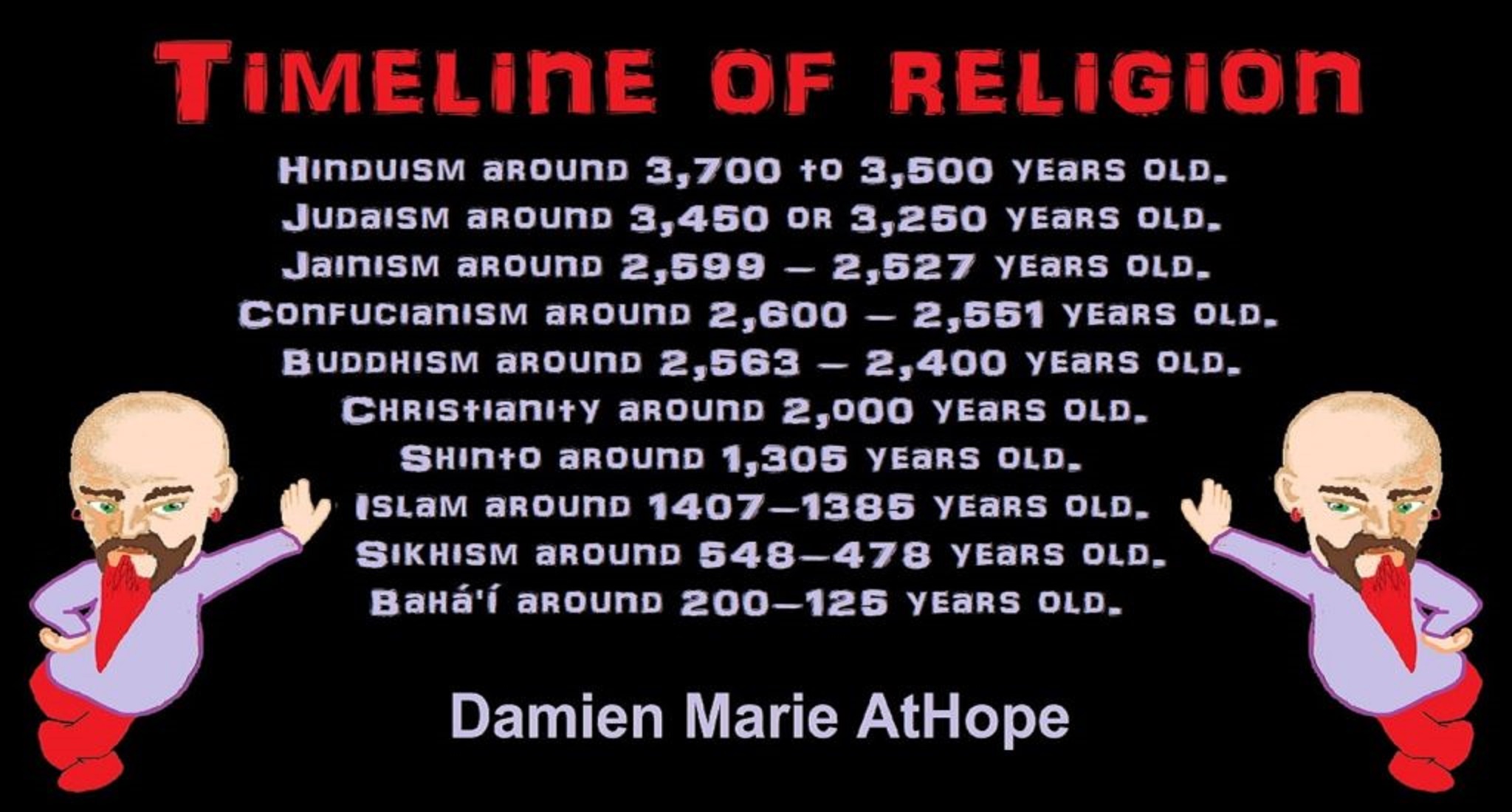
Hinduism around 3,700 to 3,500 years old. ref
Judaism around 3,450 or 3,250 years old. (The first writing in the bible was “Paleo-Hebrew” dated to around 3,000 years ago Khirbet Qeiyafa is the site of an ancient fortress city overlooking the Elah Valley. And many believe the religious Jewish texts were completed around 2,500) ref, ref
Judaism is around 3,450 or 3,250 years old. (“Paleo-Hebrew” 3,000 years ago and Torah 2,500 years ago)
“Judaism is an Abrahamic, its roots as an organized religion in the Middle East during the Bronze Age. Some scholars argue that modern Judaism evolved from Yahwism, the religion of ancient Israel and Judah, by the late 6th century BCE, and is thus considered to be one of the oldest monotheistic religions.” ref
“Yahwism is the name given by modern scholars to the religion of ancient Israel, essentially polytheistic, with a plethora of gods and goddesses. Heading the pantheon was Yahweh, the national god of the Israelite kingdoms of Israel and Judah, with his consort, the goddess Asherah; below them were second-tier gods and goddesses such as Baal, Shamash, Yarikh, Mot, and Astarte, all of whom had their own priests and prophets and numbered royalty among their devotees, and a third and fourth tier of minor divine beings, including the mal’ak, the messengers of the higher gods, who in later times became the angels of Judaism, Christianity and Islam. Yahweh, however, was not the ‘original’ god of Israel “Isra-El”; it is El, the head of the Canaanite pantheon, whose name forms the basis of the name “Israel”, and none of the Old Testament patriarchs, the tribes of Israel, the Judges, or the earliest monarchs, have a Yahwistic theophoric name (i.e., one incorporating the name of Yahweh).” ref
“El is a Northwest Semitic word meaning “god” or “deity“, or referring (as a proper name) to any one of multiple major ancient Near Eastern deities. A rarer form, ‘ila, represents the predicate form in Old Akkadian and in Amorite. The word is derived from the Proto-Semitic *ʔil-, meaning “god”. Specific deities known as ‘El or ‘Il include the supreme god of the ancient Canaanite religion and the supreme god of East Semitic speakers in Mesopotamia’s Early Dynastic Period. ʼĒl is listed at the head of many pantheons. In some Canaanite and Ugaritic sources, ʼĒl played a role as father of the gods, of creation, or both. For example, in the Ugaritic texts, ʾil mlk is understood to mean “ʼĒl the King” but ʾil hd as “the god Hadad“. The Semitic root ʾlh (Arabic ʾilāh, Aramaic ʾAlāh, ʾElāh, Hebrew ʾelōah) may be ʾl with a parasitic h, and ʾl may be an abbreviated form of ʾlh. In Ugaritic the plural form meaning “gods” is ʾilhm, equivalent to Hebrew ʾelōhîm “powers”. In the Hebrew texts this word is interpreted as being semantically singular for “god” by biblical commentators. However the documentary hypothesis for the Old Testament (corresponds to the Jewish Torah) developed originally in the 1870s, identifies these that different authors – the Jahwist, Elohist, Deuteronomist, and the Priestly source – were responsible for editing stories from a polytheistic religion into those of a monotheistic religion. Inconsistencies that arise between monotheism and polytheism in the texts are reflective of this hypothesis.” ref
Jainism around 2,599 – 2,527 years old. ref
Confucianism around 2,600 – 2,551 years old. ref
Buddhism around 2,563/2,480 – 2,483/2,400 years old. ref
Christianity around 2,o00 years old. ref
Shinto around 1,305 years old. ref
Islam around 1407–1385 years old. ref
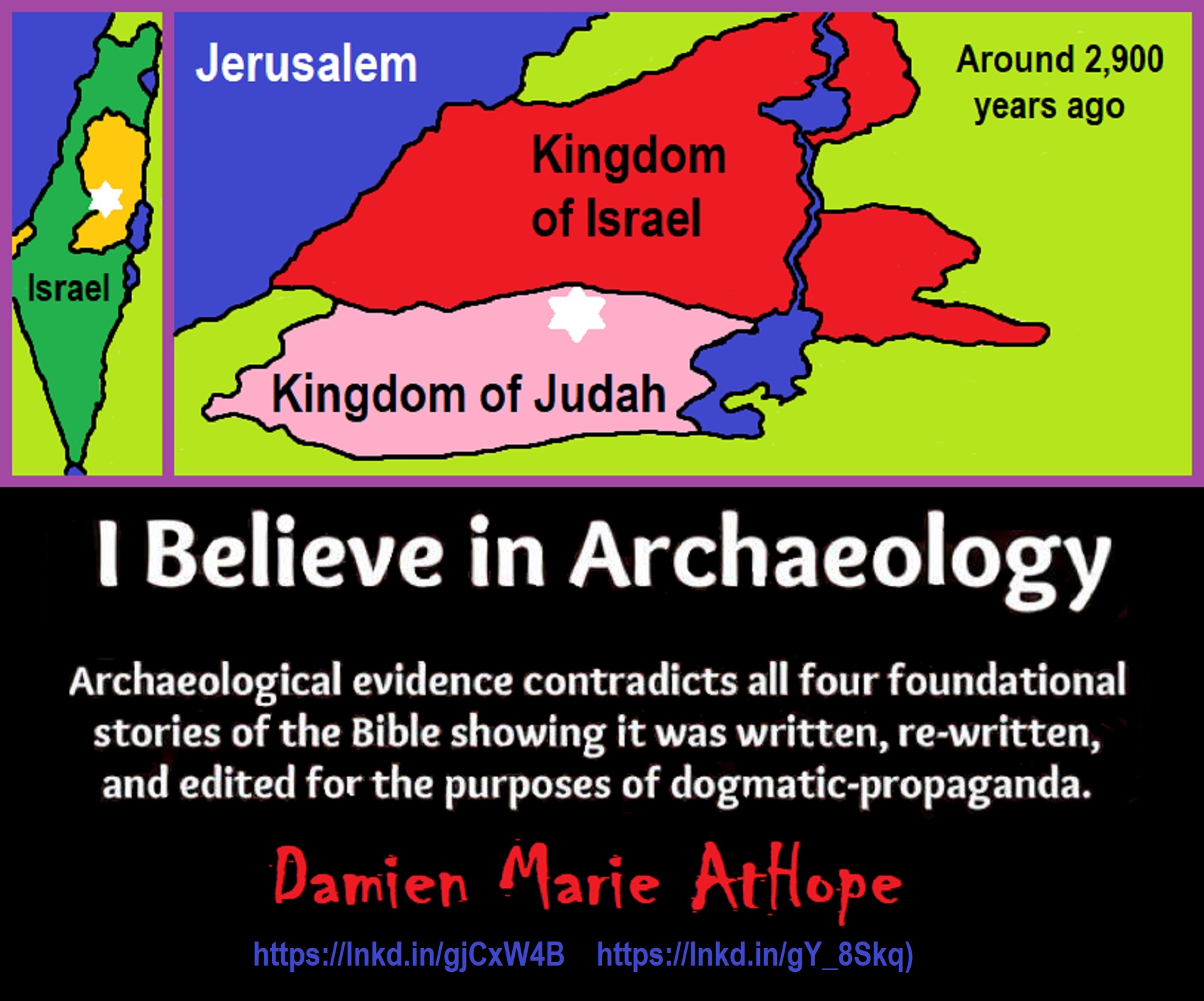
Knowledge to Ponder:
Stars/Astrology:
- Possibly, around 30,000 years ago (in simpler form) to 6,000 years ago, Stars/Astrology are connected to Ancestors, Spirit Animals, and Deities.
- The star also seems to be a possible proto-star for Star of Ishtar, Star of Inanna, or Star of Venus.
- Around 7,000 to 6,000 years ago, Star Constellations/Astrology have connections to the “Kurgan phenomenon” of below-ground “mound” stone/wood burial structures and “Dolmen phenomenon” of above-ground stone burial structures.
- Around 6,500–5,800 years ago, The Northern Levant migrations into Jordon and Israel in the Southern Levant brought new cultural and religious transfer from Turkey and Iran.
- “The Ghassulian Star,” a mysterious 6,000-year-old mural from Jordan may have connections to the European paganstic kurgan/dolmens phenomenon.
“Astrology is a range of divinatory practices, recognized as pseudoscientific since the 18th century, that claim to discern information about human affairs and terrestrial events by studying the apparent positions of celestial objects. Different cultures have employed forms of astrology since at least the 2nd millennium BCE, these practices having originated in calendrical systems used to predict seasonal shifts and to interpret celestial cycles as signs of divine communications. Most, if not all, cultures have attached importance to what they observed in the sky, and some—such as the Hindus, Chinese, and the Maya—developed elaborate systems for predicting terrestrial events from celestial observations. Western astrology, one of the oldest astrological systems still in use, can trace its roots to 19th–17th century BCE Mesopotamia, from where it spread to Ancient Greece, Rome, the Islamicate world and eventually Central and Western Europe. Contemporary Western astrology is often associated with systems of horoscopes that purport to explain aspects of a person’s personality and predict significant events in their lives based on the positions of celestial objects; the majority of professional astrologers rely on such systems.” ref
Around 5,500 years ago, Science evolves, The first evidence of science was 5,500 years ago and was demonstrated by a body of empirical, theoretical, and practical knowledge about the natural world. ref
Around 5,000 years ago, Origin of Logics is a Naturalistic Observation (principles of valid reasoning, inference, & demonstration) ref
Around 4,150 to 4,000 years ago: The earliest surviving versions of the Sumerian Epic of Gilgamesh, which was originally titled “He who Saw the Deep” (Sha naqba īmuru) or “Surpassing All Other Kings” (Shūtur eli sharrī) were written. ref
Hinduism:
- 3,700 years ago or so, the oldest of the Hindu Vedas (scriptures), the Rig Veda was composed.
- 3,500 years ago or so, the Vedic Age began in India after the collapse of the Indus Valley Civilization.
Judaism:
- around 3,000 years ago, the first writing in the bible was “Paleo-Hebrew”
- around 2,500 years ago, many believe the religious Jewish texts were completed
Myths: The bible inspired religion is not just one religion or one myth but a grouping of several religions and myths
- Around 3,450 or 3,250 years ago, according to legend, is the traditionally accepted period in which the Israelite lawgiver, Moses, provided the Ten Commandments.
- Around 2,500 to 2,400 years ago, a collection of ancient religious writings by the Israelites based primarily upon the Hebrew Bible, Tanakh, or Old Testament is the first part of Christianity’s bible.
- Around 2,400 years ago, the most accepted hypothesis is that the canon was formed in stages, first the Pentateuch (Torah).
- Around 2,140 to 2,116 years ago, the Prophets was written during the Hasmonean dynasty, and finally the remaining books.
- Christians traditionally divide the Old Testament into four sections:
- The first five books or Pentateuch (Torah).
- The proposed history books telling the history of the Israelites from their conquest of Canaan to their defeat and exile in Babylon.
- The poetic and proposed “Wisdom books” dealing, in various forms, with questions of good and evil in the world.
- The books of the biblical prophets, warning of the consequences of turning away from God:
- Henotheism:
- Exodus 20:23 “You shall not make other gods besides Me (not saying there are no other gods just not to worship them); gods of silver or gods of gold, you shall not make for yourselves.”
- Polytheism:
- Judges 10:6 “Then the sons of Israel again did evil in the sight of the LORD, served the Baals and the Ashtaroth, the gods of Aram, the gods of Sidon, the gods of Moab, the gods of the sons of Ammon, and the gods of the Philistines; thus they forsook the LORD and did not serve Him.”
- 1 Corinthians 8:5 “For even if there are so-called gods whether in heaven or on earth, as indeed there are many gods and many lords.”
- Monotheism:
- Isaiah 43:10 “You are my witnesses,” declares the LORD, “and my servant whom I have chosen, so that you may know and believe me and understand that I am he. Before me no god was formed, nor will there be one after me.
Around 2,570 to 2,270 Years Ago, there is a confirmation of atheistic doubting as well as atheistic thinking, mainly by Greek philosophers. However, doubting gods is likely as old as the invention of gods and should destroy the thinking that belief in god(s) is the “default belief”. The Greek word is apistos (a “not” and pistos “faithful,”), thus not faithful or faithless because one is unpersuaded and unconvinced by a god(s) claim. Short Definition: unbelieving, unbeliever, or unbelief.

Expressions of Atheistic Thinking:
- Around 2,600 years ago, Ajita Kesakambali, ancient Indian philosopher, who is the first known proponent of Indian materialism. ref
- Around 2,535 to 2,475 years ago, Heraclitus, Greek pre-Socratic philosopher, a native of the Greek city Ephesus, Ionia, on the coast of Anatolia, also known as Asia Minor or modern Turkey. ref
- Around 2,500 to 2,400 years ago, according to The Story of Civilization book series certain African pygmy tribes have no identifiable gods, spirits, or religious beliefs or rituals, and even what burials accrue are without ceremony. ref
- Around 2,490 to 2,430 years ago, Empedocles, Greek pre-Socratic philosopher and a citizen of Agrigentum, a Greek city in Sicily. ref
- Around 2,460 to 2,370 years ago, Democritus, Greek pre-Socratic philosopher considered to be the “father of modern science” possibly had some disbelief amounting to atheism. ref
- Around 2,399 years ago or so, Socrates, a famous Greek philosopher was tried for sinfulness by teaching doubt of state gods. ref
- Around 2,341 to 2,270 years ago, Epicurus, a Greek philosopher known for composing atheistic critics and famously stated, “Is God willing to prevent evil, but not able? Then he is not omnipotent. Is he able, but not willing? Then he is malevolent. Is he both able and willing? Then whence cometh evil? Is he neither able nor willing? Then why call him god?” ref
This last expression by Epicurus, seems to be an expression of Axiological Atheism. To understand and utilize value or actually possess “Value Conscious/Consciousness” to both give a strong moral “axiological” argument (the problem of evil) as well as use it to fortify humanism and positive ethical persuasion of human helping and care responsibilities. Because value-blindness gives rise to sociopathic/psychopathic evil.
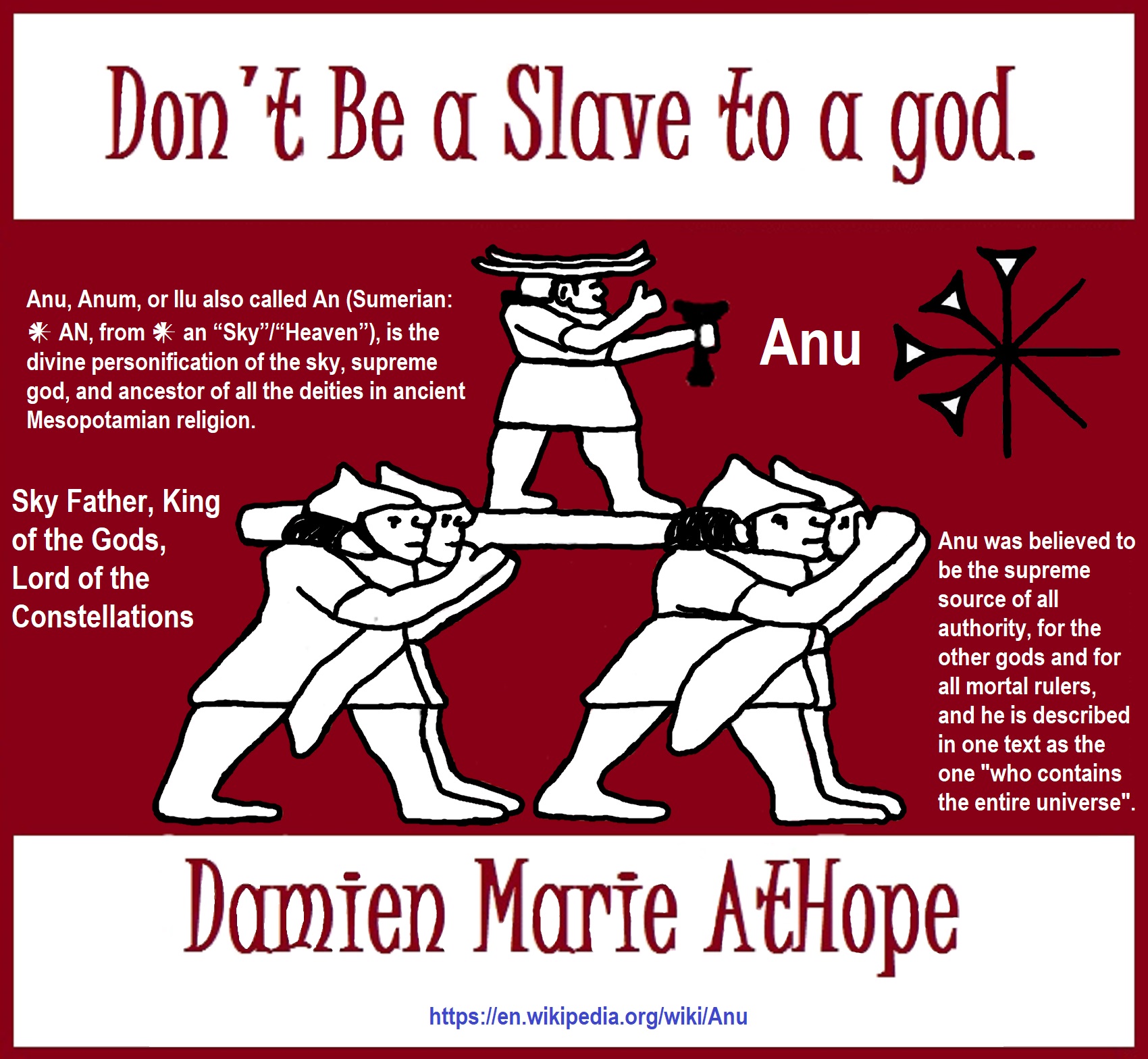
“Theists, there has to be a god, as something can not come from nothing.”
Well, thus something (unknown) happened and then there was something. This does not tell us what the something that may have been involved with something coming from nothing. A supposed first cause, thus something (unknown) happened and then there was something is not an open invitation to claim it as known, neither is it justified to call or label such an unknown as anything, especially an unsubstantiated magical thinking belief born of mythology and religious storytelling.
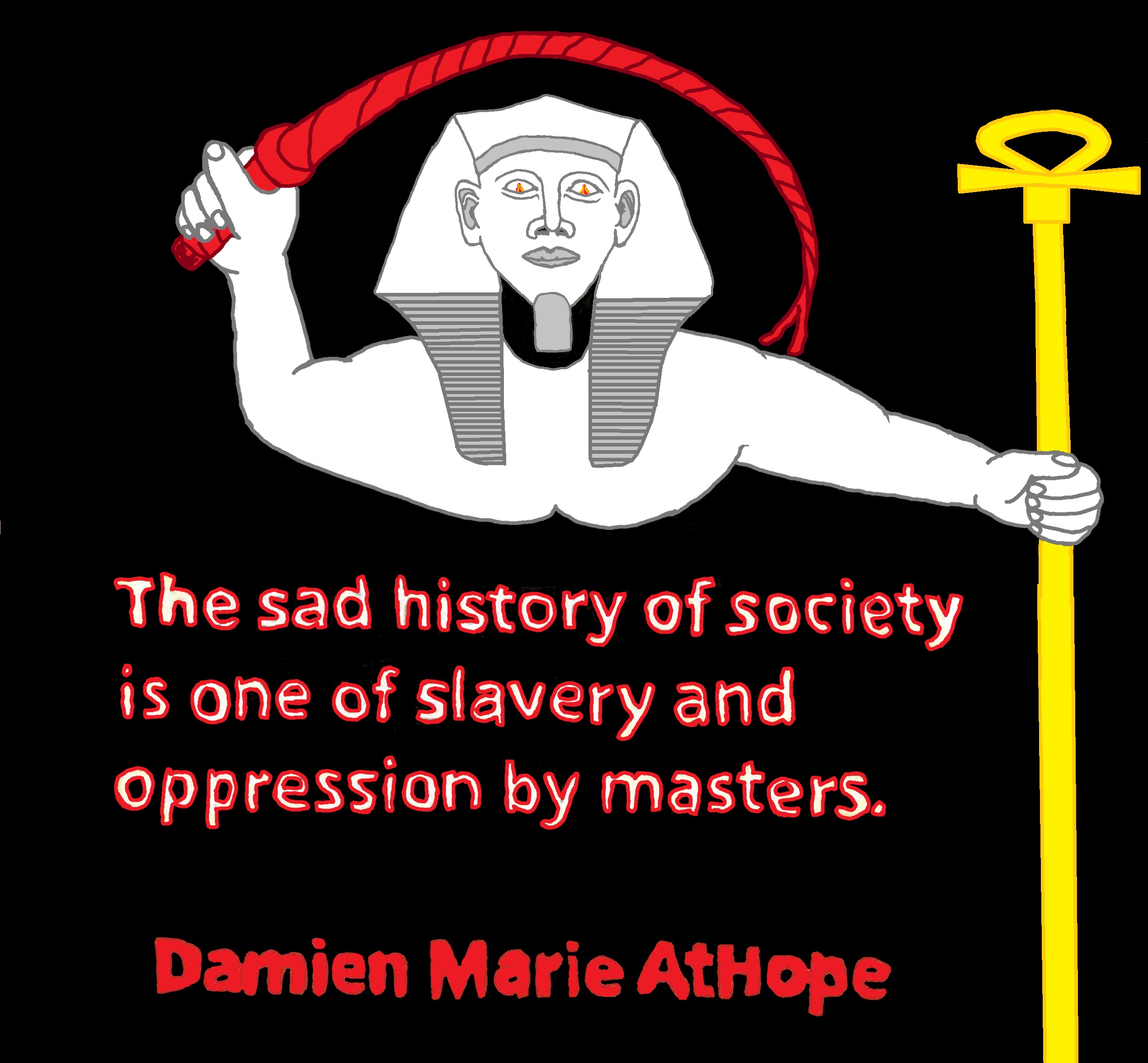
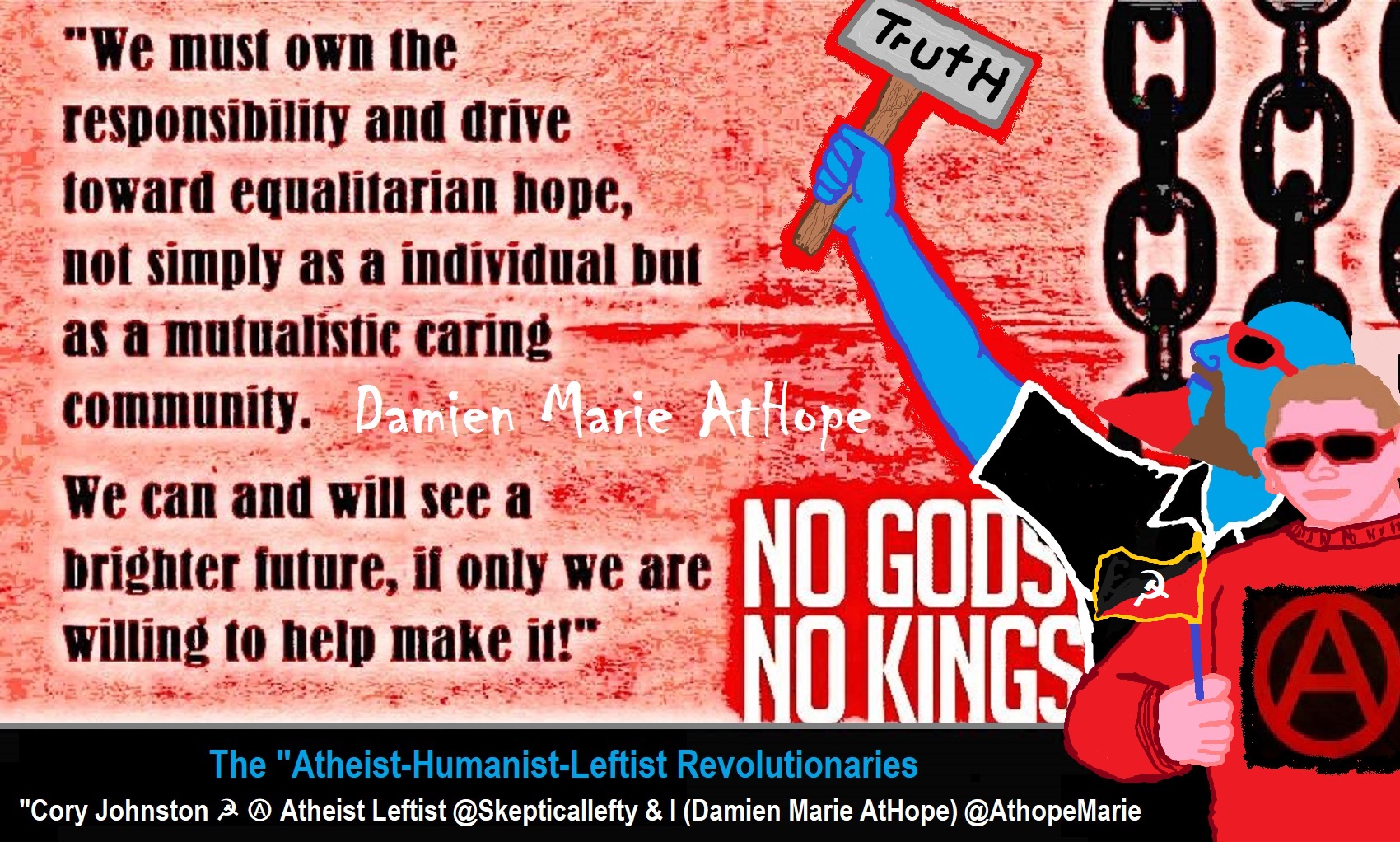
While hallucinogens are associated with shamanism, it is alcohol that is associated with paganism.
The Atheist-Humanist-Leftist Revolutionaries Shows in the prehistory series:
Show two: Pre-animism 300,000 years old and animism 100,000 years old: related to “Anarchism and Socialism”
Show tree: Totemism 50,000 years old: related to “Anarchism and Socialism”
Show four: Shamanism 30,000 years old: related to “Anarchism and Socialism”
Show five: Paganism 12,000 years old: related to “Anarchism and Socialism”
Show six: Emergence of hierarchy, sexism, slavery, and the new male god dominance: Paganism 7,000-5,000 years old: related to “Anarchism and Socialism” (Capitalism) (World War 0) Elite and their slaves!
Prehistory: related to “Anarchism and Socialism” the division of labor, power, rights, and recourses: VIDEO
Pre-animism 300,000 years old and animism 100,000 years old: related to “Anarchism and Socialism”: VIDEO
Totemism 50,000 years old: related to “Anarchism and Socialism”: VIDEO
Shamanism 30,000 years old: related to “Anarchism and Socialism”: VIDEO
Paganism 12,000 years old: related to “Anarchism and Socialism” (Pre-Capitalism): VIDEO
Paganism 7,000-5,000 years old: related to “Anarchism and Socialism” (Capitalism) (World War 0) Elite and their slaves: VIEDO
Paganism 5,000 years old: progressed organized religion and the state: related to “Anarchism and Socialism” (Kings and the Rise of the State): VIEDO
Paganism 4,000 years old: related to “Anarchism and Socialism” (First Moralistic gods, then the Origin time of Monotheism): VIEDO
I do not hate simply because I challenge and expose myths or lies any more than others being thought of as loving simply because of the protection and hiding from challenge their favored myths or lies.
The truth is best championed in the sunlight of challenge.
An archaeologist once said to me “Damien religion and culture are very different”
My response, So are you saying that was always that way, such as would you say Native Americans’ cultures are separate from their religions? And do you think it always was the way you believe?
I had said that religion was a cultural product. That is still how I see it and there are other archaeologists that think close to me as well. Gods too are the myths of cultures that did not understand science or the world around them, seeing magic/supernatural everywhere.
I personally think there is a goddess and not enough evidence to support a male god at Çatalhöyük but if there was both a male and female god and goddess then I know the kind of gods they were like Proto-Indo-European mythology.
This series idea was addressed in, Anarchist Teaching as Free Public Education or Free Education in the Public: VIDEO
Our 12 video series: Organized Oppression: Mesopotamian State Force and the Politics of power (9,000-4,000 years ago), is adapted from: The Complete and Concise History of the Sumerians and Early Bronze Age Mesopotamia (7000-2000 BC): https://www.youtube.com/watch?v=szFjxmY7jQA by “History with Cy“
Show #1: Mesopotamian State Force and the Politics of Power (Samarra, Halaf, Ubaid)
Show #2: Mesopotamian State Force and the Politics of Power (Eridu “Tell Abu Shahrain”)
Show #3: Mesopotamian State Force and the Politics of Power (Uruk and the First Cities)
Show #4: Mesopotamian State Force and the Politics of Power (First Kings)
Show #5: Mesopotamian State Force and the Politics of Power (Early Dynastic Period)
Show #6: Mesopotamian State Force and the Politics of Power (King/Ruler Lugalzagesi)
Show #7: Mesopotamian State Force and the Politics of Power (Sargon and Akkadian Rule)
Show #9: Mesopotamian State Force and the Politics of Power (Gudea of Lagash and Utu-hegal)
Show #12: Mesopotamian State Force and the Politics of Power (Aftermath and Legacy of Sumer)
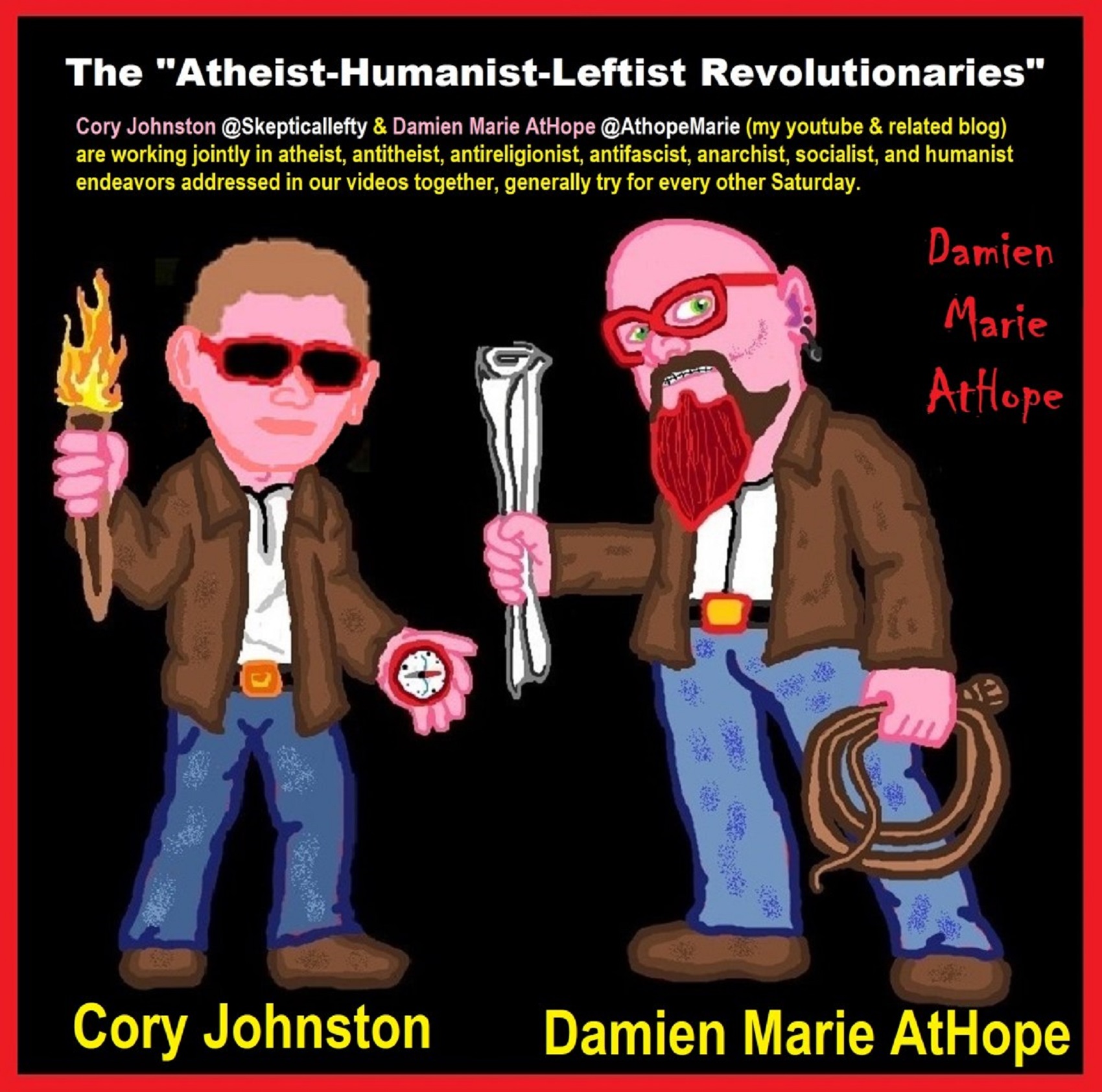
The “Atheist-Humanist-Leftist Revolutionaries”
Cory Johnston ☭ Ⓐ Atheist Leftist @Skepticallefty & I (Damien Marie AtHope) @AthopeMarie (my YouTube & related blog) are working jointly in atheist, antitheist, antireligionist, antifascist, anarchist, socialist, and humanist endeavors in our videos together, generally, every other Saturday.
Why Does Power Bring Responsibility?
Think, how often is it the powerless that start wars, oppress others, or commit genocide? So, I guess the question is to us all, to ask, how can power not carry responsibility in a humanity concept? I know I see the deep ethical responsibility that if there is power their must be a humanistic responsibility of ethical and empathic stewardship of that power. Will I be brave enough to be kind? Will I possess enough courage to be compassionate? Will my valor reach its height of empathy? I as everyone, earns our justified respect by our actions, that are good, ethical, just, protecting, and kind. Do I have enough self-respect to put my love for humanity’s flushing, over being brought down by some of its bad actors? May we all be the ones doing good actions in the world, to help human flourishing.
I create the world I want to live in, striving for flourishing. Which is not a place but a positive potential involvement and promotion; a life of humanist goal precision. To master oneself, also means mastering positive prosocial behaviors needed for human flourishing. I may have lost a god myth as an atheist, but I am happy to tell you, my friend, it is exactly because of that, leaving the mental terrorizer, god belief, that I truly regained my connected ethical as well as kind humanity.
Cory and I will talk about prehistory and theism, addressing the relevance to atheism, anarchism, and socialism.
At the same time as the rise of the male god, 7,000 years ago, there was also the very time there was the rise of violence, war, and clans to kingdoms, then empires, then states. It is all connected back to 7,000 years ago, and it moved across the world.
Cory Johnston: https://damienmarieathope.com/2021/04/cory-johnston-mind-of-a-skeptical-leftist/?v=32aec8db952d
The Mind of a Skeptical Leftist (YouTube)
Cory Johnston: Mind of a Skeptical Leftist @Skepticallefty
The Mind of a Skeptical Leftist By Cory Johnston: “Promoting critical thinking, social justice, and left-wing politics by covering current events and talking to a variety of people. Cory Johnston has been thoughtfully talking to people and attempting to promote critical thinking, social justice, and left-wing politics.” http://anchor.fm/skepticalleft
Cory needs our support. We rise by helping each other.
Cory Johnston ☭ Ⓐ @Skepticallefty Evidence-based atheist leftist (he/him) Producer, host, and co-host of 4 podcasts @skeptarchy @skpoliticspod and @AthopeMarie
Damien Marie AtHope (“At Hope”) Axiological Atheist, Anti-theist, Anti-religionist, Secular Humanist. Rationalist, Writer, Artist, Poet, Philosopher, Advocate, Activist, Psychology, and Armchair Archaeology/Anthropology/Historian.
Damien is interested in: Freedom, Liberty, Justice, Equality, Ethics, Humanism, Science, Atheism, Antiteism, Antireligionism, Ignosticism, Left-Libertarianism, Anarchism, Socialism, Mutualism, Axiology, Metaphysics, LGBTQI, Philosophy, Advocacy, Activism, Mental Health, Psychology, Archaeology, Social Work, Sexual Rights, Marriage Rights, Woman’s Rights, Gender Rights, Child Rights, Secular Rights, Race Equality, Ageism/Disability Equality, Etc. And a far-leftist, “Anarcho-Humanist.”
I am not a good fit in the atheist movement that is mostly pro-capitalist, I am anti-capitalist. Mostly pro-skeptic, I am a rationalist not valuing skepticism. Mostly pro-agnostic, I am anti-agnostic. Mostly limited to anti-Abrahamic religions, I am an anti-religionist.
To me, the “male god” seems to have either emerged or become prominent around 7,000 years ago, whereas the now favored monotheism “male god” is more like 4,000 years ago or so. To me, the “female goddess” seems to have either emerged or become prominent around 11,000-10,000 years ago or so, losing the majority of its once prominence around 2,000 years ago due largely to the now favored monotheism “male god” that grow in prominence after 4,000 years ago or so.
My Thought on the Evolution of Gods?
Animal protector deities from old totems/spirit animal beliefs come first to me, 13,000/12,000 years ago, then women as deities 11,000/10,000 years ago, then male gods around 7,000/8,000 years ago. Moralistic gods around 5,000/4,000 years ago, and monotheistic gods around 4,000/3,000 years ago.
To me, animal gods were likely first related to totemism animals around 13,000 to 12,000 years ago or older. Female as goddesses was next to me, 11,000 to 10,000 years ago or so with the emergence of agriculture. Then male gods come about 8,000 to 7,000 years ago with clan wars. Many monotheism-themed religions started in henotheism, emerging out of polytheism/paganism.

Damien Marie AtHope (Said as “At” “Hope”)/(Autodidact Polymath but not good at math):
Axiological Atheist, Anti-theist, Anti-religionist, Secular Humanist, Rationalist, Writer, Artist, Jeweler, Poet, “autodidact” Philosopher, schooled in Psychology, and “autodidact” Armchair Archaeology/Anthropology/Pre-Historian (Knowledgeable in the range of: 1 million to 5,000/4,000 years ago). I am an anarchist socialist politically. Reasons for or Types of Atheism
My Website, My Blog, & Short-writing or Quotes, My YouTube, Twitter: @AthopeMarie, and My Email: damien.marie.athope@gmail.com

